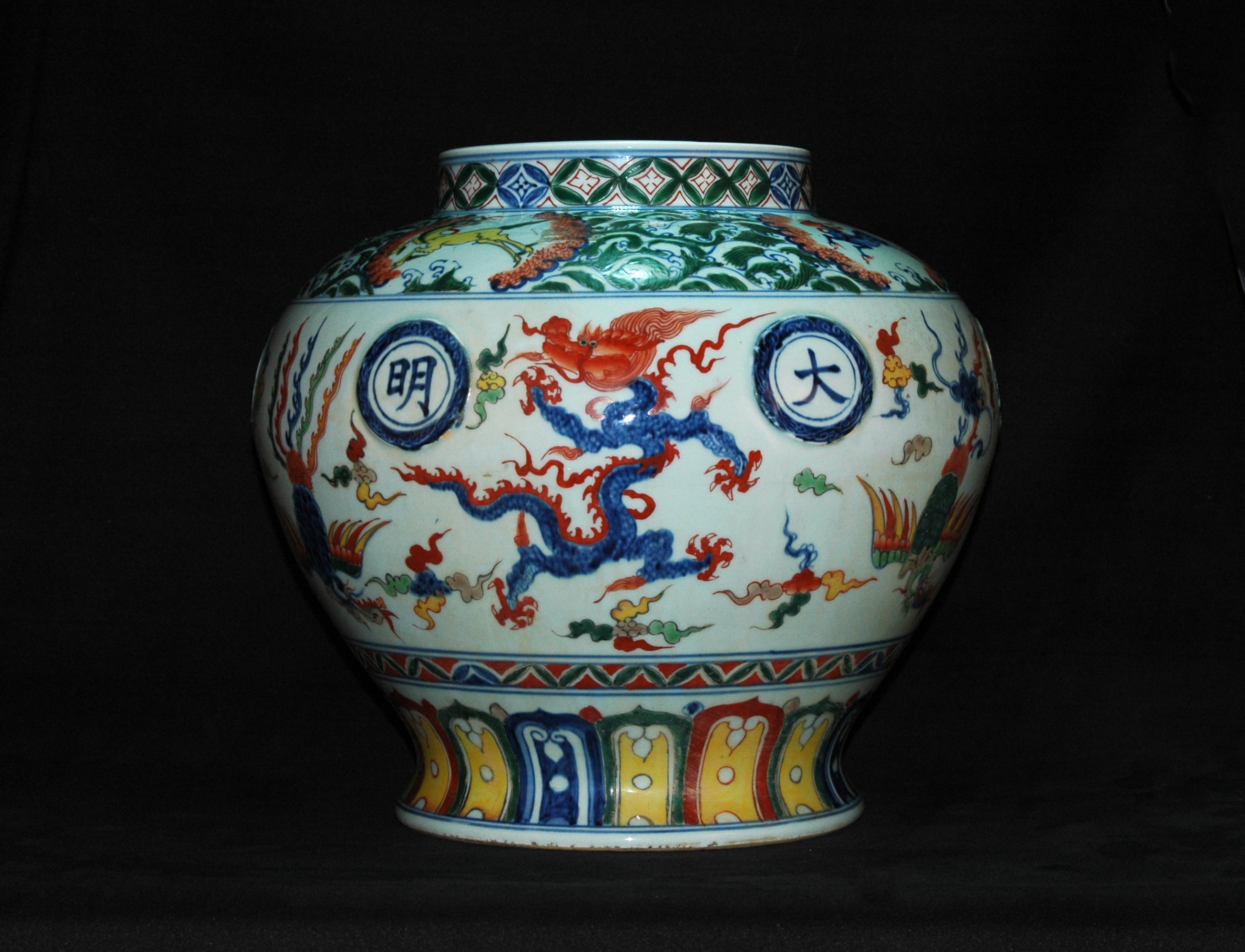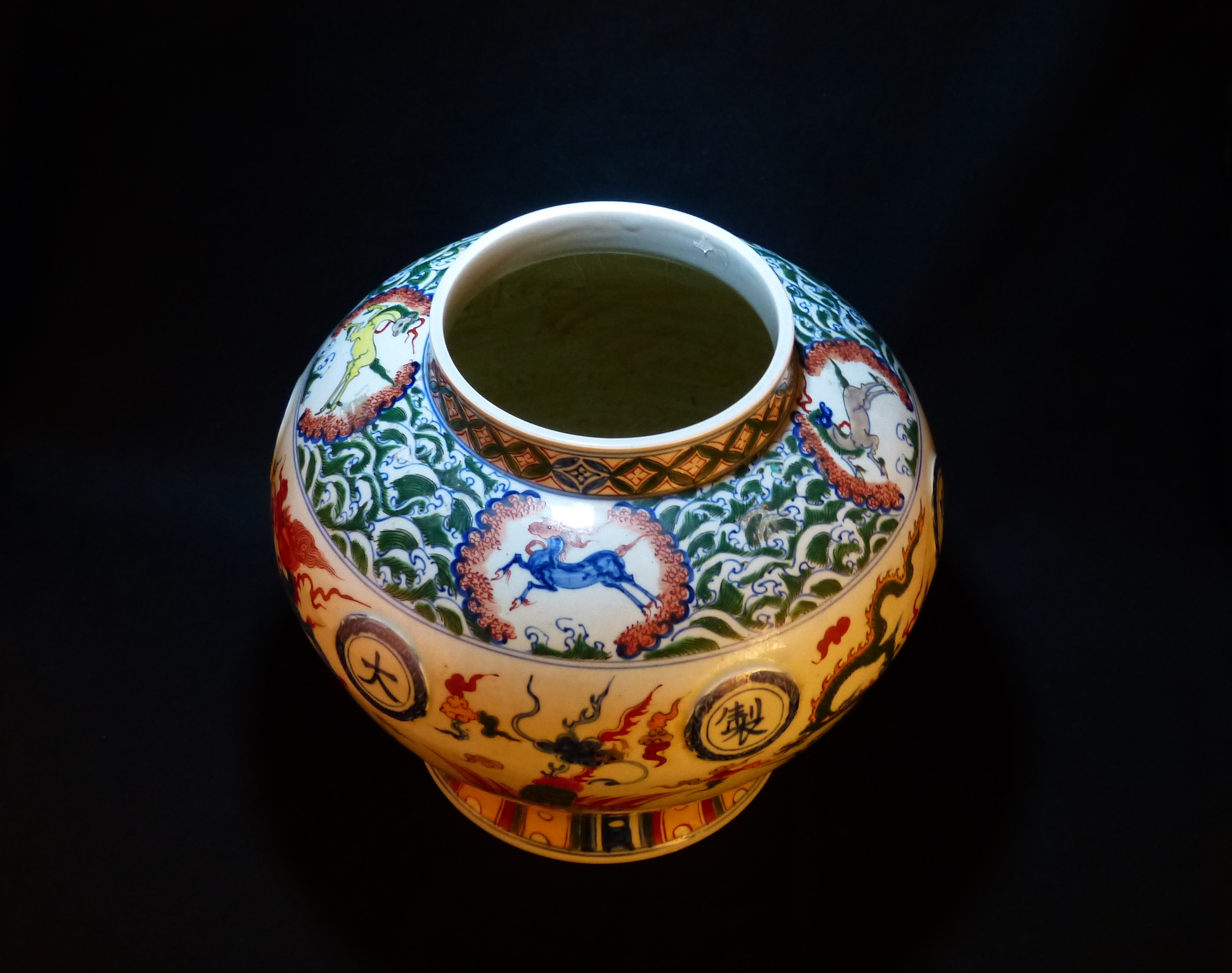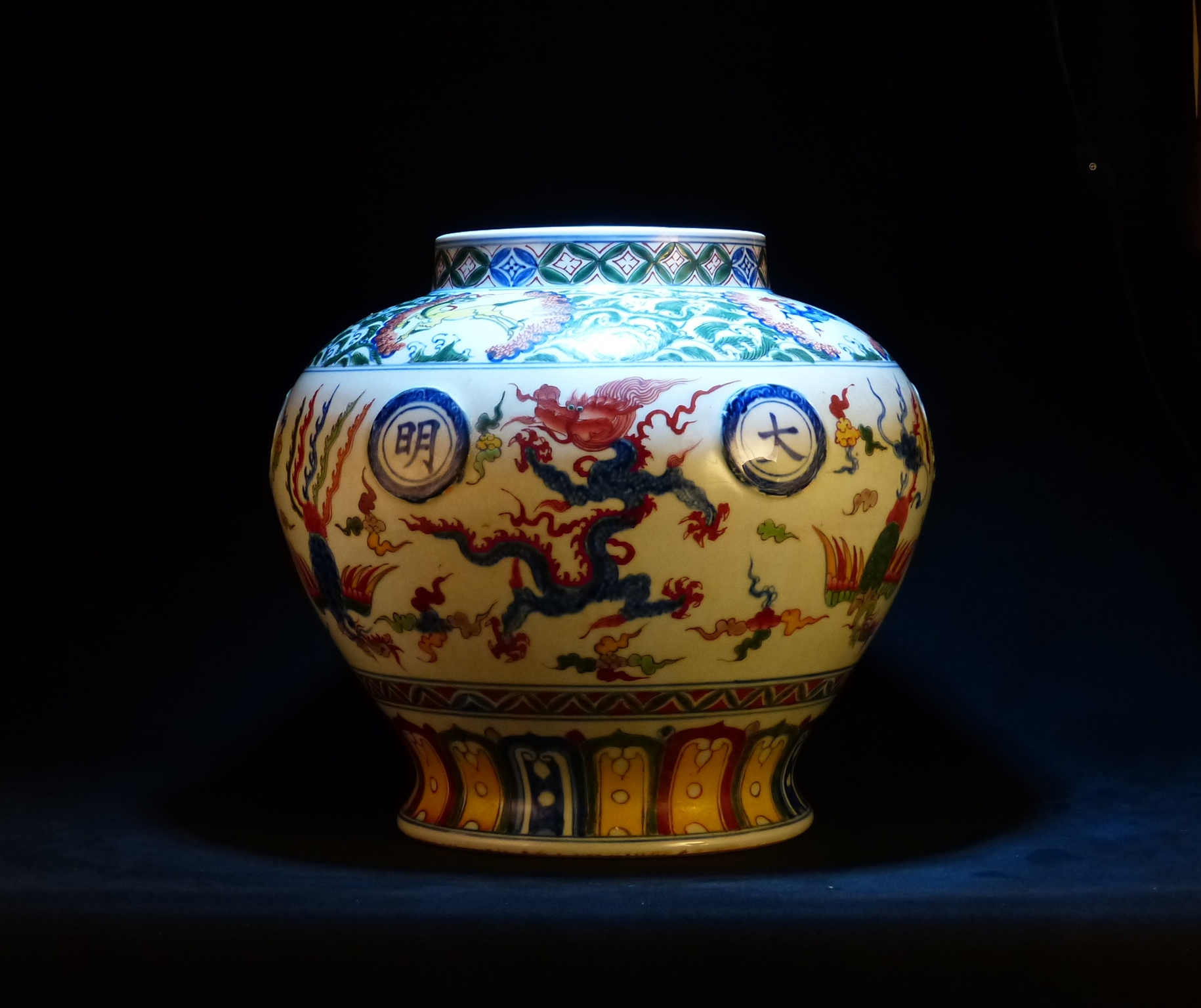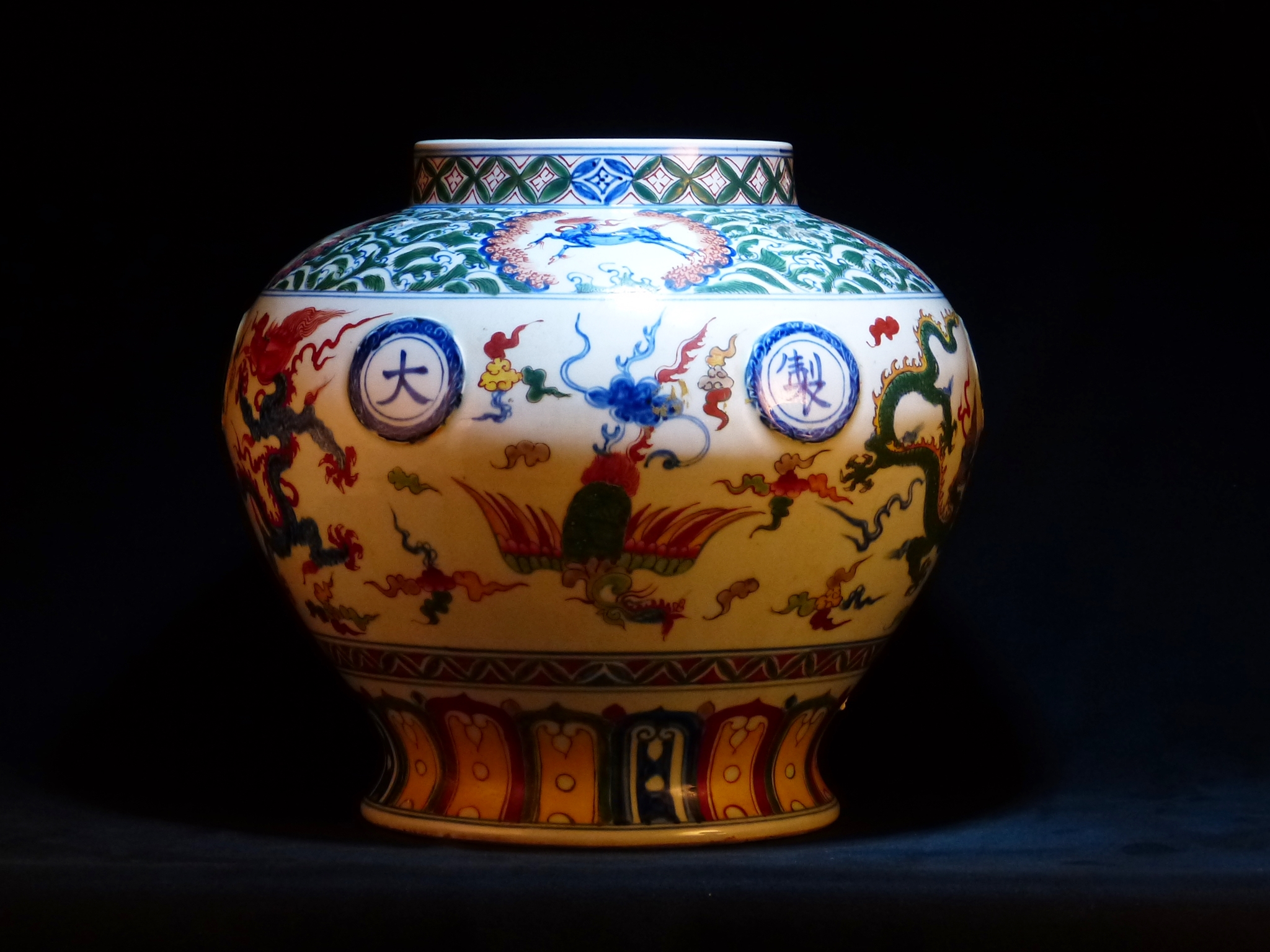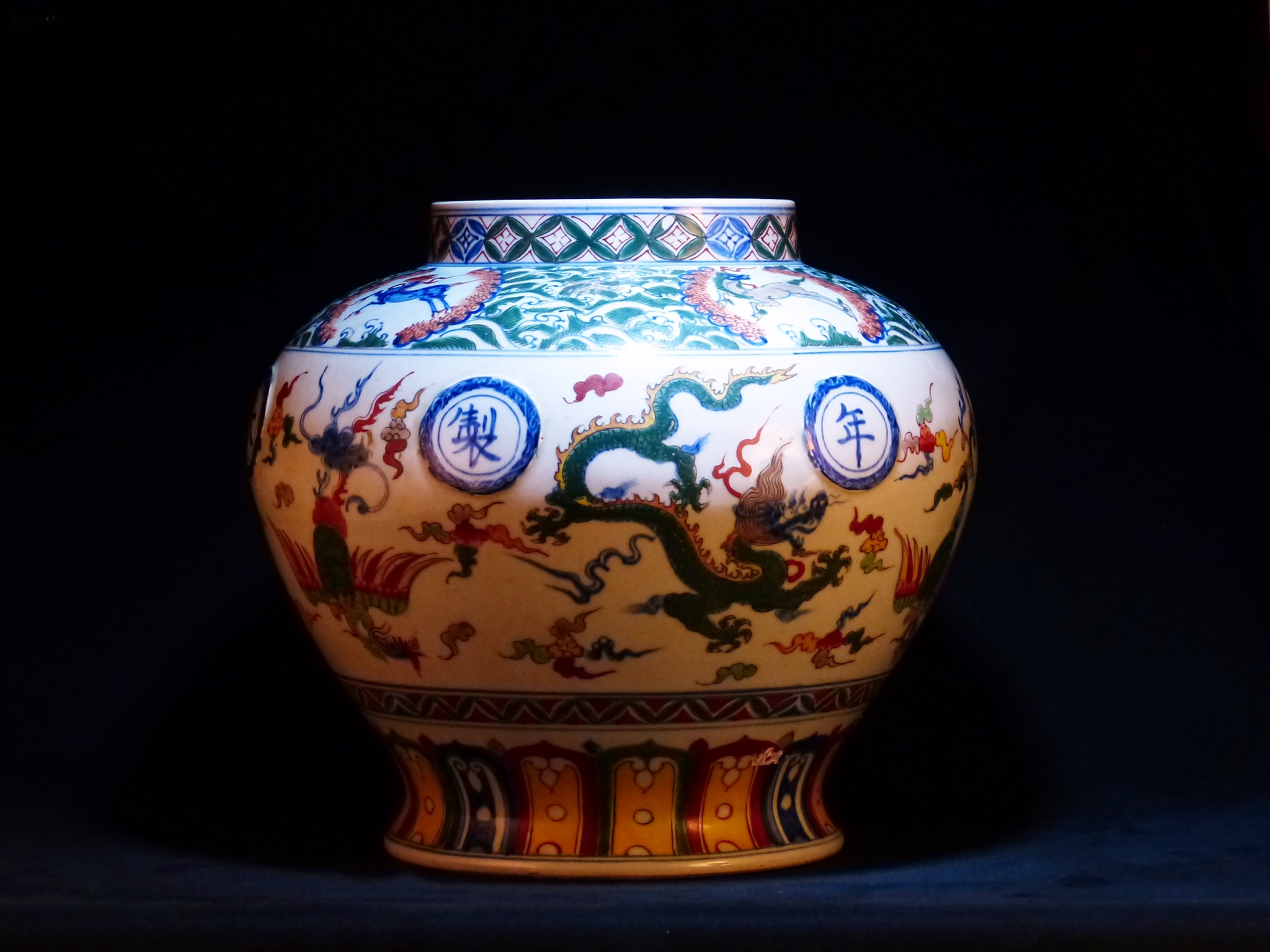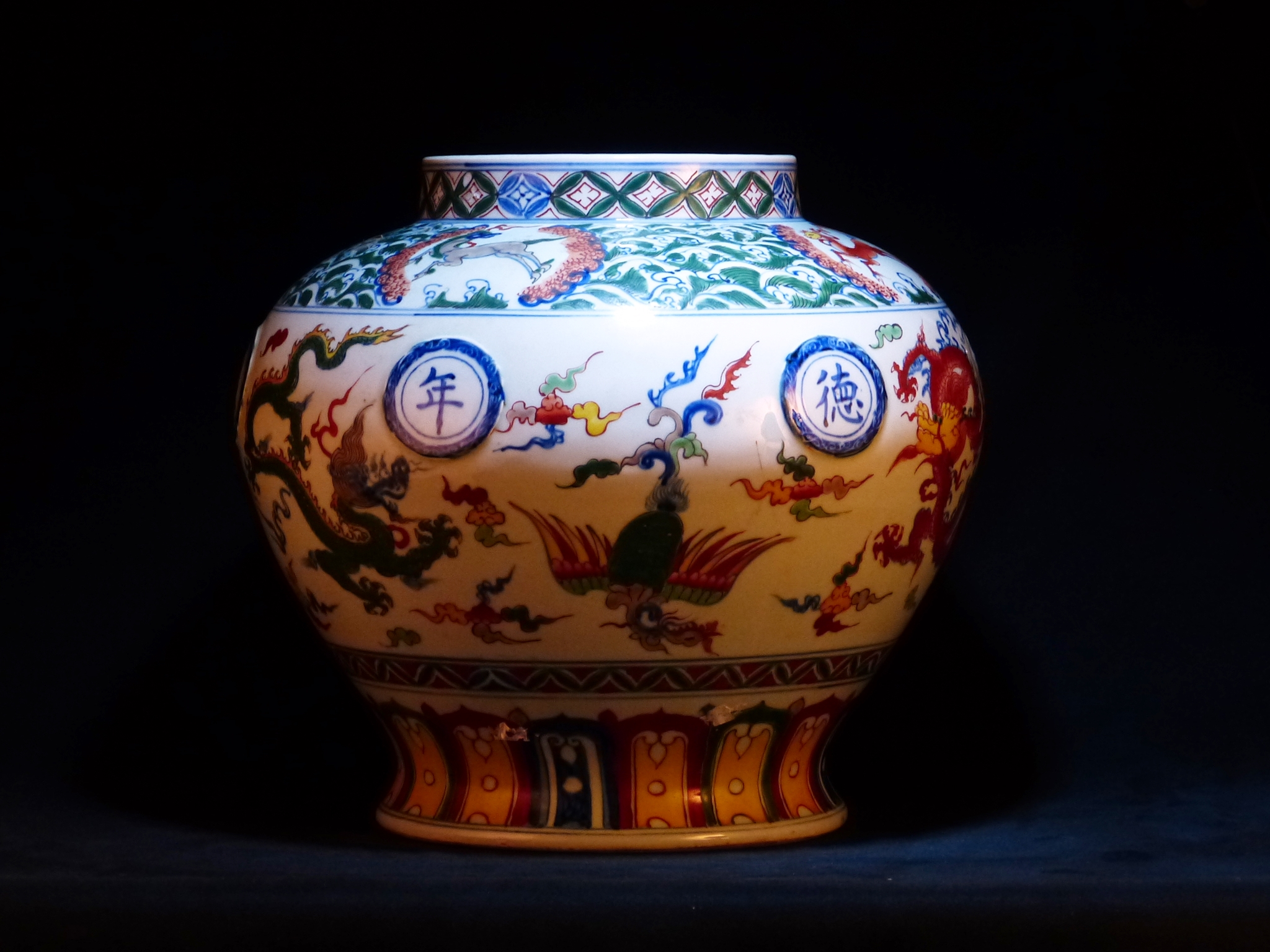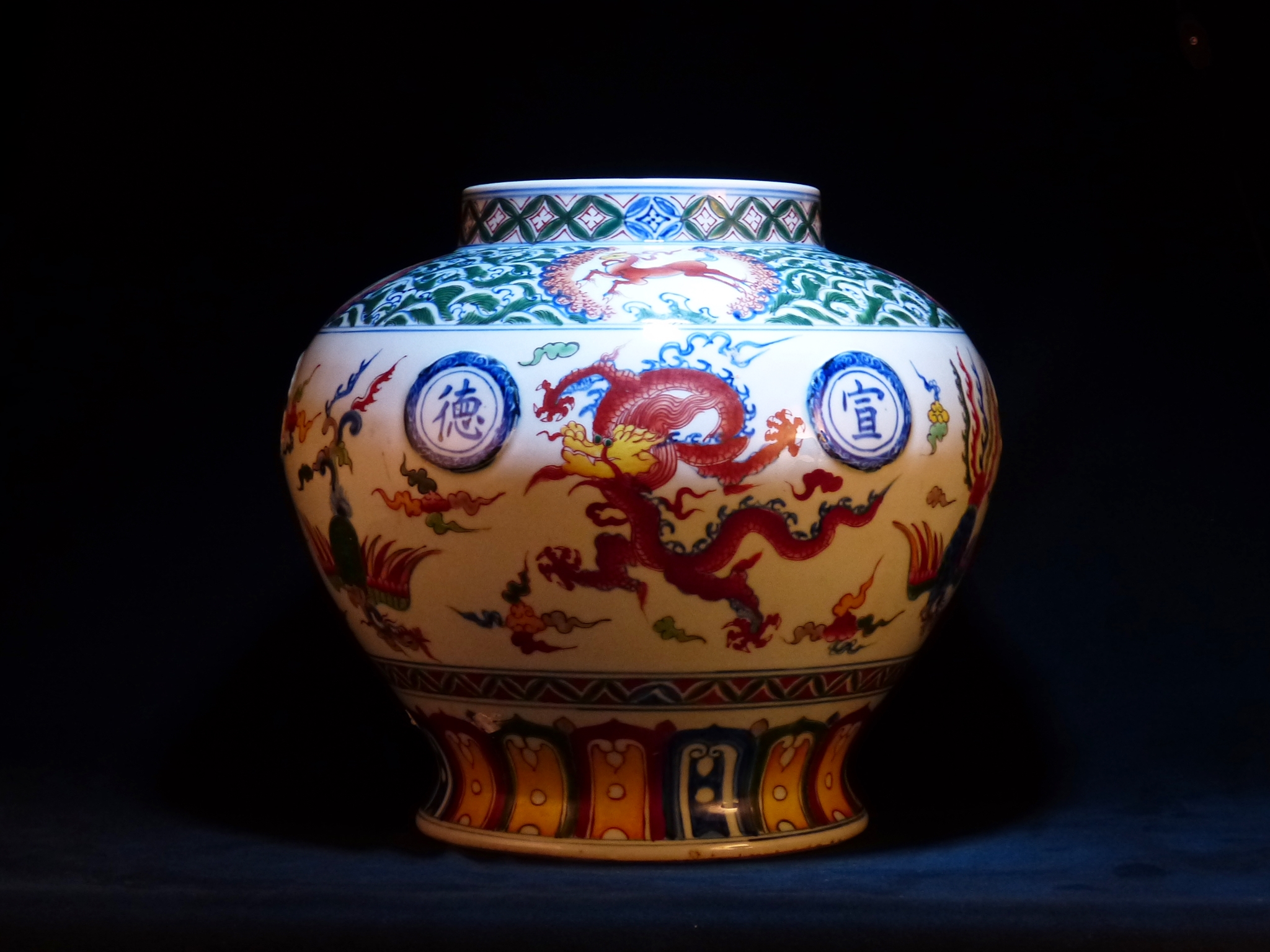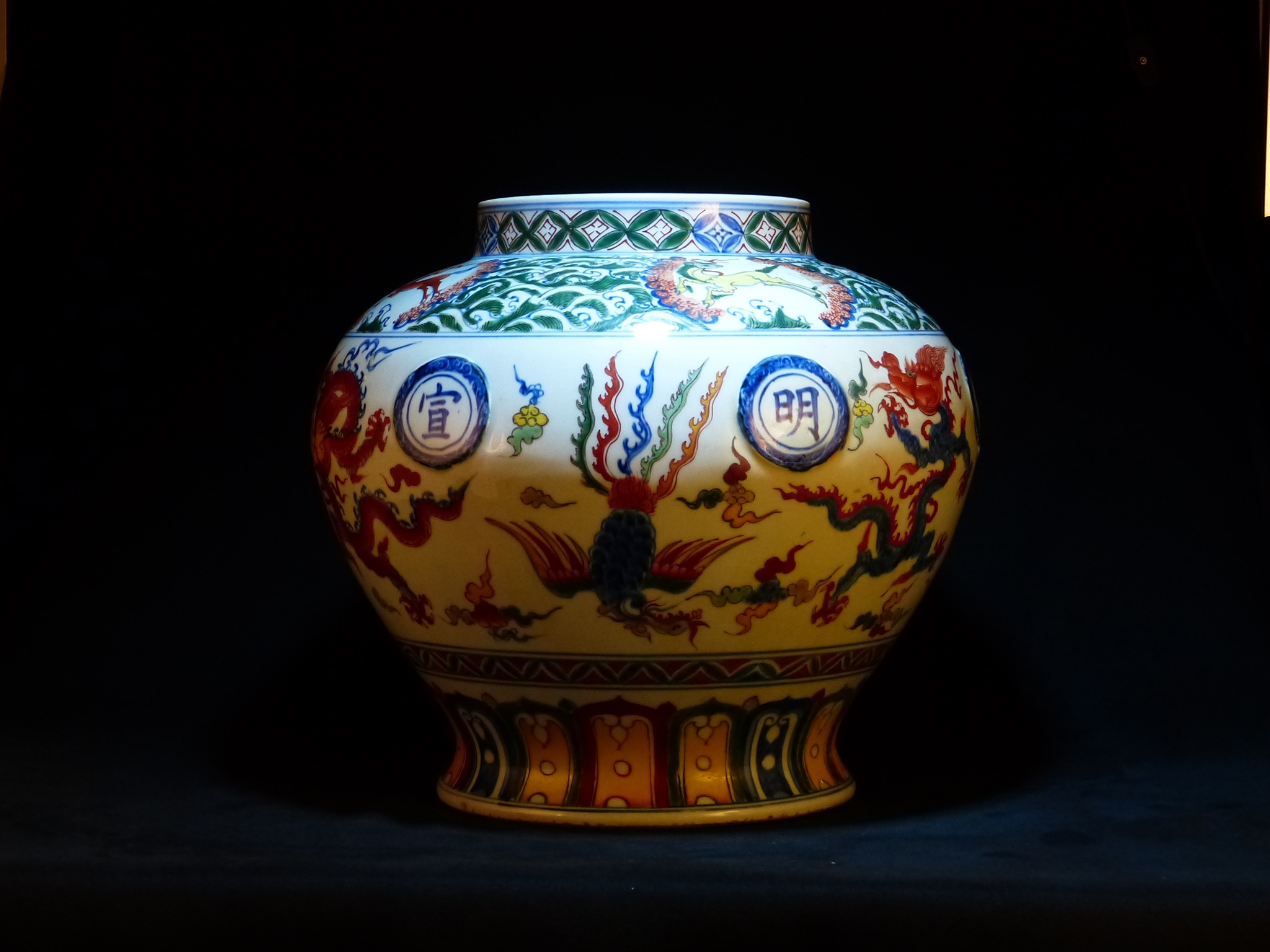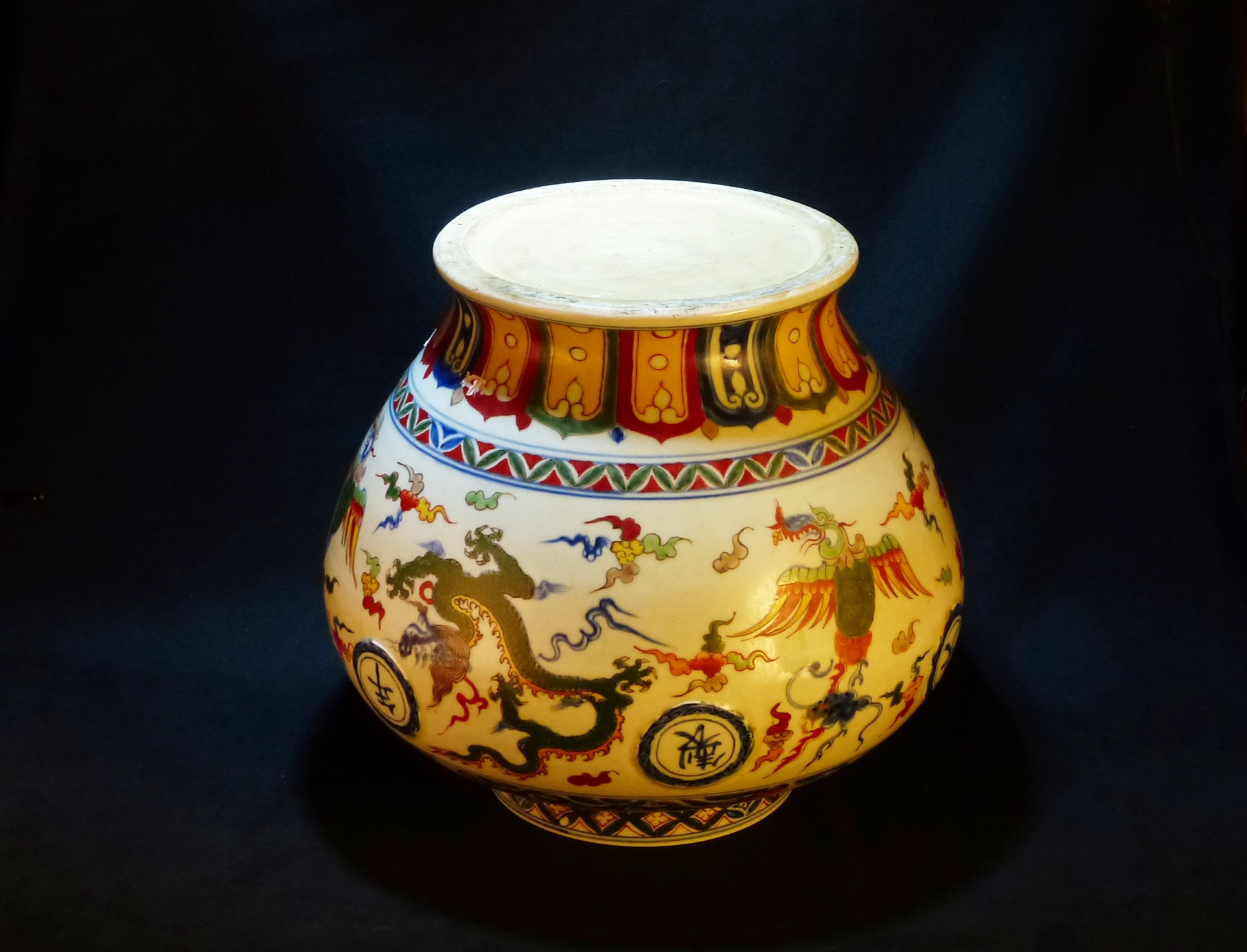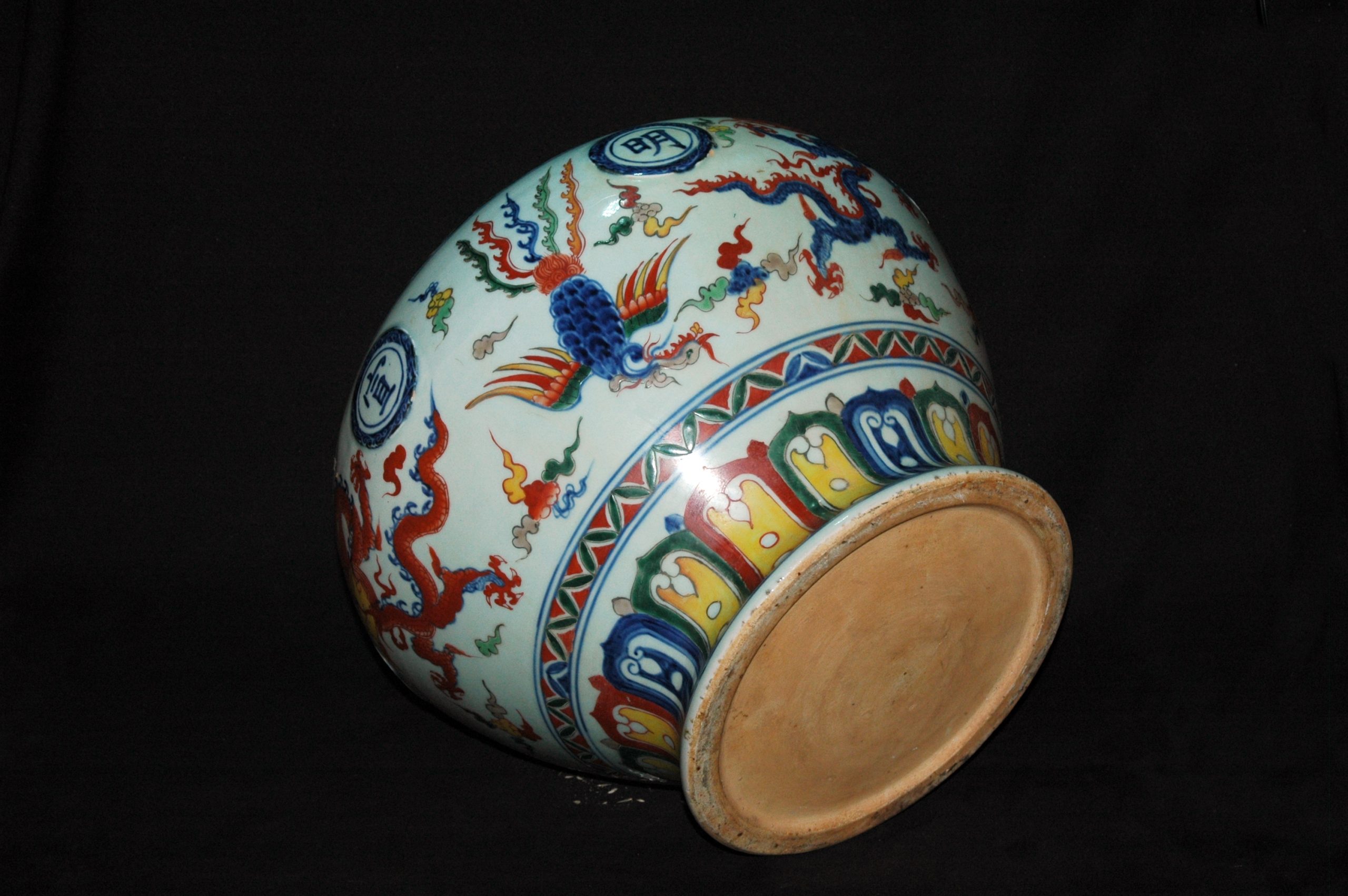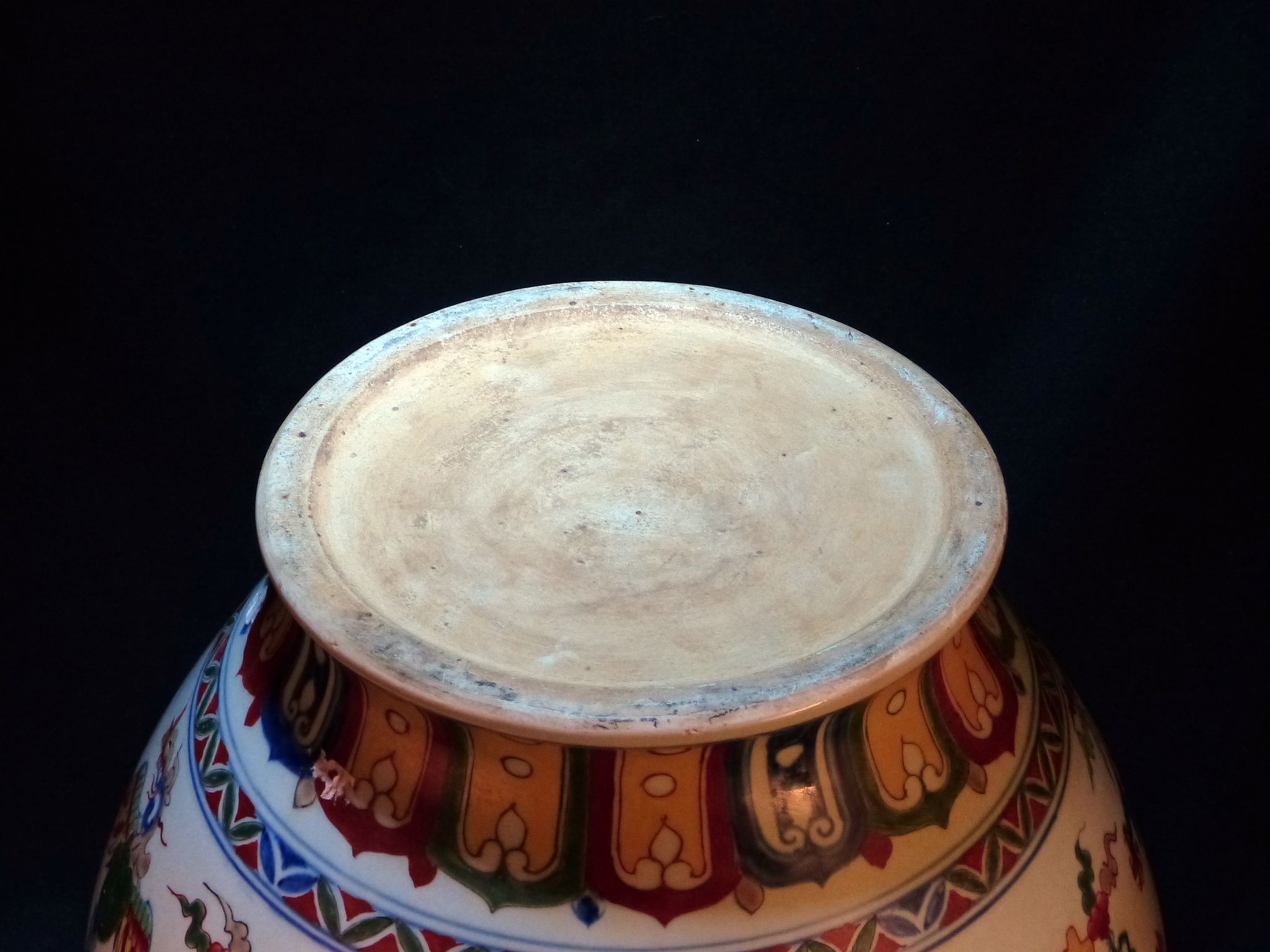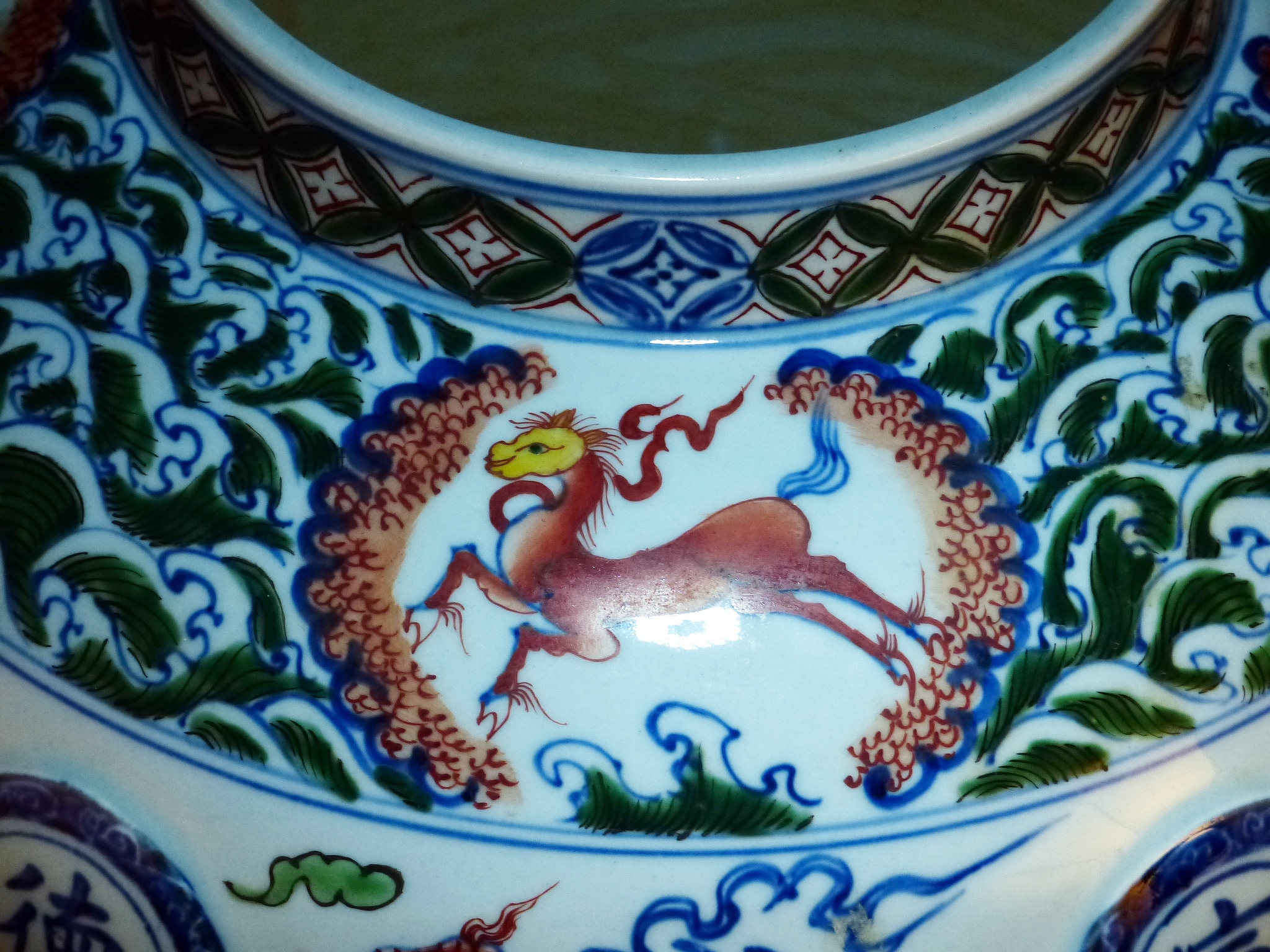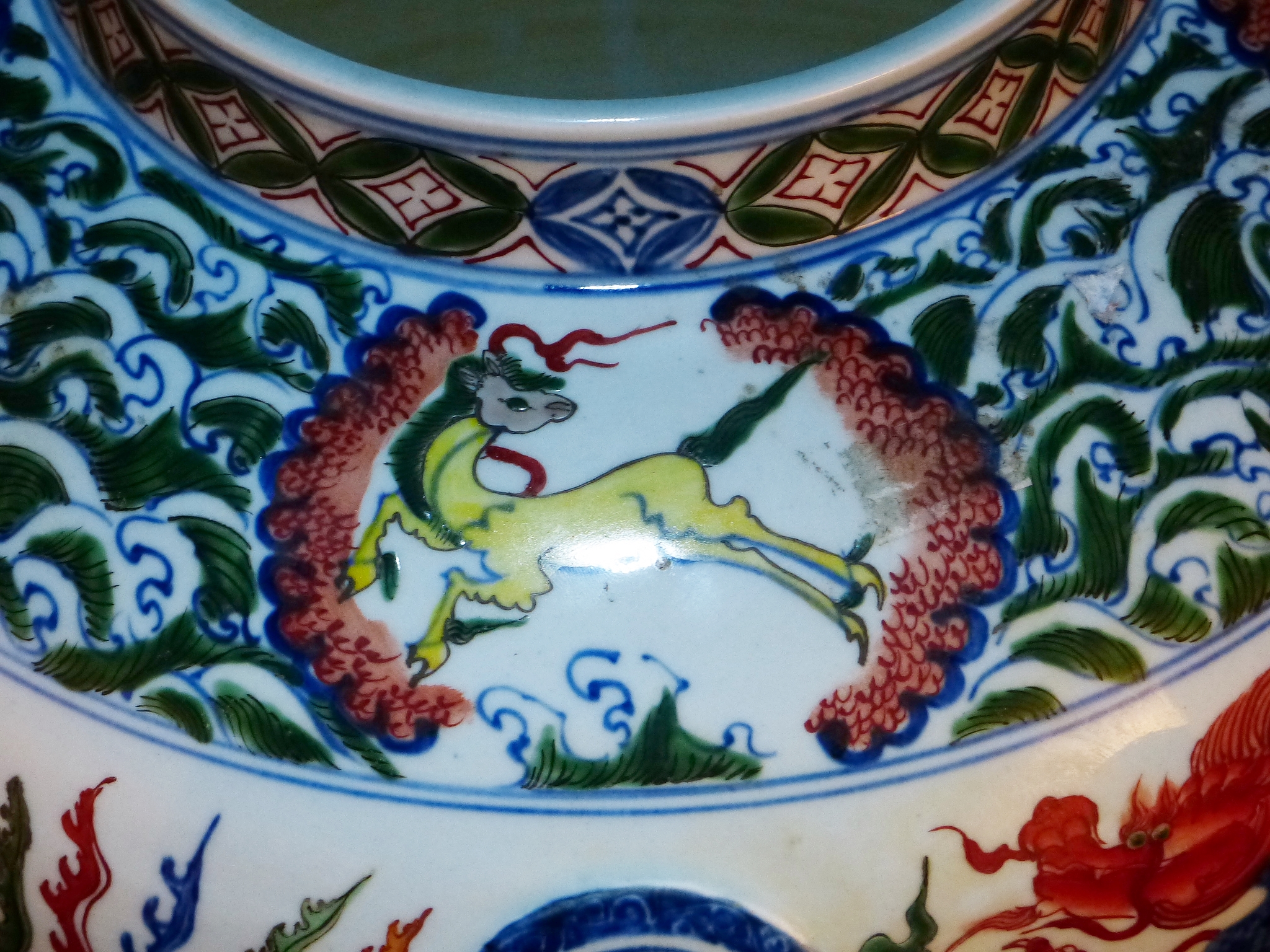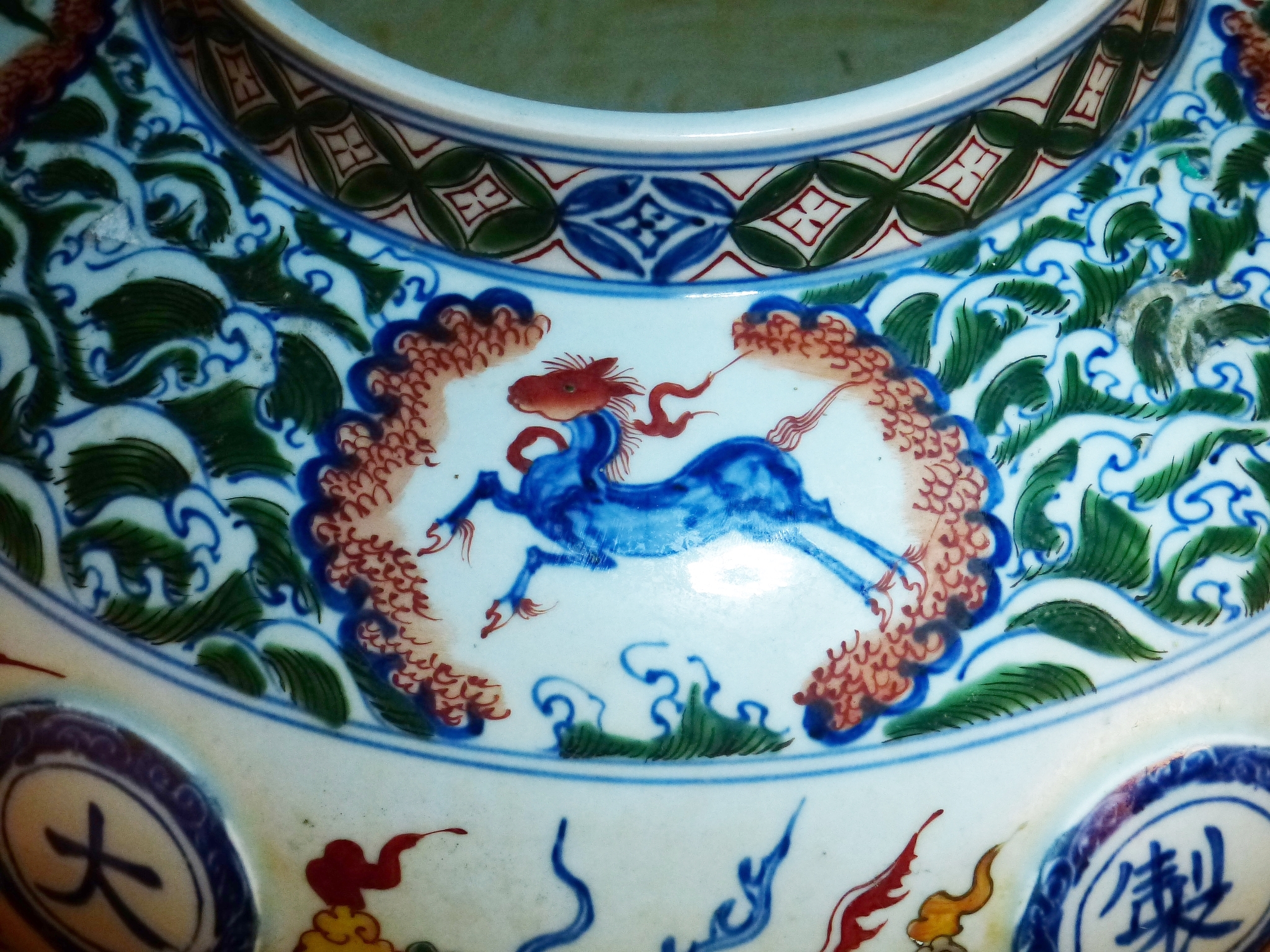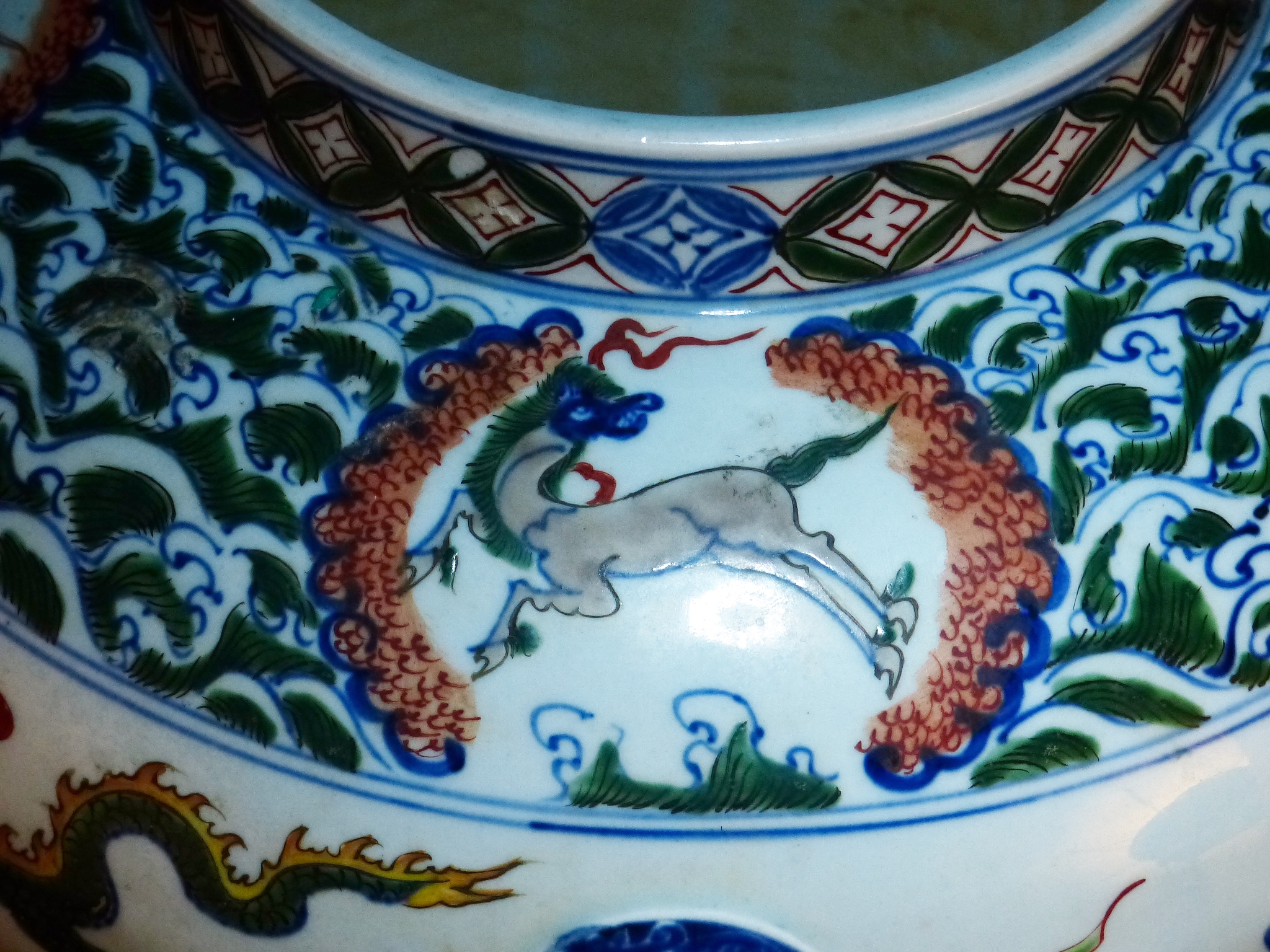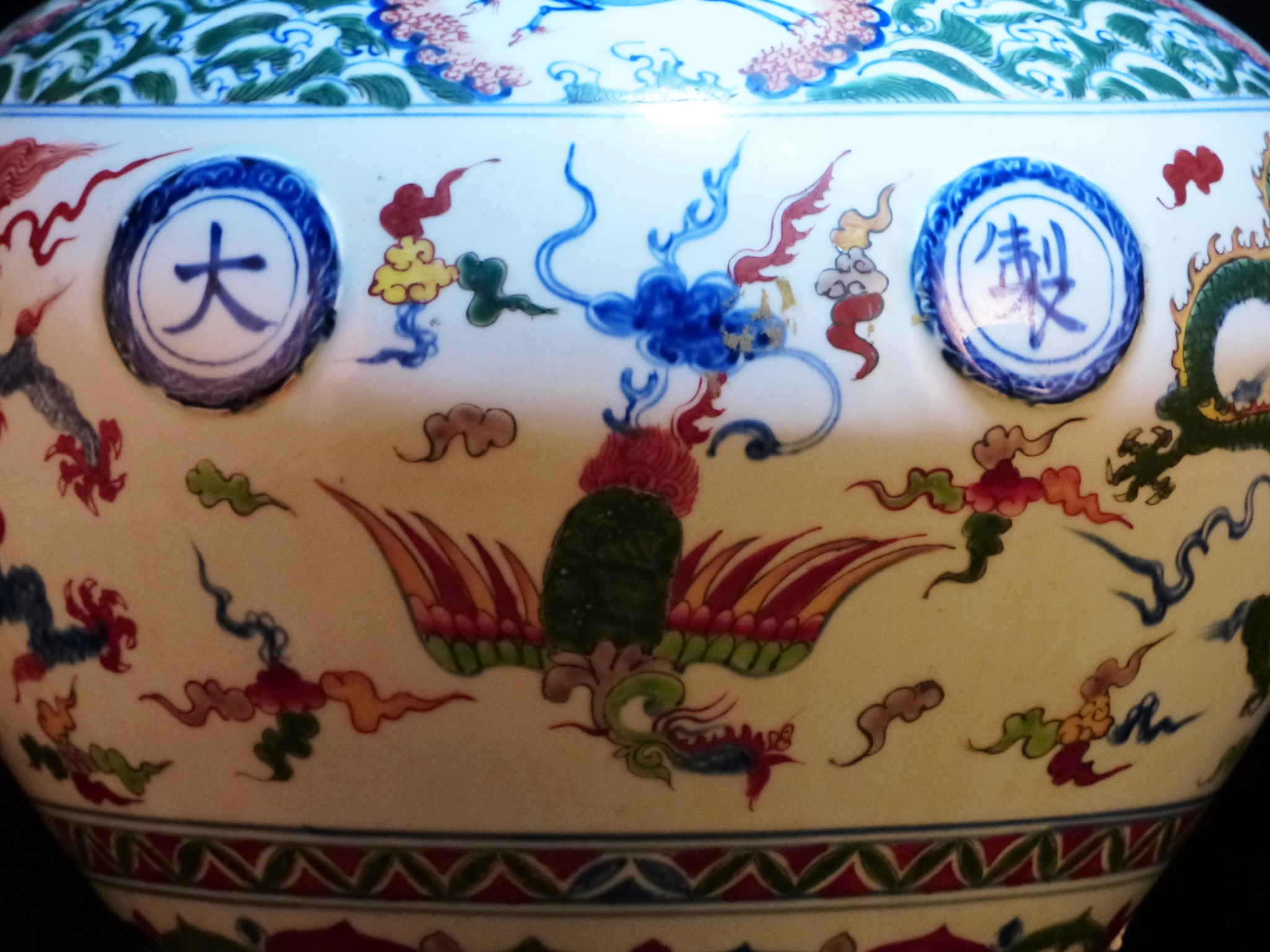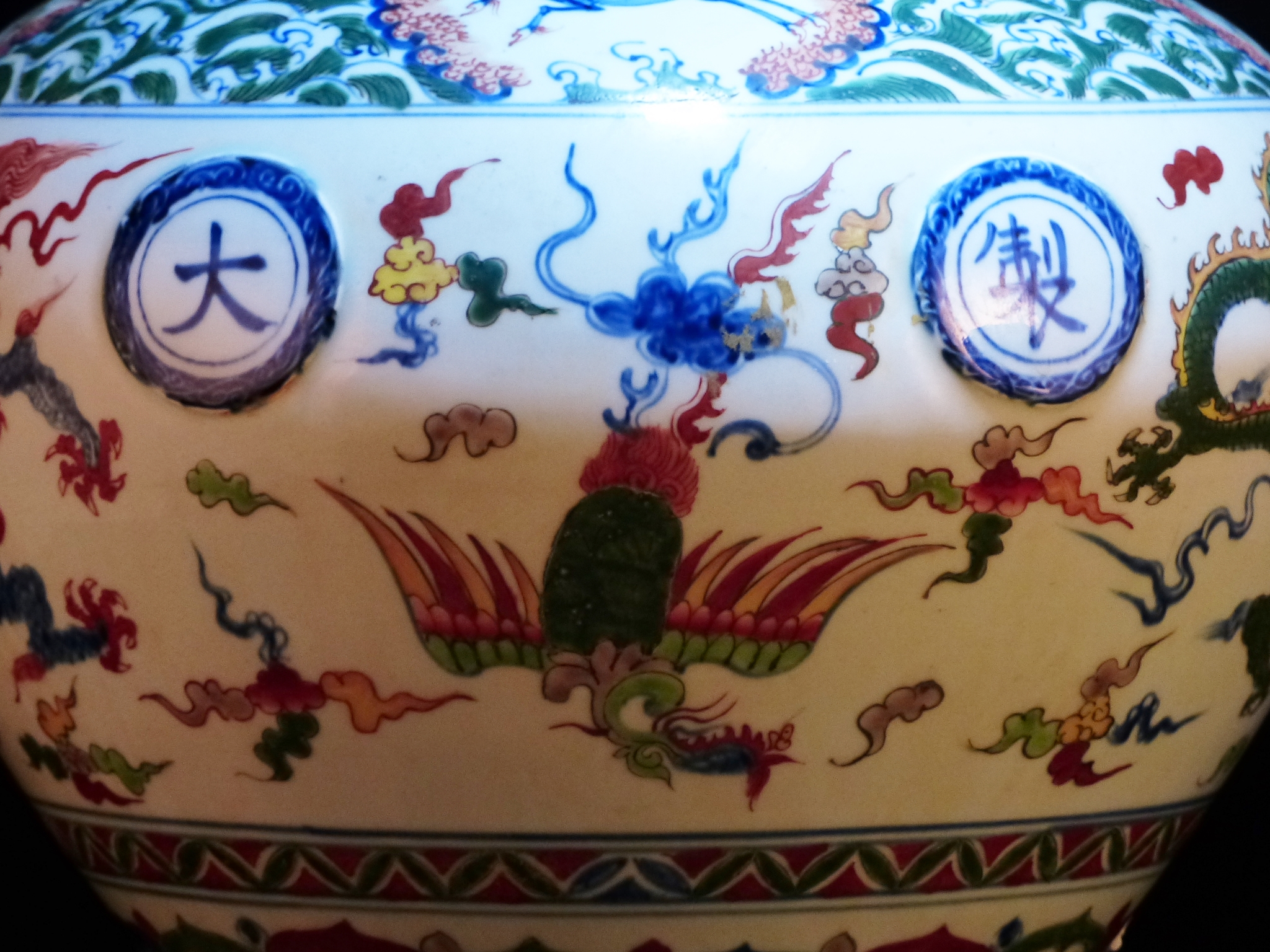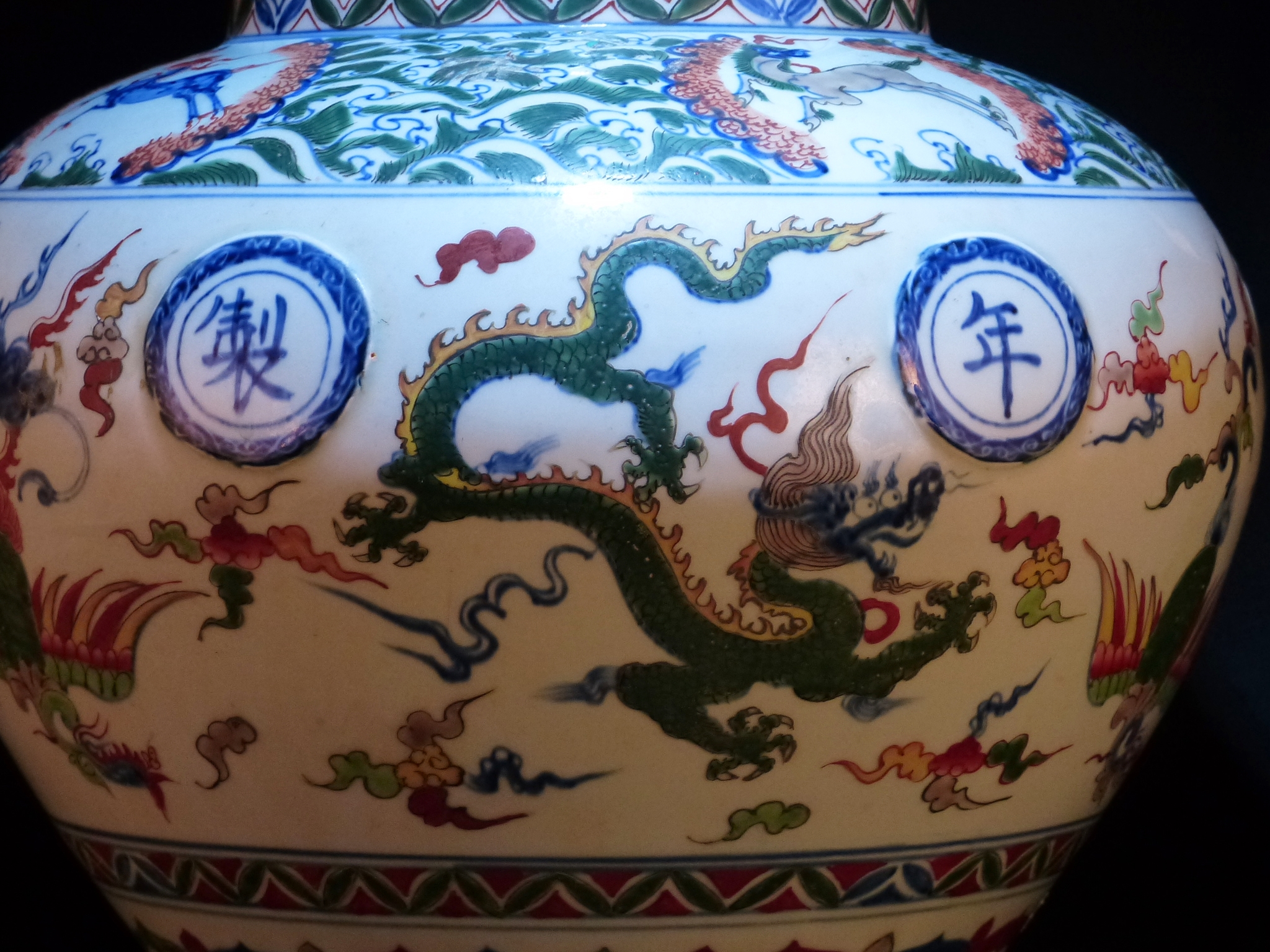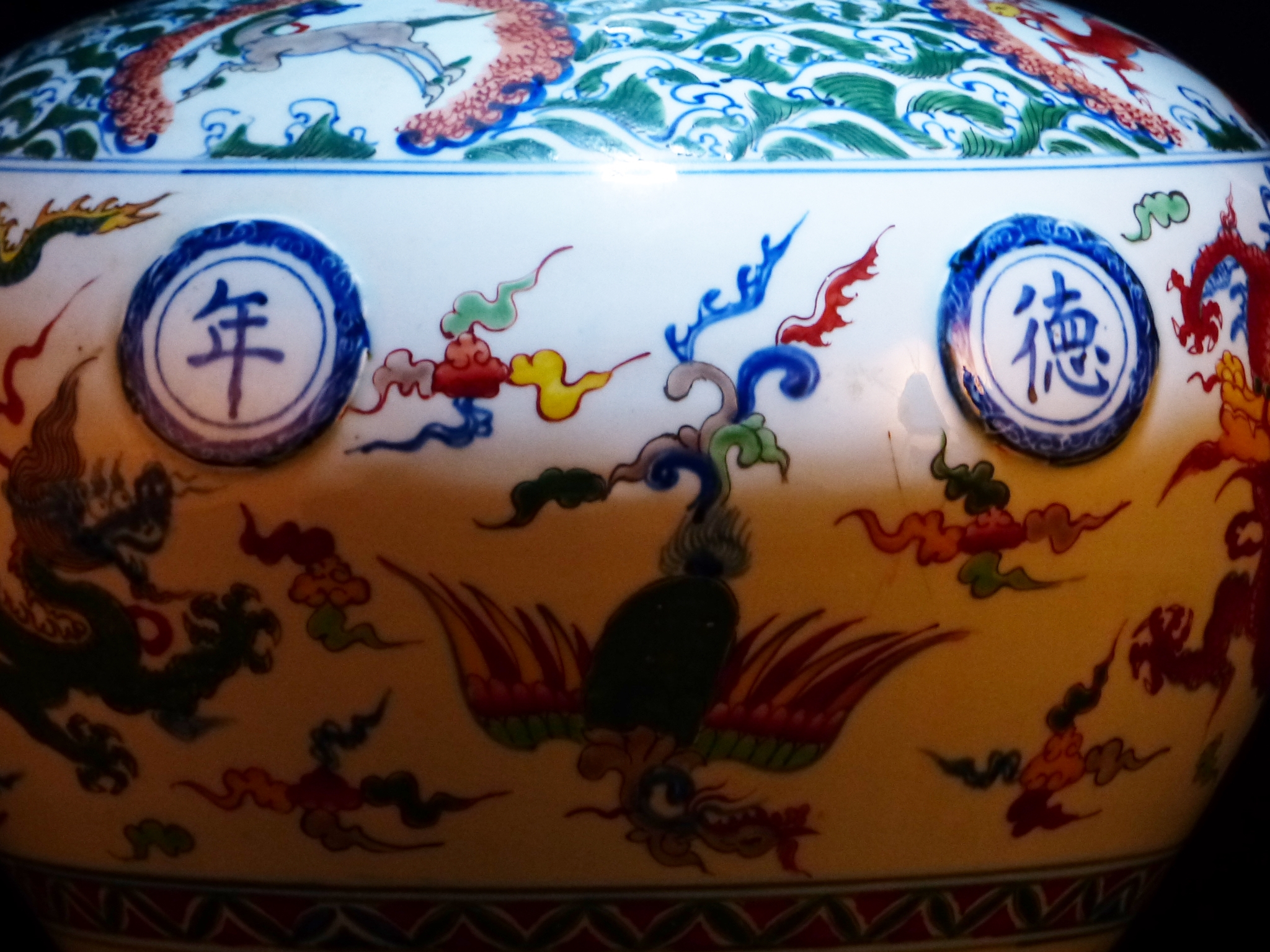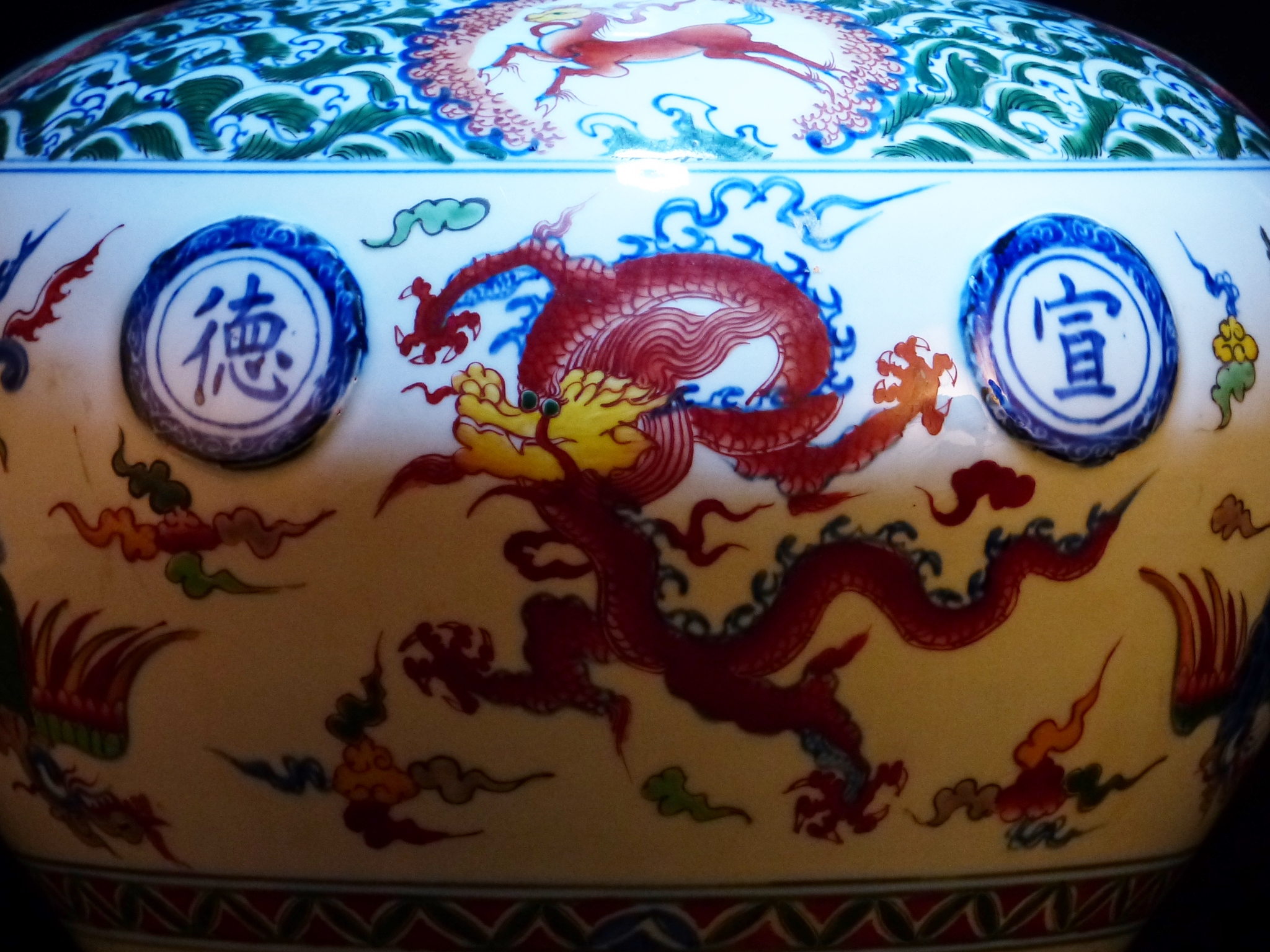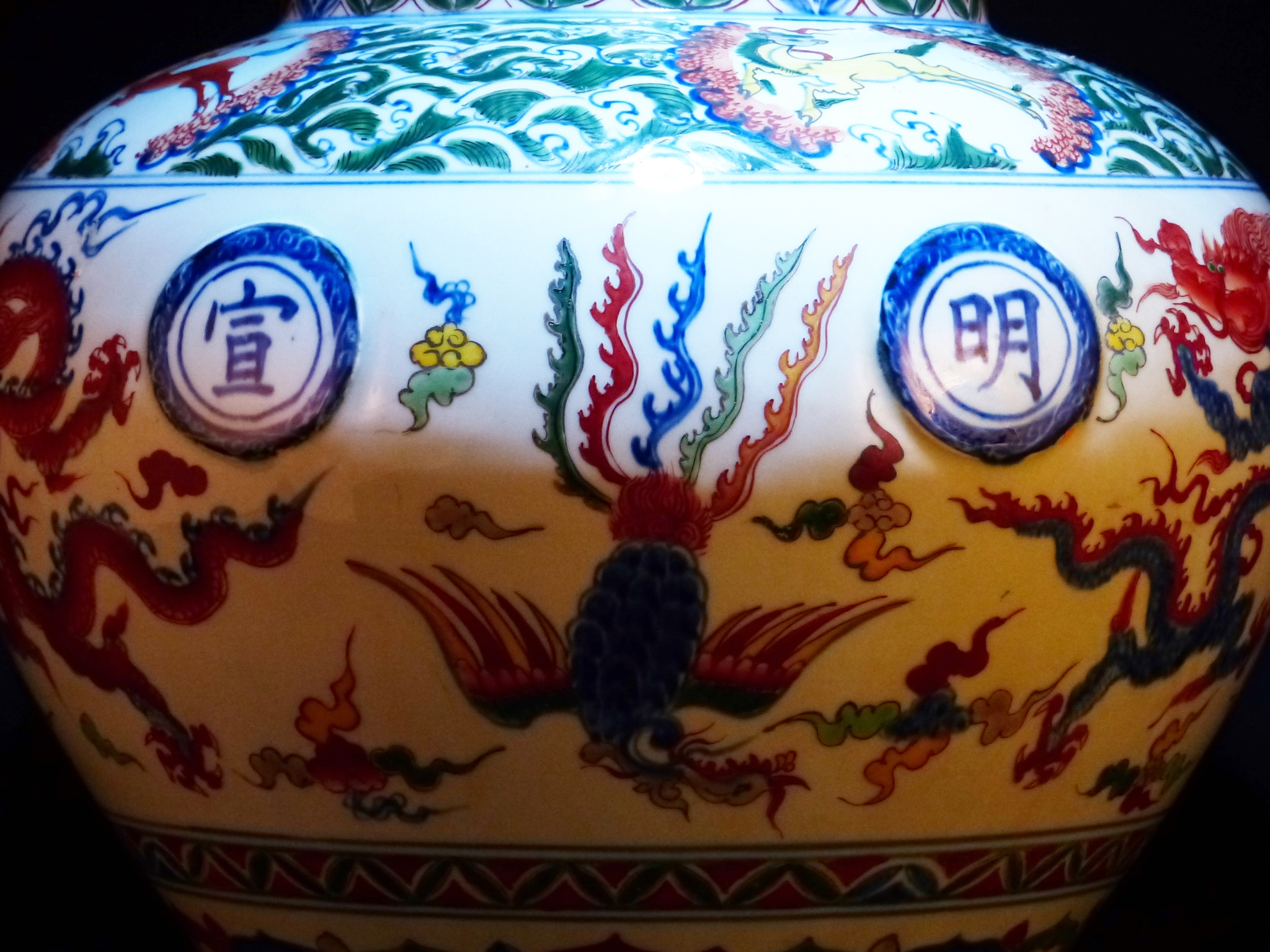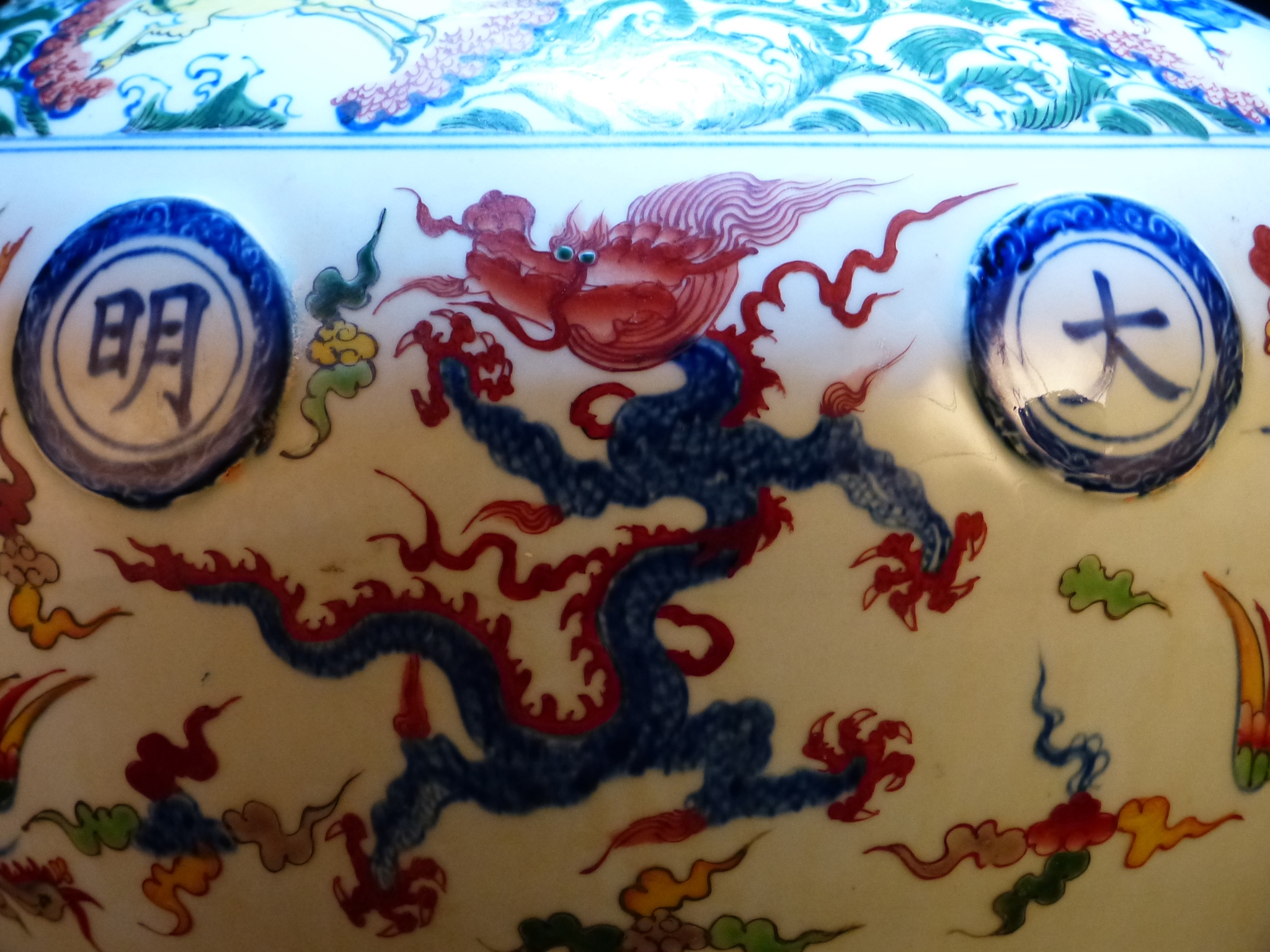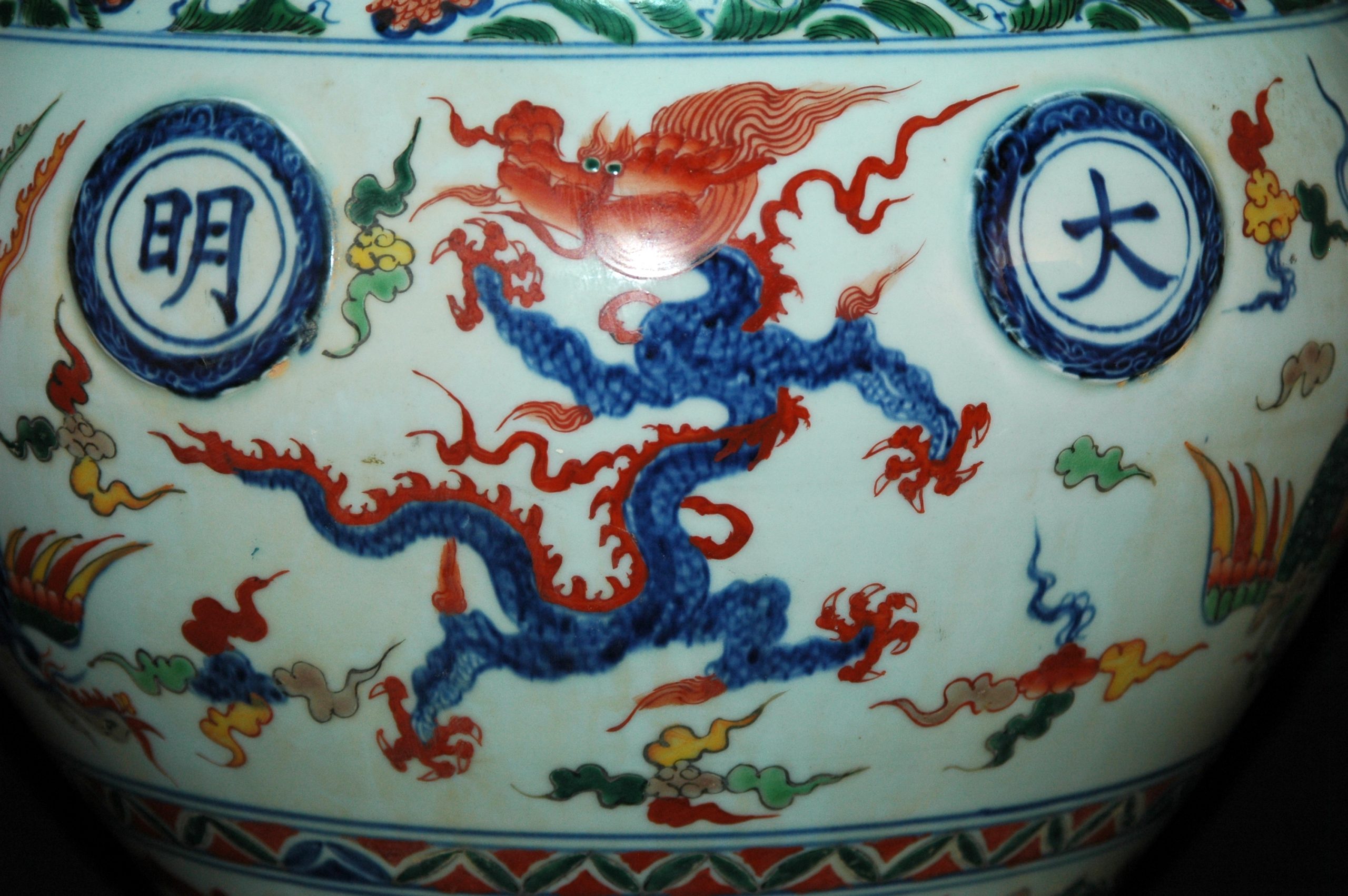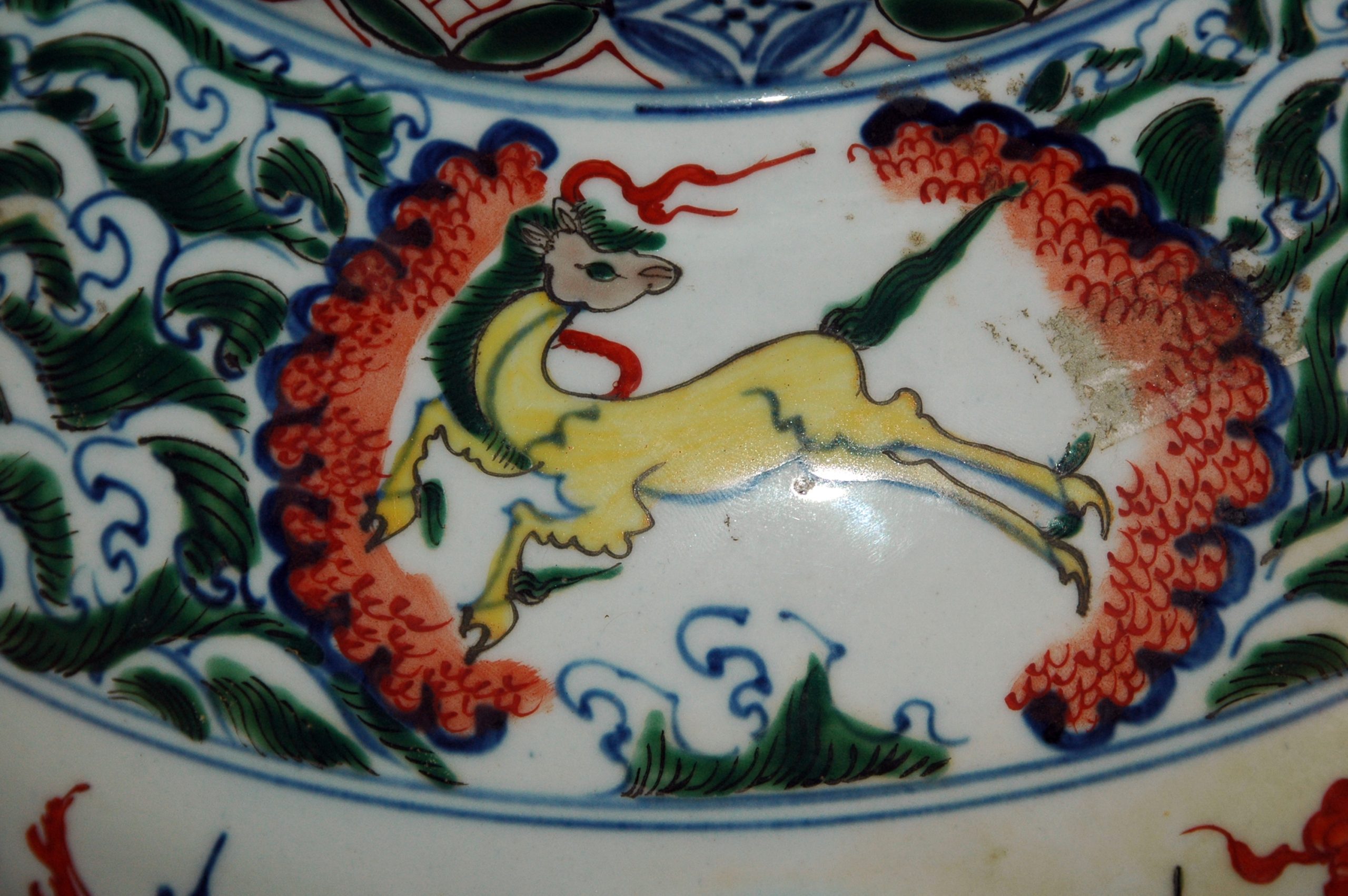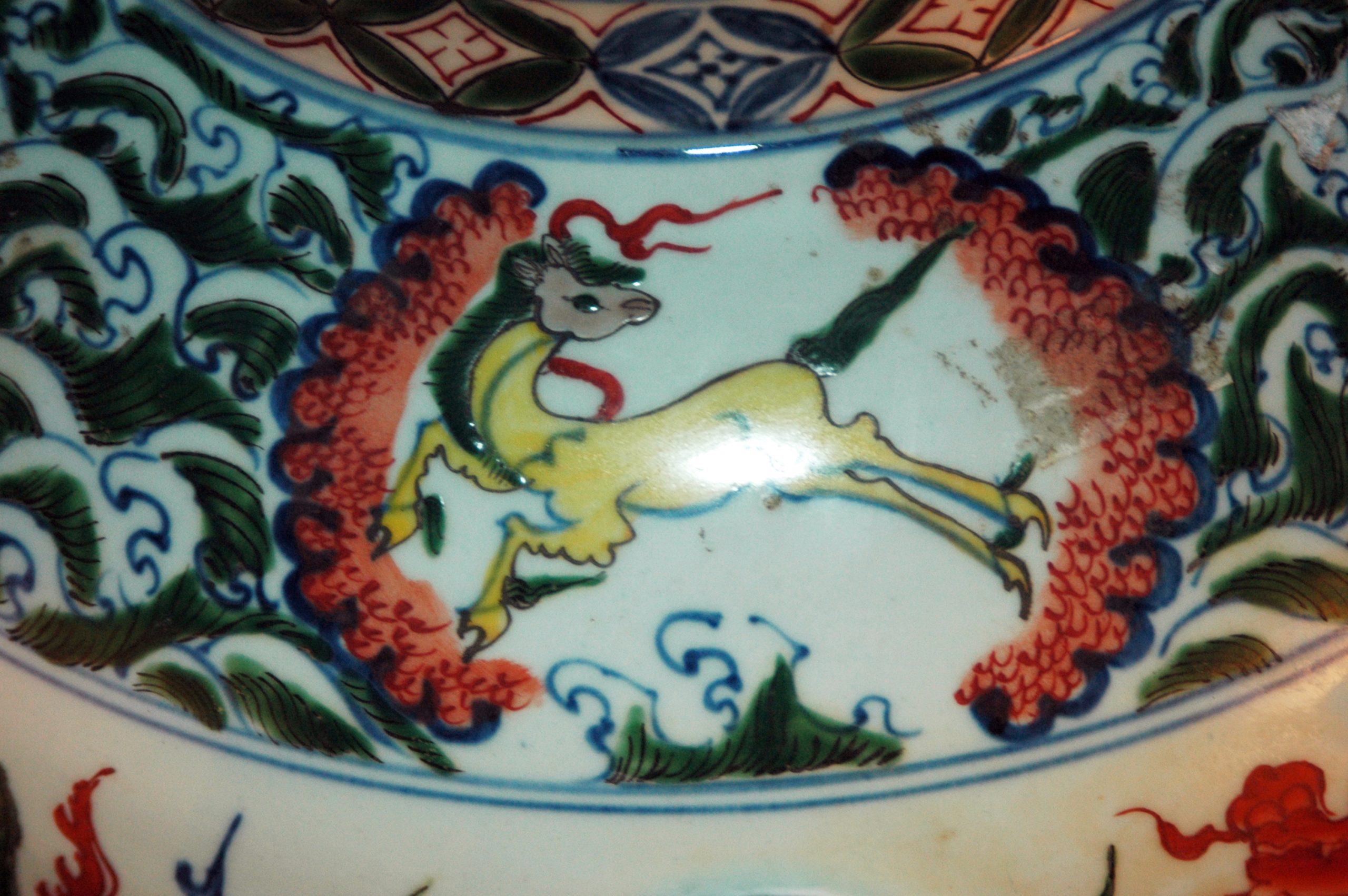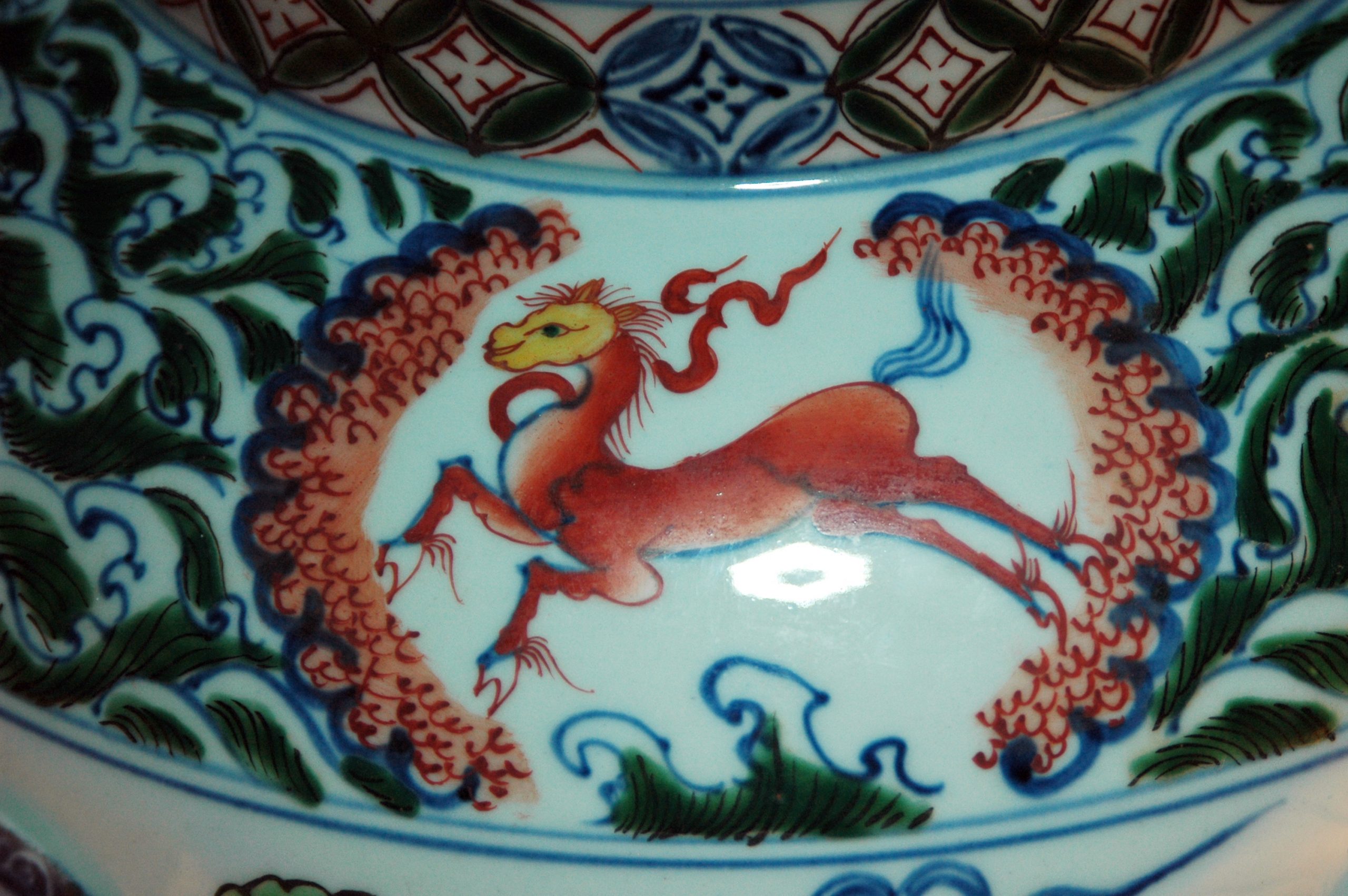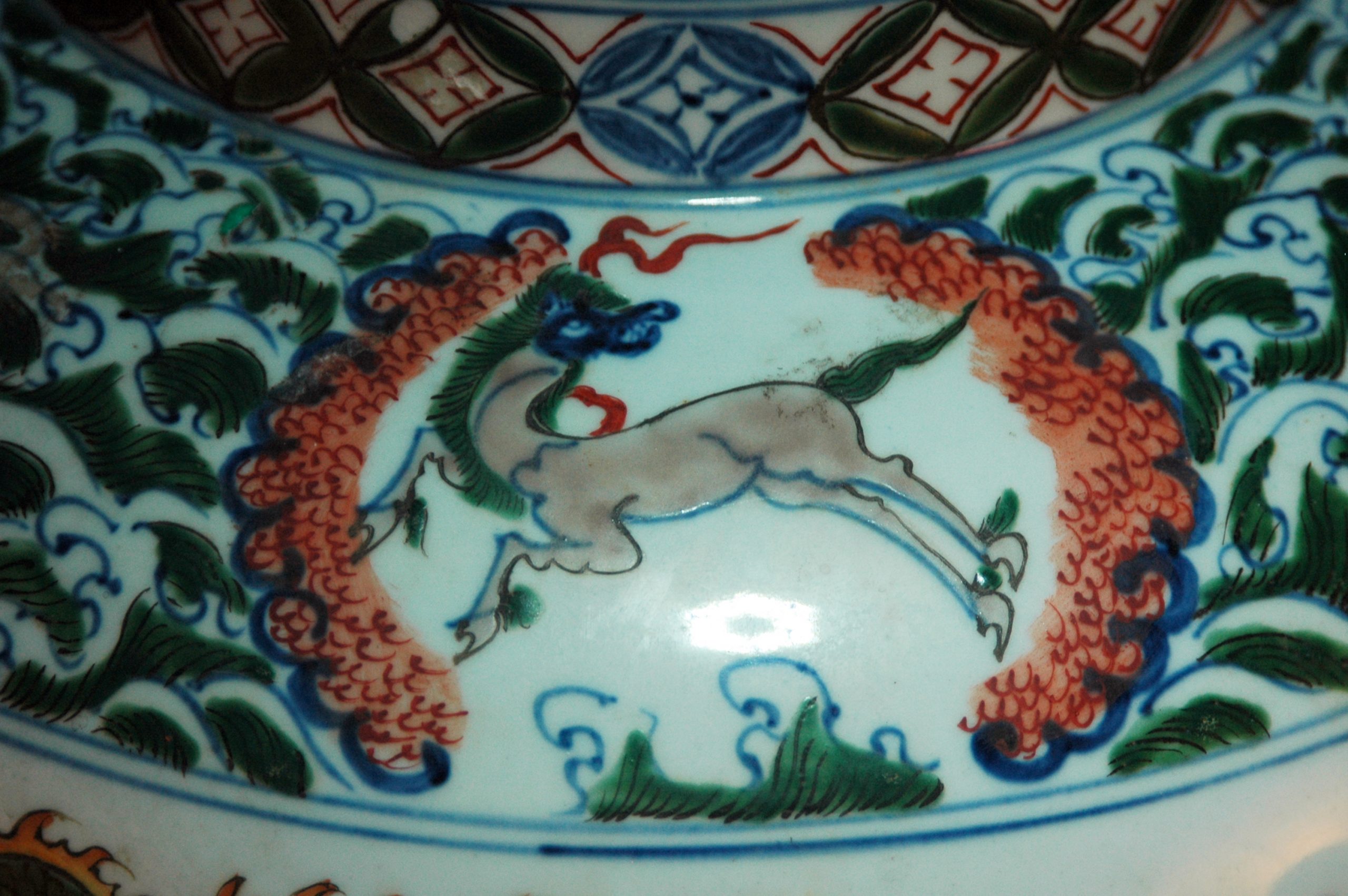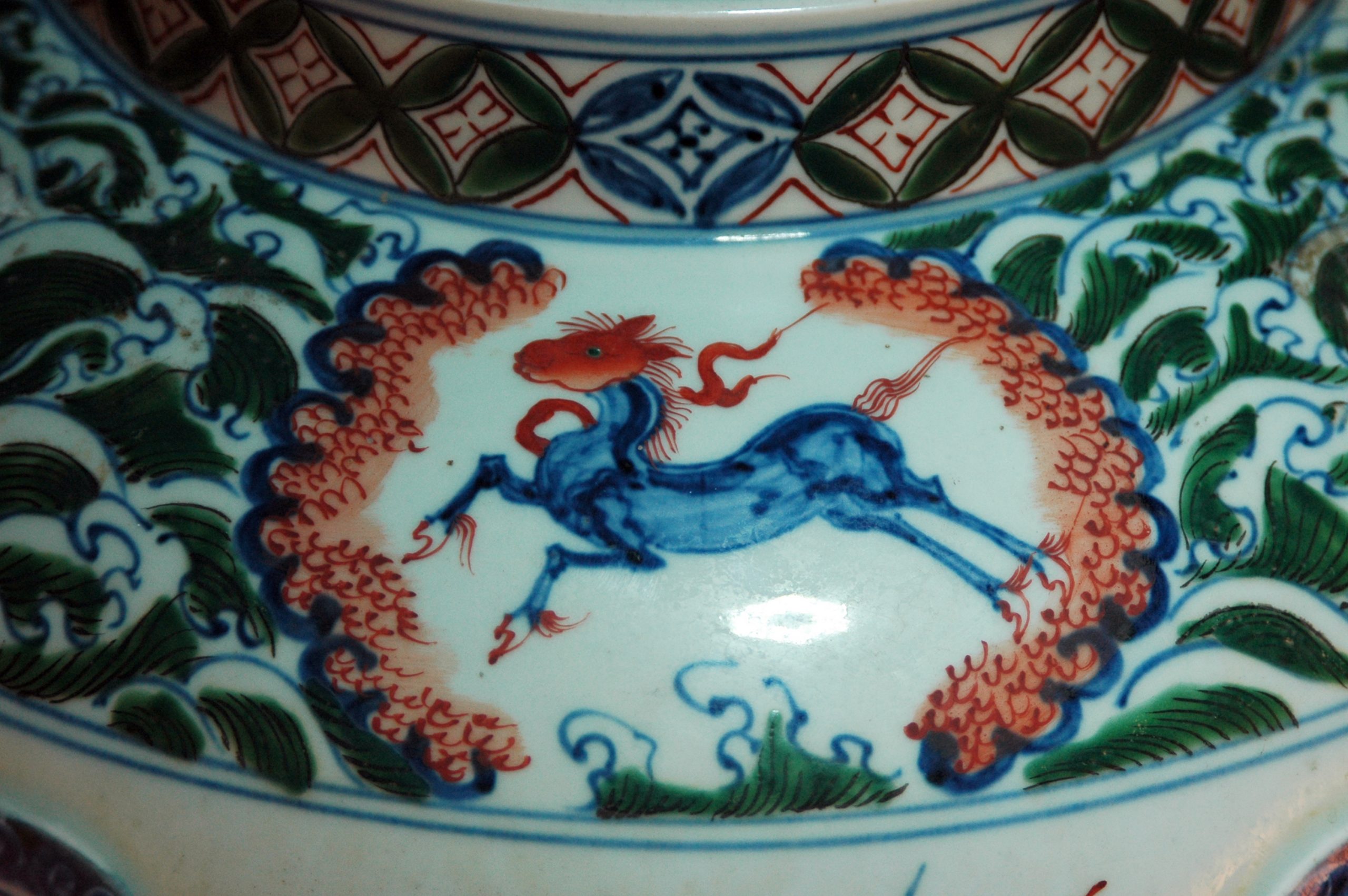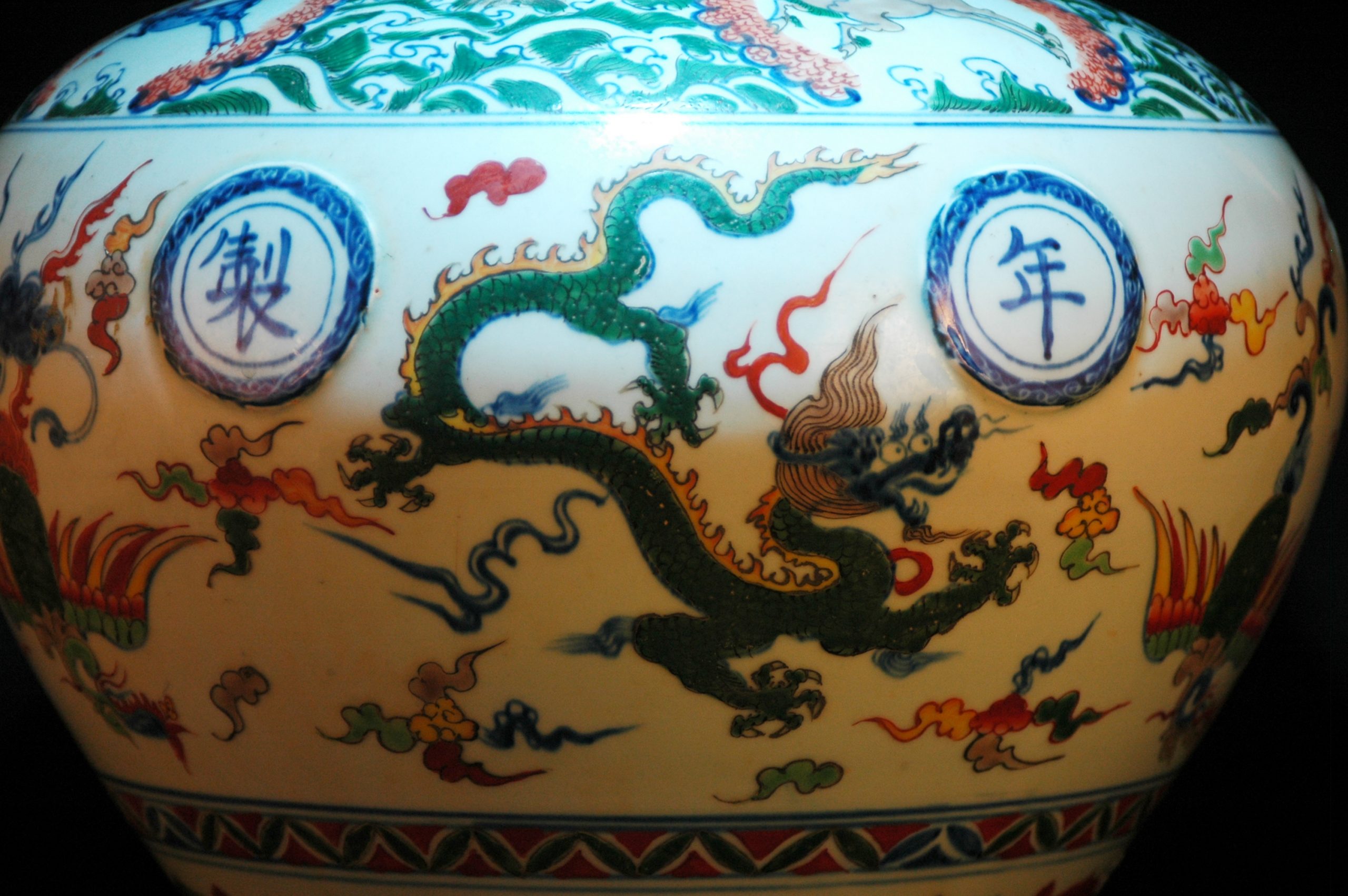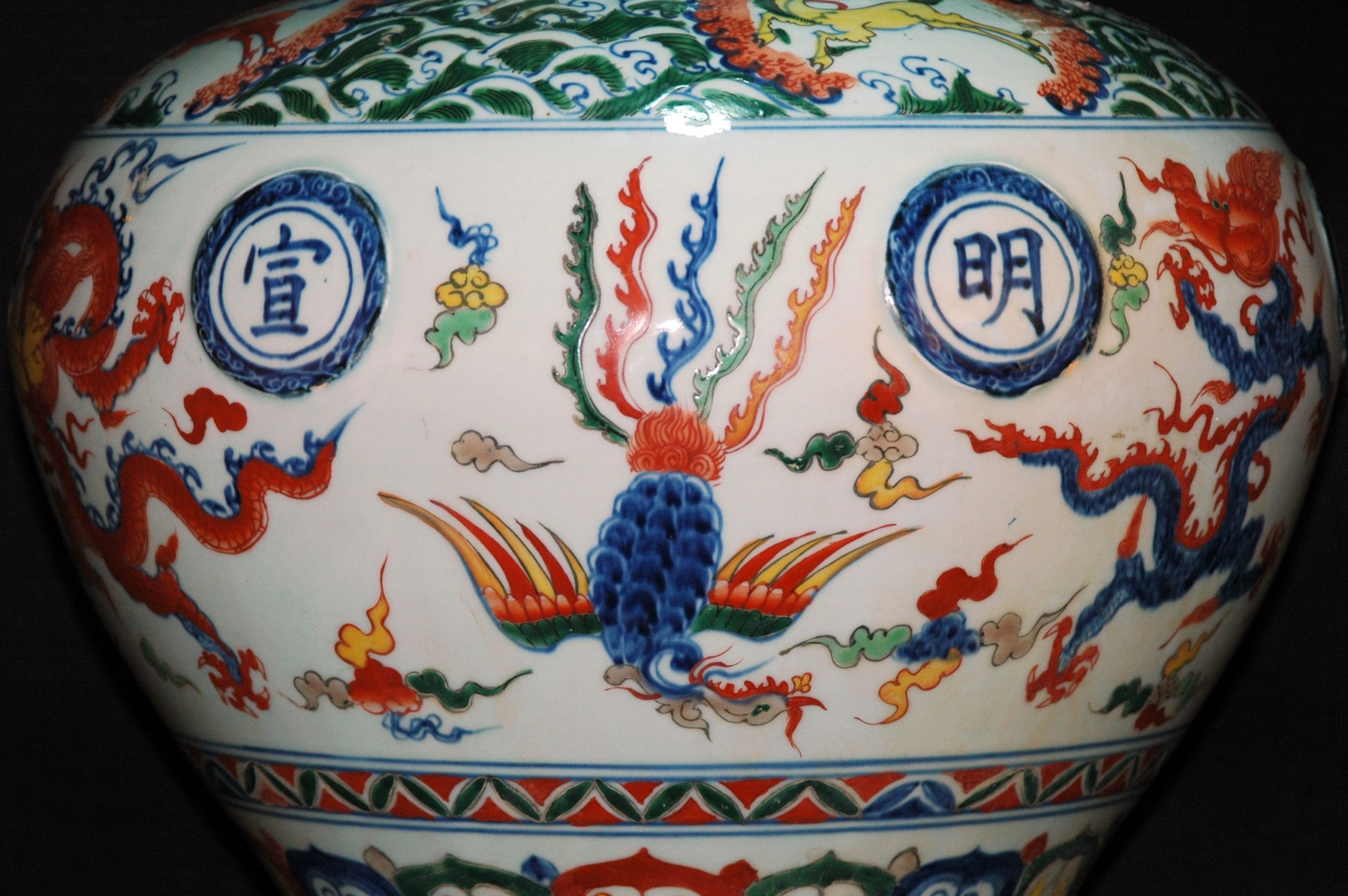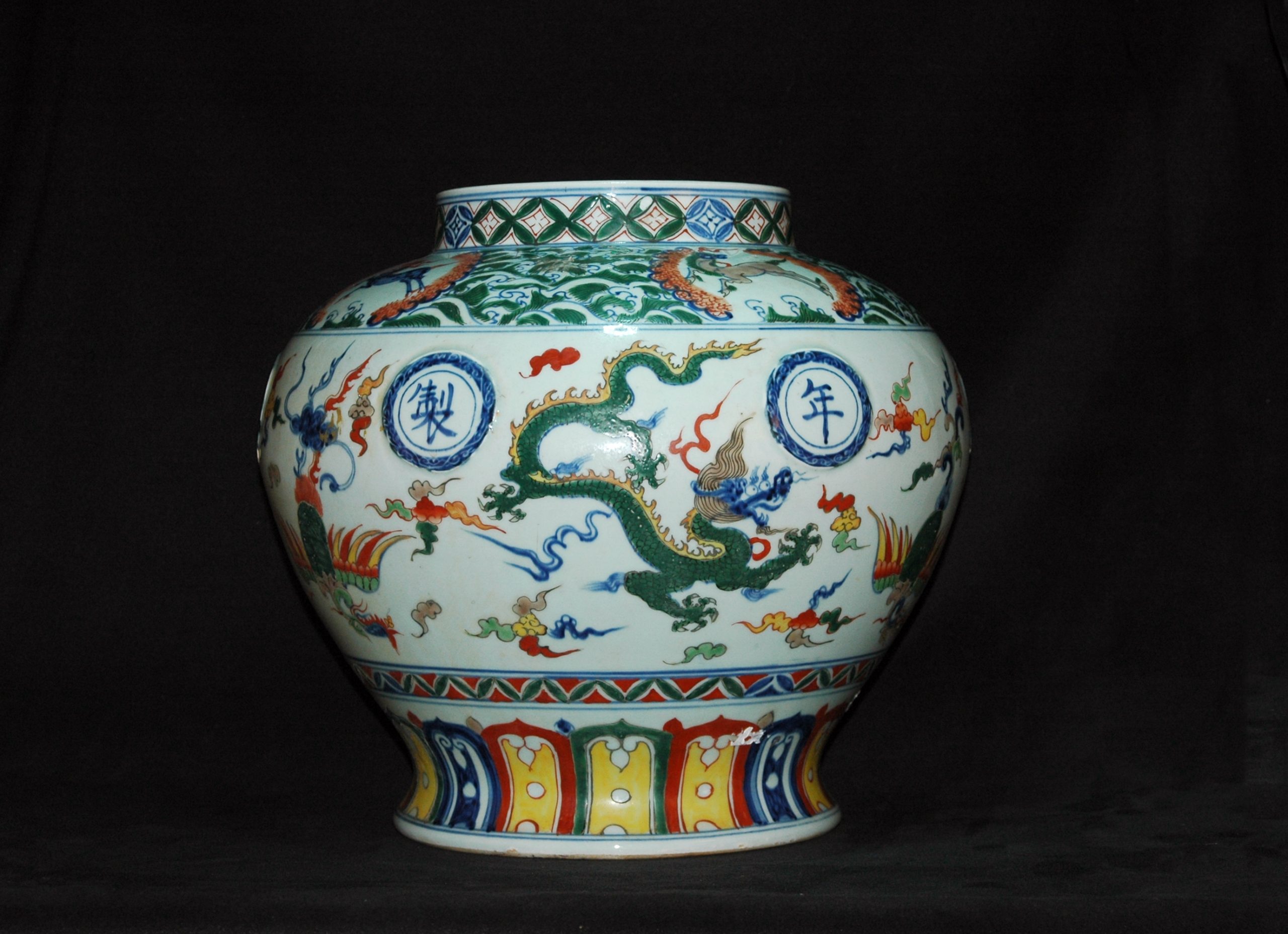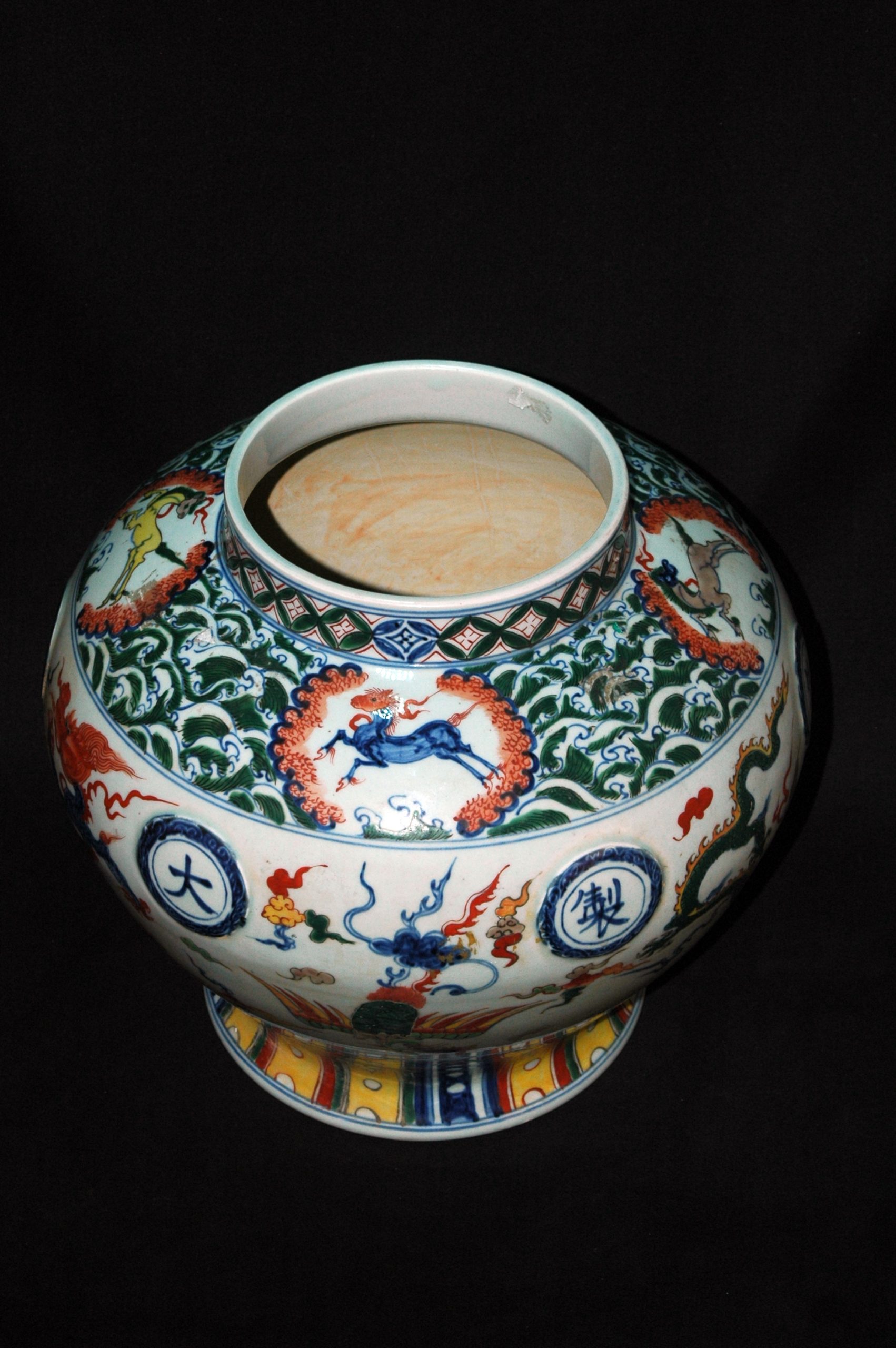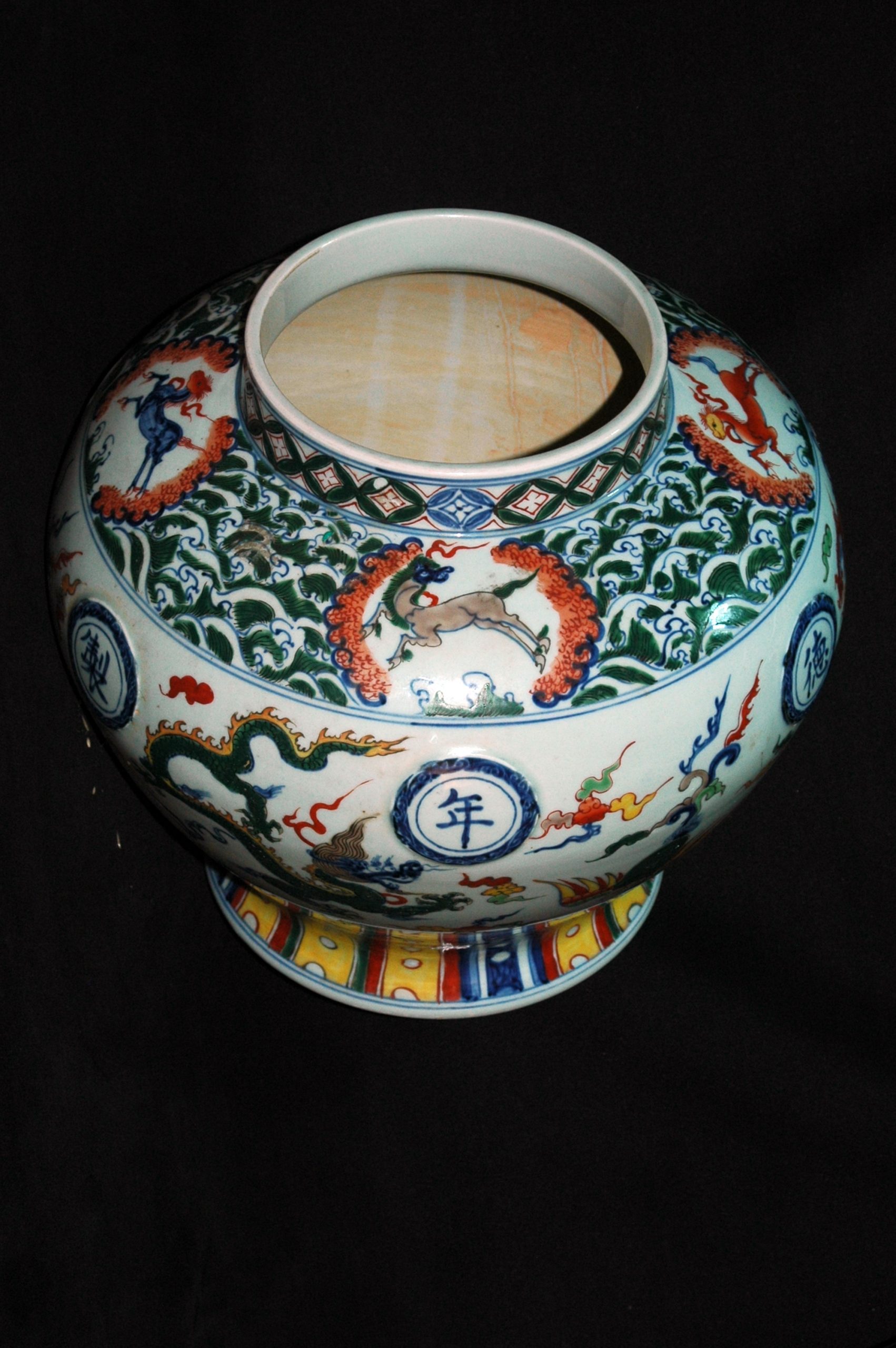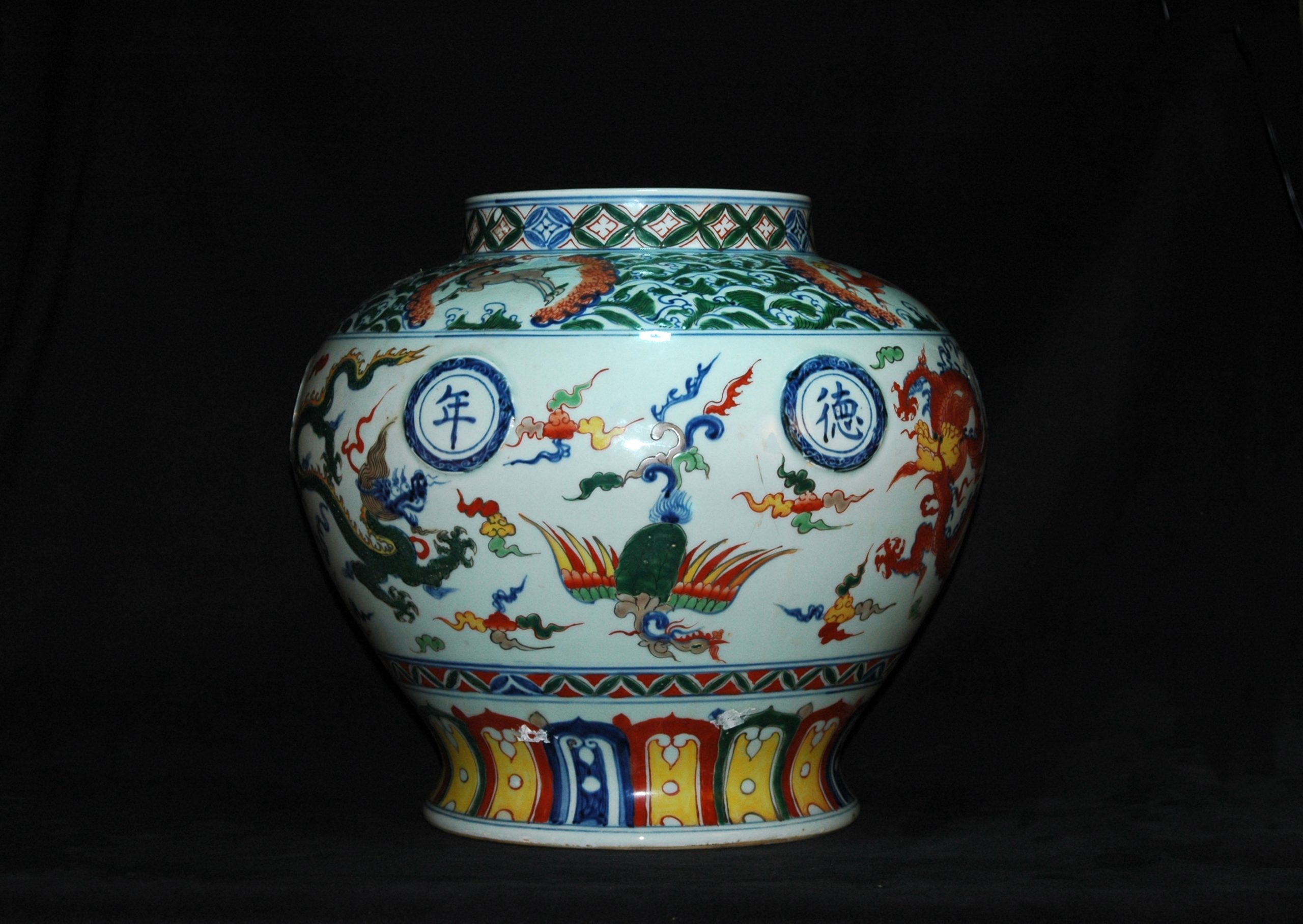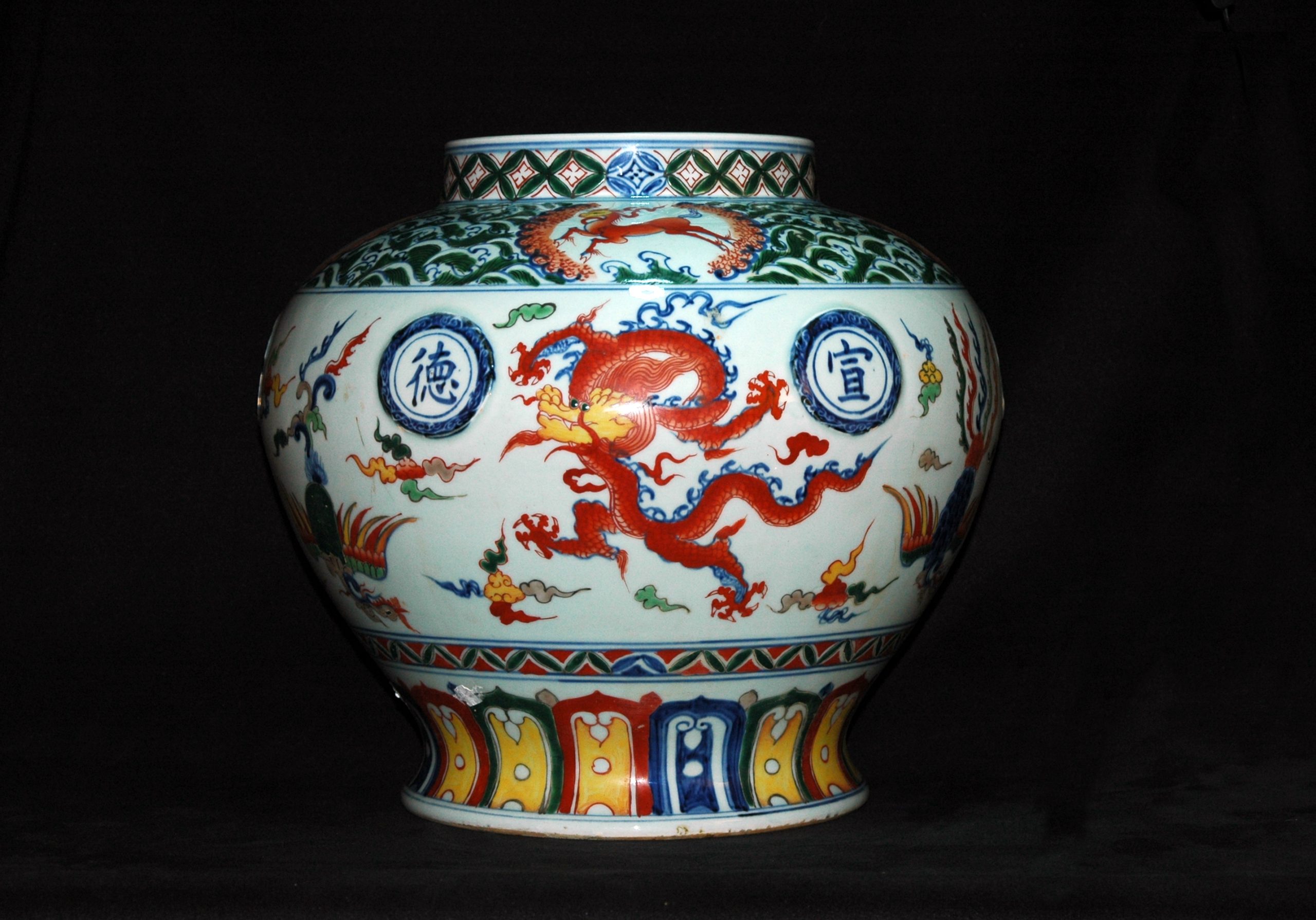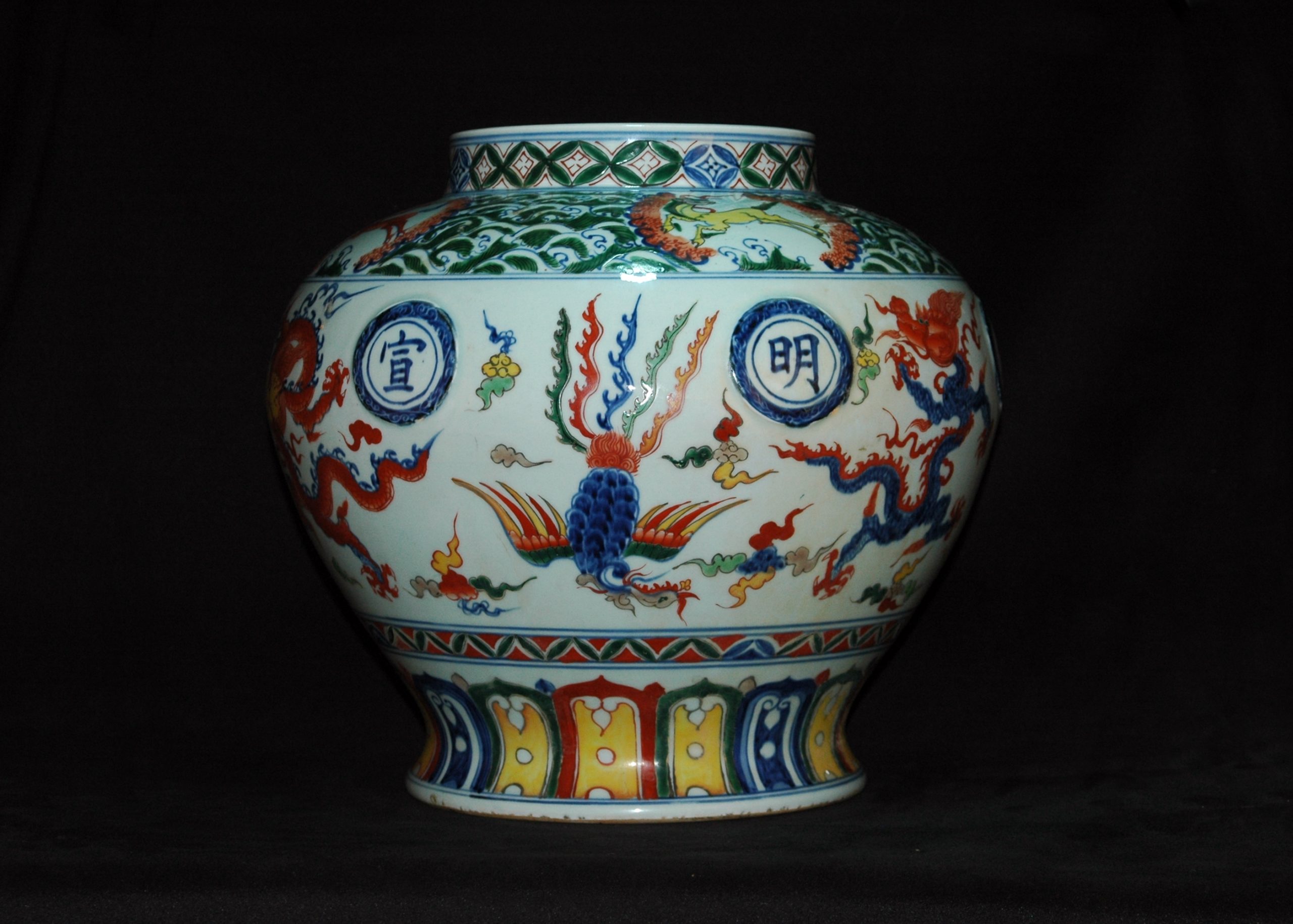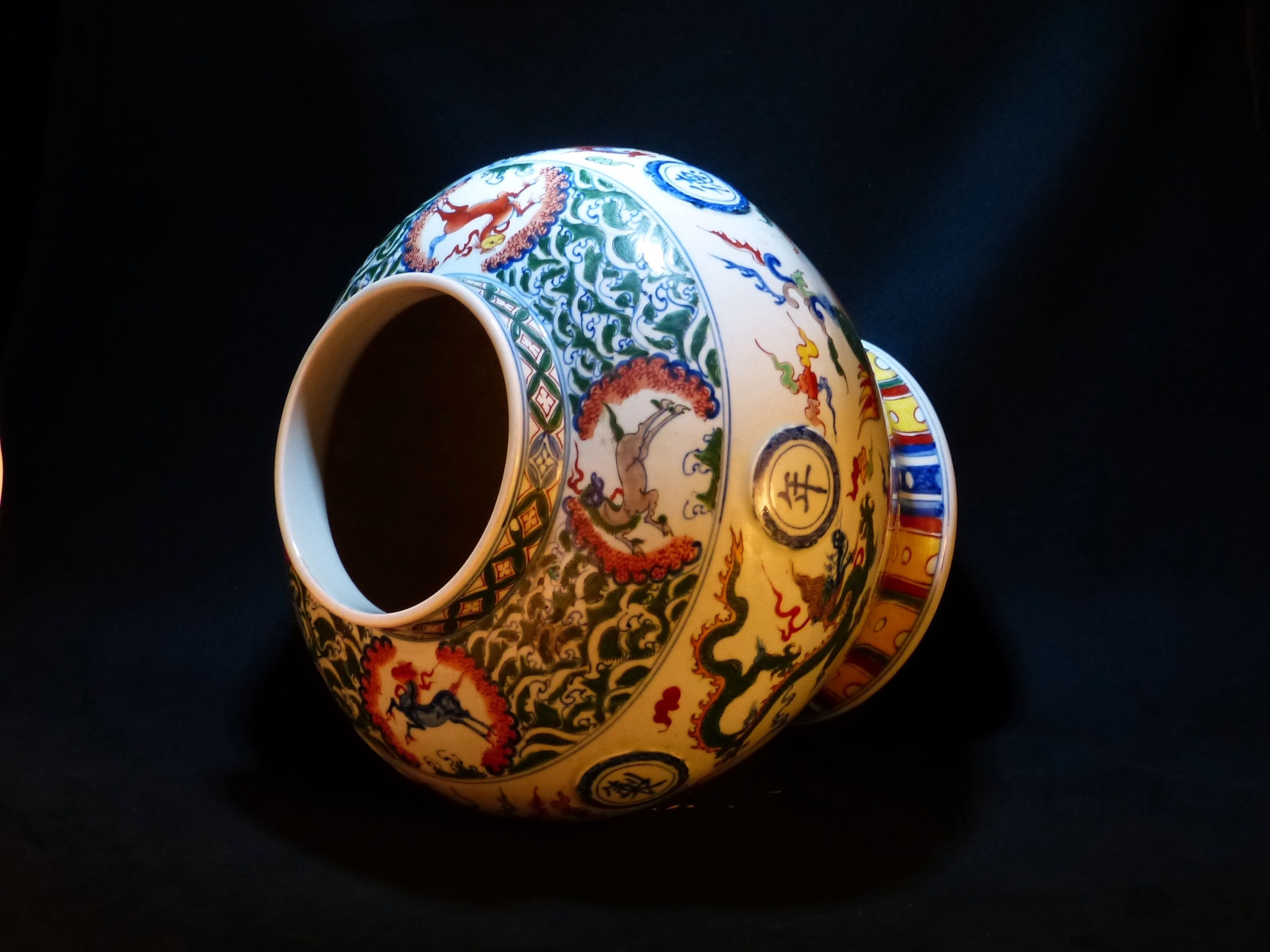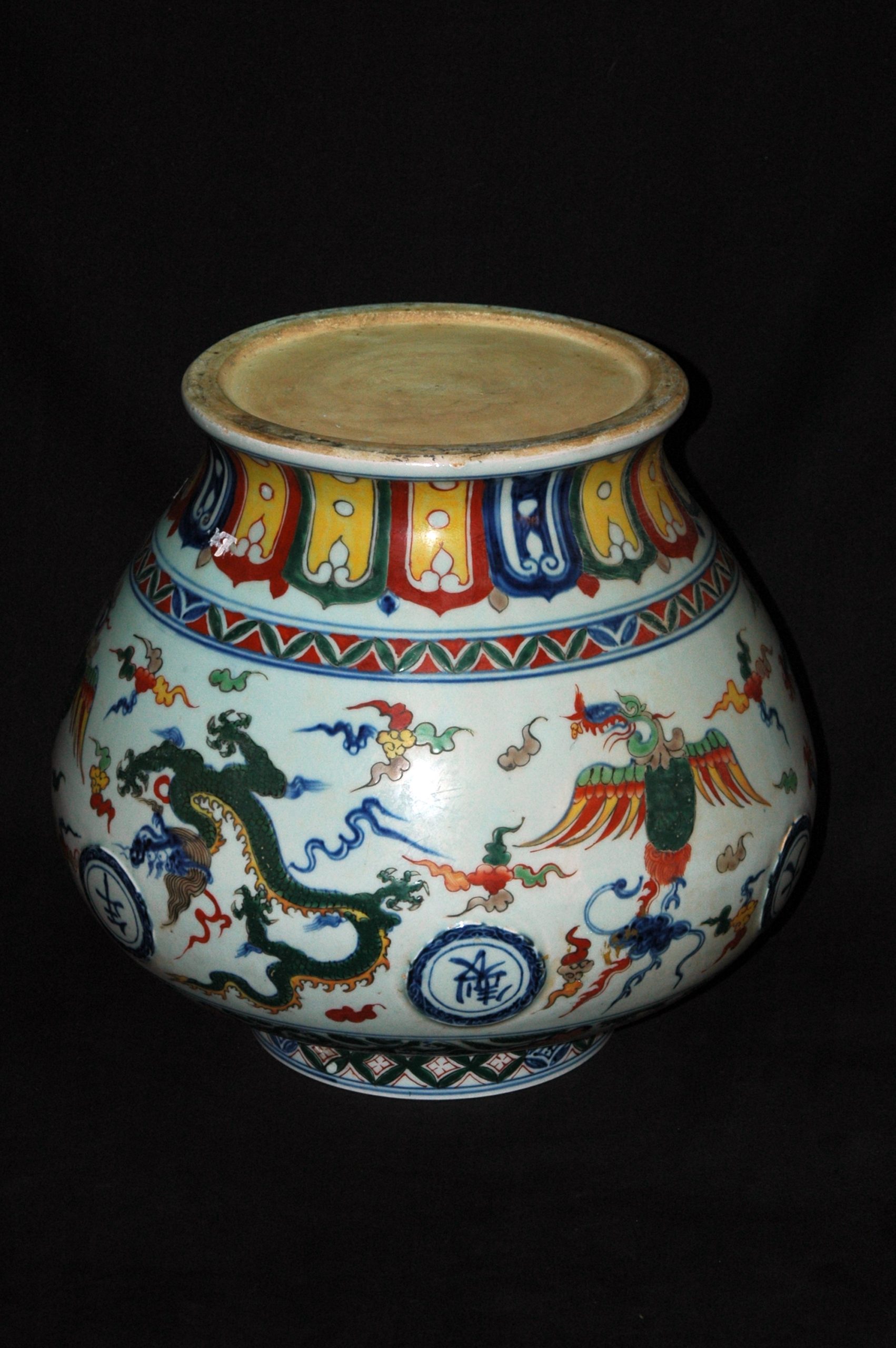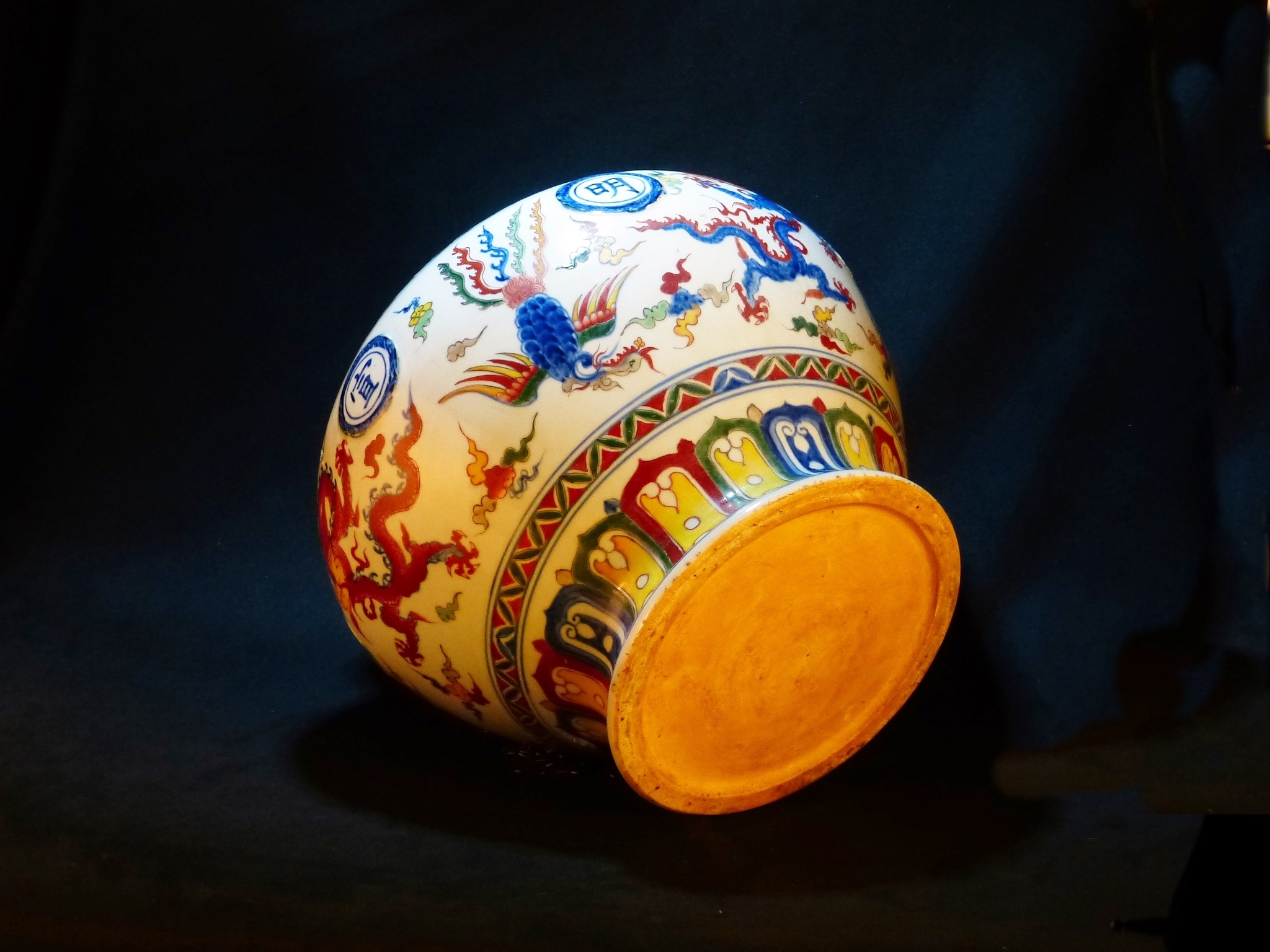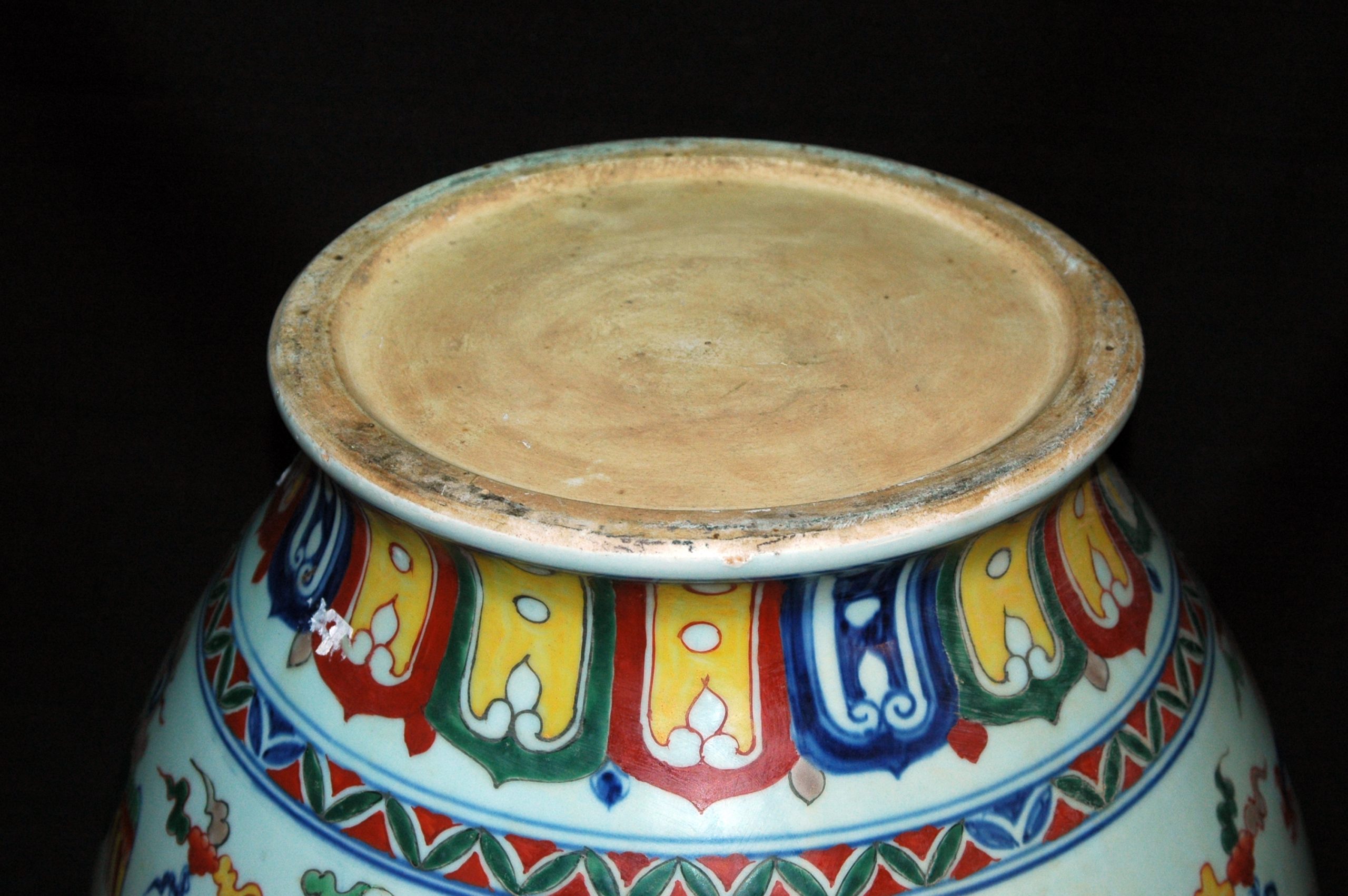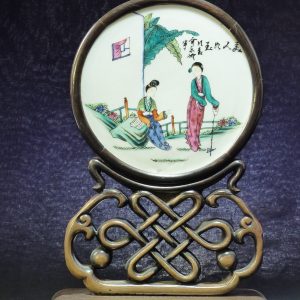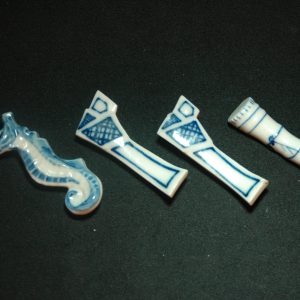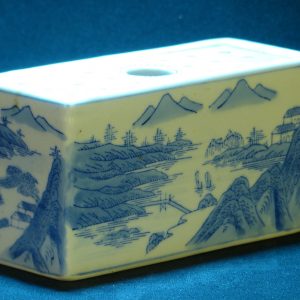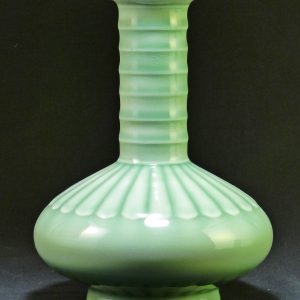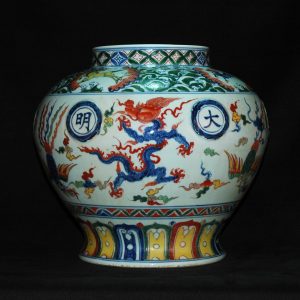Description
大明宣德年制 青花五彩海马龙凤云纹大罐
参考:Sotheby’s 博古5000年
CHINA / 5000 YEARS
326 A rare wucai ‘fish’ jar Mark and period of Jiajing
明嘉靖 五彩魚藻紋罐 《大明嘉靖年製》款
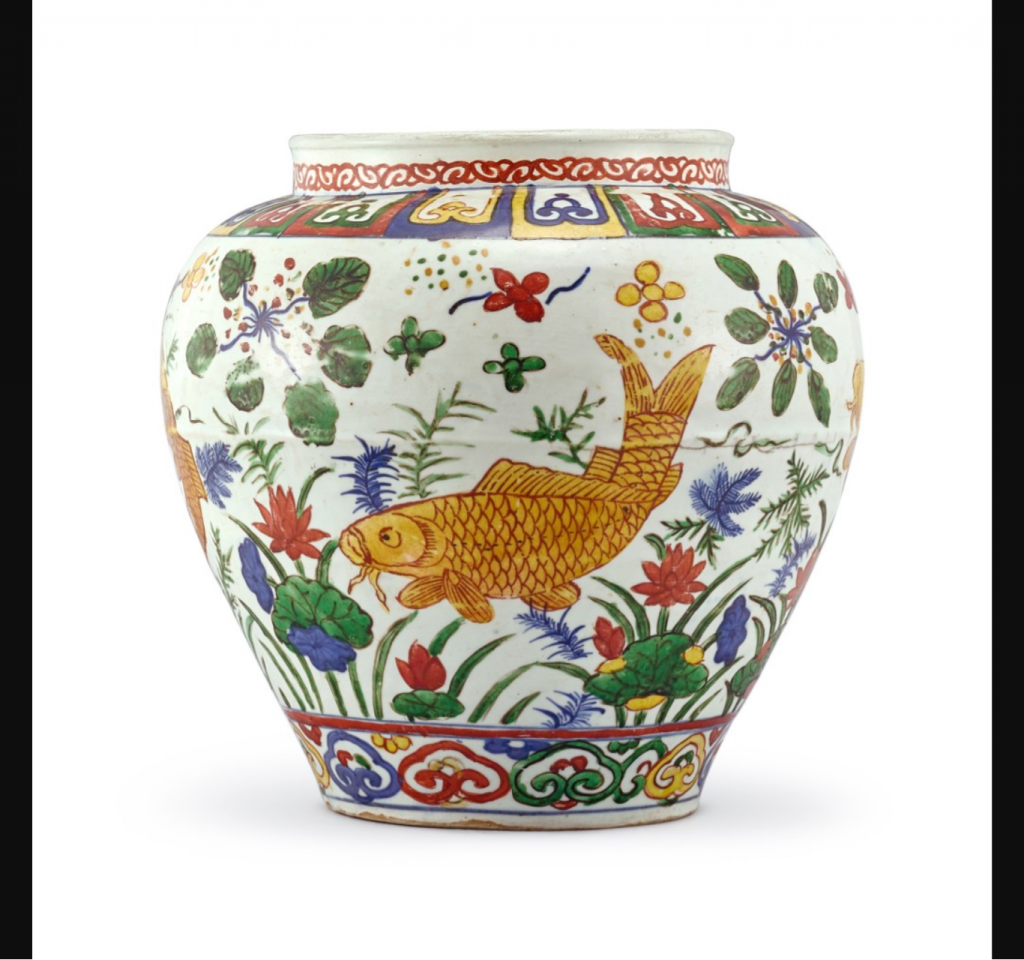
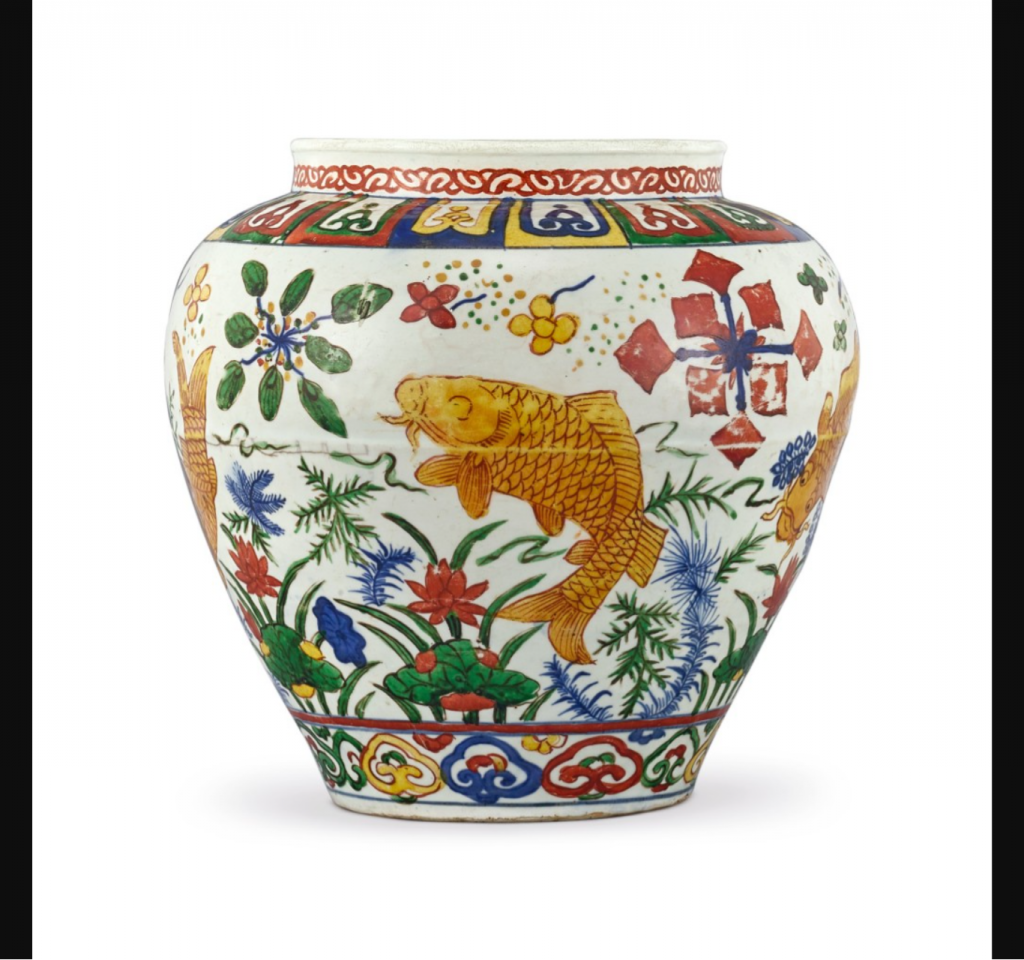
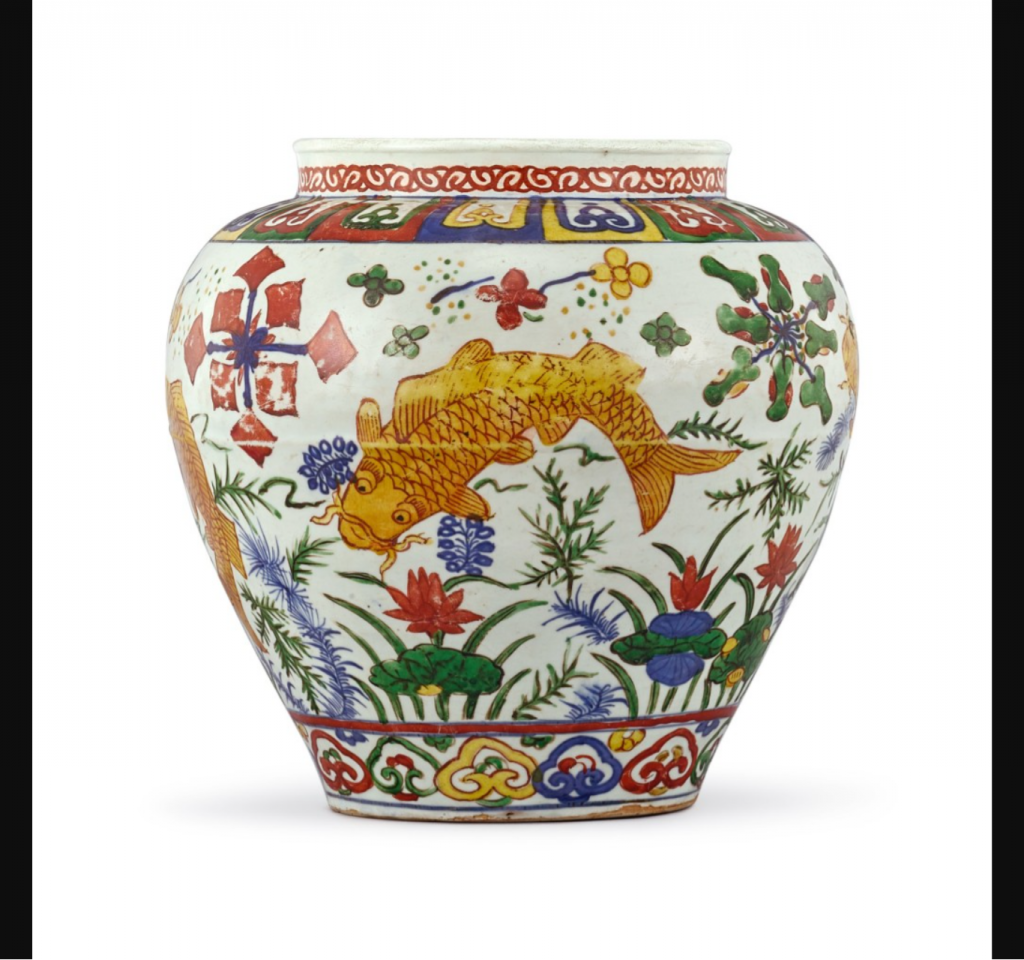
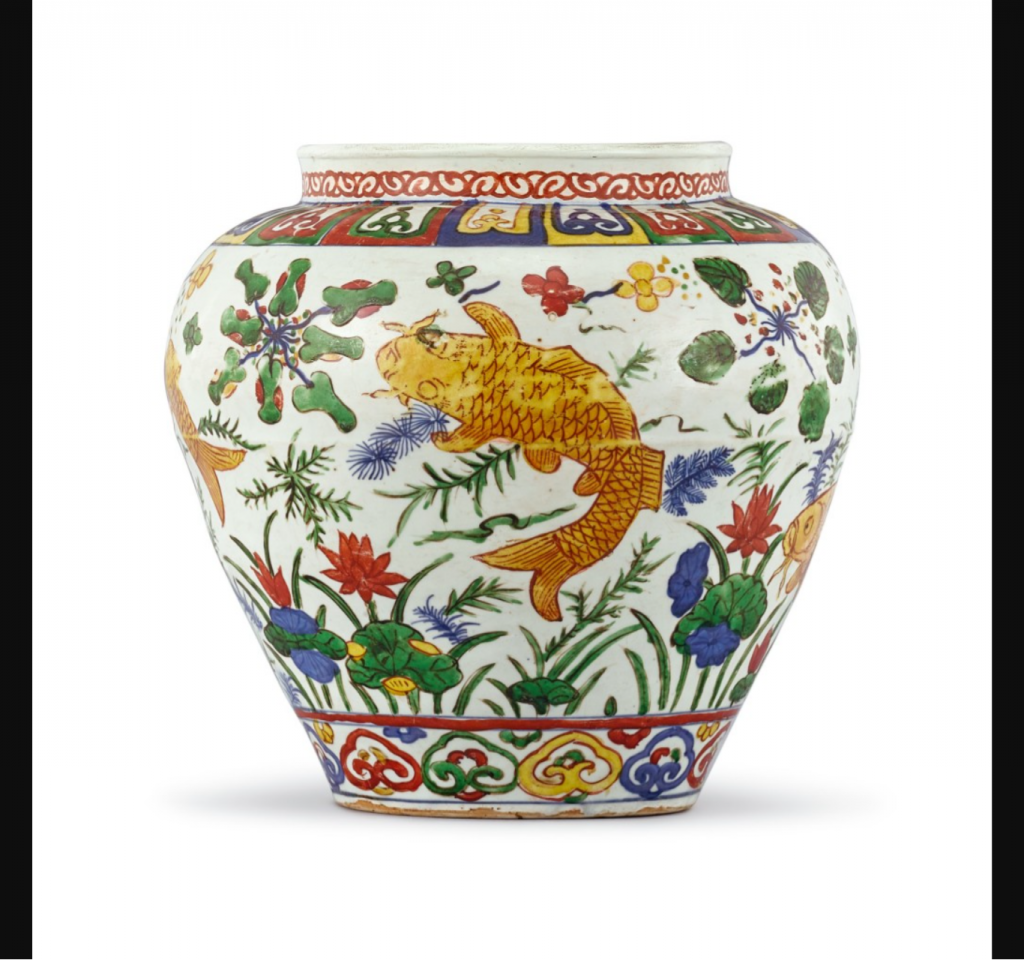
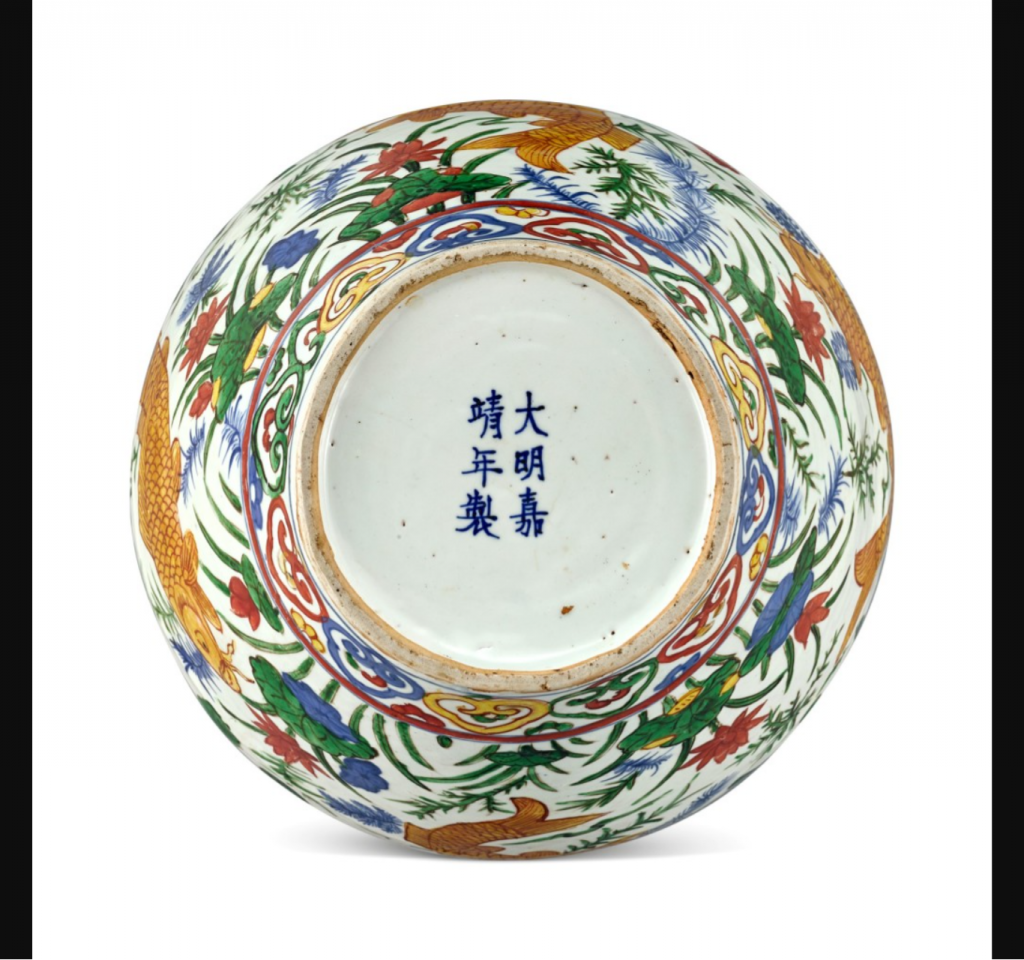
Estimate:1,000,000 – 1,500,000 HKD
Lot sold:3,780,000HKD
Description
A rare wucai ‘fish’ jar
Mark and period of Jiajing
明嘉靖 五彩魚藻紋罐 《大明嘉靖年製》款
Japanese wood box
23.7 cm
Condition Report
The rim is covered with overpaint, it is impossible to detect under UV examination whether there are any significant areas of non-original porcelain. Small sections of the shoulder have been very lightly polished. Minor firing imperfections including firing cracks along the luting line. The enamels are preserved well with just minimal wear.
口沿有補彩,但即使在紫外光燈下仍未能判別有沒有重要填缺。肩上局部輕磨。輕量窰燒瑕疵,包括接胎線上的窰縫。彩料整體保存良好,僅有輕微摩損。
Provenance
Collection of Umehara Ryuzaburo (1888-1986).
梅原龍三郎(1888-1986年)收藏
Catalogue Note
Boldly painted with a whimsical scene of fish swimming amidst waterweeds, the present jar depicts one of the most iconic designs during the Jiajing period. It is an exceptional piece of imperial Chinese porcelain which embodied the Emperor’s obsession with ancient Daoist values, as well as a joyful notion of a carefree life.
The Jiajing Emperor is known as a fervent patron of Daoist causes, it is therefore not surprising that works of art produced under his reign are brimming with Daoist imagery. Fish as an image of freedom from restraints played an important part in Daoist thought since earliest times. They are symbols of the happy, free-spirited life. The free composition and vivid execution of the design on this and similar jars beautifully echo the merry spirit of its message.
The wucai (‘five colour’) palette used for its depiction is a rare version specific to the Jiajing reign that is particularly complex. The available range of ‘five colours’, consisting of underglaze blue and overglaze red, yellow, green and aubergine, was here enlarged further by a sixth: superimposing red on yellow enamel, which required an additional firing, resulted in a rich golden-orange tone ideally suited to render the colour of golden carp, among the most coveted species of fish in China. This complicated wucai style was developed in the Jiajing period and seems to be restricted to that reign. reign.
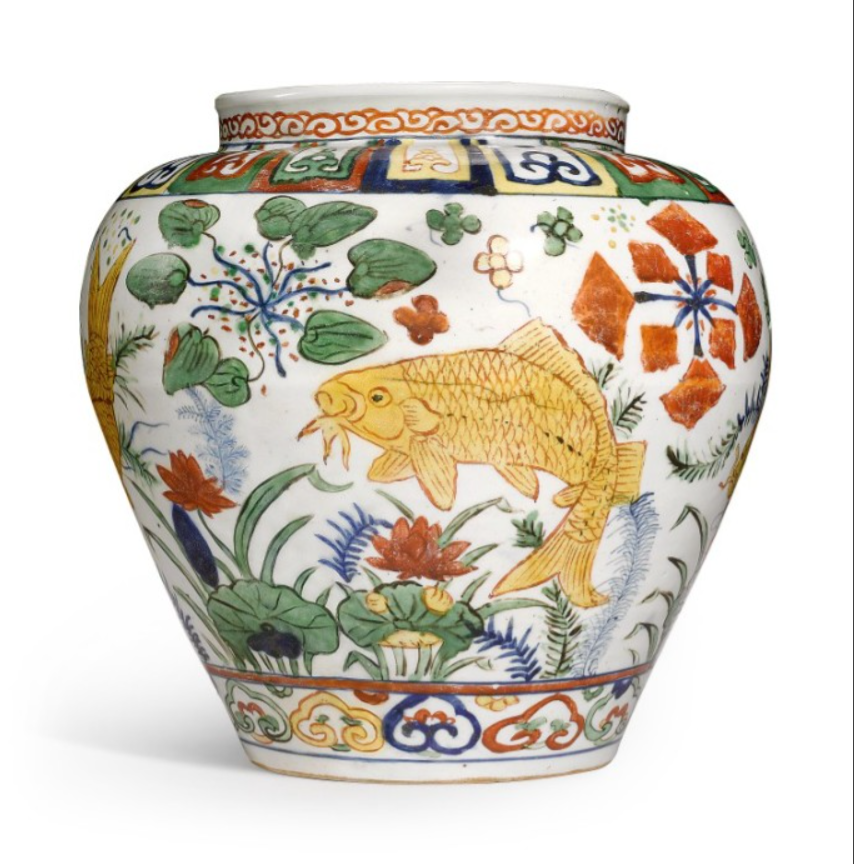
圖一 明嘉靖 五彩魚藻紋罐,售於倫敦蘇富比2012年11月7日,編號325。
Two closely related jars from the Henry Oppenheim collection and now in the British Museum are illustrated in Jessica Harrison-Hall, Ming Ceramics, London, 2001, pls 9:117 and 9:118; and another sold in our London rooms, 7th November 2012, lot 325 (Fig. 1). Jiajing wucai fish jars were also made in a variety of sizes, see two larger jars in the Shanghai Museum (Lu Minghua, Shanghai Bowuguan zangpin yanjiu daxi/Studies of the Shanghai Museum Collections: A Series of Monographs. Mingdai guanyao ciqi [Ming imperial porcelain], Shanghai, 2007, pls 3-88 and 3-89).
Umehara Ryuzaburo (1888-1986) was a famous Japanese painter as well as an avid collector of Chinese porcelain and works of art. Fig. 2 shows a portrait of the artist with the present fish jar.
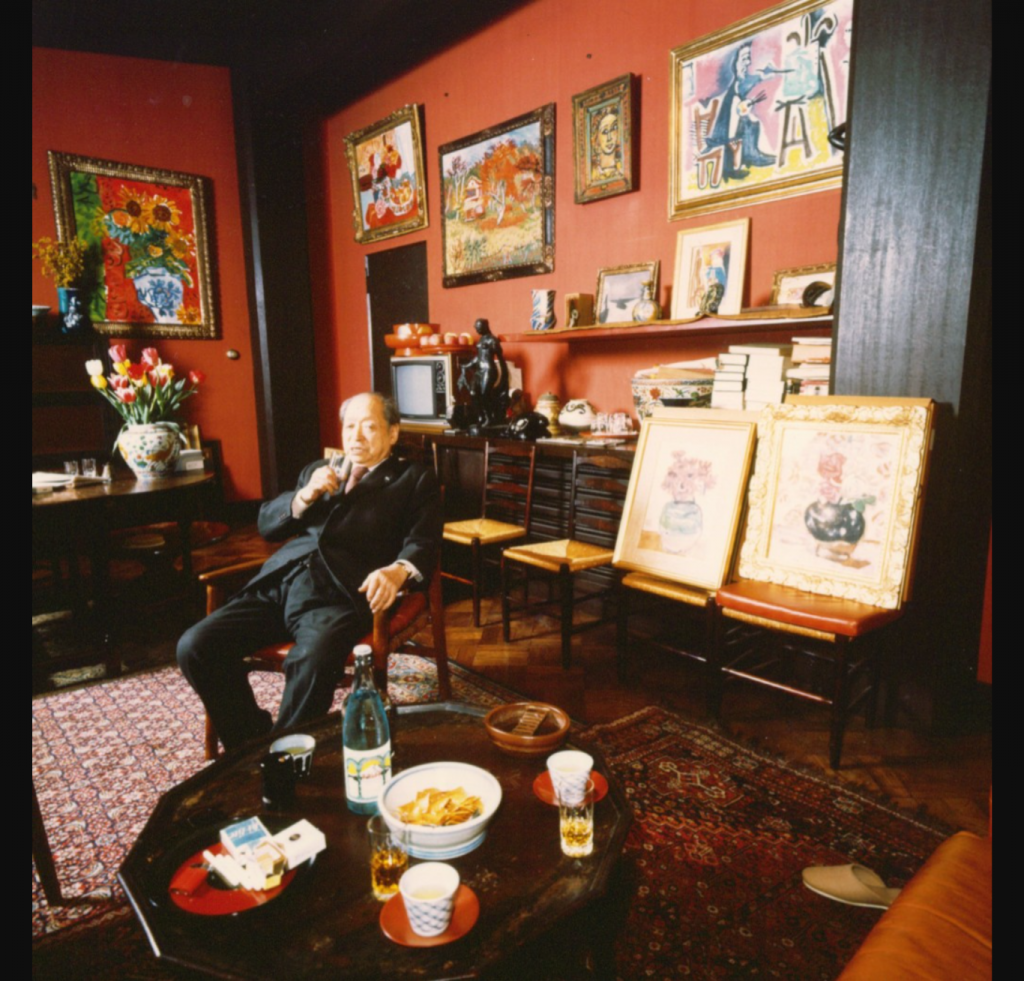
圖二 梅原龍三郎及明嘉靖五彩魚藻紋罐(本拍賣編號326) KONICA MINOLTA AccurioPress C308
自古,游魚便是自由無拘的象徵,是以在道家哲學思想中尤為重要。嘉靖一朝,世宗政績雖乏善可陳,亦鮮少傾心藝術,卻篤信道教,追求長生靈藥,推崇術法。江西景德鎮御窰廠及其他宮廷作坊亦多採用相應道教圖像。游魚象徵道家崇尚逍遙無憂,和諧萬物之生活方式,異於憂慮無常苦難,與中國帝王之入世角色大相逕庭,是以為君主所嚮往。如此圖紋不僅為官窰製瓷之佳例,其靈動巧妙,喜意盎然,實為中國御製工藝品之傑作。
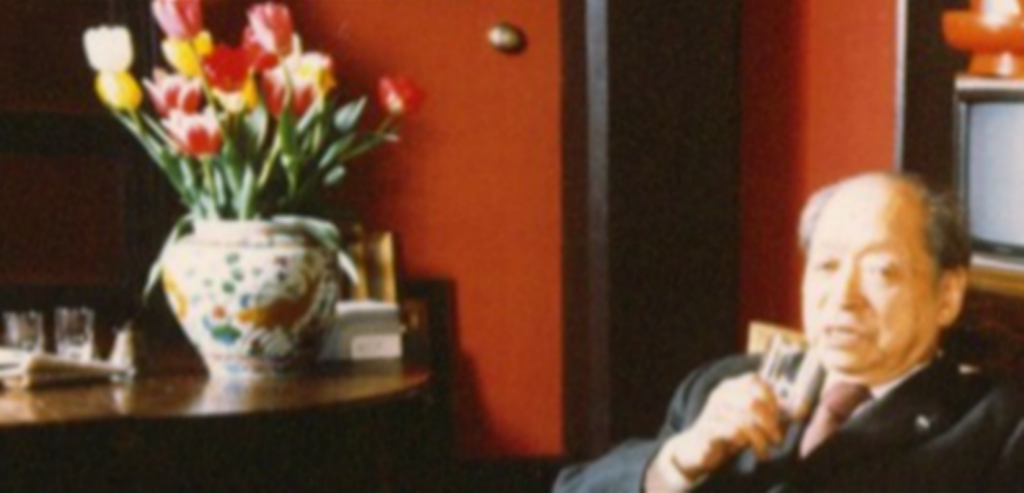
昔時,景德鎮御窰畫工應不乏摹本,可據不同畫稿繪魚游藻間之姿,以生動構圖及靈巧筆觸,呈現魚藻圖寓含之喜樂精神。本品所見之五彩魚藻紋,工序尤其複雜,因而僅現於嘉靖年間。原有之五彩釉色,釉下青花、釉上紅、黃、綠、紫彩,於此更增加第六彩,以黃釉上托紅彩,經過再一次燒造,調配出豔麗的金黃橘色,以繪飾金鯉鱗色,以顯尊貴。如此繁複的五彩技法,嘉靖年間創製,也僅見於嘉靖年間。
類同嘉靖五彩魚藻紋罐倫敦大英博物館藏有二例,均出自 Henry Oppenheim 收藏,載於霍吉淑,《Ming Ceramics》,倫敦,2001年,圖版 9:117 及 9:118。同可參照 倫敦蘇富比一例,售於2012年11月7日,編號325(圖一,见下列参考)。上海博物館藏有兩例,尺寸較大,參見陸明華,《上海博物館展品研究大系.明代官窰瓷器》,上海,2007年,圖版3-88、3-89。
梅原龍三郎(1888-1986年)乃日本著名畫家及中國藝術熱衷收藏家。圖二為梅原龍三郎及本拍賣編號326明嘉靖五彩魚藻紋罐之肖像。
Property from the collection of Umehara Ryuzaburo
Property from the collection of Umehara Ryuzaburo (1888-1986) 梅原龍三郎(1888-1986年)收藏
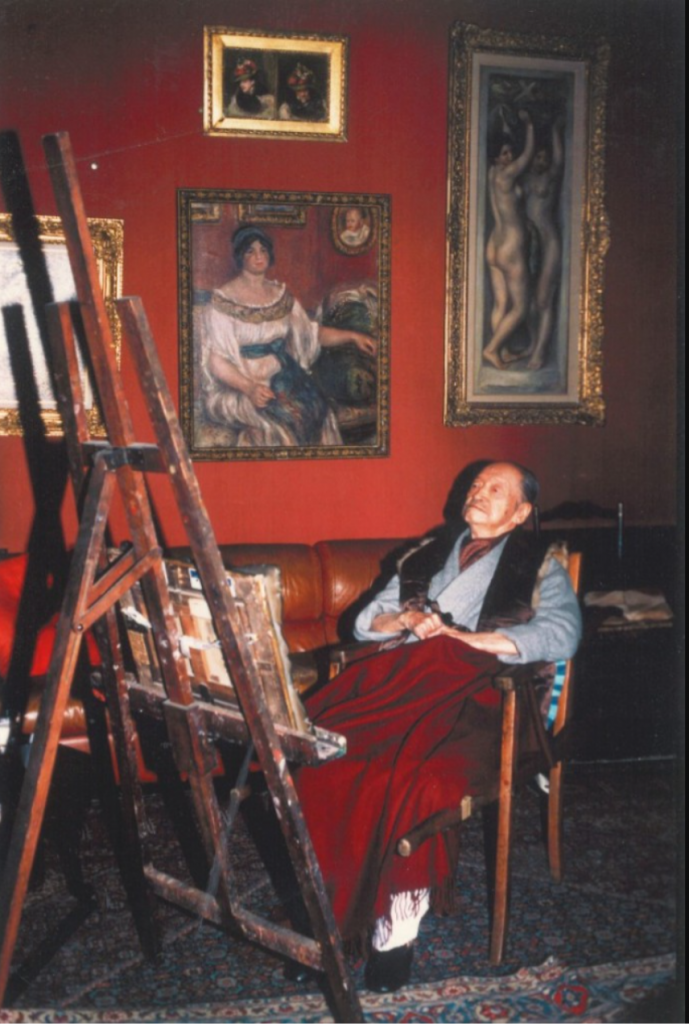
梅原龍三郎畫室留影
Lots 322-329 are from the collection of Umehara Ryuzaburo (1888-1986). Umehara Ryuzaburo was a renowned Japanese painter, he was one of the first Japanese artists to work in the Western style. Characterised by vibrant colours and expressive brushstrokes, his work had perpetual influences on the younger generation of Japanese painters.
Born to a family of textile merchants in Kyoto, Umehara Ryuzaburo’s surroundings honed his keen sensitivity to beauty and devotion to art. He was fascinated by China’s rich cultural history and travelled to Beijing on numerous occasions for inspiration in his work. He painted many versions of the Forbidden Palace and Temple of Heaven, which became two of his signature subjects. During his sojourns in Beijing, he paid frequent visits to the Liulichang and other antique shops, and became an avid collector of Chinese antiquities.
As an artist, Umehara Ryuzaburo also practiced under the famous Impressionist Painter Pierre-Auguste Renoir and was noted by him as a natural colourist. Umehara Ryuzaburo’s affinity to dynamic compositions and vivid hues is also reflected in the colourful wucai porcelain from his collection in this sale.
拍品編號322-329出自日本著名畫家梅原龍三郎(1888-1986年)收藏。其乃日本最早期之西方流派藝術家之一。其作品以豐富色彩、奔放風格及瀟灑筆觸見稱,對往後日本油畫藝術有着不可多得的深遠影響。
梅原龍三郎出生於明治時期京都一個織染世家,自小便圍繞在色彩豐盛和紋案多樣的染布團間,耳濡目染之下培養出他對美的敏銳度。其對中國傳統文化興趣濃厚,曾多次造訪北京為其繪畫尋找靈感。梅原龍三郎曾多次以北京紫禁城及天壇為題作畫,此兩景點亦成為其繪畫生涯裡最具代表性的主題。駐留北京期間,梅原龍三郎經常到訪琉璃廠及其他古董商店,成為一位熱衷的中國藝術收藏家。
梅原龍三郎亦曾留學法國時認識了著名印象派畫家雷諾瓦並成為其門生,被對方稱為「天生色彩家」。梅原龍三郎對豐富佈局及斑斕色彩的鍾愛,於本拍賣內之五彩御瓷中可見一斑。
参考:Sotheby’s
重要中國瓷器及工藝品
2012年11月7日 | 下午 1:00 GMT
倫敦
325
明嘉靖 五彩魚藻紋罐
《大明嘉靖年製》款
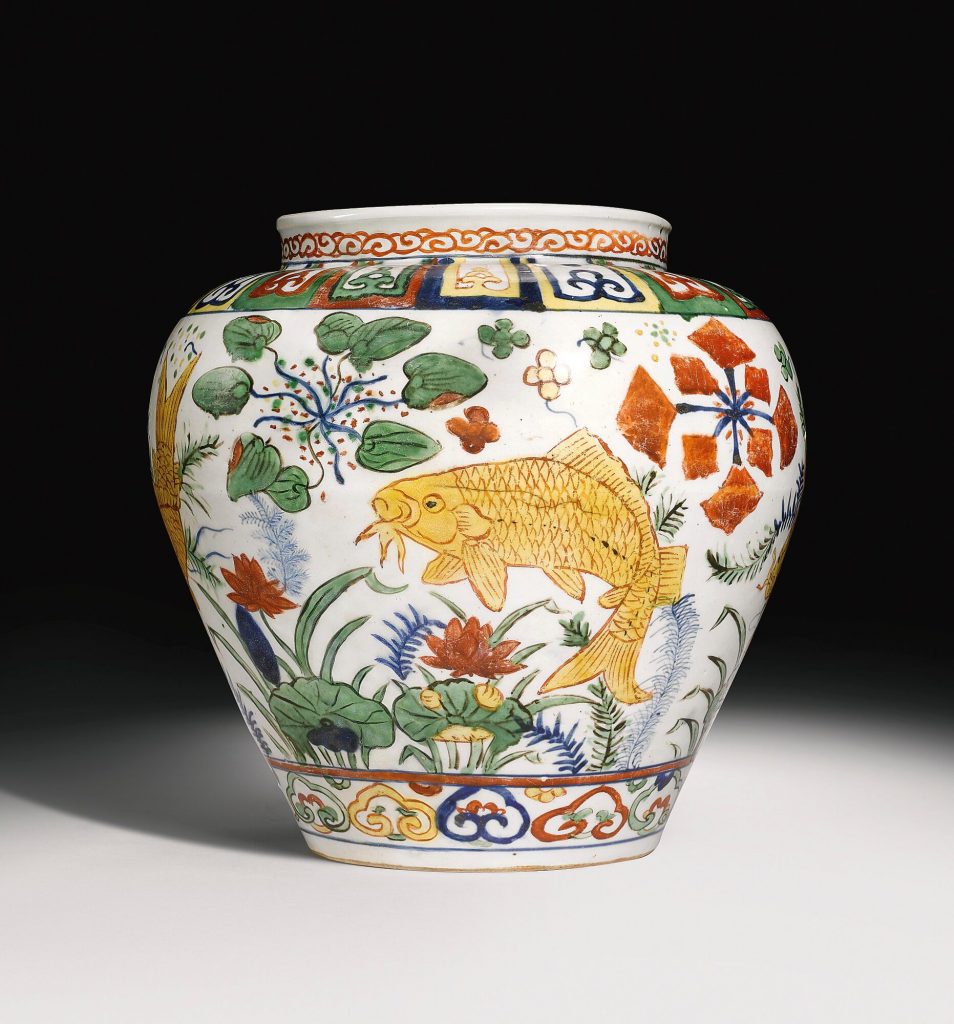
《大明嘉靖年製》款
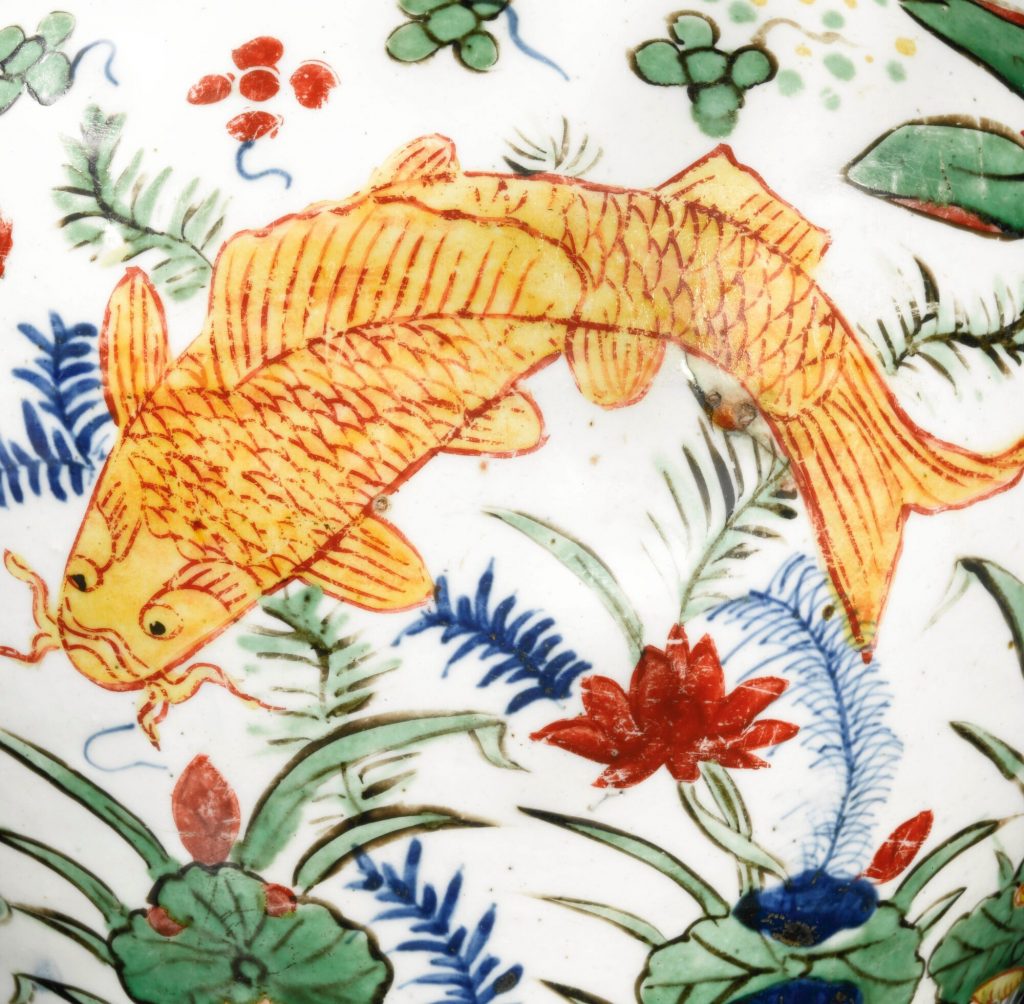
《大明嘉靖年製》款
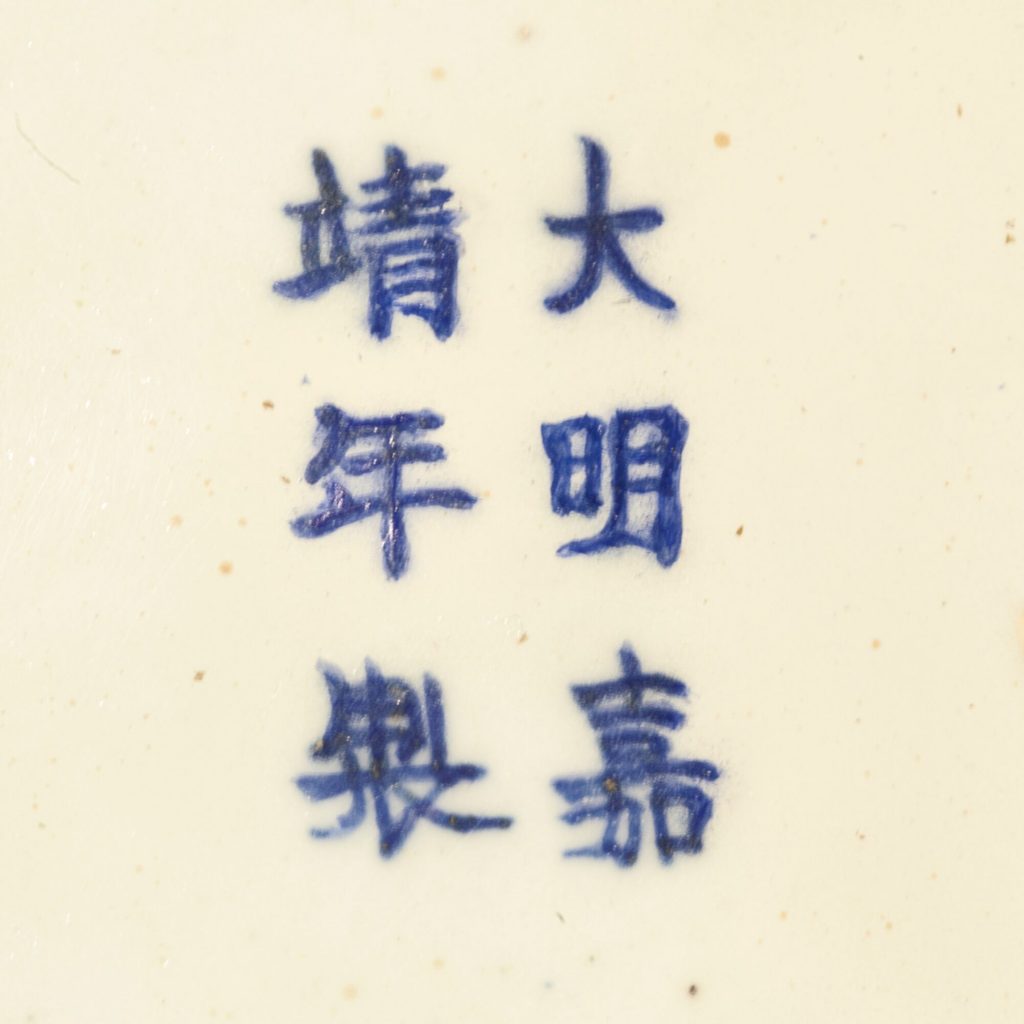
《大明嘉靖年製》款
估價 20,000 — 30,000 英鎊
拍品已售 205,250 英鎊 成交價 (含買家佣金)
數量: 2
23公分,9 1/8 英寸
來源
日本私人收藏
狀況報告
This rare jar has been well restored from several pieces with evidence of overpainting to three areas of the rim, through the body and across base. There is also some flaking and scratches to the enamels. Under UV examination it is not possible to detect any significant areas of non original porcelain, although as the jar has been in several pieces it is likely to have suffered some loss. The mark has been completely over-painted on top of the majority of the original mark – there is evidence of underglaze blue on the edges of the new over-glaze mark.
参考: 國立故宮博物院 明 嘉靖 五彩天馬蓋罐
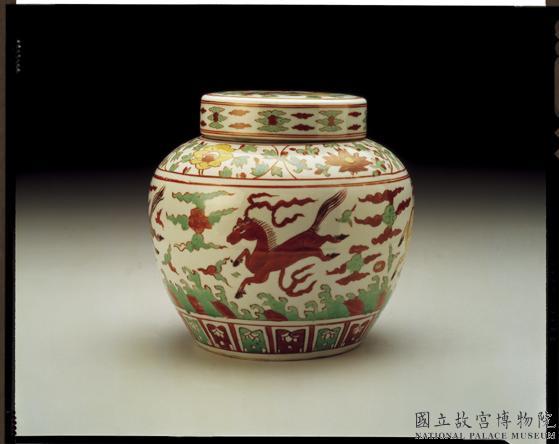
資料識別:故瓷005398N000000000
資料類型:陶瓷器
描述:
斂口,短頸,碩腹,淺圈足,帶平頂蓋。蓋面彩畫花卉六朵,邊飾雲紋,加飾紅線六道。器頸畫尖角紋一週,肩上畫纏枝花卉,腹部畫天馬四匹,間飾雲紋、波濤,底飾雲頭花。口足加飾紅線八道。底青花楷書「大明嘉靖年製」,外加雙圓圈。
日期:1522 A.D.-1566 A.D.
格式:高15.6公分 口徑9.3公分 底徑10.9公分
關聯:《福壽康寧-吉祥圖案瓷器特展目錄》
《故宮瓷器錄 第二輯 明(乙)》
参考: 故宫博物院【五彩云鹤纹罐】
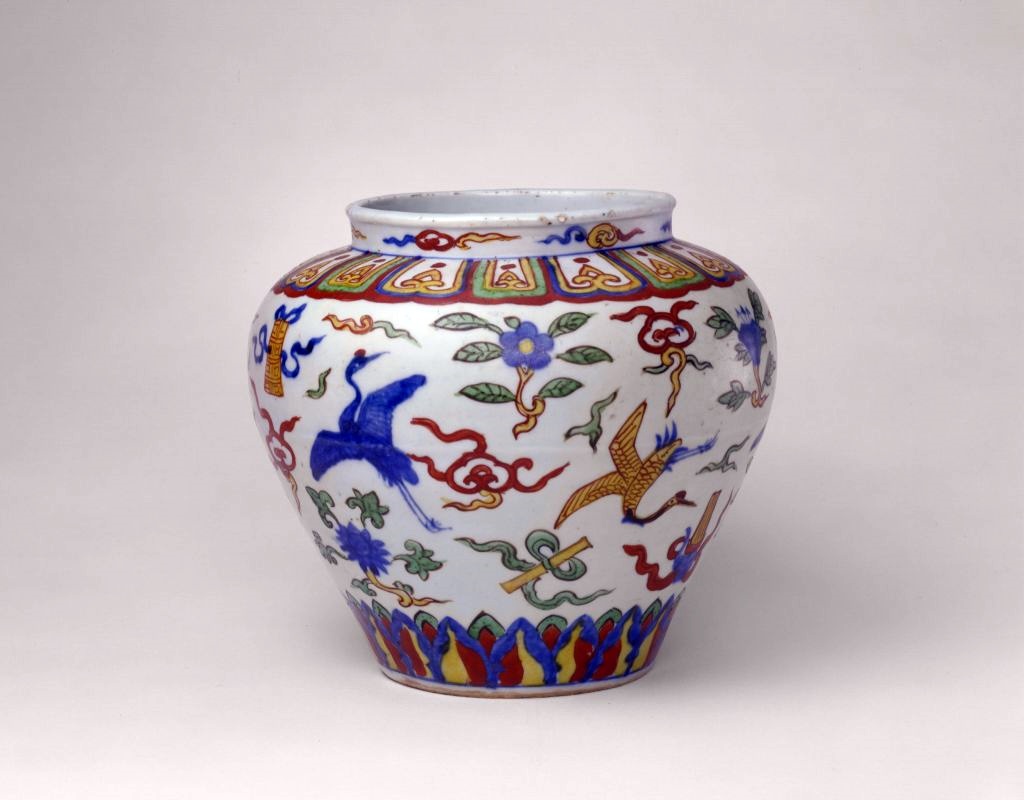
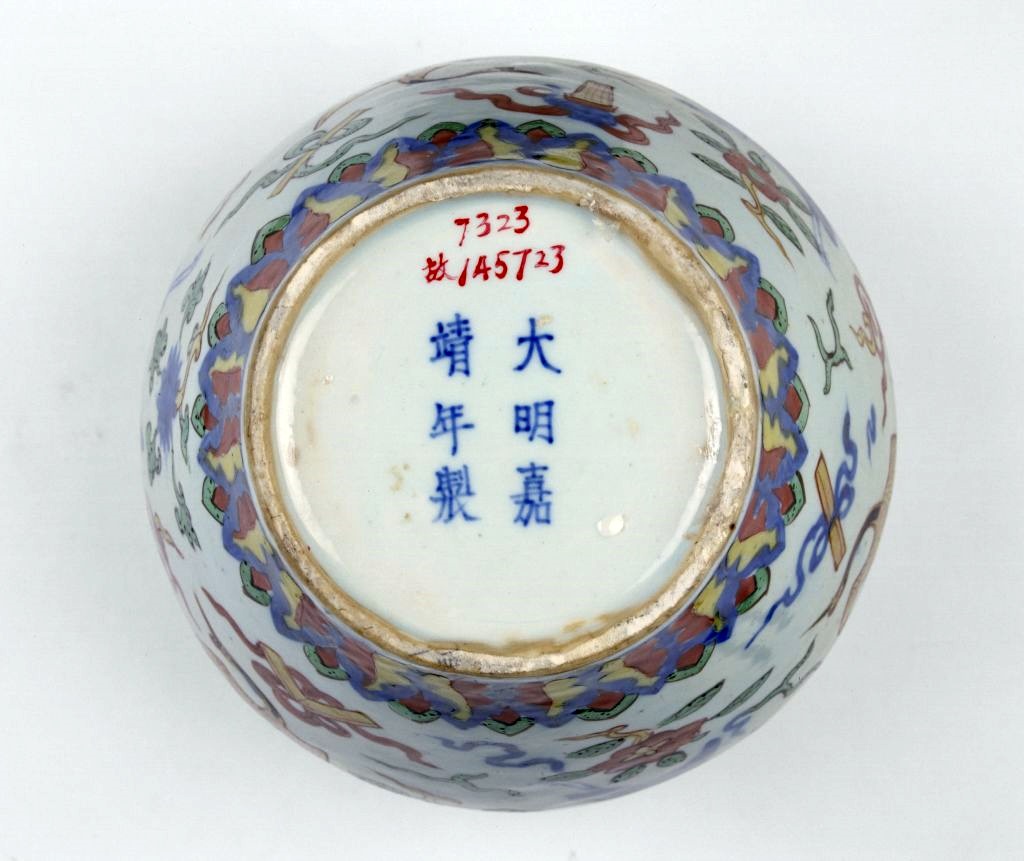
五彩云鹤纹罐,高19.3厘米,口径13.2厘米,足径11厘米。
罐直口,短颈,丰肩,瘦底,圈足。其通体以青花加红、黄、绿彩装饰,颈部绘如意头纹6组,肩部绘变形莲瓣纹一周,罐身绘云鹤穿花及八宝纹,近足处绘变形蕉叶纹一周,底青花双圈内楷书“大明嘉靖年制”双行六字款。
五彩云鹤纹罐色彩浓艳,画迹工整,是典型的官窑作品。主题纹饰以云鹤为主,充满神秘的道教色彩,反映出当时皇宫中崇尚道教之风。
撰稿人:杨静荣
关键词: 五彩 青花 莲瓣纹 八宝 蕉叶纹
参考:香港蘇富比拍卖有限公司
1995年秋季拍卖会
中国陶瓷、工艺品及玉器雕刻
LOT号: 0381 明万历 青花海水龙纹五棱盒
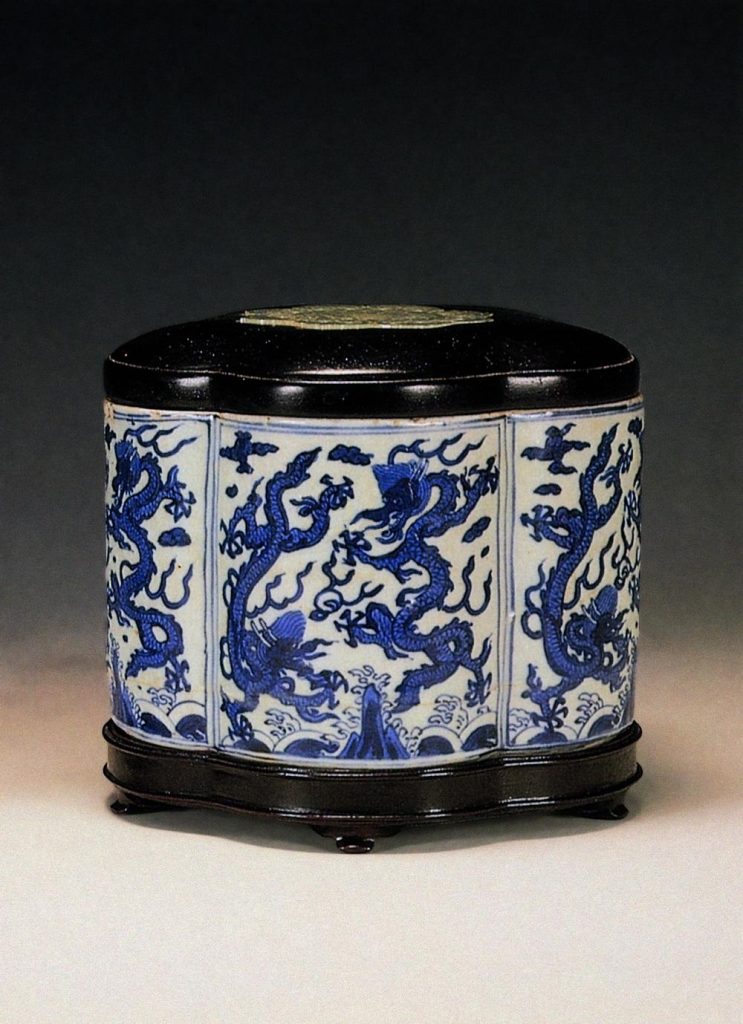
拍品信息
作者 —
尺寸 14.3cm
作品分类 陶瓷>明代青花瓷器
创作年代 明万历
估价 HKD 80,000-100,000
成交价 流拍
专场 中国陶瓷、工艺品及玉器雕刻
拍卖时间 1995-10-31
拍卖公司 香港蘇富比拍卖有限公司
拍卖会 1995年秋季拍卖会
《大明万历年制》款
参考: 北京保利国际拍卖有限公司
第47期(义乌)精品拍卖会
书画·瓷器·玉器·工艺品
LOT号: 0581 五彩龙纹将军罐 (一对)

拍品信息
作者 —
尺寸 高40cm
作品分类 陶瓷>现当代及其它瓷器
创作年代 暂无
估价 RMB 40,000-60,000
成交价 流拍
专场 书画·瓷器·玉器·工艺品
拍卖时间 2019-04-30
拍卖公司 北京保利国际拍卖有限公司
拍卖会 第47期(义乌)精品拍卖会
“大明万历年制”款
参考:
北京东正拍卖有限公司
2013春季艺术品拍卖会
皇家长物——宫廷艺术专场
LOT号: 0185 明万历 御窑青花五彩海浪迎面龙纹四方促织罐
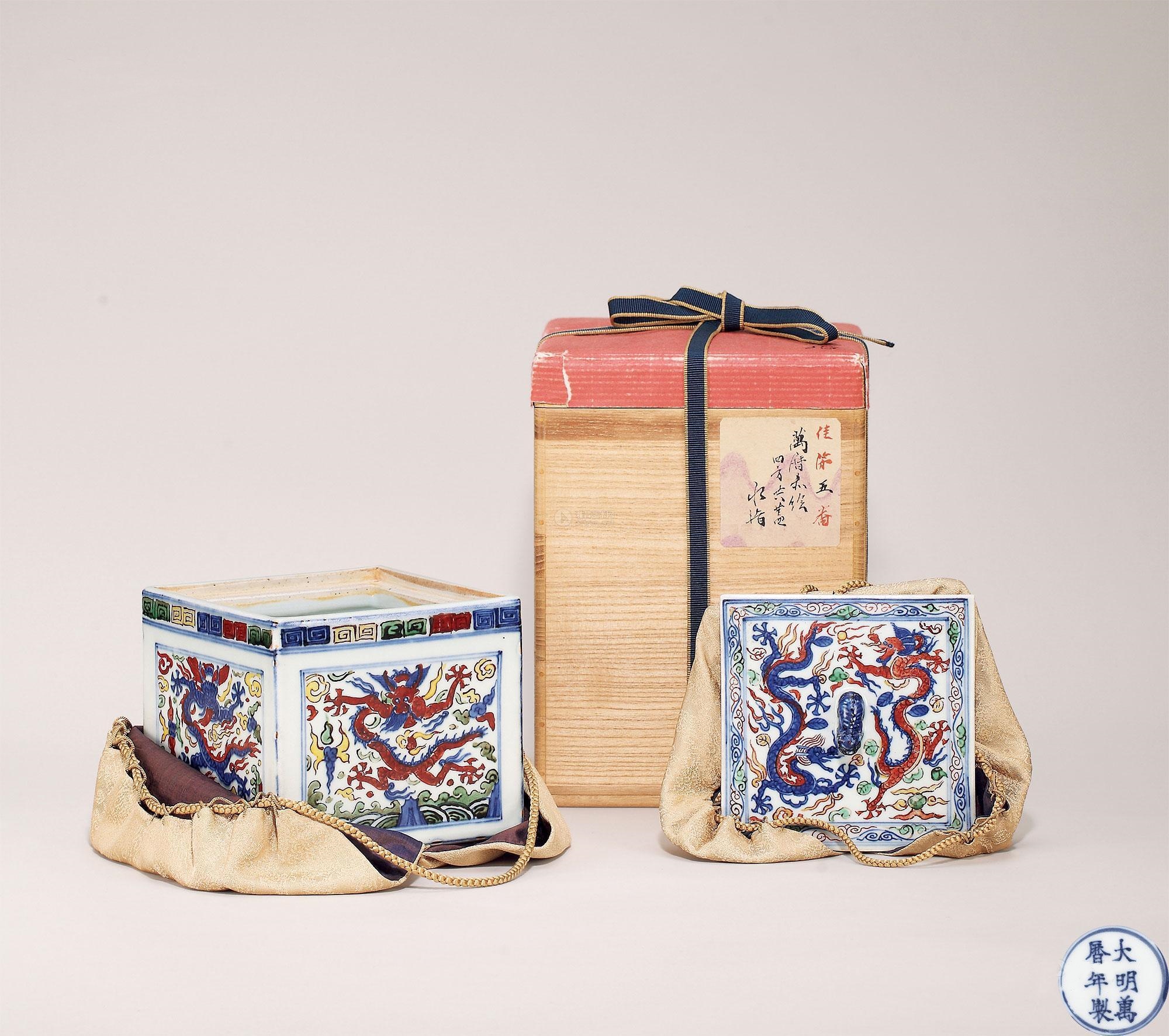
拍品信息
作者 —
尺寸 长13.8cm
作品分类 陶瓷>明代彩瓷
创作年代 明万历
估价 RMB 1,500,000-2,000,000
成交价 RMB 2,070,000HKD 2,613,636USD 310,500EUR 227,700
专场 皇家长物——宫廷艺术专场
拍卖时间 2013-05-10
拍卖公司 北京东正拍卖有限公司
拍卖会 2013春季艺术品拍卖会
款识:大明万历年制
说明
来源:日本出光财团董事家族旧藏
说明:万历五彩素负盛名,以红绿二彩炽烈取胜,对比强烈,夺人心魄。此件青花五彩龙纹蛐蛐方罐当为其中杰出之代表,造型朴拙古雅,胎体厚重坚致,盖面以青花五彩装饰,边栏饰卷草纹,内部绘双龙戏珠纹样,盖钮为青花卧狮。方罐下部四面纹饰基本相同,口沿饰以回纹一周,器身以青花饰边栏,内绘青花五彩海水正面龙纹,运笔粗犷豪放,笔笔精准,红彩鲜艳欲滴,绿釉青翠夺目。底青花书“大明万历年制”双行六字双圈楷书款。
万历时期的器型不仅继承了前朝的多种样式,且把嘉靖的五彩工艺发展到了最高峰,力求达到华丽明艳的视觉效果,尽显万历朝皇室宫廷生活奢华。本品造型稳重敦实,大气磅礡,保存较为完好,彩料几无磨损。整体构图繁密,技法熟练,画工精堪,以红浓绿艳搭配取胜,前人曾赞誉:“龙凤花草各肖形容,五彩玲珑极尽华丽”。
与此名品相同的一例,现为日本横河辅民氏旧藏,已捐献给东京国立美术馆收藏。日本梅泽美术馆亦藏有一件方罐,惟器面所绘为婴戏纹。此外,上海博物馆藏有一件青花四方龙罐与此器完全相同,惟青花之器未饰五彩,且盖钮失。
参阅:《世界陶磁全集 14 明》小学馆 1976年11月 P309 Lot.11
《上海博物馆藏品研究大系-明代官窑瓷器》 上海人民出版社 2007年1月 P59
参考:苏富比 680
中國藝術珍品
明十六世紀 五彩趕珠雲龍紋蓋罐
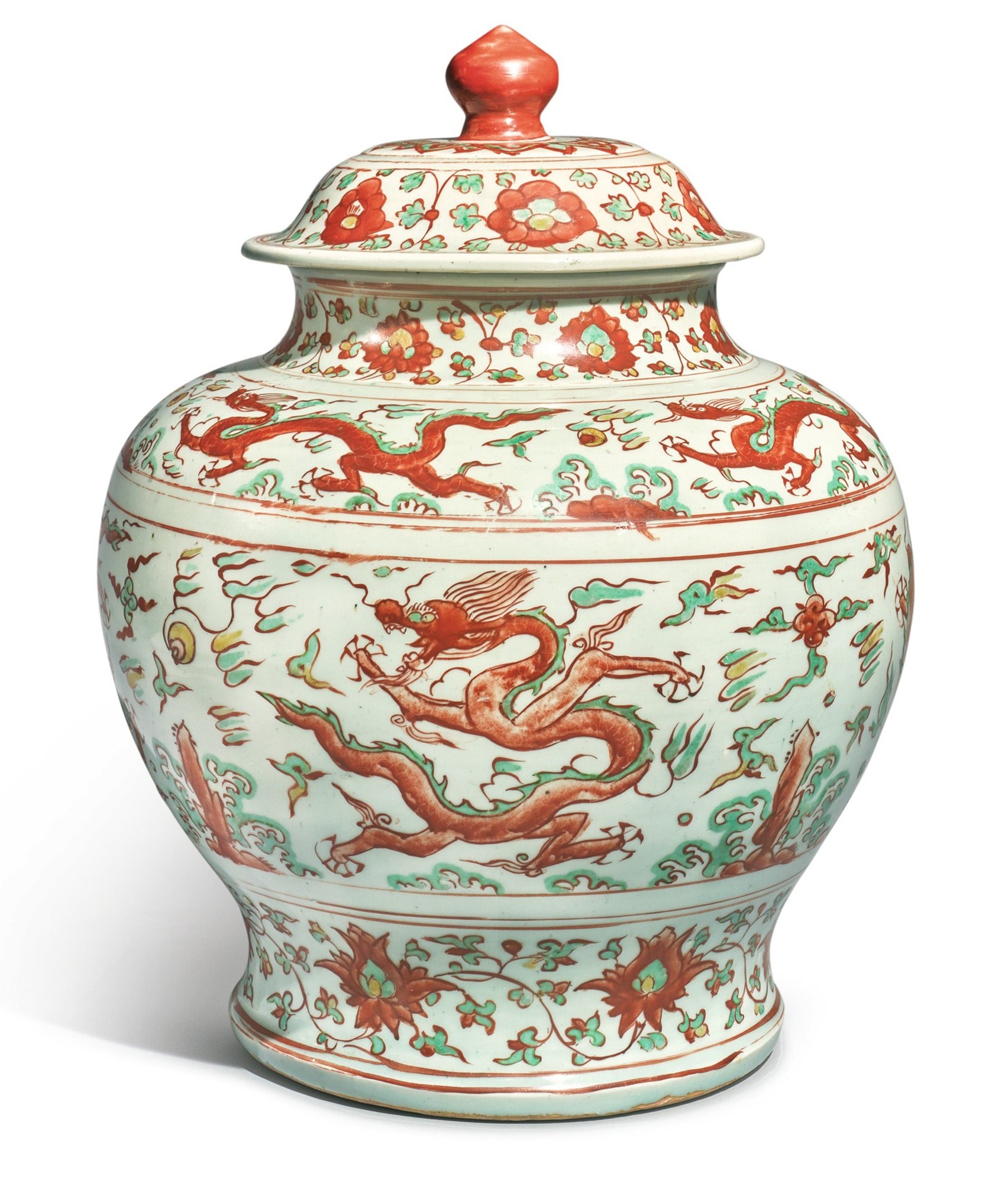
50,000 — 70,000美元
拍品詳情
明十六世紀 五彩趕珠雲龍紋蓋罐
狀況報告
罐有兩裂,經加固。較長的裂從足部延伸至肩部下方。兩長裂均有若干相連之較短裂紋及釉裂。口沿有小磕。蓋鈕經修補,可能原先脫落後沾黏。有窰燒瑕疵分佈,包括蓋內部有窰裂,表面輕微磨痕皆與年代、種類相符。
來源
法國私人收藏,自十九世紀起
中國藝術珍品
2019年9月11日 | 上午 10:30 EDT
紐約
3307
聚菁琳瑯-顯赫私人御瓷珍藏
明萬曆 五彩鏤空蓮龍紋蓋盒 《大明萬曆年製》款
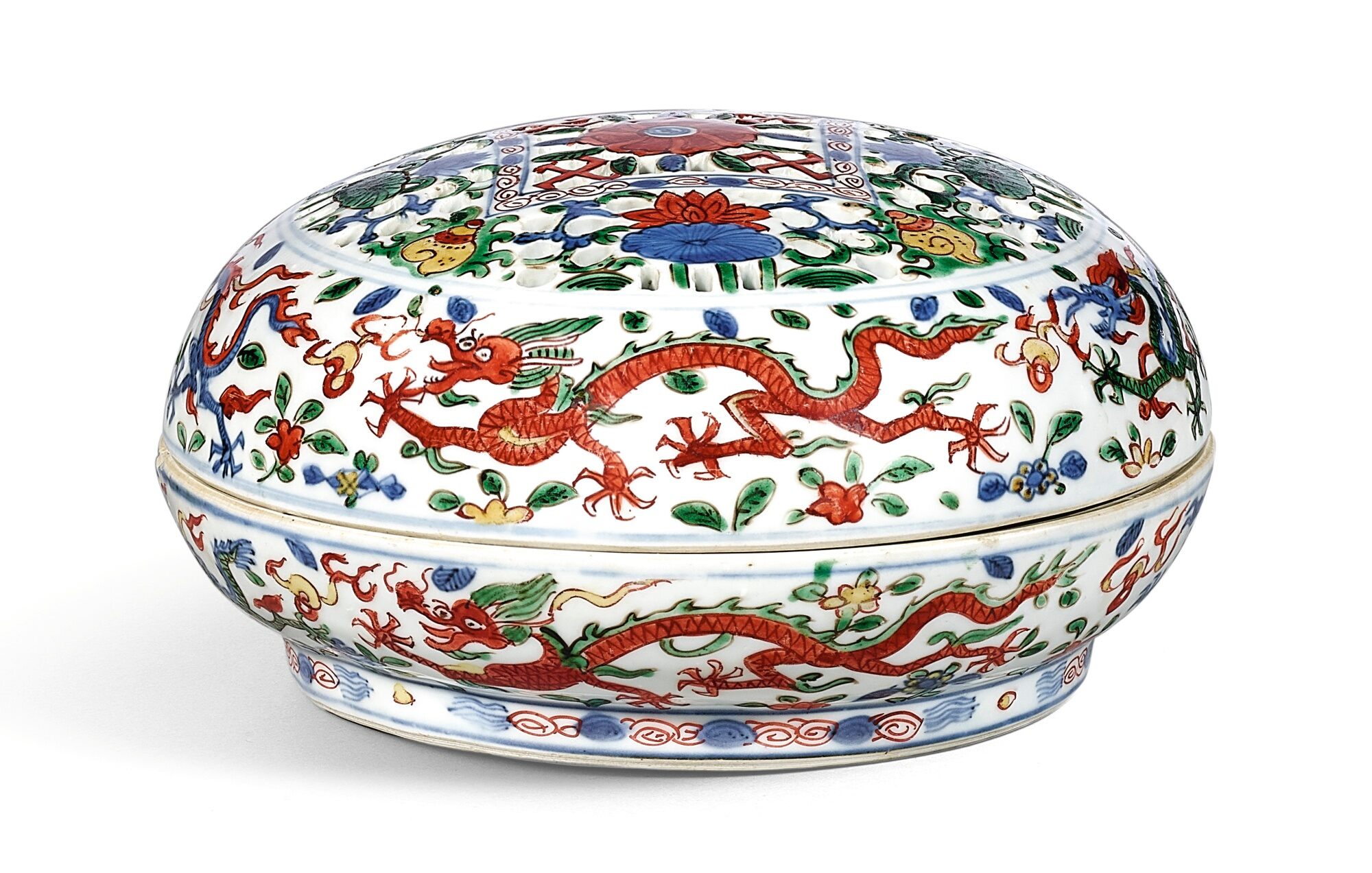
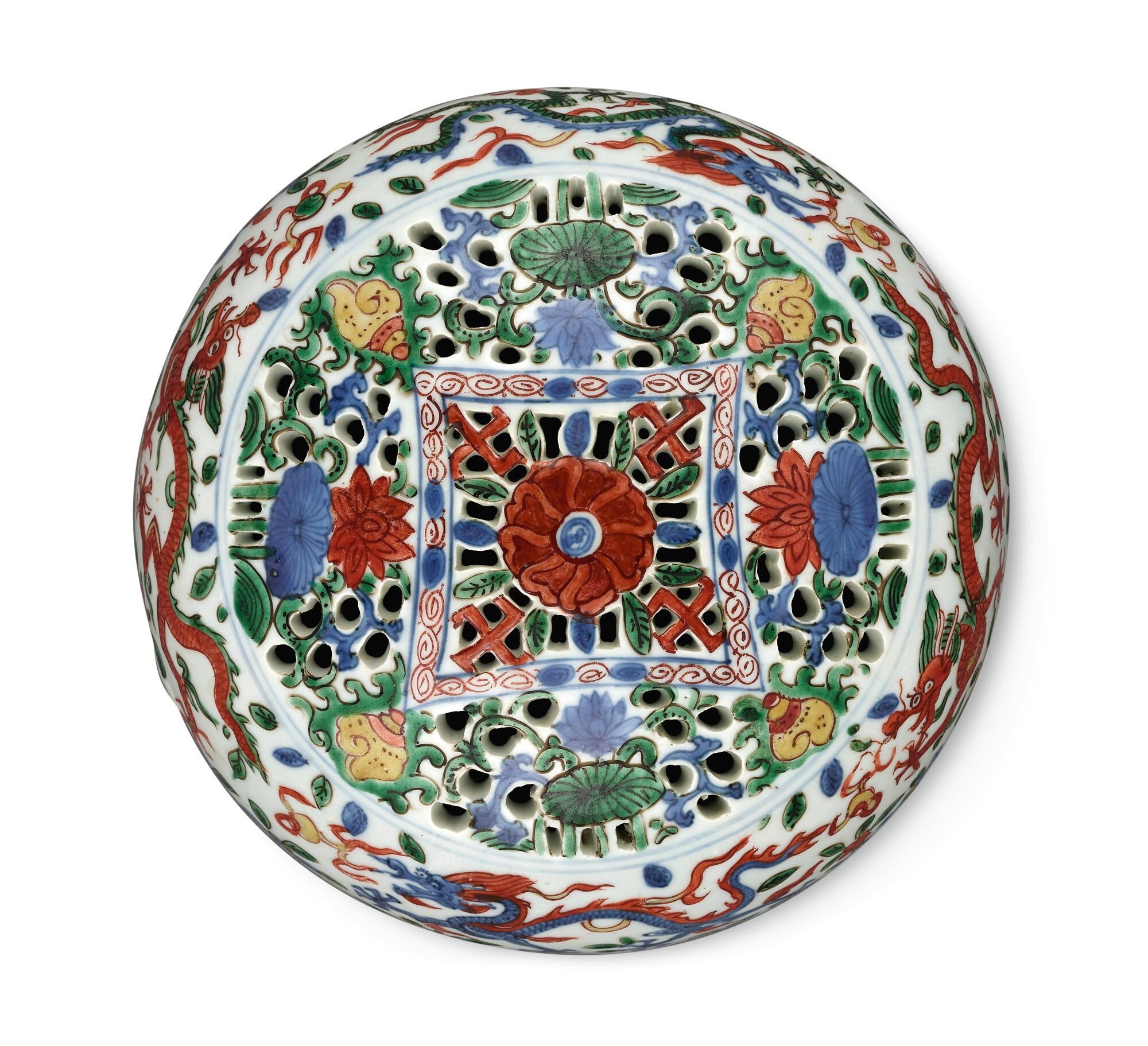
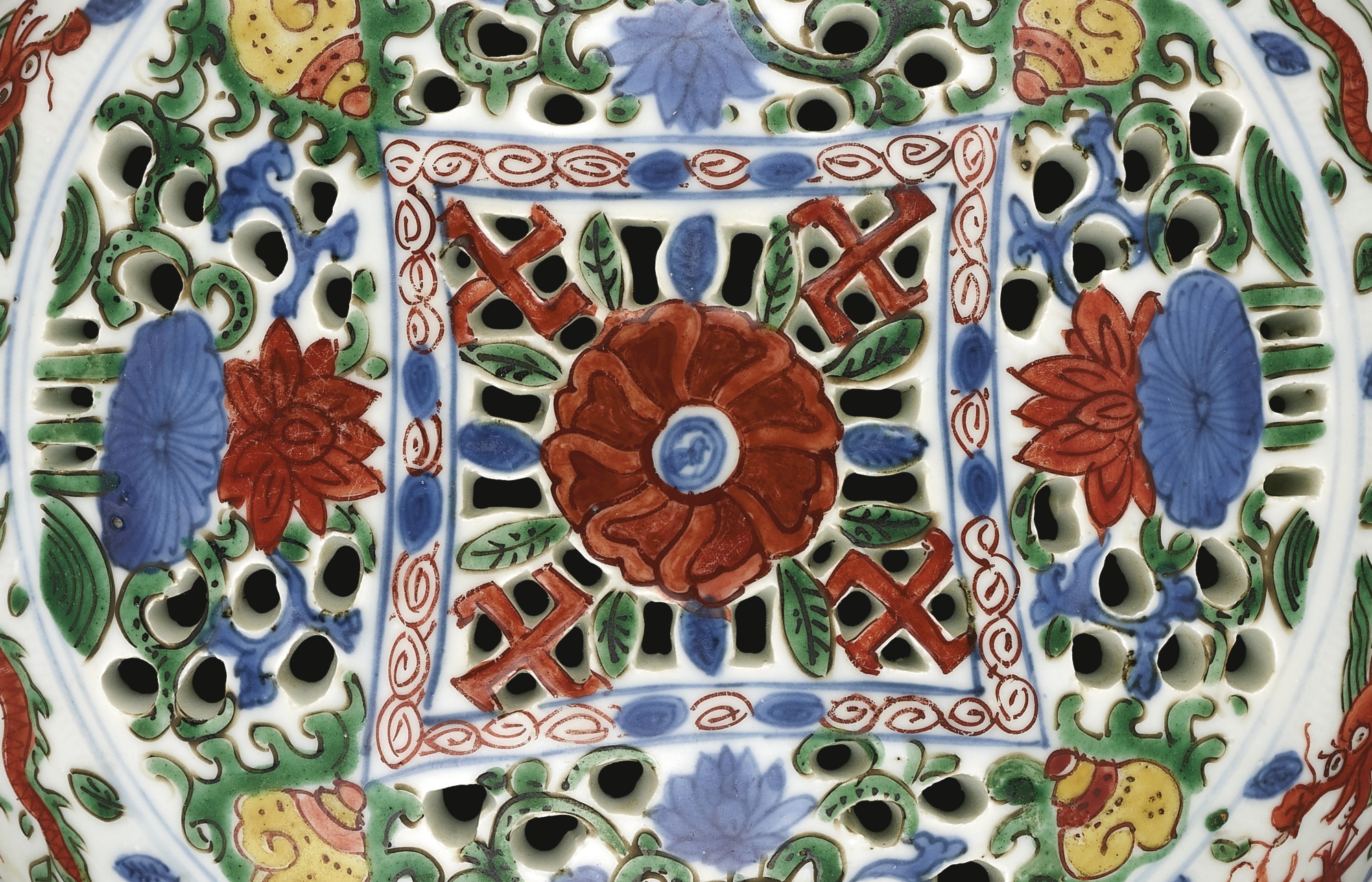
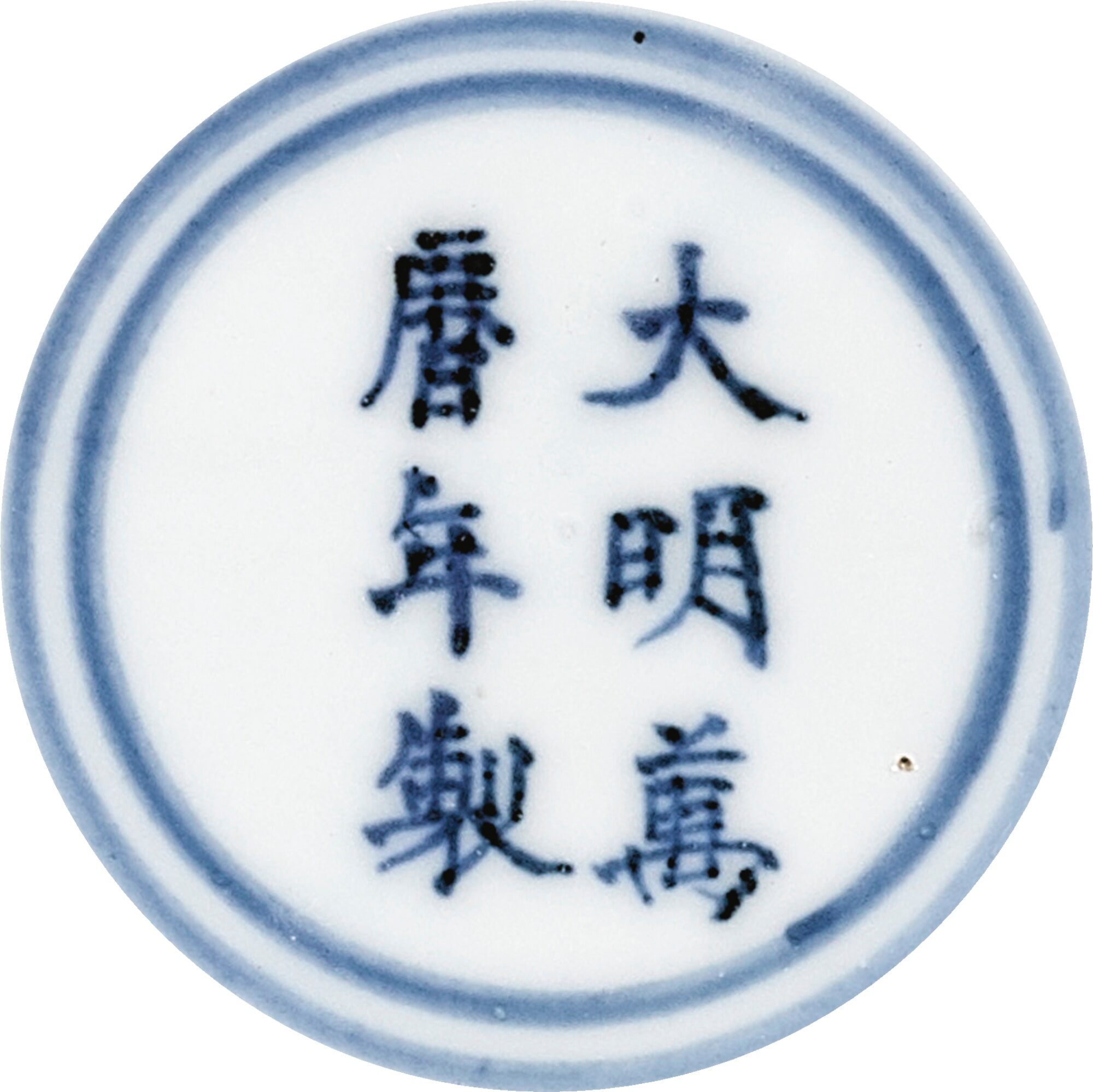
600,000 — 800,000港幣
拍品詳情
明萬曆 五彩鏤空蓮龍紋蓋盒 《大明萬曆年製》款
20.9 公分,8 1/4 英寸
狀況報告
盒內原有間格,凸槽已改,見髹漆痕跡。器外不受影響,惟見口沿一處約1 x 0.6公分窰燒磕傷經修復。蓋沿一處約1.8 x 0.8 公分淺磕經修復,鏤空部分幾條淺淡窰線及爆釉。窰燒瑕疵及釉面磨痕,實屬正常。
來源
東京美術俱樂部,1939年11月13日,編號64
香港蘇富比2002年5月7日,編號551
聚菁琳瑯-顯赫私人御瓷珍藏
2019年4月3日 | 上午 10:20 HKT
香港
参考:苏富比 411
中國藝術品
明末至清初 五彩龍鳳紋方勝式蓋盒 《大明隆慶年造》款
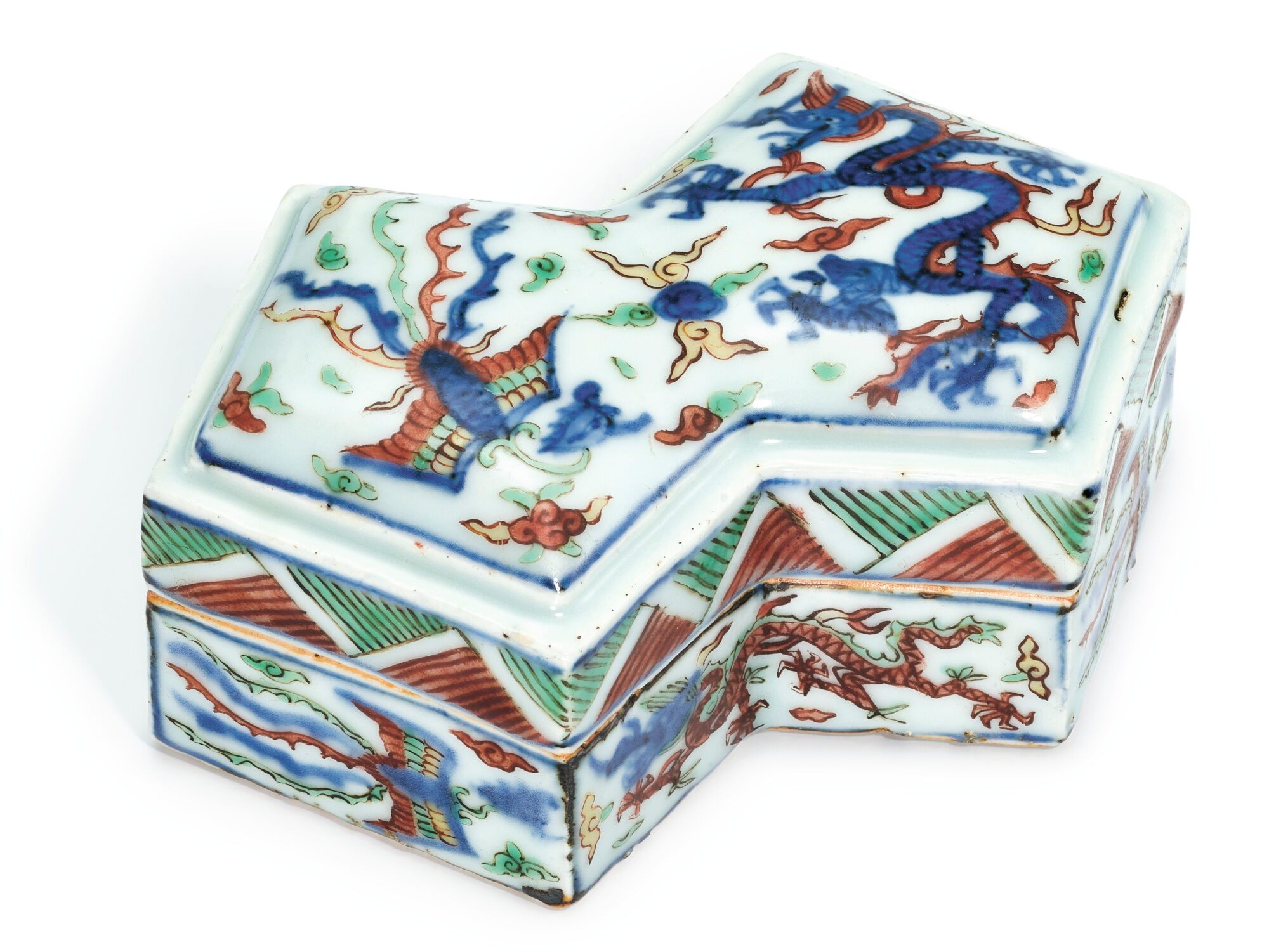
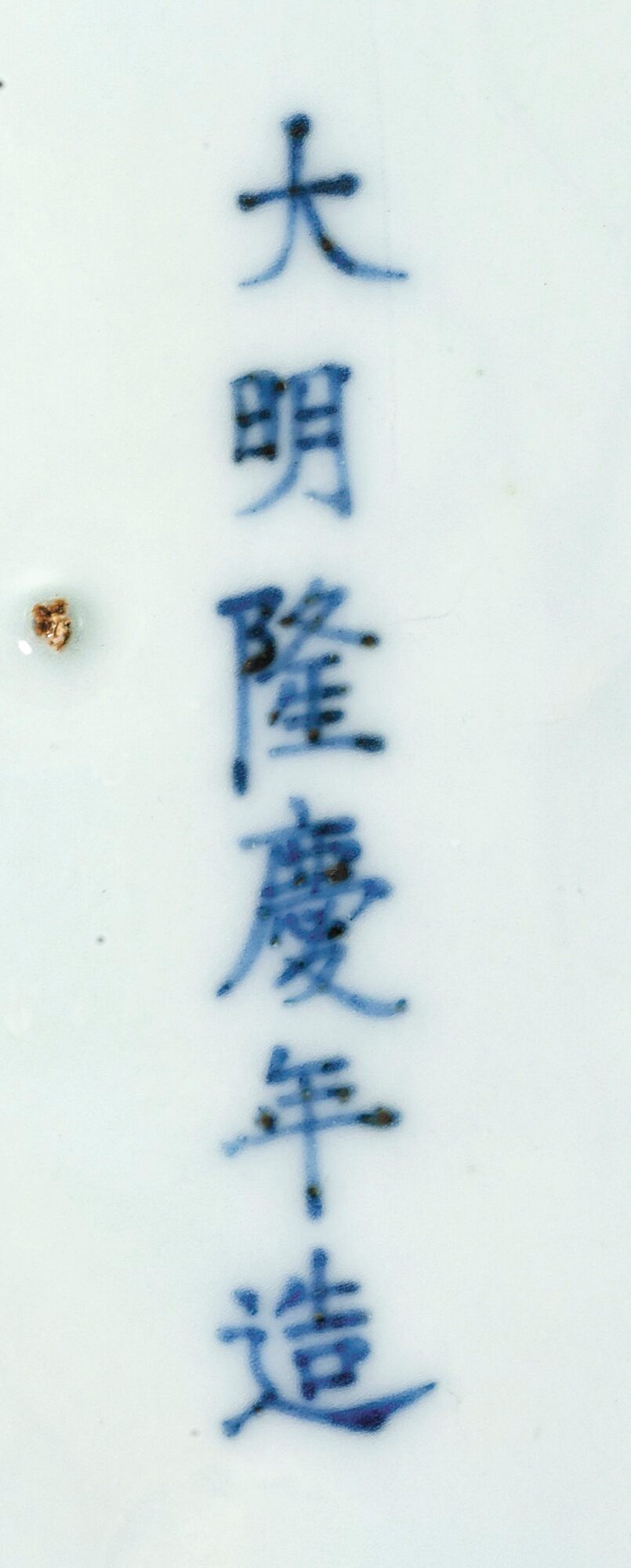
10,000 — 20,000港幣
拍品已售 600,000 港幣 成交價 (含買家佣金)
拍品詳情
明末至清初 五彩龍鳳紋方勝式蓋盒 《大明隆慶年造》款
15.3 公分, 6 英寸
中國藝術品
2019年5月30日 – 2019年5月31日 | 上午 10:30 HKT
香港
参考:苏富比 3612
中國藝術珍品
明萬曆 五彩雲龍紋八方罐 《大明萬曆年製》款
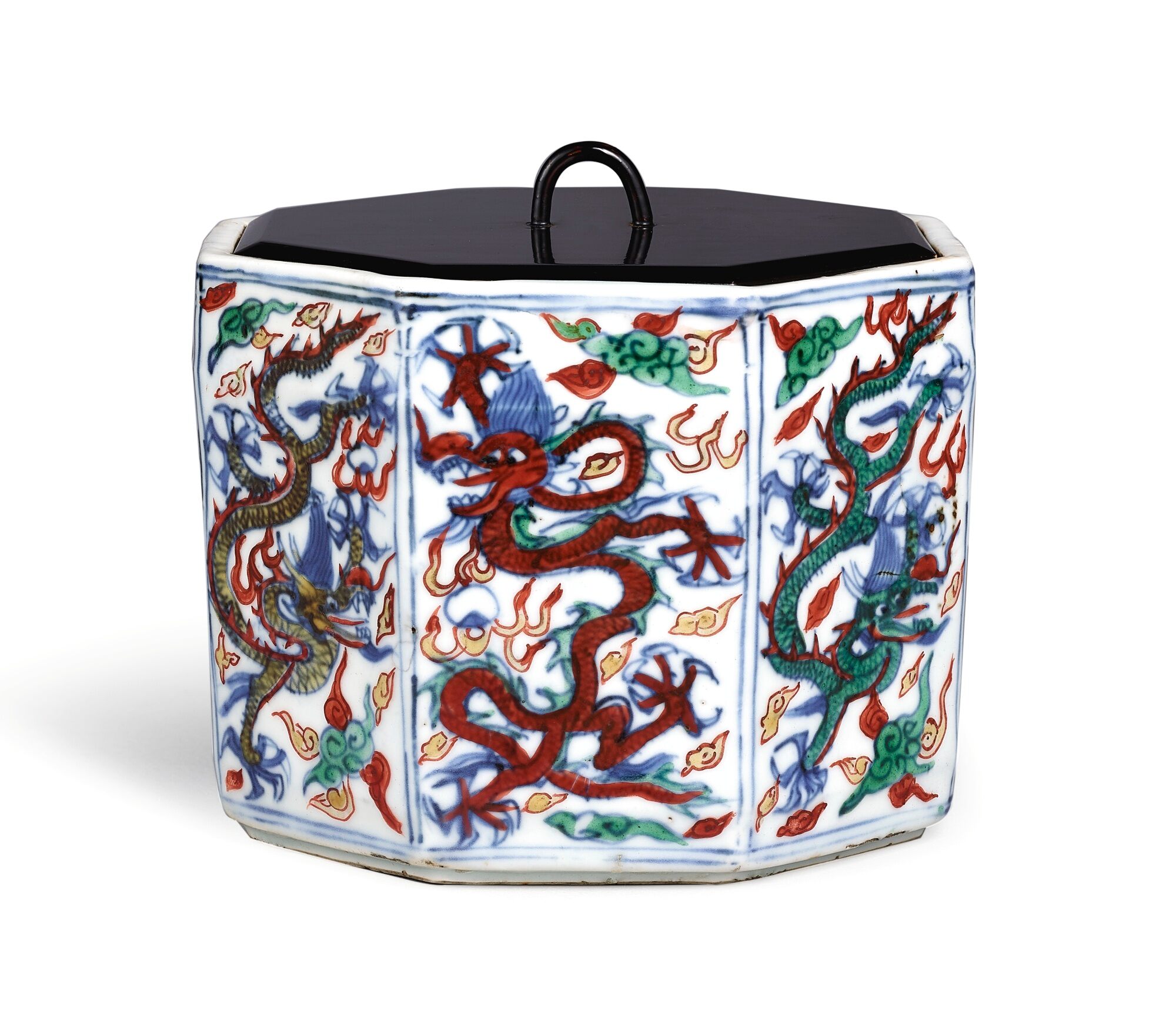
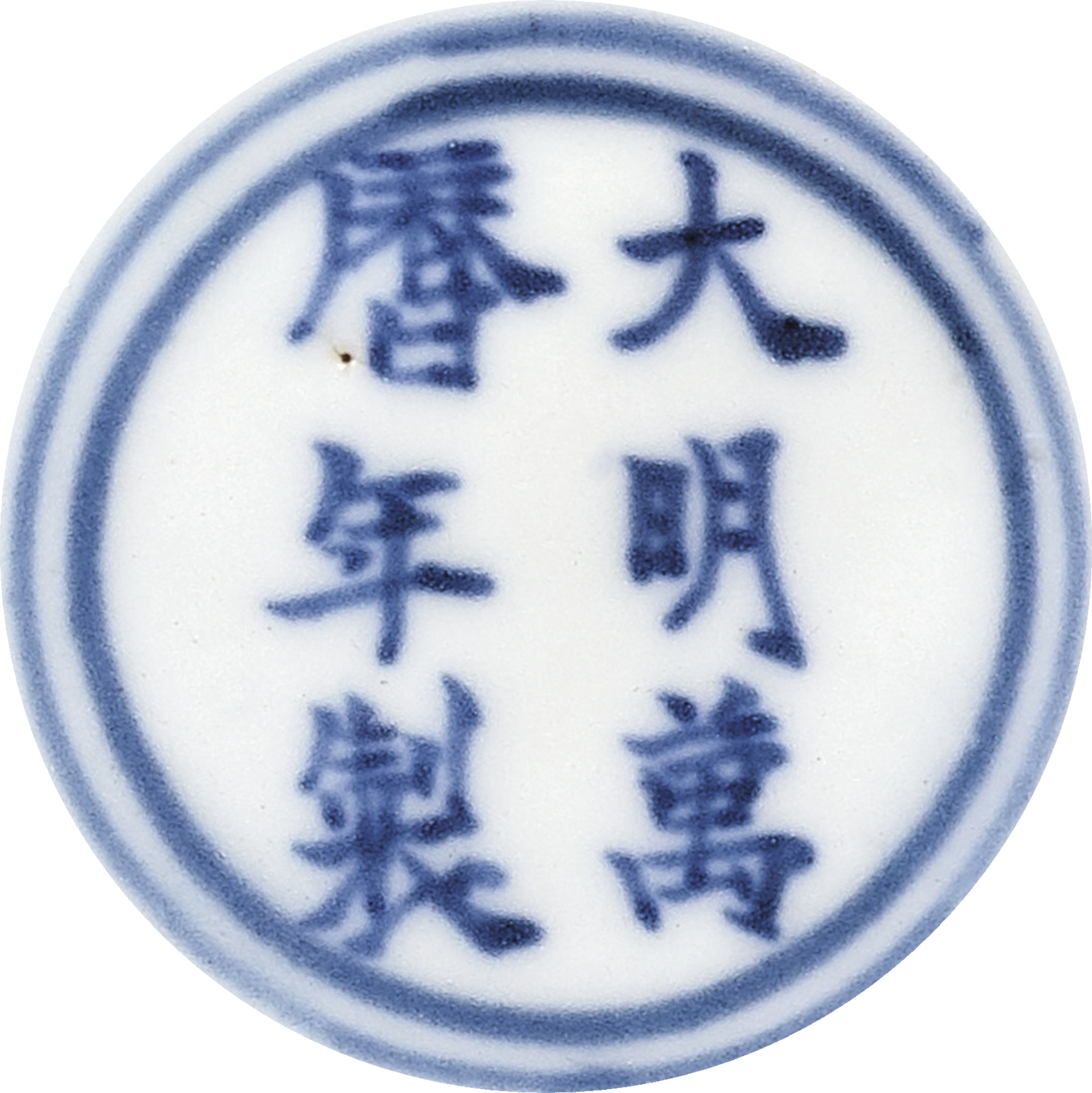
300,000 — 500,000港幣
拍品已售 375,000 港幣 成交價 (含買家佣金)
拍品詳情
明萬曆 五彩雲龍紋八方罐 《大明萬曆年製》款
14.2 公分,5 5/8 英寸
中國藝術珍品
2019年4月3日 | 下午 2:30 HKT
香港
参考: 苏富比 694
中國藝術品
清康熙 五彩海馬雜寶紋盃一對
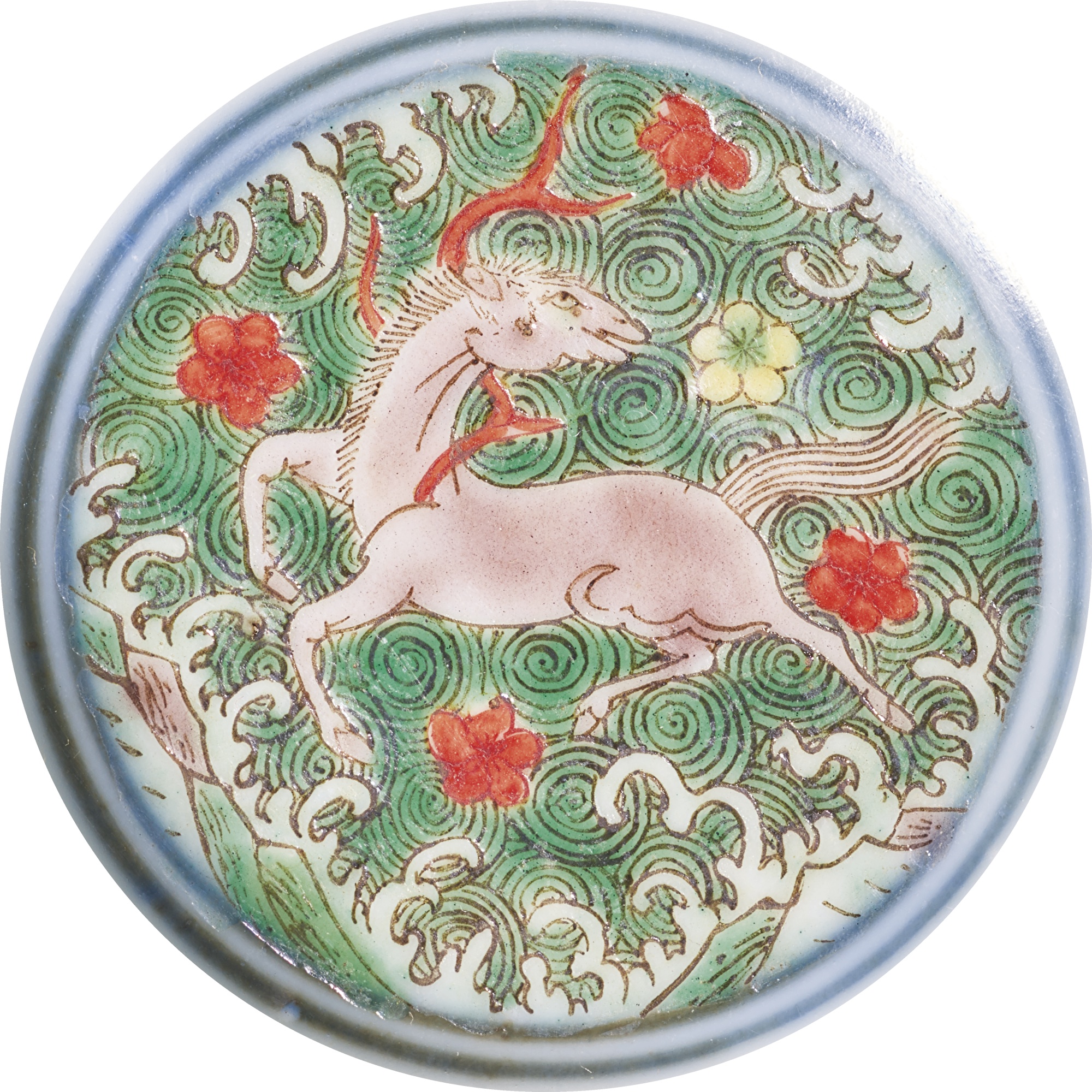
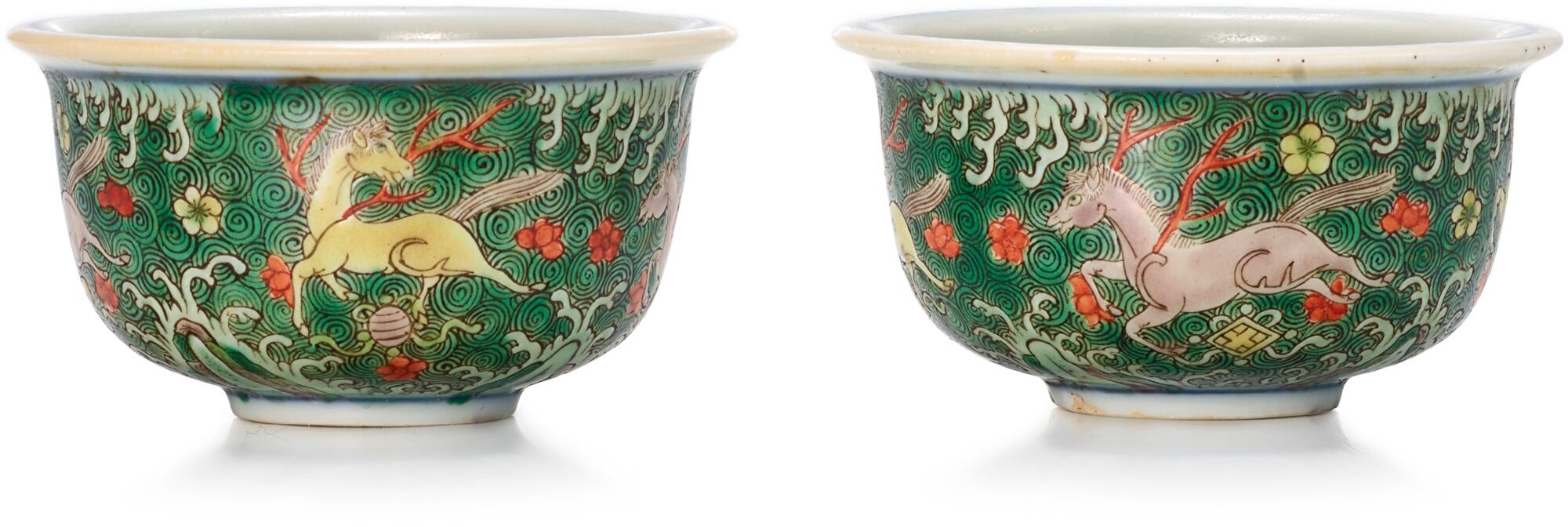
20,000 — 30,000港幣
拍品已售 30,000 港幣 成交價 (含買家佣金)
拍品詳情
清康熙 五彩海馬雜寶紋盃一對
7 公分,2 3/4 英寸
Suzanne H. Foster 收藏,佛羅里達州(標籤)
中國藝術品
2018年11月29日 – 2018年11月30日 | 上午 10:15 HKT
香港
参考:苏富比 524
中國藝術品
清光緒 青花礬紅彩海獸紋盌 《大清光緒年製》款
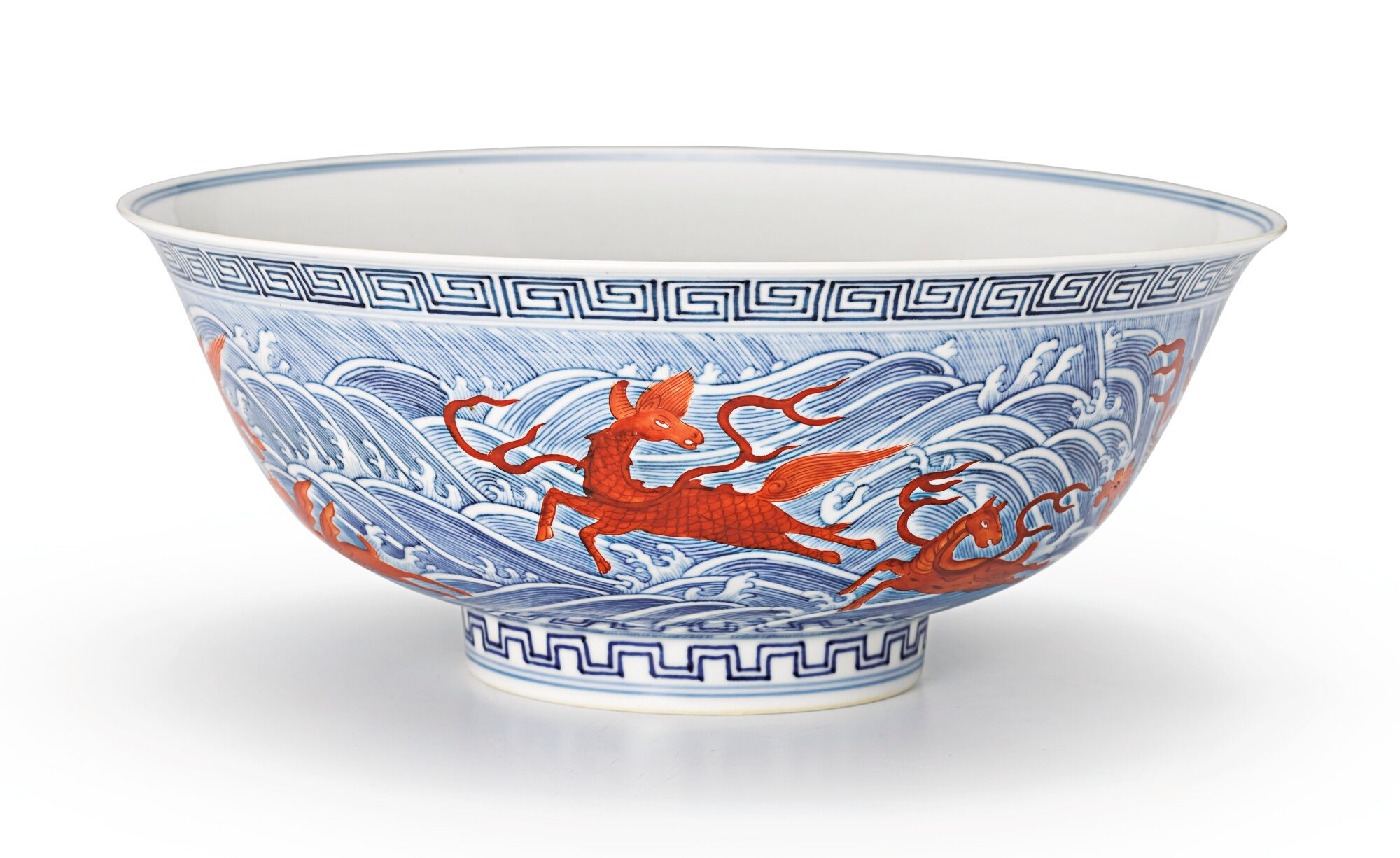
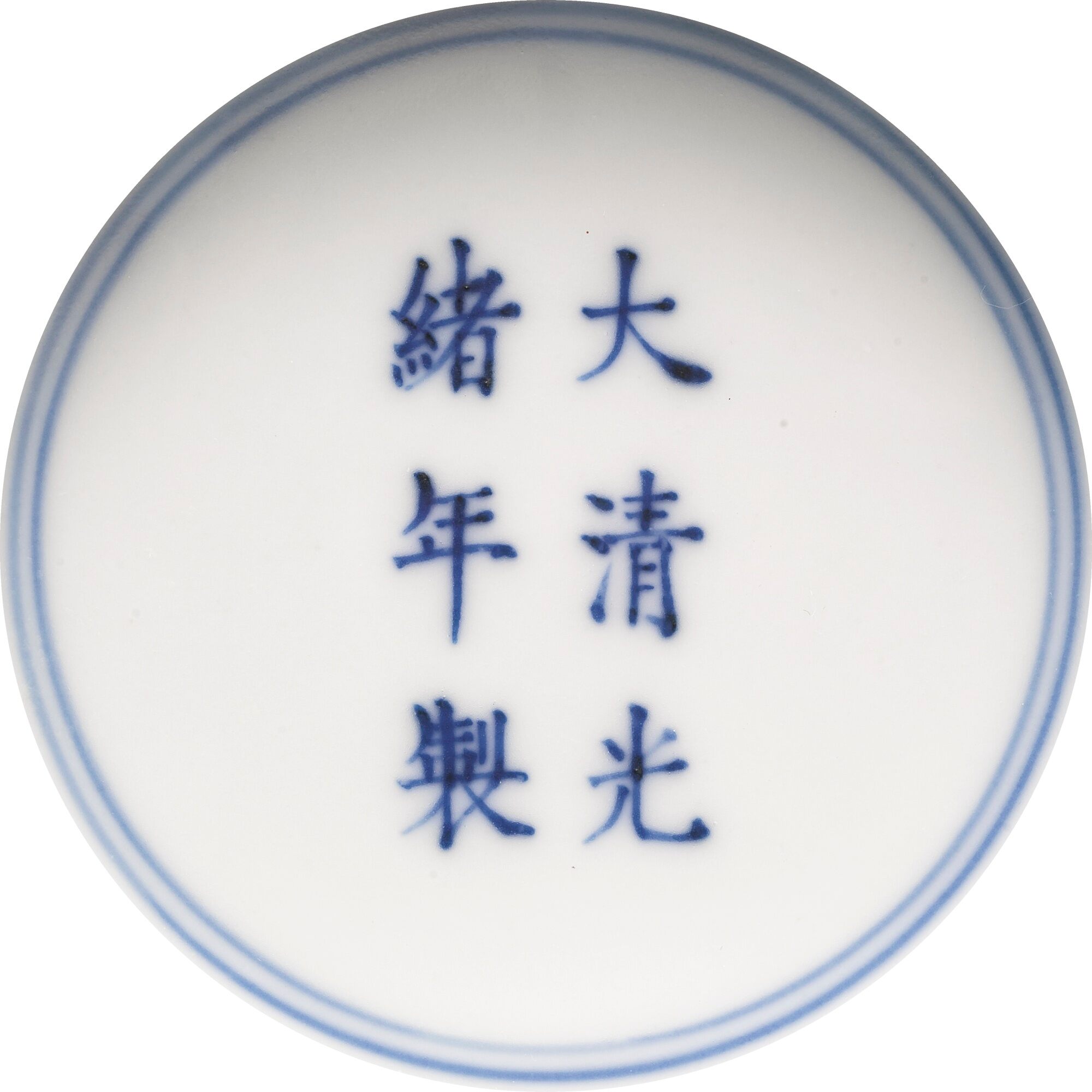
30,000 — 40,000港幣
拍品已售 100,000 港幣 成交價 (含買家佣金)
拍品詳情
清光緒 青花礬紅彩海獸紋盌 《大清光緒年製》款
21.7 公分,8 1/2 英寸
狀況報告
整體品相及彩料保存良好。
中國藝術品
2018年5月31日 – 2018年6月1日 | 上午 11:15 HKT
香港
参考: 苏富比 506
中國藝術品
明萬曆 五彩蓮塘鴛鴦圖蒜頭瓶 《大明萬曆年製》款

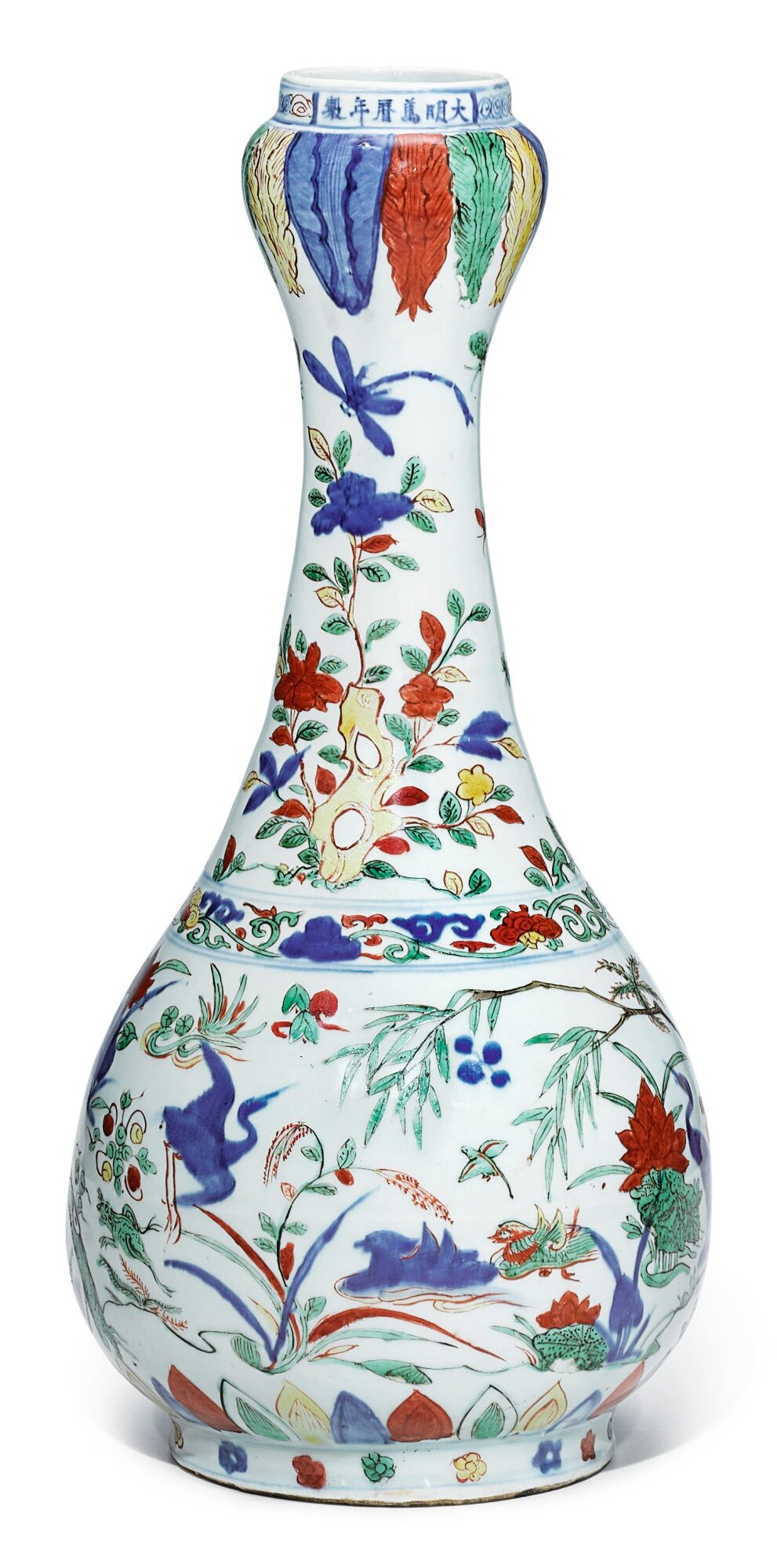
1,200,000 — 1,500,000港幣
拍品詳情
明萬曆 五彩蓮塘鴛鴦圖蒜頭瓶 《大明萬曆年製》款
45 公分,17 3/4 英寸
狀況報告
相關資料
萬曆五彩器以彩料鮮亮濃艷,畫面活力靈動著稱,於明朝眾瓷器中熠熠生輝,光彩奪目。本品器形源自古青銅器,尺寸碩然,萬曆時期可見較多此類大器型之五彩蒜頭瓶,所繪紋樣不一,各具特色。荷塘鴛鴦紋樣最先見於元代宮廷器,後為明代帝王所鍾愛,沿襲於明官窰瓷。
一對東京出光美術館藏相類作例可資參考,錄於《嘉靖、萬曆の赤絵》,東洋陶磁美術館,大阪,1995年,編號22;香港佳士得曾售一相近例,1987年1月13日,編號546。台北故宮亦存一例,瓶口飾串珠紋並於肩部環飾如意雲頭紋,載於葉佩蘭,《五彩名瓷》,台北,1996年,圖版83;另有一例,刊於John Ayers,《The Baur Collection》,卷2,日內瓦,1969年,圖版A203;香港蘇富比曾售兩例,分別為2005年10月23日,編號456,以及2007年4月8日,編號525;此外香港佳士得亦售一類例,1997年11月6日,編號1050。
另比一例,見於《中國藝術國際展覽會》,皇家藝術學院,倫敦,1935年,編號1912,亦展並載於東方陶瓷學會《Polychrome Porcelain of the Ming Dynasty》,倫敦, 1950年,編號154,後售於倫敦蘇富比1953年3月24日,編號62;再較一例,售於香港佳士得1997年11月5/6日,編號1050。
中國藝術品
2018年5月31日 – 2018年6月1日 | 上午 11:15 HKT
香港
参考:苏富比 524
中國藝術品
清光緒 青花礬紅彩海獸紋盌 《大清光緒年製》款


30,000 — 40,000港幣
拍品已售 100,000 港幣 成交價 (含買家佣金)
拍品詳情
清光緒 青花礬紅彩海獸紋盌 《大清光緒年製》款
21.7 公分,8 1/2 英寸
狀況報告
整體品相及彩料保存良好。
中國藝術品
2018年5月31日 – 2018年6月1日 | 上午 11:15 HKT
香港
参考:苏富比 436
中國藝術品 包括趙從衍家族收藏藝術珍品
香港家族私人收藏
明萬曆 五彩穿花龍紋瓶(嵌鎏金口、足)
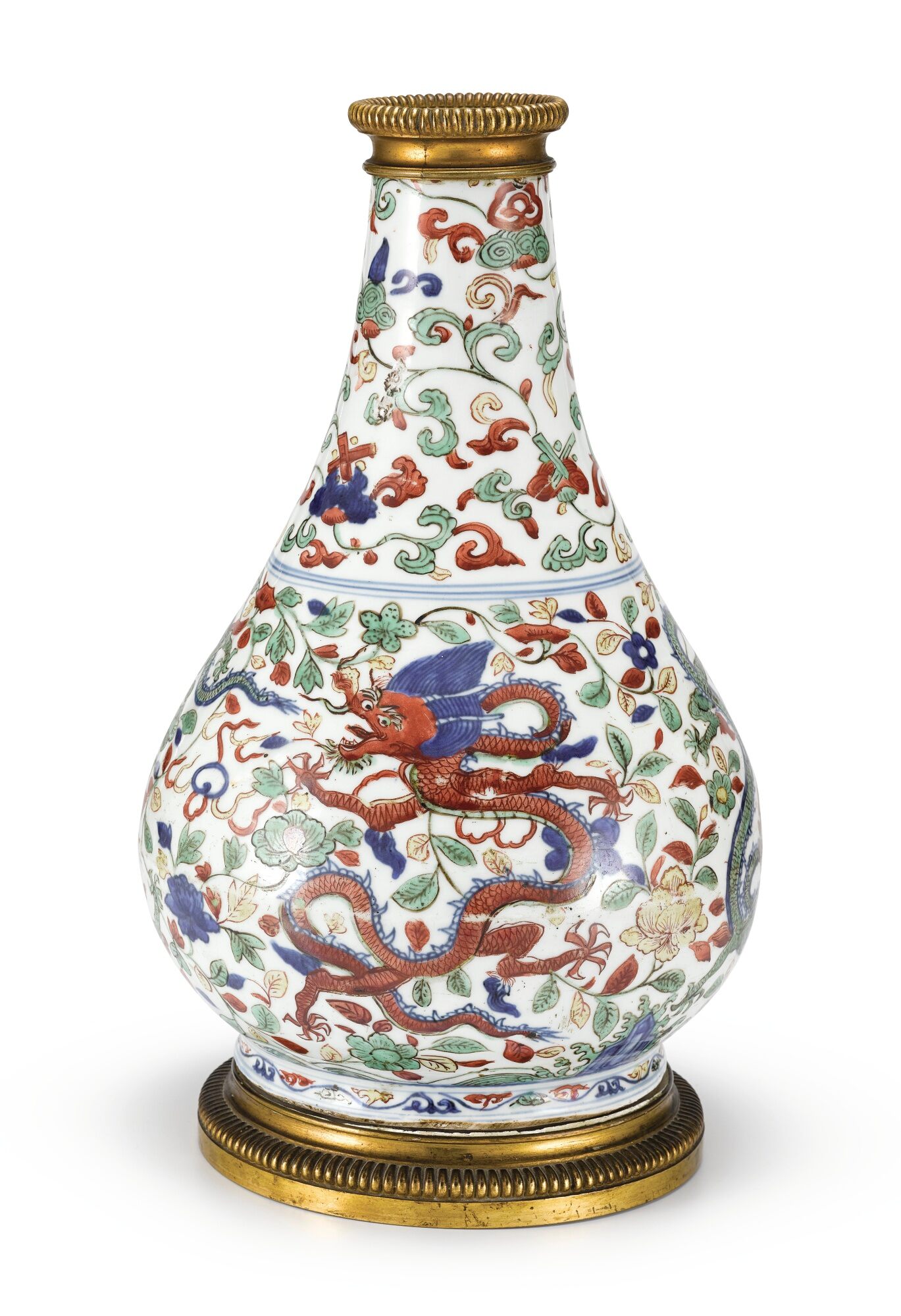
100,000 — 150,000港幣
拍品已售 462,500 港幣 成交價 (含買家佣金)
拍品詳情
明萬曆 五彩穿花龍紋瓶(嵌鎏金口、足)
35.5 公分,14 英寸
來源
倫敦佳士得1996年6月10日,編號89
中國藝術品 包括趙從衍家族收藏藝術珍品
2017年11月30日 – 2017年12月1日 | 下午 2:00 HKT
香港
参考: 苏富比 816
中國藝術品
明萬曆 五彩雲龍戲珠紋大盤 《大明萬曆年製》款
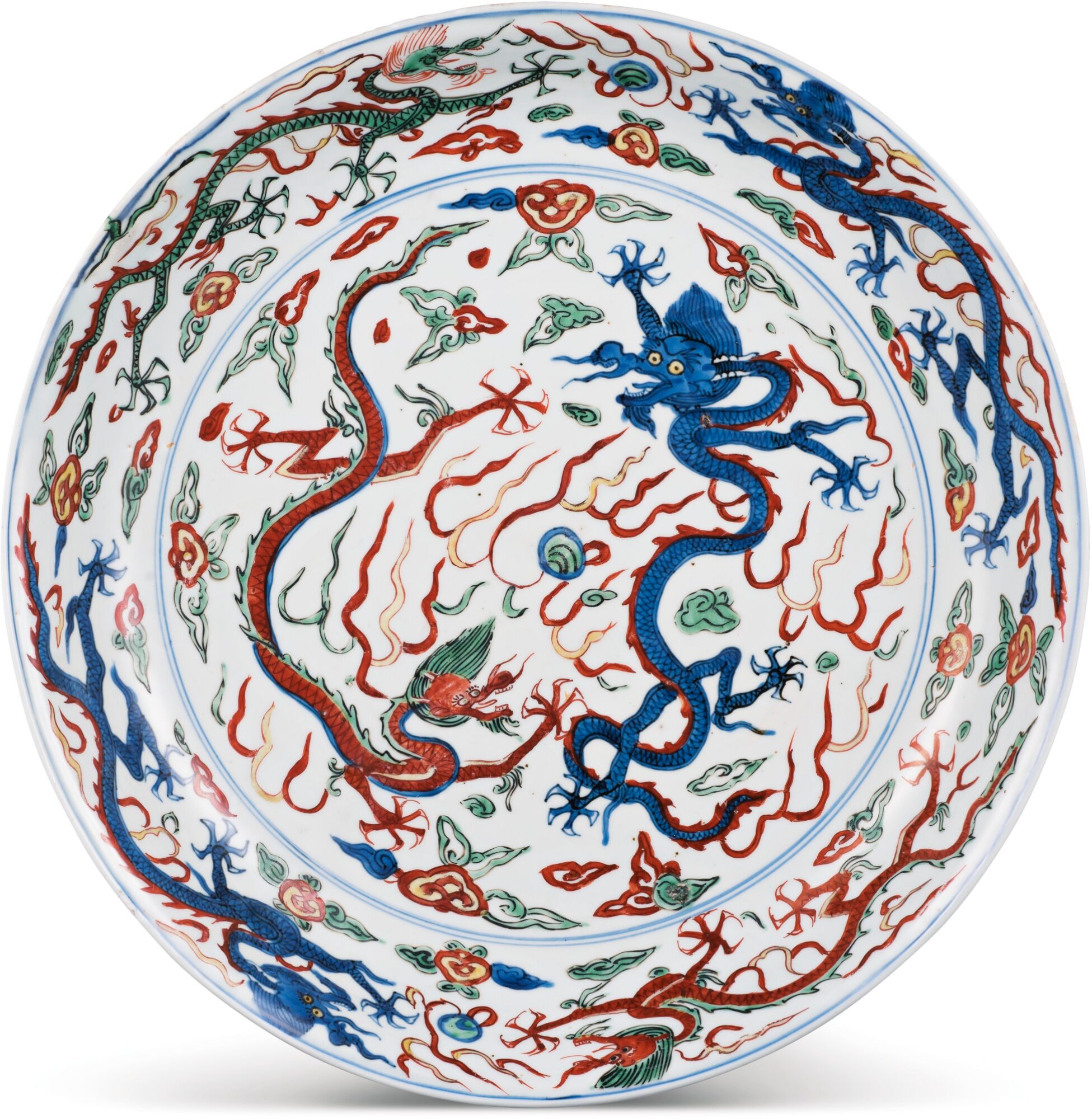

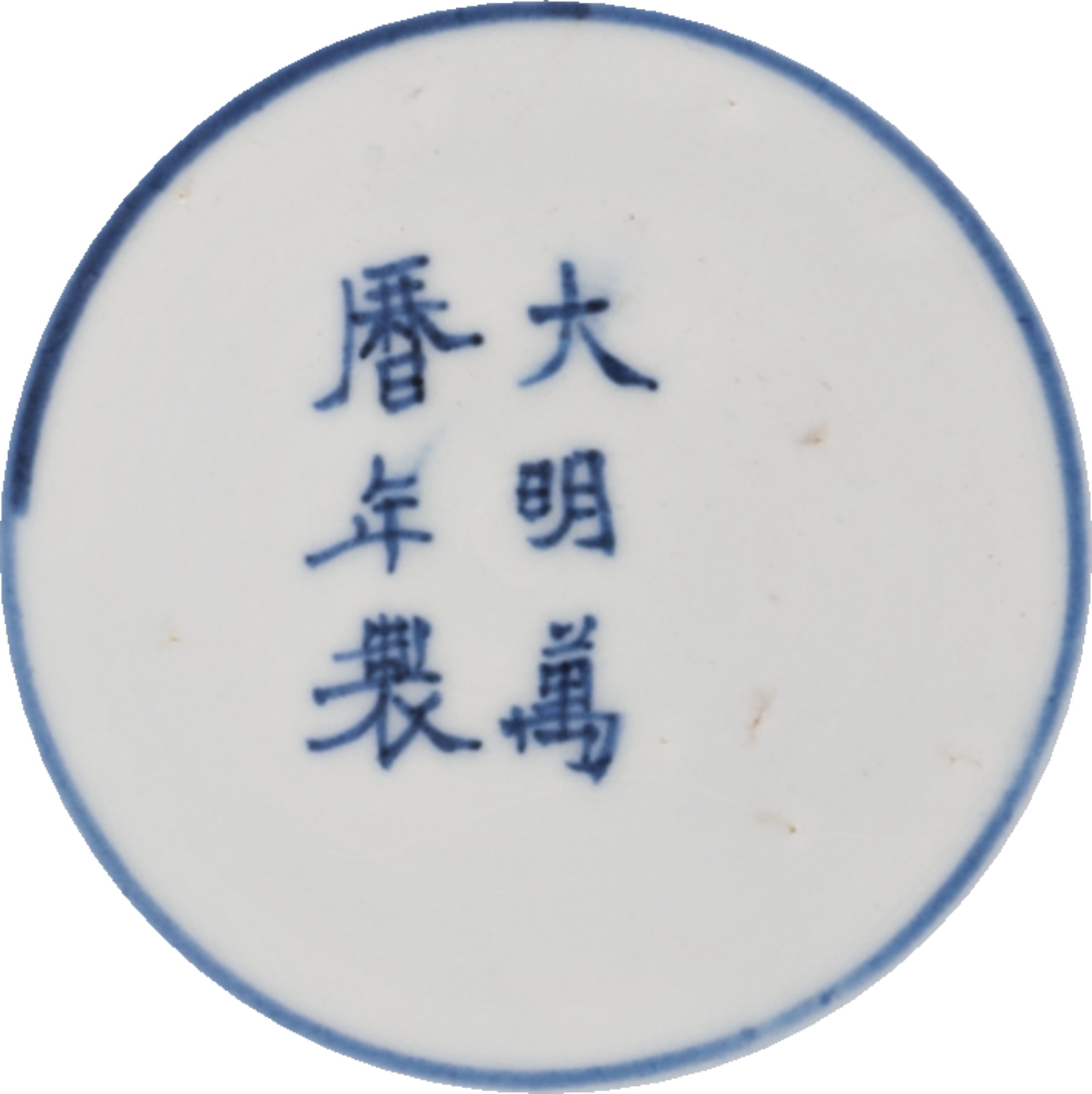
300,000 — 500,000港幣
拍品已售 687,500 港幣 成交價 (含買家佣金)
拍品詳情
明萬曆 五彩雲龍戲珠紋大盤 《大明萬曆年製》款
38.1 公分,15 英寸
狀況報告
足部七點鈡方向延伸至底部見一道6.5公分淺口沖,已修補。八點鈡方向見一道約5公分叉狀口沖(分支約3.5公分)。口沿見窰粘,並見約0.5公分淺剝釉,經補繪。整體見輕微窰燒瑕疵,但釉色保存極爲良好,偶見小磨損。
相關資料
此盤器形碩大,所繪趕珠龍紋栩栩如生。可比較一紋飾相似之無款盤例,藏東京出光美術館,錄於《出光美術館藏品圖錄.中國陶磁》,出光美術館,東京,1987 年,圖版758。另見一尺寸稍小之萬曆款趕珠龍紋盤例,售於倫敦蘇富比1992年6月9日,編號245;另有一例售於香港蘇富比2015年10月7日,編號3667。
此雙龍戲珠紋亦見於尺寸相近之萬曆款青花盤。東京出光美術館藏一例,載於前述出處,圖版725;光怡志堂亦藏一例,展於《爐火純青:嘉靖及萬曆官窰瓷器》,香港中文大學文物館,香港,2009年,編號85。
前往
中國藝術品
2016年6月2日 – 2016年6月3日 | 下午 2:00 HKT
香港
参考: 北京保利2019秋季拍卖会 >禹贡Ⅰ——大明·格古
5682 明万历 青花五彩龙凤纹盘
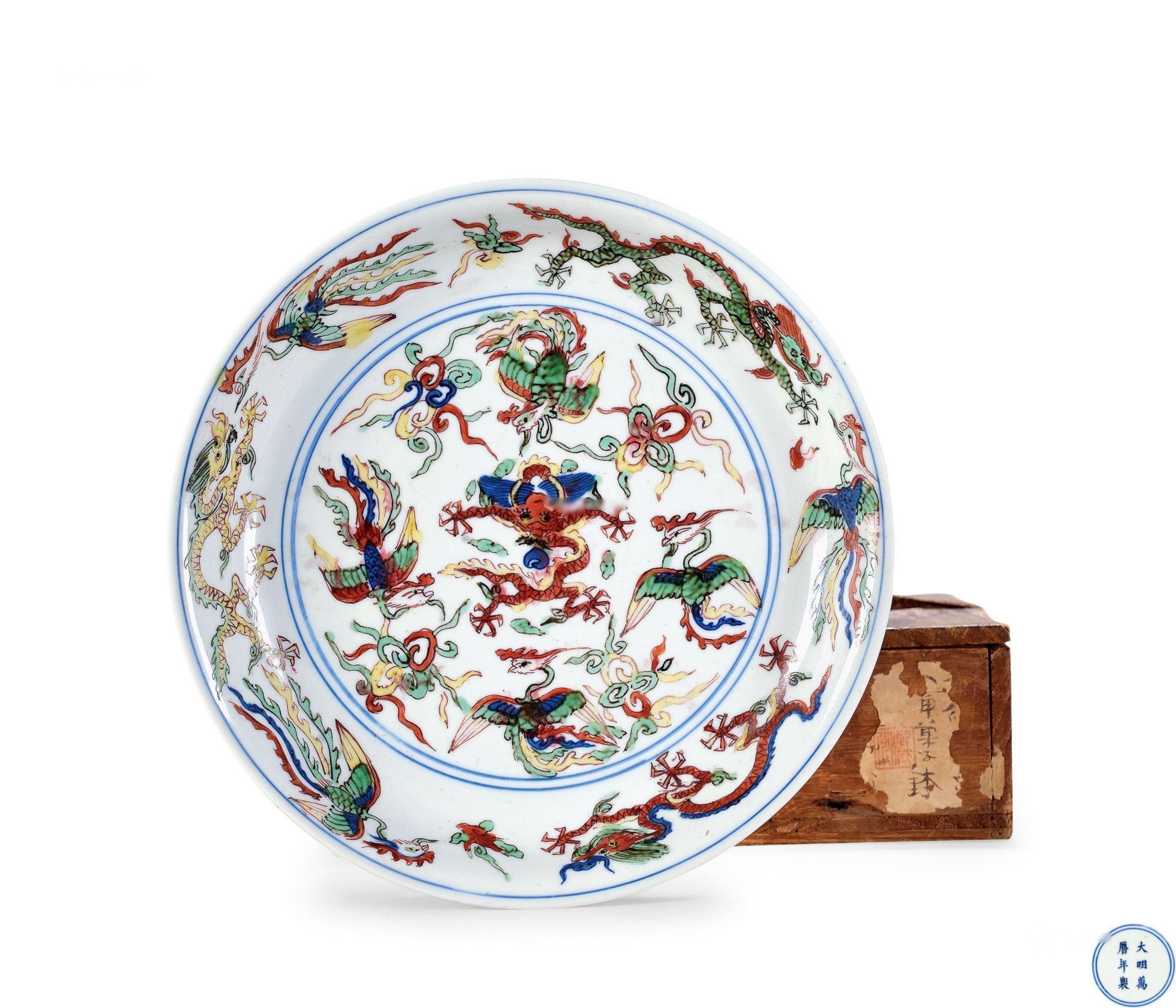
青花五彩龙凤纹盘
拍品信息
LOT号 5682 作品名称 明万历 青花五彩龙凤纹盘
作者 — 尺寸 直径22cm 创作年代 明万历
估价 400,000-600,000 成交价 RMB 517,500
「大明万历年制」款
备注:
日本藏家旧藏
盘撇口,弧腹,圈足。通体五彩纹饰。盘心绘正面龙戏珠纹,外绕四羽彩凤间以如意云纹。内壁饰龙凤纹。外壁四开光内绘花鸟纹。底青花双圈内书“大明万历年制”楷书款。
此款纹饰应源自成化斗彩原型,尤其是花果枝叶纹。北京故宫博物院收藏一件万历款五彩龙凤纹盘,其龙凤主题及外壁开光花卉图与本盘近似,该例并因其龙凤主体纹饰而断定为御用之物(载于《故宫博物院藏文物珍品全集五彩.斗彩》,图版50号)。与本品极为相近一只可参考仇焱之旧藏,1981年5月19日于香港苏富比拍卖,Lot 435;1998年9月16日于纽约佳士得拍卖,Lot 60。日本九州陶瓷美术馆亦有此种盘如藏,可见株式会社东京中央拍卖,2012年2月22日,Lot 1117,上海博物馆也有相似藏品。
参考:苏富比 38
玫茵堂珍藏──重要中國御瓷選萃之二
明万历 五彩龙纹水注
A FINE AND RARE WUCAI BRUSH HANDLE
MING DYNASTY, WANLI PERIOD
2011年10月5日 | 上午 10:00 HKT
香港
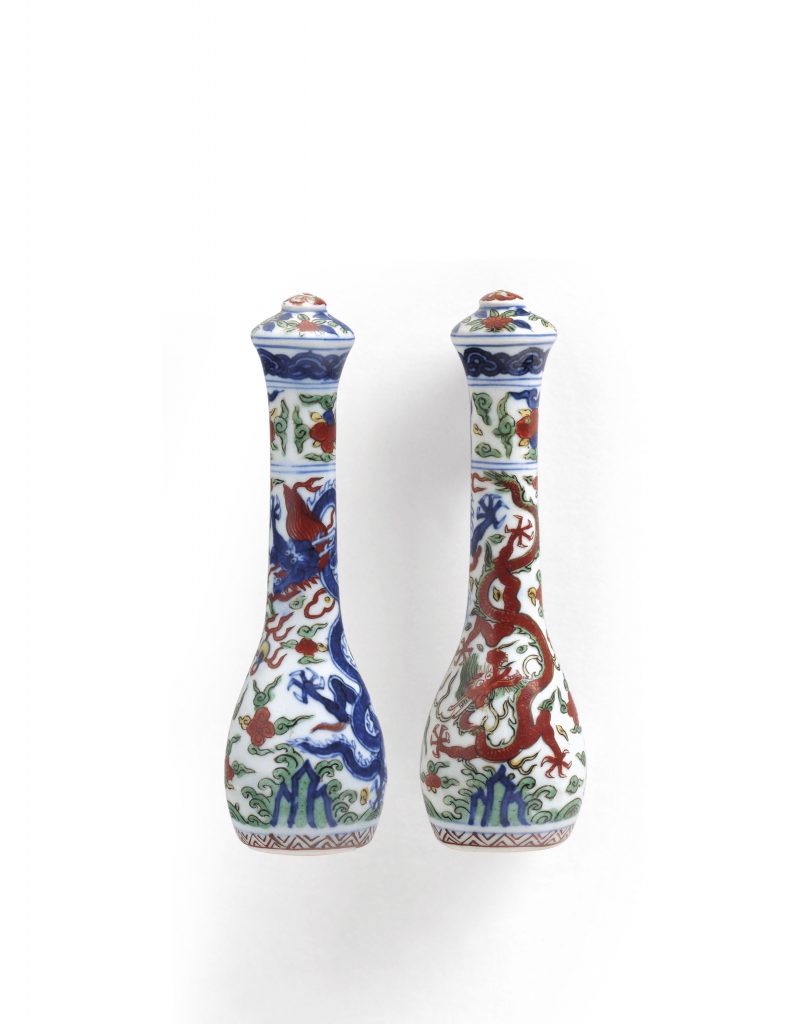
2,500,000 — 3,000,000港幣
拍品已售 5,420,000 港幣 成交價 (含買家佣金)
拍品詳情
A FINE AND RARE WUCAI BRUSH HANDLE
MING DYNASTY, WANLI PERIOD
the bulblous body with a long cylindrical handle surmounted with a pointed knop, the sides painted with two dragons, one blue and one red, both in pursuit of a ‘flaming pearl’ amidst scattered scrolling clouds above crashing waves and tall rocks on the rim, all below a band of underglaze-blue ruyi-heads and a row of scrolling clouds, the top painted with four floral sprays surrounding the knop further decorated with a single floret
18.5 cm., 7 1/4 in.
狀況報告
There is a 2 mm glaze chip on the top of the handle with an attendant horizontal glaze crack (slightly visible in the image on the right showing the red dragon). There is light wear to the iron-red enamelling, but otherwise in good condition.
來源
Collection of Dr. Carl Kempe (1884-1967).
Eskenazi Ltd., London, 1993.
展覽
Chinese Ceramics from the Meiyintang Collection, The British Museum, London, 1994.
Evolution to Perfection. Chinese Ceramics from the Meiyintang Collection/Evolution vers la perfection. Céramiques de Chine de la Collection Meiyintang, Sporting d’Hiver, Monte Carlo, 1996, cat. no. 135.
出版
Bo Gyllensvärd, Chinese Ceramics in the Carl Kempe Collection, Stockholm, 1964, no. 852.
Regina Krahl, Chinese Ceramics from the Meiyintang Collection, London, 1994-2010, vol. 2, no. 708.
相關資料
Wucai brush handles are extremely rare. A related piece of Wanli mark and period in the National Palace Museum, Taiwan, is published in Minji meihin zuroku. Kaiseiyō, Ryukeiyō, Manrekiyō [Illustrated catalogue of important Ming porcelains. Jiajing, Longqing and Wanli wares], Tokyo, 1978, pl. 109; and two unmarked blue-and-white brush handles of similar shape and date are in the Shanghai Museum, illustrated in Lu Minghua, Shanghai Bowuguan zangpin yanjiu daxi/Studies of the Shanghai Museum Collections : A Series of Monographs. Mingdai guanyao ciqi [Ming imperial porcelain], Shanghai, 2007, pls. 1-87 and 1-88.
参考: 蘇富比 SOTHEBY’S
中國瓷器及工藝品
1901明 万历 五彩龙凤雄鸡纹 葫芦瓶
PROPERTY OF A GENTLEMAN
A RARE WUCAI DOUBLE-GOURD WALL VASE WITH ROOSTERS AND PHOENIX
MARK AND PERIOD OF WANLI
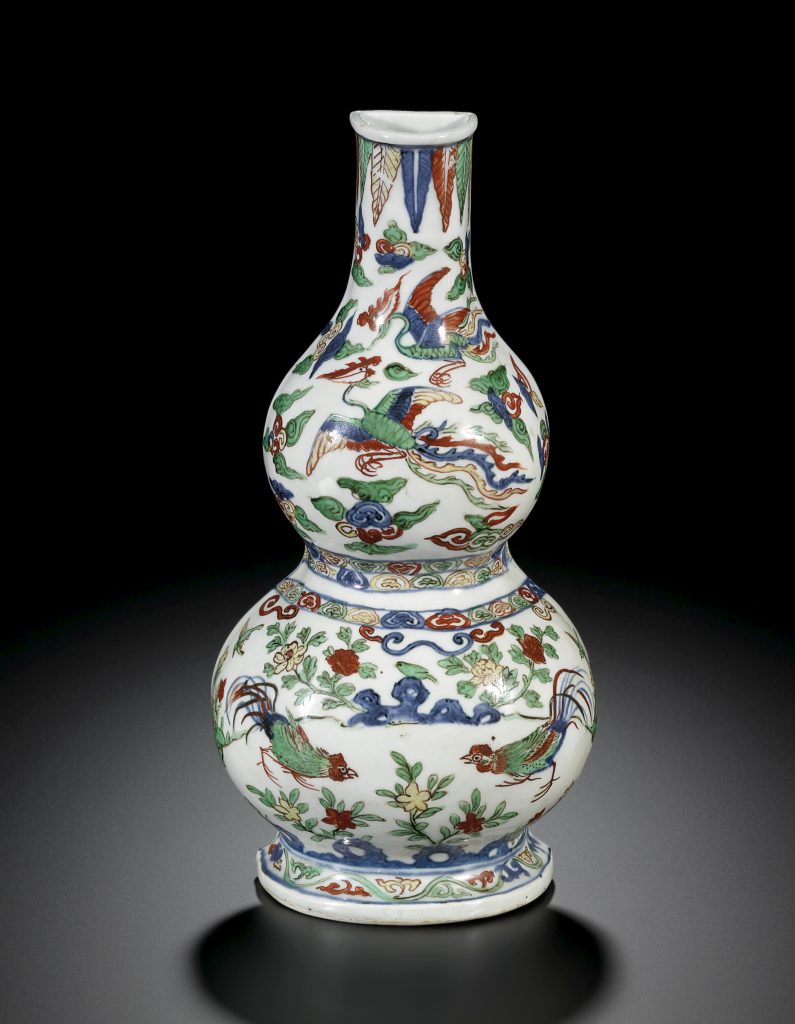
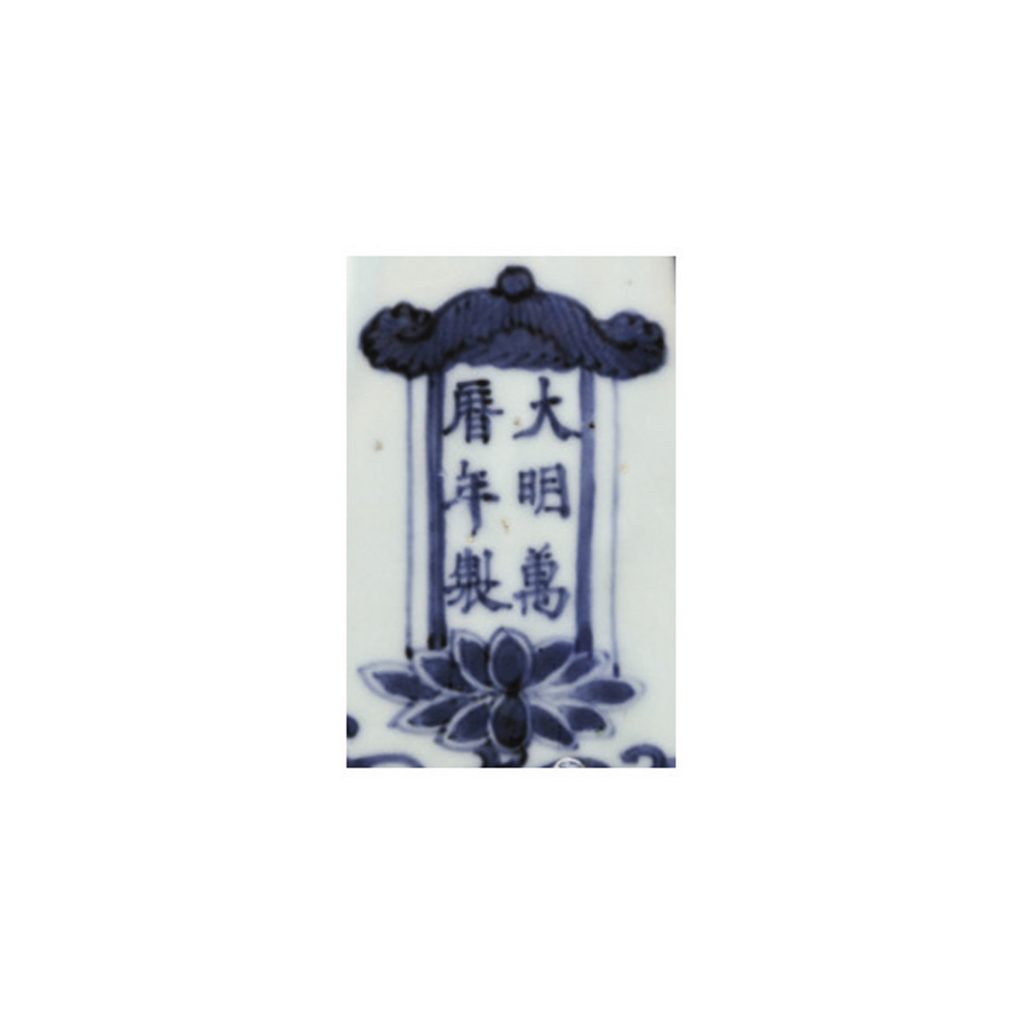
600,000 — 800,000港幣
拍品已售 1,340,000 港幣 成交價 (含買家佣金)
拍品詳情
A RARE WUCAI DOUBLE-GOURD WALL VASE WITH ROOSTERS AND PHOENIX
MARK AND PERIOD OF WANLI
the flat-back vase of elegantly potted double-gourd form, supported on a slightly flared foot, gently rising to a slender neck and lipped mouth, the lower bulb decorated in colours of the wucai palette with a pair of confronting roosters and birds in a garden scene with flowering branches springing from rockwork, below three fillets of ruyi heads at the curved waist, the upper bulb similarly painted with a pair of phoenix in flight, amongst multicolour scrolling clouds beneath pendant plantain leaves encircling the mouth, the reverse inscribed with a six-character reign mark within a rectangular cartouche between a pendant lotus leaf and a lotus bloom, wood stand
30.5 cm., 12 in.
狀況報告
來源
Christie’s Hong Kong, 29th April 1996, lot 685.
相關資料
A closely related example is illustrated in John Ayers, Chinese Ceramics in the Baur Collection, Geneva, 1999, vol. 1, pl. 101; one in the Tianjin City Art Museum is published in Zhongguo taoci quanji, vol. 13, Shanghai, 2000, pl. 110; another in the Dresden Porzellansammlung is included in E. Zimmerman, Chinesisches Porzellan, Leipzig, 1923, pl. 66; and a fourth example was sold at Christie’s London, 11th July 1977, lot 118.
Compare a Wanli wall vase of this form, but decorated with a dense design of phoenixes amid peonies and rockwork on the lower bulb, from the Jingguantang collection, included in the exhibition Joined Colours. Decoration and Meaning in Chinese Porcelain, Arthur M. Sackler Gallery, Smithsonian Institute, Washington D.C., 1993, cat. no. 34, and sold in our London rooms, 12th July 2006, lot 68; one sold in these rooms, 10th April 2006, lot 1781; and another vase sold at Christie’s New York, 9th November 1978, lot 130.
中國瓷器及工藝品
2011年10月5日 | 上午 11:30 HKT
香港
参考: 蘇富比 1944
中國瓷器及工藝品
明 万历 五彩龙凤纹方盖盒
A RARE WUCAI SQUARE BOX AND COVER
MARK AND PERIOD OF WANLI
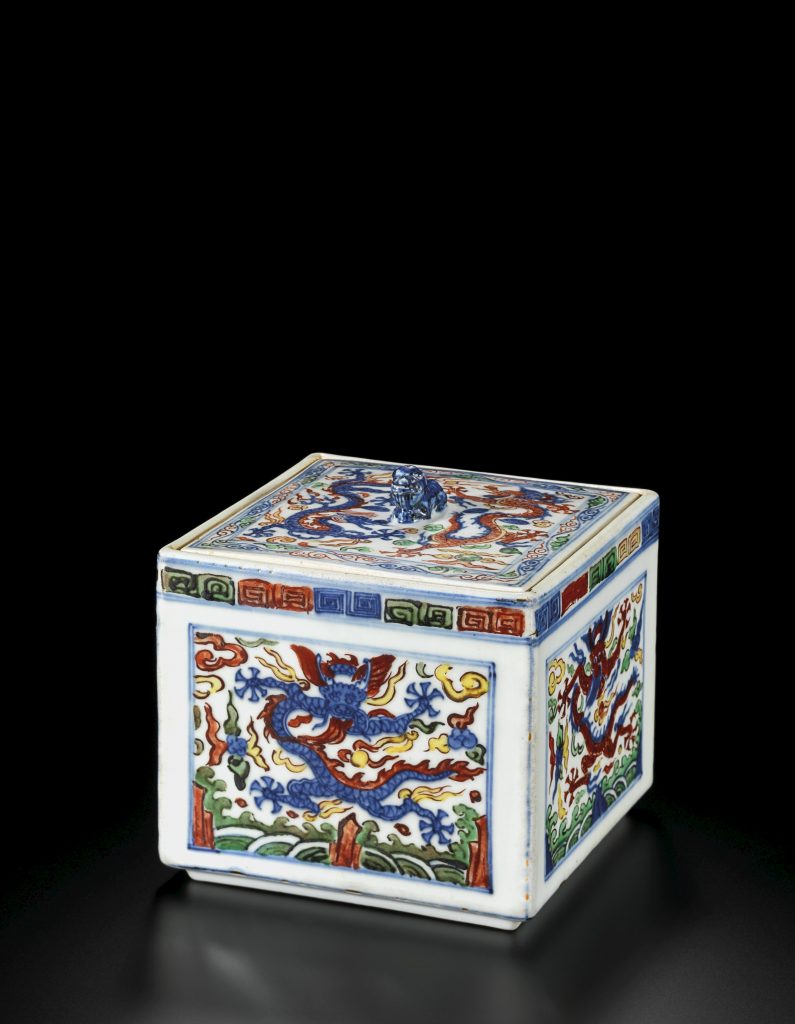
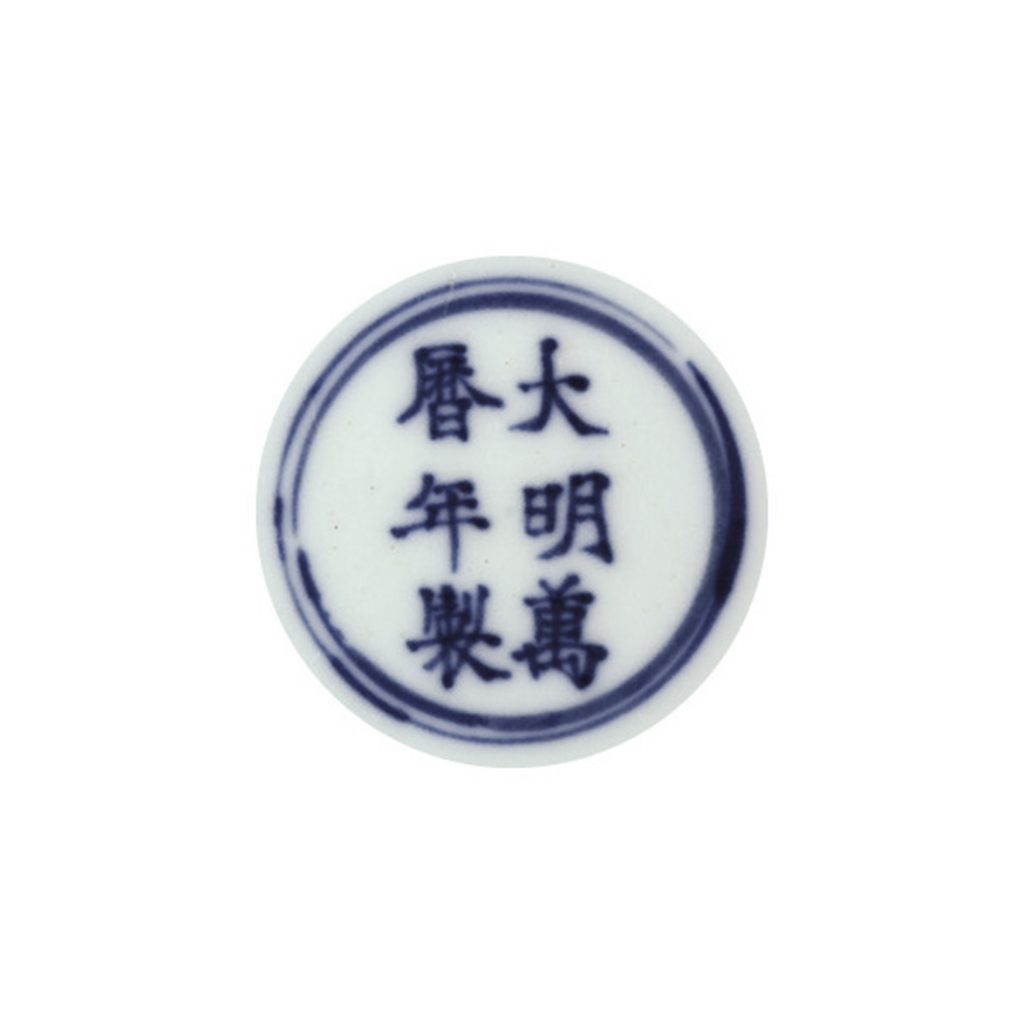
3,000,000 — 4,000,000港幣
拍品詳情
A RARE WUCAI SQUARE BOX AND COVER
MARK AND PERIOD OF WANLI
the vessel of cubic form, raised on a short tapered foot, rising to a straight mouth with an inner lip, boldly painted on each side in the wucai palette with a rectangular panel of a full frontal ferocious leaping dragon, encircling around a ‘flaming pearl’ amongst swirling clouds, turbulent waves and craggy rocks, all below a multicolour key-fret band at the mouth, the countersunk base inscribed in underglaze blue with a six-character reign mark, the fitted cover similarly decorated with two sinuous dragons competing for a ‘flaming pearl’, all enclosed by a border of meandering foliage, surmounted by a cobalt-blue lion in high relief
15 cm., 5 7/8 in.
狀況報告
There is a minor 5 mm original chip to the inner lip of the container. There are some glaze gaps and stained burst air bubbles, as well as a 5 mm glaze crack, to the edges. The cover has two restored chips (1.5 and 1.8 cm) to the corners, probably with original pieces. It also has some shallow chips to its underside, with the largest measuring only about 1 cm. Although there are some scratches and expected wear to the enamels, most of the decoration has been well preserved. The actual colours are slightly less intense than that of the catalogue illustration.
相關資料
Wanli boxes of square section are rare and this box is unusual for its vibrant dragon decoration. Compare a Wanli box of this form, enamelled with scenes of boys at play, published in Sekai toji zenshu, vol. 11, Tokyo, 1955, fig. 169; another from the Manno Art Museum, sold at Christie’s Hong Kong, 28th October 2002, lot 553; and a third example sold in our London rooms, 15th December 1981, lot 209.
Compare blue and white decorated boxes of this square form, also with a Wanli reign mark and of the period, such as one painted with boys, sold in our London rooms, 15th April 1980, lot 260; and another picturing birds amongst trees, also sold in our London rooms, 17th July 1995, lot 57. A square Jiajing box is illustrated in The Complete Works of Chinese Ceramics, Shanghai, 1999, pl. 179.
Wanli wucai boxes of this size and decoration are known in various forms; for example see a barrel-shaped box published in The Complete Works of Chinese Ceramics, vol. 13, Shanghai, 1999, pl. 120; and a tall five-lobed box in the Idemitsu Museum of Art, Tokyo, included in the exhibition Imperial Overglaze-Enamelled Wares in the Late Ming Dynasty, Museum of Oriental Ceramics, Osaka, 1995, cat. no. 29.
中國瓷器及工藝品
2011年10月5日 | 上午 11:30 HKT
香港
参考: 蘇富比
玫茵堂珍藏──重要中國御瓷選萃之三
33
A WUCAI ‘DRAGON’ BRUSH TRAY
MARK AND PERIOD OF WANLI
明 万历 五彩龙纹笔洗
估價 2,000,000 — 3,000,000 港幣
拍品已售 2,420,000 港幣 成交價 (含買家佣金)
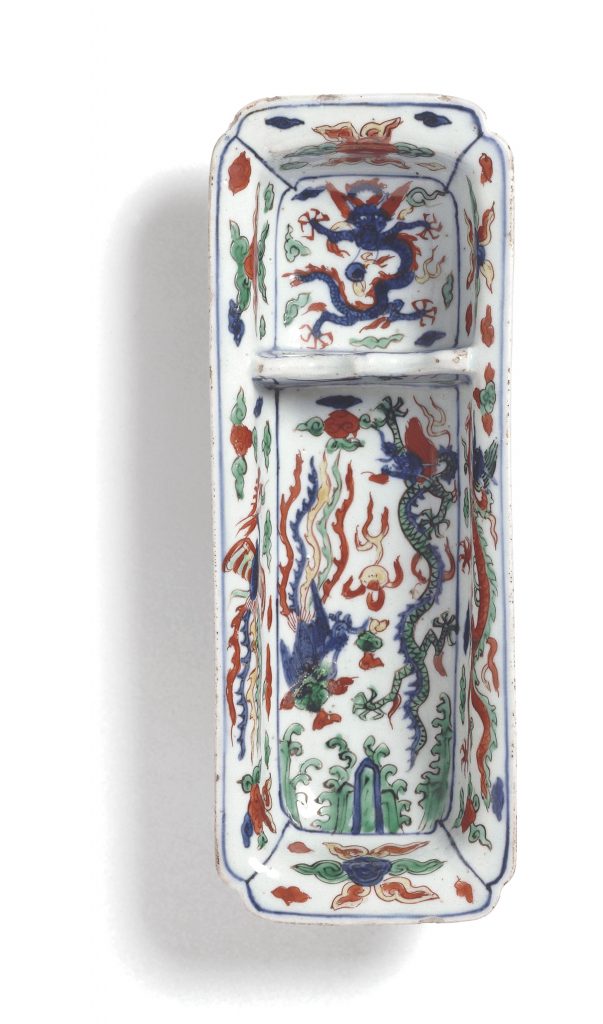

拍品詳情
玫茵堂珍藏──重要中國御瓷選萃之三
2012年4月4日 | 上午 10:15 HKT
香港
A WUCAI ‘DRAGON’ BRUSH TRAY
MARK AND PERIOD OF WANLI
of long rectangular form with slightly flared sides rising to an everted rim with indented corners, supported on a low foot of conforming shape, the interior divided into two sections by a thin crenulated wall shaped to support two brushes, painted on either side of the wall with blue dragon scales above green waves, the larger section vividly painted in underglaze blue, red, green, yellow and black enamels with a five-clawed dragon chasing a ‘flaming pearl’ opposite a long-tailed phoenix among clouds and flames above waves crashing over rocks, flanked on the sides with a dragon on one side and a phoenix on the other, the smaller compartment painted with an en face blue dragon, the sides filled with cloud motifs, the exterior similarly painted with a dragon in pursuit of a ‘flaming pearl’ and a phoenix following behind on either side, set with cloud motifs on each end and a colorful key-fret border around the foot, the base inscribed with a six-character reign mark in a vertical cartouche
30 cm., 11 3/4 in.
狀況報告
展覽
Chinese Ceramics from the Meiyintang Collection, The British Museum, London, 1994.
Evolution to Perfection. Chinese Ceramics from the Meiyintang Collection/ Evolution vers la perfection. Céramiques de Chine de la Collection Meiyintang, Sporting d’Hiver, Monte Carlo, 1996, cat. no. 136.
出版
Regina Krahl, Chinese Ceramics from the Meiyintang Collection, London, 1994-2010, vol. 2, no. 710.
相關資料
Aseries of porcelains designed for the imperial writing desk was devised by the imperial kilns in the Wanli reign (AD 1573-1620), including ink stones, brush rests, brush boxes, brush trays and brush handles. Brush trays of this form are characteristic of the Wanli period, when they were made in several different versions, both in blue-and-white and wucai, sometimes also with a pair of dragons in the centre or with details raised in relief.
A wucai brush tray of the present design in the Shanghai Museum is illustrated in Lu Minghua, Shanghai Bowuguan zangpin yanjiu daxi / Studies of the Shanghai Museum Collections : A Series of Monographs. Mingdai guanyao ciqi [Ming imperial porcelain], Shanghai, 2007, pl. 3-106; another from the collection of Christina Loke Balsara, published in Laszlo Legeza, ‘Ming and Ch’ing Imperial Tou-Ts’ai and Wu-Ts’ai Porcelains’, Arts of Asia, January-February 1980, p. 105 and p. 107, figs. 17-19, was sold at Christie’s Hong Kong, 19th January 1988, lot 265; one without the ‘flaming pearl’ between the dragon and phoenix was sold at Sotheby’s London, 20th June 2001, lot 42; another at Christie’s Hong Kong, 1st December 2010, lot 2810 from the Greenwald collection. A similar tray was also included in the exhibition The Arts of the Ming Dynasty, Detroit Institute of Arts, Detroit, 1952, cat. no. 176, together with a brush handle such as lot 34, both from the Fogg Art Museum, Cambridge, Mass.
参考:佳士得 拍賣 2208
重要中國瓷器
香港|2005年11月28日
拍品1425 明 嘉靖 五彩花卉龙纹方盘
A RARE AND IMPORTANT WUCAI SQUARE DISH

成交總額
HKD 1,200,000
估價
HKD 1,200,000 – HKD 1,500,000
A RARE AND IMPORTANT WUCAI SQUARE DISH
JIAJING SIX-CHARACTER MARK AND OF THE PERIOD (1522-1566)
Well potted with wide flaring sides rising to a slightly everted rim, the interior finely enamelled within a double square with tree peonies springing up from behind pierced rockwork below butterflies and bees in flight, with two iron-red and two underglaze-blue striding dragons on the cavetto, each enclosed within shaped panels reserved on a diaper ground with florettes in the corners, the exterior with further clusters of flowers and insects, divided by lingzhi at the corners, all within iron-red double-lines
6 7/8 in. (17.8 cm.) square, Japanese wood boxes
來源
A Japanese private collection
文獻及展覽
文獻
Ryoichi Fujioka, Toki zenshu 27, Min no Akae (Polychrome Wares of the Ming), Hebensha, 1965, no. 25
Ryoichi Fujioka, Toji daikei 43, Min no Akae (Polychrome Wares of the Ming), Hebensha, 1973, no. 55
展覽
Gen min meihim den (Masterpieces of the Yuan and Ming), Takashimaya, Tokyo, 1956, Catalogue no. 125
拍品專文
A range of innovative shapes were introduced in the Jiajing period, and this type of square dish with flaring sides was one of these new forms.
In wucai enamels, similar dishes include one bequeathed by Harry Oppenheim, illustrated by J. Harrison-Hall, Ming Ceramics in the British Museum, London, 2001, pl. 9:115, where the author compares it to another example from an unnamed private Japanese collection, illustrated by Yajima Ritsuko, Overglaze Enamel Ware in the Ming Dynasty, Japan, 1996, no. 31; one in the Umezawa Gallery, included in Mayuyama, Seventy Years, fig. 838, as well as in Sekai Toji Zenshu, vol. 11, fig. 127; and one illustrated in Ceramic Art of the World, Shogakukan Series, vol. 4, pl. 78. Two related dishes were sold at auction, the first in our London Rooms, 17 June 1985, lot 437; and the other was sold in these Rooms, 30 October 1995, lot 712 A, and again, in our New York Rooms, 16 September 1998, lot 364.
Compare also to another dish of this form, painted in underglaze-blue on a yellow-enamel ground, also bequeathed by Harry Oppenheim to the British Museum, illustrated by J. Harrison-Hall, op. cit., pl. 9:87.
参考:佳士得 拍賣 2190
重要中國瓷器及工藝精品
Hong Kong|2005年5月30日
拍品1458 明 万历 五彩龙纹四方盖盒
A RARE WUCAI SQUARE BOX AND COVER
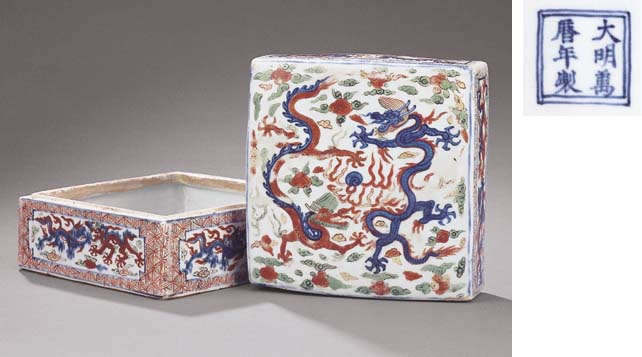
成交總額
HKD 480,000
估價
HKD 150,000 – HKD 200,000
A RARE WUCAI SQUARE BOX AND COVER
WANLI SIX-CHARACTER MARK WITHIN DOUBLE-SQUARES AND OF THE PERIOD (1573-1619)
The cover decorated with a pair of five-clawed dragons flanking a ‘flaming pearl’, amid flames and ruyi-shaped cloud scrolls, the sides of the box and the cover each with a rectangular panel containing a further two dragons within a similar ground framed within an iron-red and green enamelled diaper border (glaze chips to corners, hairline to side of box)
6 1/2 in. (16.5 cm.) square, box
拍品專文
Boxes of this pattern and shape are extremely rare.
Compare to a square box decorated with boys at play from the Manno Art Museum, sold in these Rooms, 28 October 2002, lot 553. Another square box depicting a scholar and young attendants in the Tokyo National Museum, is illustrated in Oriental Ceramics, Kodansha Series, 1982, vol. 1, no. 126.
参考:佳士得 拍賣 2389
西暎東暉
Hong Kong|2007年11月27日
拍品1751 明 五彩折边龙纹罐
A LATE MING WUCAI LOBED ‘DRAGON’ BOX
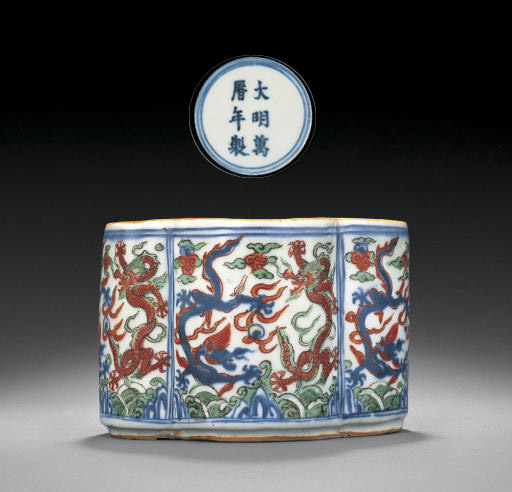
成交總額
HKD 427,500
估價
HKD 60,000 – HKD 80,000
A LATE MING WUCAI LOBED ‘DRAGON’ BOX
WANLI SIX-CHARACTER MARK WITHIN DOUBLE-CIRCLES AND OF THE PERIOD (1573-1620)
Of lobed pentafoil form, each lobed panel painted around the exterior in vivid green, yellow and iron-red enamels on underglaze blue with confronting dragons amidst ruyi clouds contesting a ‘flaming pearl’, all above rockwork jutting out from turbulent waves, each panel enclosed within double squares
5 7/8 in. (14.5 cm.) wide
來源
A Japanese private collection
拍品專文
Lobed boxes and covers with dragons include a pentagonal box from the Idemitsu Museum of Arts, exhibited at the Museum of Oriental Ceramics, Osaka, Imperial Overglaze-Enamelled Wares in the Late Ming Dynasty, 1995, and illustrated in the Catalogue, no. 29; and a hexagonal example in Beijing, illustrated in Porcelains in Polychrome and Contrasting Colours, The Complete Collection of Treasures of the Palace Museum, Hong Kong, 1999, pl. 32.
Compare also a smaller lobed Wanli-marked box and cover with ‘dragon and phoenix’ design sold at Christie’s Hong Kong, Imperial Chinese Ceramics from the Robert Chang Collection, 28 November 2006, lot 1315.
参考:佳士得 拍賣 2830
曄兮如華 – 葛沃得珍藏御製瓷器
香港|2010年12月1日
拍品2810明萬曆 五彩龍鳳紋筆船 雙長方框六字楷書直款
A FINE MING WUCAI ‘DRAGON AND PHOENIX’ PEN-TRAY
WANLI SIX-CHARACTER MARK WITHIN A RECTANGLE AND OF THE PERIOD (1573-1619)
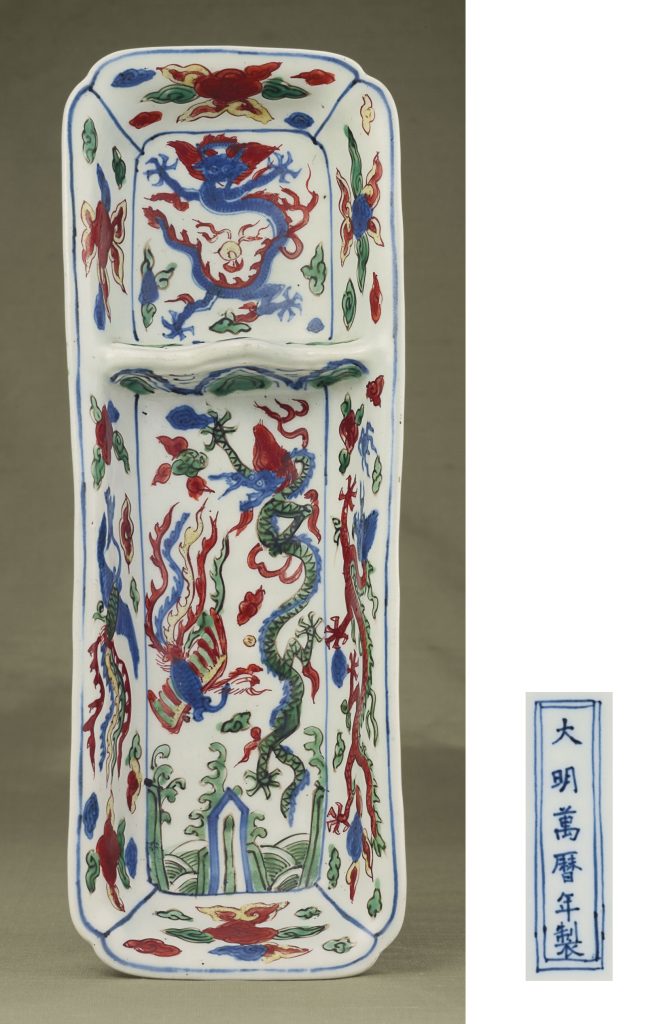
成交總額
HKD 7,220,000
估價
HKD 2,000,000 – HKD 3,000,000
明萬曆 五彩龍鳳紋筆船 雙長方框六字楷書直款
筆船呈長方形,倭角,撇口,隨形圈足。通體五彩紋飾,內設筆擱。底心筆擱上方繪一躍龍,下繪一對龍鳳騰躍於祥雲瑞靄之間,底部間繪江崖海水,內、外壁繪龍鳳戲珠彩雲紋。器底雙長方框內青花書「大明萬曆年製」楷書直款。
由此器上的紋飾來看,應為明代宮廷御用之物。龍主陽為天,鳳主陰為地,並輔以華麗富貴的紋飾,為宮廷用器中之精品。
筆船是盛放毛筆的文房用具。毛筆橫臥在船中筆擱上,一隻筆船上最多可放置三四支筆。明代屠隆《考槃餘事》中記載了使用方法:「此與直方並用,不可缺者。」筆船造型別緻,但不便於使用,置筆數量又不可太多,故漸被筆筒所取代。
此器1982年12月13日於倫敦佳士得拍賣,拍品478號;2001年10月30日於香港佳士得拍賣,拍品611號。並著錄於1984年佳士得出版Anthony du Boulay 著《Christie’s Pictorial History of Chinese Ceramics》171頁。
來源
Previously sold at Christie’s London, 13 December 1982, lot 478, and sold again at Christie’s Hong Kong, 30 October 2001, lot 611
Greenwald Collection, no. 76
文獻及展覽
文獻
A. du Boulay, Christie’s Pictorial History of Chinese Ceramics, Oxford, 1984, p. 171, no. 2
拍品專文
A limited number of pen-trays decorated in the wucai palette with the combined ‘dragon and phoenix’ design are known such as the example from the Christina Loke Balsara Collection, sold at Christie’s Hong Kong, 19 January 1988, lot 265; and another is illustrated by R. Krahl, Chinese Ceramics from the Meiyintang Collection, vol. 2, no. 710.
There is another group of related Wanli-marked wucai pen-trays of the same shape but with a slight variation in the main motifs where they are moulded in relief and the ‘dragon and phoenix’ on the interior main compartment are replaced with a pair of dragons. These include an example exhibited by Yamanaka & Co., London, 1938, Exhibition of Chinese Ceramic Art, Bronze, Jade, etc., and sold at Sotheby’s London, 11 June 1996, lot 36; a pen-tray from the Robert Chang collection, sold at Christie’s Hong Kong, 31 October 2000, lot 828; its companion pen-tray was included in the exhibition, Ming and Ch’ing Porcelain from the Collection of the T. Y. Chao Family Foundation, Hong Kong Museum of Art, 1978, illustrated in the Catalogue, no. 42; and another in the Percival David Foundation exhibited in Ceramic Evolution in the Middle Ming Period, illustrated in the Catalogue, no. 22; and another from the Hirota Collection, now in the Tokyo National Museum, is illustrated in Oriental Ceramics, The World’s Great Collections, Kodansha series, 1982, vol. 1, pl. 76.
参考:佳士得拍卖 17739 宝芳阁官窑瓷器珍藏 香港|2019年5月29日 拍品2811 A FINE AND RARE LARGE DOUCAI JARDINIERE
QIANLONG SIX-CHARACTER SEAL MARK IN UNDERGLAZE-BLUE AND OF THE PERIOD (1736-1795)
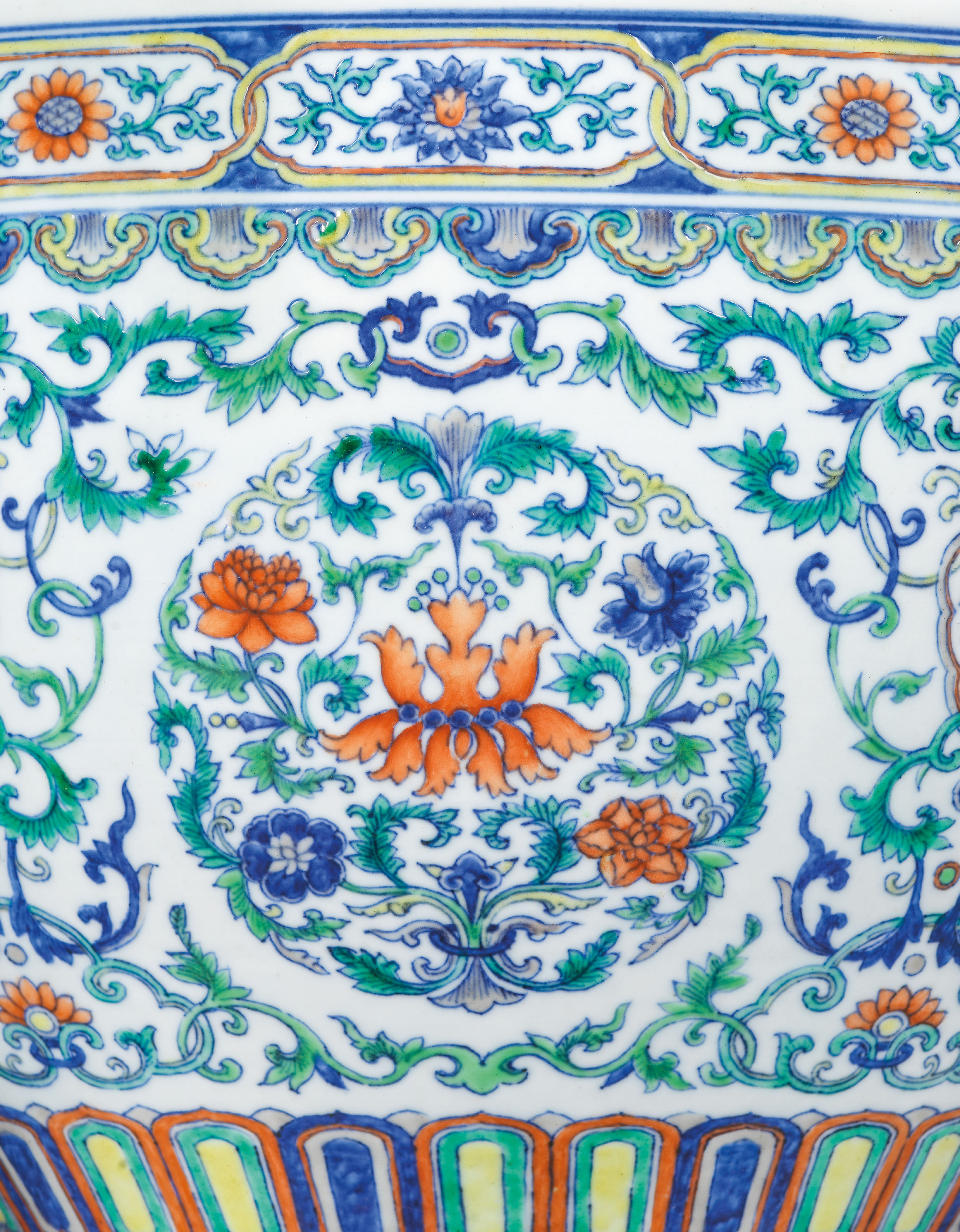
拍品2811 A FINE AND RARE LARGE DOUCAI JARDINIERE
QIANLONG SIX-CHARACTER SEAL MARK IN UNDERGLAZE-BLUE AND OF THE PERIOD (1736-1795)
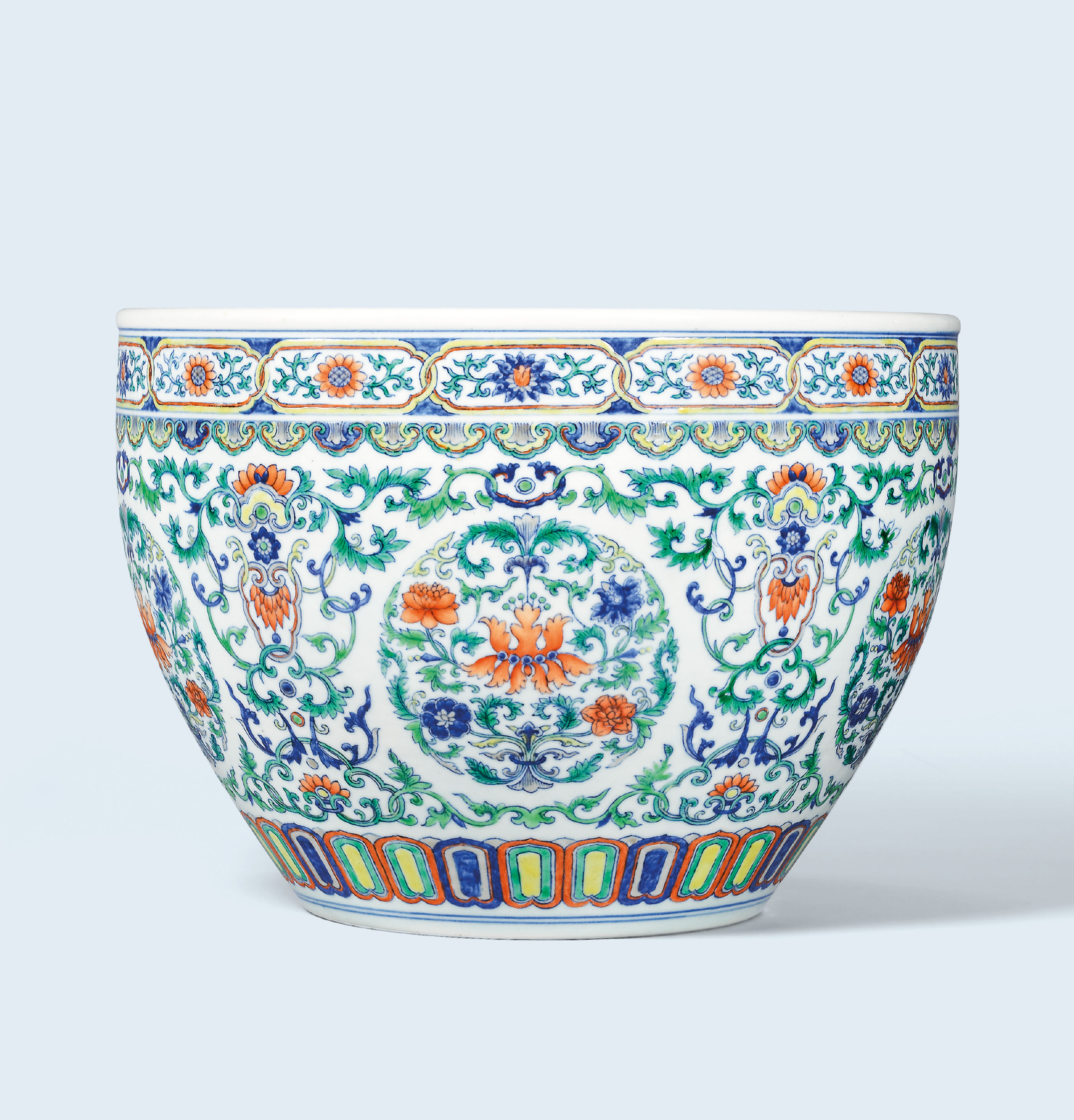
拍品2811 A FINE AND RARE LARGE DOUCAI JARDINIERE
QIANLONG SIX-CHARACTER SEAL MARK IN UNDERGLAZE-BLUE AND OF THE PERIOD (1736-1795)
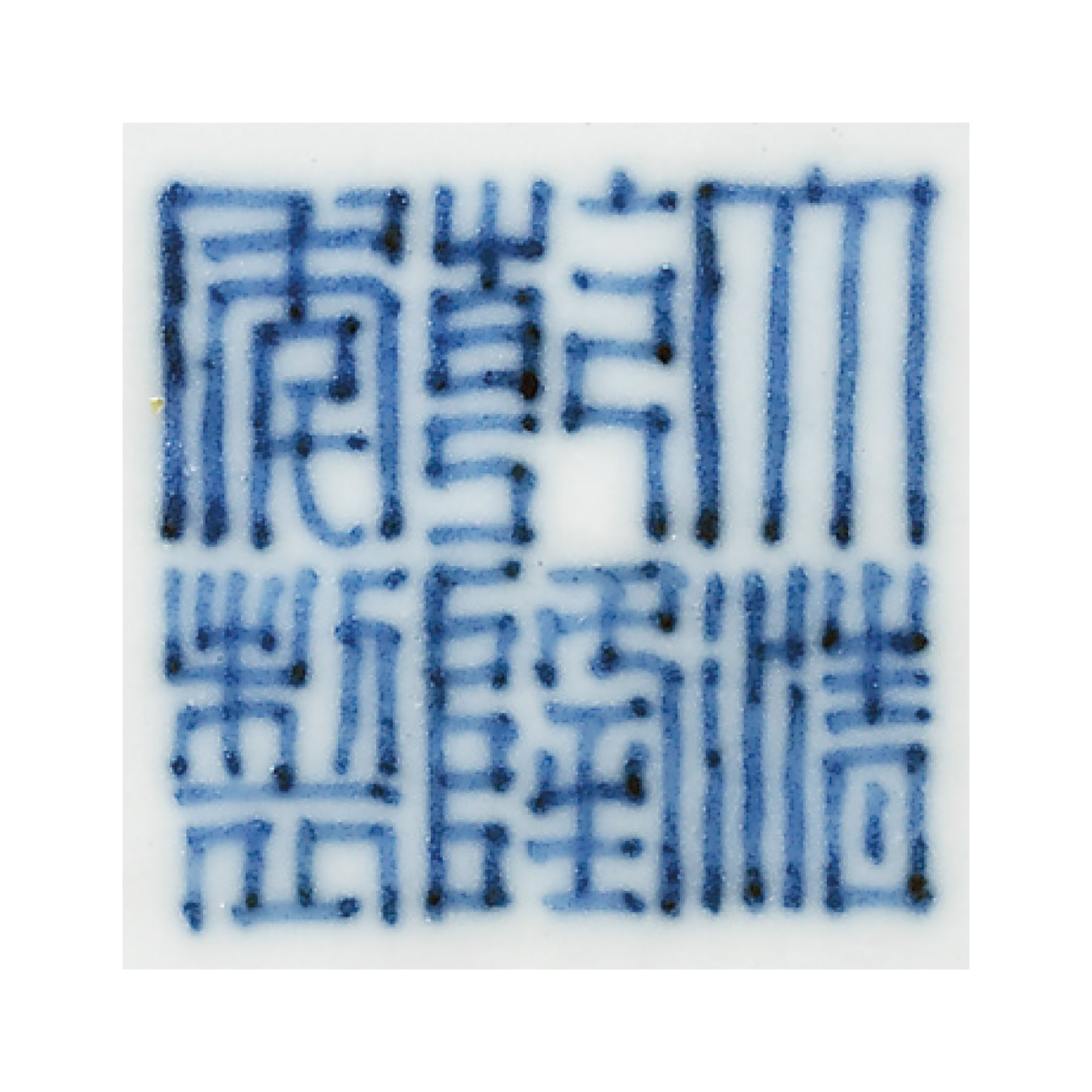
拍品2811 A FINE AND RARE LARGE DOUCAI JARDINIERE
QIANLONG SIX-CHARACTER SEAL MARK IN UNDERGLAZE-BLUE AND OF THE PERIOD (1736-1795)
成交总额
HKD 4,685,000
估价
HKD 2,800,000 – HKD 3,500,000
关注拍品
13 ¼ in. (33.5 cm.) diam, box
来源
Sold at Christie’s Hong Kong, 18 March 1991, lot 597B
拍品专文
Only a few other examples of this pattern are known, all seem to be decorated with famille-rose and doucai, these include one in the Shanghai Museum, illustrated in Selected Ceramics from the Collection of Mr. and Mrs. J.M. Hu, Shanghai, 1989, no. 68; one illustrated in Sekai Toji Zenshu, vol. 15, Tokyo, 1983, pp. 86-87, nos. 94 and 95; one in the Idemitsu Museum, illustrated in Chinese Ceramics in the Idemitsu Collection, Tokyo, 1987, fig. 947; one in the Seikado Bunko Art Museum, illustrated in Exhibition of Qing Ceramics from the Seikado Bunko Art Museum, Tokyo, 2006, p. 72, no. 62; a single one and a pair were included in the exhibition Ming and Qing Ceramics and Works of Art held at the Osaka Municipal Museum in 1980, see Catalogue,
p. 43, nos. 191 and 193, respectively; one sold at Christie’s Hong Kong, 28 November 2006, lot 1546; and one with the mark effaced sold at Christie’s New York, 24 March 2011, lot 1704.
参考:参考:大明·格古 北京保利北京保利十二周年秋季拍卖会
Lot 6097 明万历 御制青花五彩龙纹三层盖盒及格碟
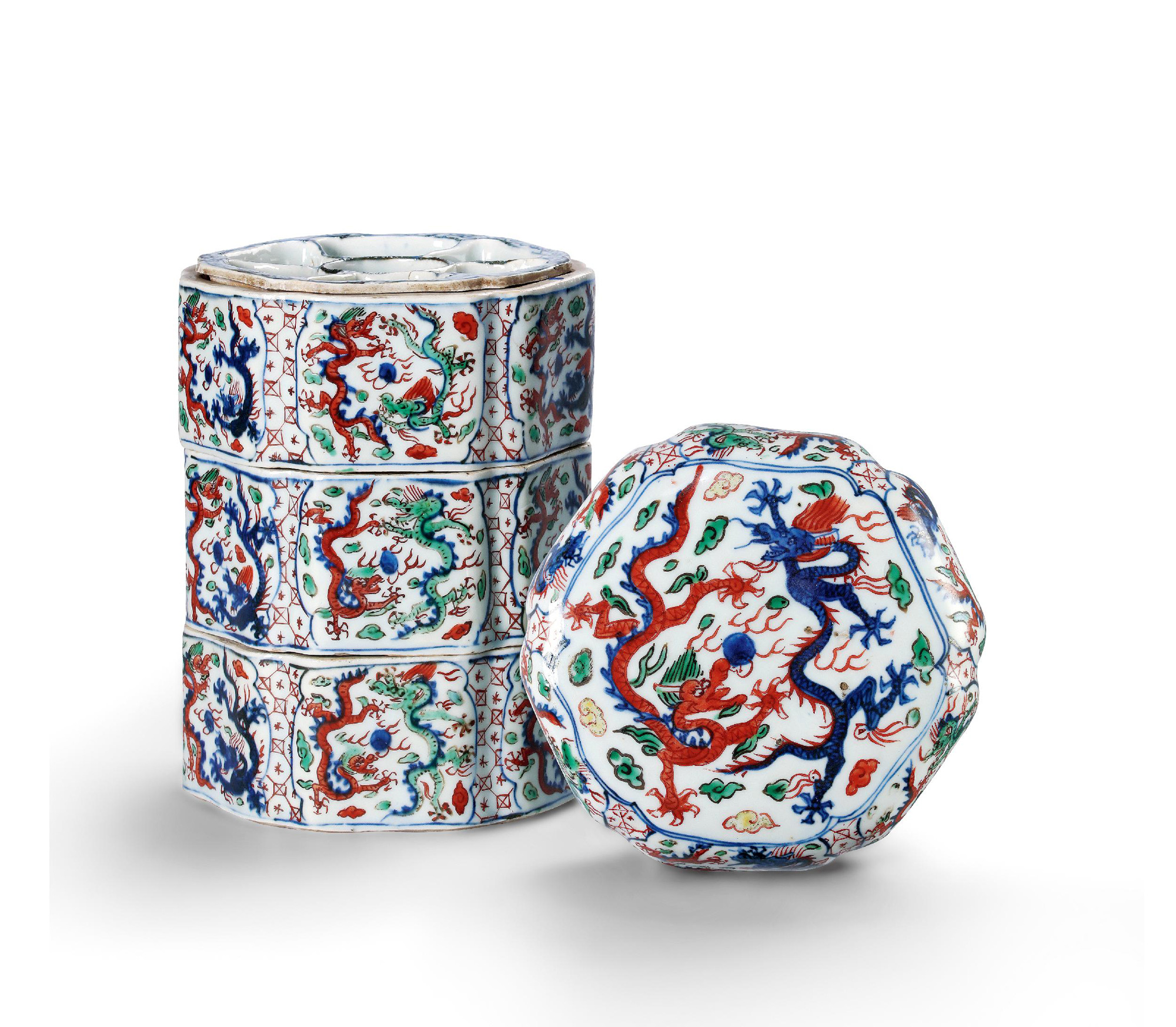
估价:1,000,000-1,500,000 RMB
成交价: 2,990,000 RMB (含买家佣金)
拍品说明
尺寸:高20.2cm;架高33.5cm
本品系多层盖盒,共三层,第三层上置有一盖,盖中央绘红蓝二色双龙,张牙舞爪,极富气势,而器盖与套盒每层均作六方形,而每面如同器盖每面亦绘双龙,故本品共绘五十条龙。从绘有数量如此之多的五爪龙便可知,本品无疑属皇帝御用之器。此盖盒原有款识,于晚清时磨去。其所配黑漆描金赶珠龙纹座架,其纹饰与故宫博物院所藏「明万历 黑漆描金云龙纹药柜」相似,此柜为明代宫廷御用药柜,原存太医院御药局御药库,国家博物馆亦藏有一件相似品。从其纹饰技法可推断,此座架应与盖盒为同时期原配。多层盖盒,又称套盒,宋代越窑、汝窑、南宋官窑均有生产。从历代套盒的传世及出土情况来看,其使用对象为上流阶层无疑,甚至只限于皇宫范围。故套盒属一种极为高等级的器物,很可能是一类皇家专用用器,以其纹饰之浓厚宗教色彩,亦有可能供奉于佛家寺庙。检索国内外公私收藏,未见与本品形制相近的万历五彩多层盖盒,仅见寻常盖盒,如一例北京故宫博物院收藏的万历五彩花鸟纹盖盒,其其内每格之布局即与本品近似(参见:《故宫博物院藏文物珍品大系 五彩•斗彩》,第44页,图版40),又可见一例梅泽纪念馆收藏者,亦与本品有所相似(参见:《龙泉集芳 第一集》,第305页,图版919)。万历五彩盖盒传世已十分鲜见,而作套盒者,传世仅见本品,故本品之珍稀性不言而喻,且本品绘画精致,双龙飞舞,健壮有力,无疑是万历五彩瓷器之珍品。备注1.日本江户时代,加贺藩藩主前田利家旧藏;2.日本财阀家族购藏于1930年代
参考:大明·格古
北京保利北京保利十二周年秋季拍卖会
Lot 6095 明万历 青花五彩云龙花卉长方文具盒
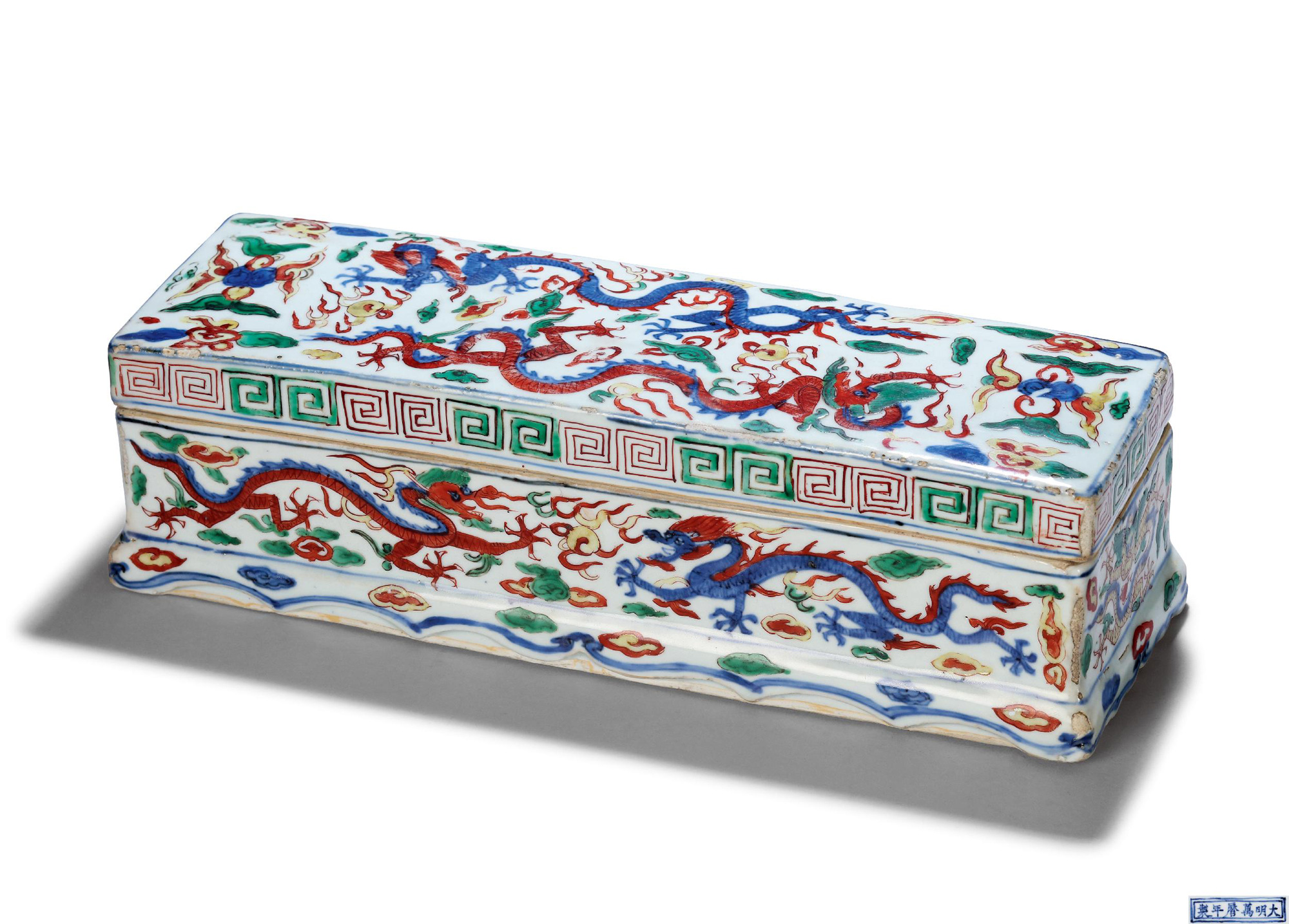
估价:1,200,000-1,800,000 RMB
成交价: 1,725,000 RMB (含买家佣金)
拍品说明
尺寸:长34.5×12cm
「大明万历年制」款 此盖盒长方形,上下作天地盖相扣合,底部外延为台座,做如意云头状足。盖盒内外壁皆以五彩为饰,外壁口沿绘一周回纹,底足装饰如意云纹,其余皆绘云龙纹。盖面为双龙赶珠纹样,龙身盘曲遒劲,口齿龇张,声势威猛, 首尾相对赶珠而戏。四周环饰火焰及祥云纹样。盖内则一改外壁密不透风之装饰技法,绘饰老梅一枝,颇具文人雅意。器底以青花书「大明万历年制」六字一行楷书款。万历一朝瓷器在构图方面,一改成化疏朗雅致的风格,图案以花纹满密为胜。追求色釉浓艳,繁缛华丽之效果,恰如本品之装饰风格,以平涂技法满绘云龙纹,色泽鲜妍,靓丽夺目。而明代制度从洪武二十六年开始,凡烧造供用器皿等物,均先由内府制定样式,再转交窑场烧造。这种颁样的纹饰在万历年间,明确记载的有「万历十一年,降发瓷器式样四百四十三件」,「十九年,降发瓷器式样四百六十一件」,「二十年,降发瓷器式样一十五件」;由此可知,如本品之造型及纹样,应当为内府设计定夺后,由景德镇御窑厂照样烧造的结果。同类器可参见《清玩雅集廿周年庆收藏展•器物》(页150,图58)。整器造型规矩,构图繁密而有秩,绘功传神,为万历一朝不可多得之文房佳器。备注日本藏家旧藏
参考:佳士得 拍卖 13753
美藏于斯 ─ 大都会艺术博物馆珍藏中国瓷器 纽约|2016年9月15日
拍品901 A GREEN, YELLOW, CREAM AND AUBERGINE-GLAZED BISCUIT BOWL KANGXI PERIOD (1662-1722)
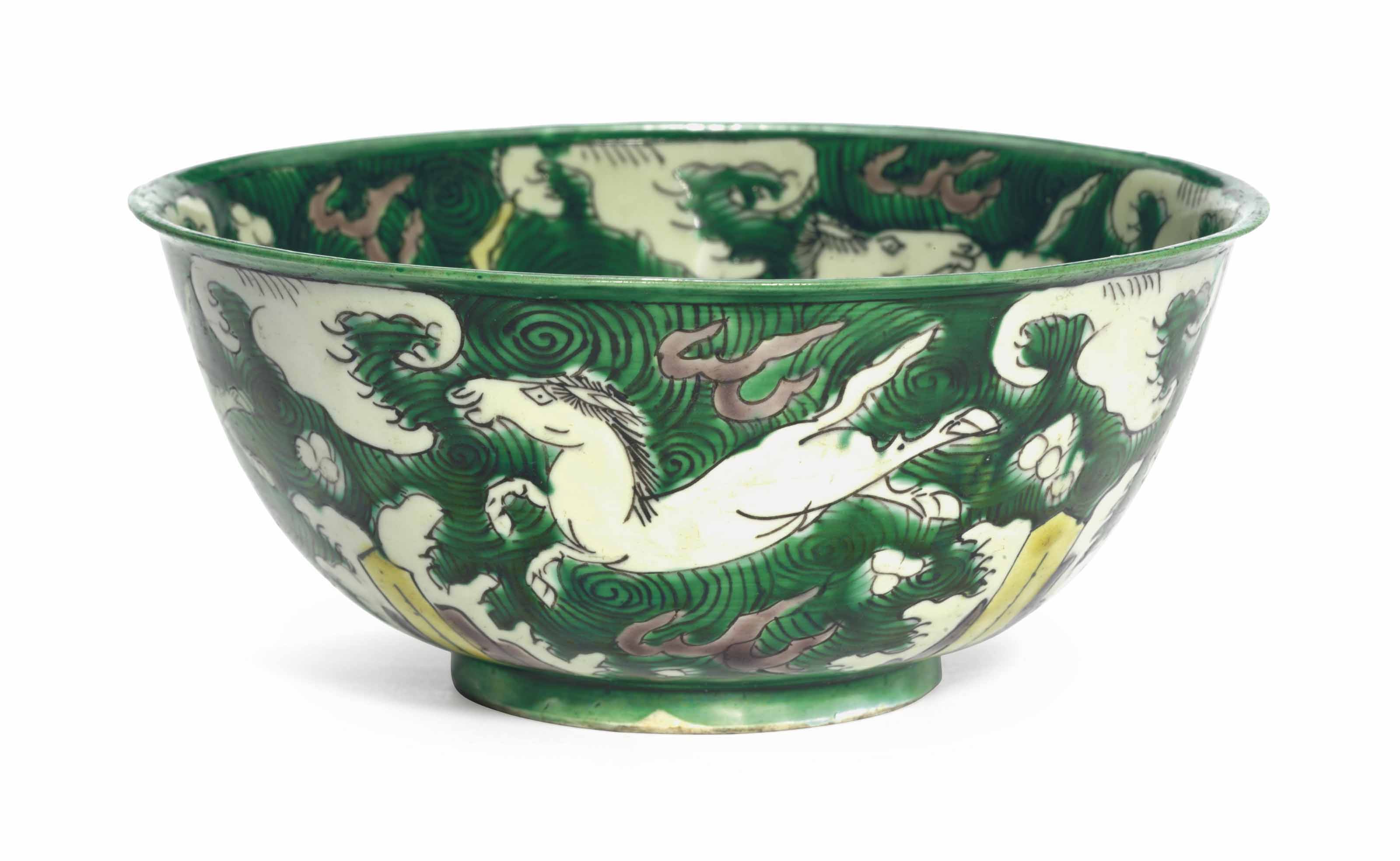
美藏于斯 ─ 大都会艺术博物馆珍藏中国瓷器
纽约|2016年9月15日
拍品901
A GREEN, YELLOW, CREAM AND AUBERGINE-GLAZED BISCUIT BOWL
KANGXI PERIOD (1662-1722)
成交总额
USD 11,875
估价
USD 3,000 – USD 5,000
此拍品不设底价
A GREEN, YELLOW, CREAM AND AUBERGINE-GLAZED BISCUIT BOWL
KANGXI PERIOD (1662-1722)
The exterior is decorated with horses galloping above waves crashing on rocks and amidst flames, with further horses amidst prunus blossoms and auspicious emblems on the interior. The whole is reserved on a green-glazed scroll-patterned ground.
7 ½ in. (19 cm.) diam.
来源
Mary Clark Thompson (1835-1923) Collection.
The Metropolitan Museum of Art, New York, accessioned in 1923.
参考:INSPIRED: CHINESE ART FROM THE COLLECTION OF GERSON AND JUDITH LEIBER
413 A FAMILLE-VERTE BISCUIT ‘SEA HORSE’ BRUSHPOT
QING DYNASTY, 17TH CENTURY
Estimate 2,000 — 3,000 USD
LOT SOLD. 2,750 USD
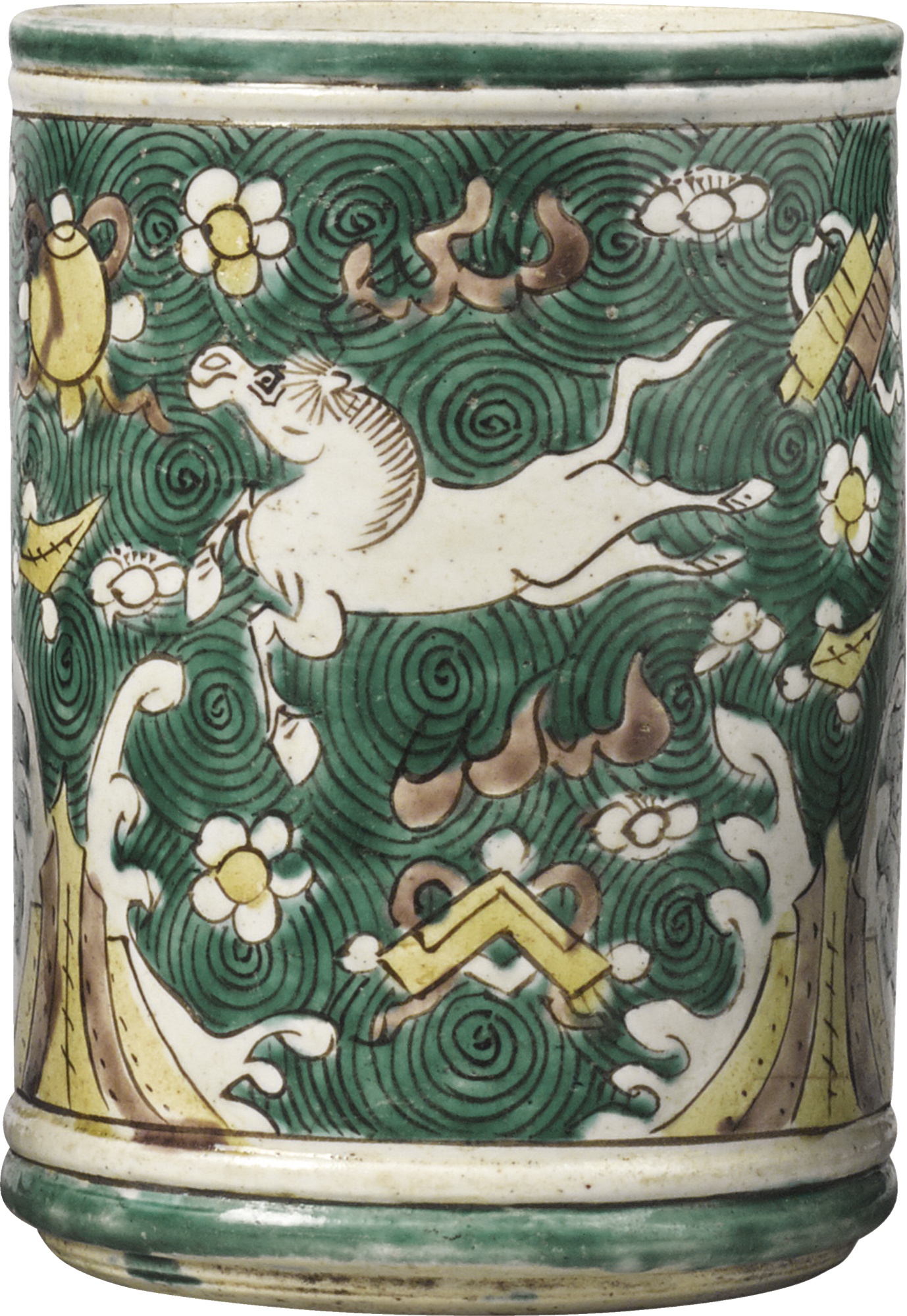
A FAMILLE-VERTE BISCUIT ‘SEA HORSE’ BRUSHPOT
QING DYNASTY, 17TH CENTURY
of cylindrical form, painted with yellow, aubergine, and white horses frolicking on a ground of green swirling waves among florettes and auspicious emblems, above three mountain peaks with cresting waves rising from the base, the rim and foot ringed with white and green molded bands
Height 5 1/4 in., 13.4 cm
In overall good condition with minor surface wear and firing flaws. The mouth with an old flake chip and with minor glaze flake losses.
PROVENANCE
Sotheby’s London, 27th February 1973, lot 156.
Marchant, London.
Ralph M. Chait Galleries, New York.
參考:美國纽约大都會博物館 明 嘉靖 青花五彩鱼藻纹罐
Jar with Carp in Lotus Pond, Porcelain painted with cobalt blue under and colored enamels over transparent glaze (Jingdezhen ware), mid-16th century
China
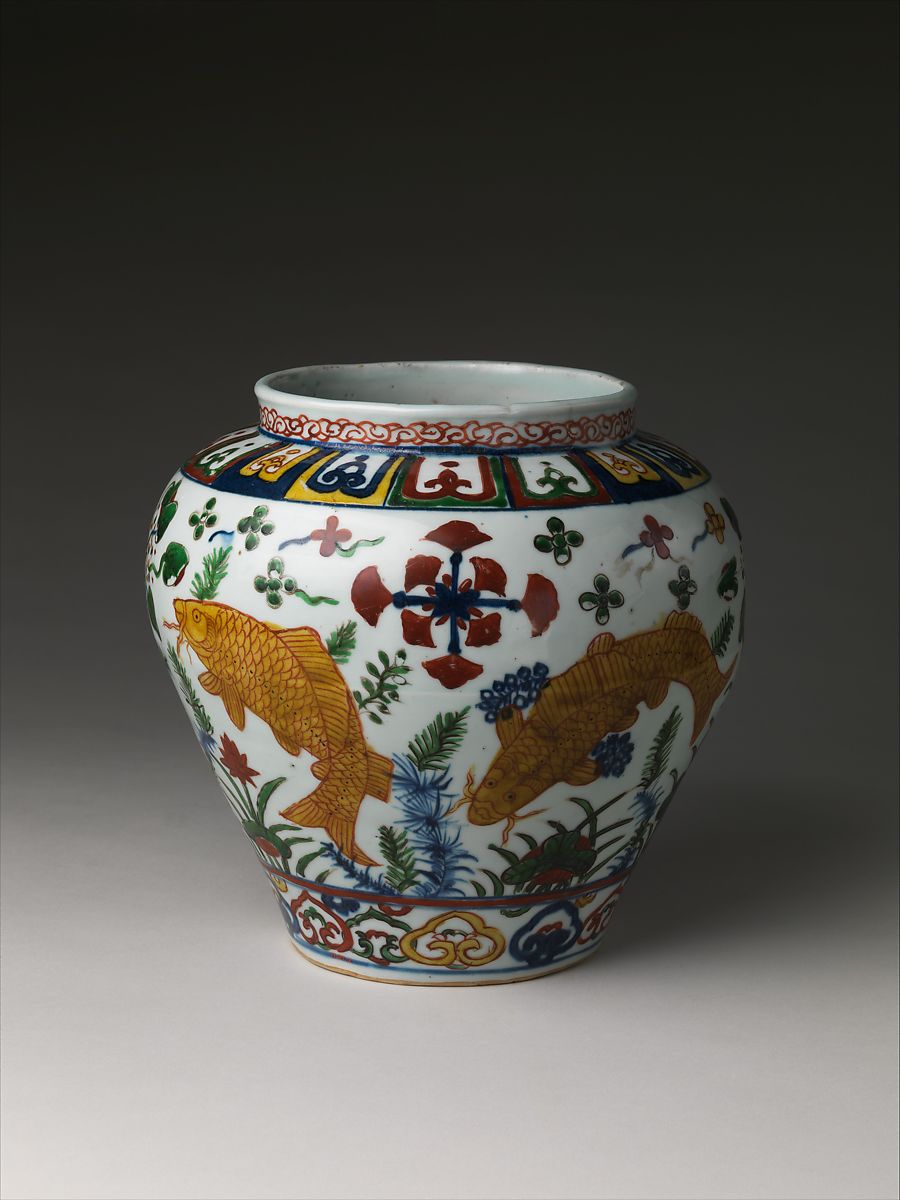
Jar with Carp in Lotus Pond, Porcelain painted with cobalt blue under and colored enamels over transparent glaze (Jingdezhen ware), mid-16th century
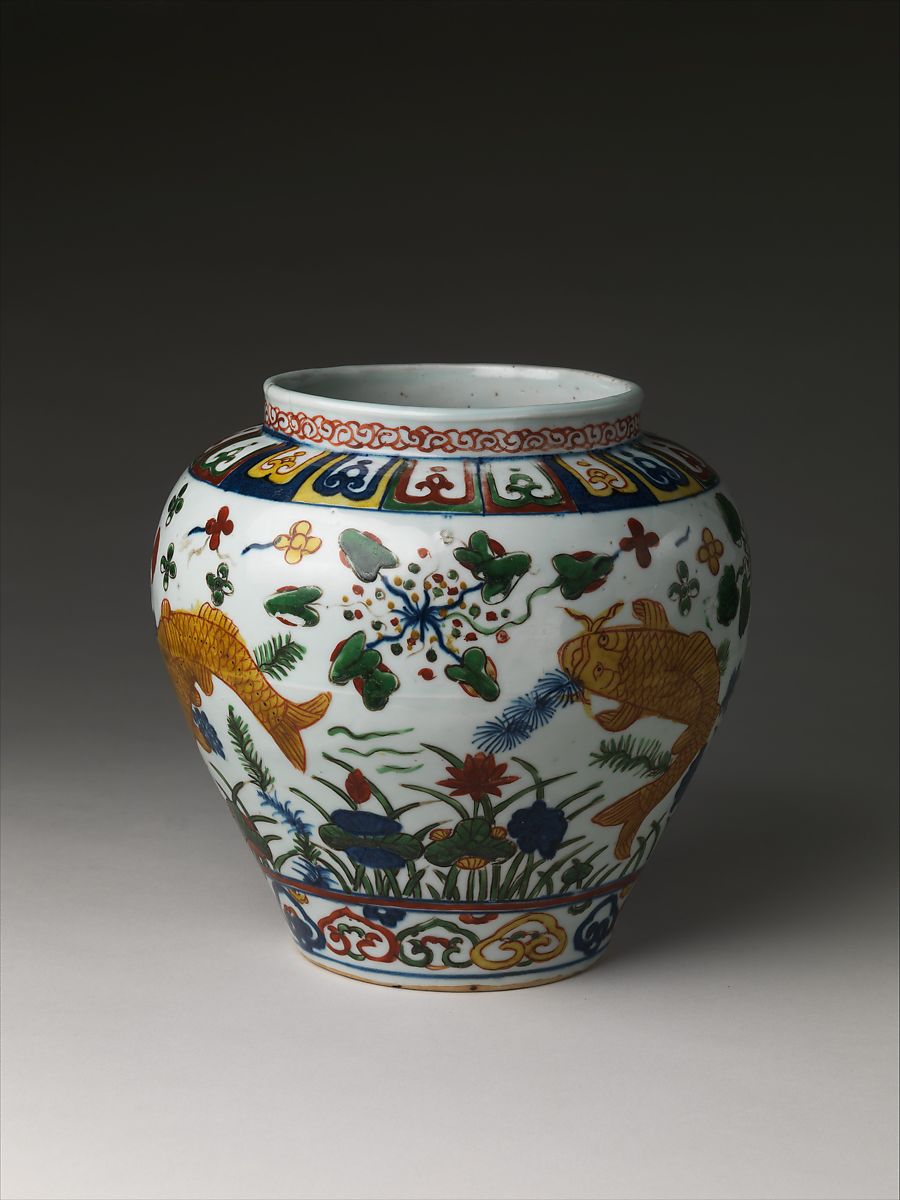
Jar with Carp in Lotus Pond, Porcelain painted with cobalt blue under and colored enamels over transparent glaze (Jingdezhen ware), mid-16th century
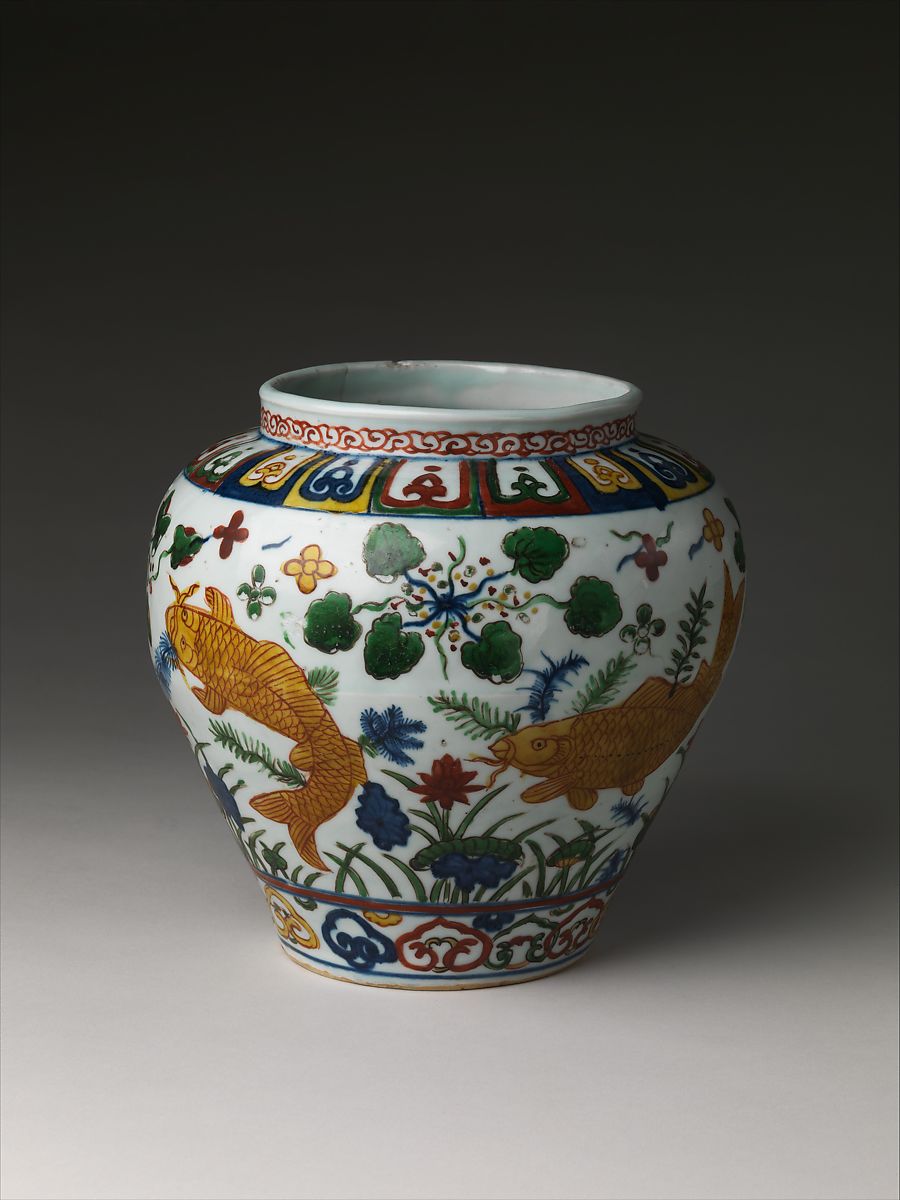
Jar with Carp in Lotus Pond, Porcelain painted with cobalt blue under and colored enamels over transparent glaze (Jingdezhen ware), mid-16th century
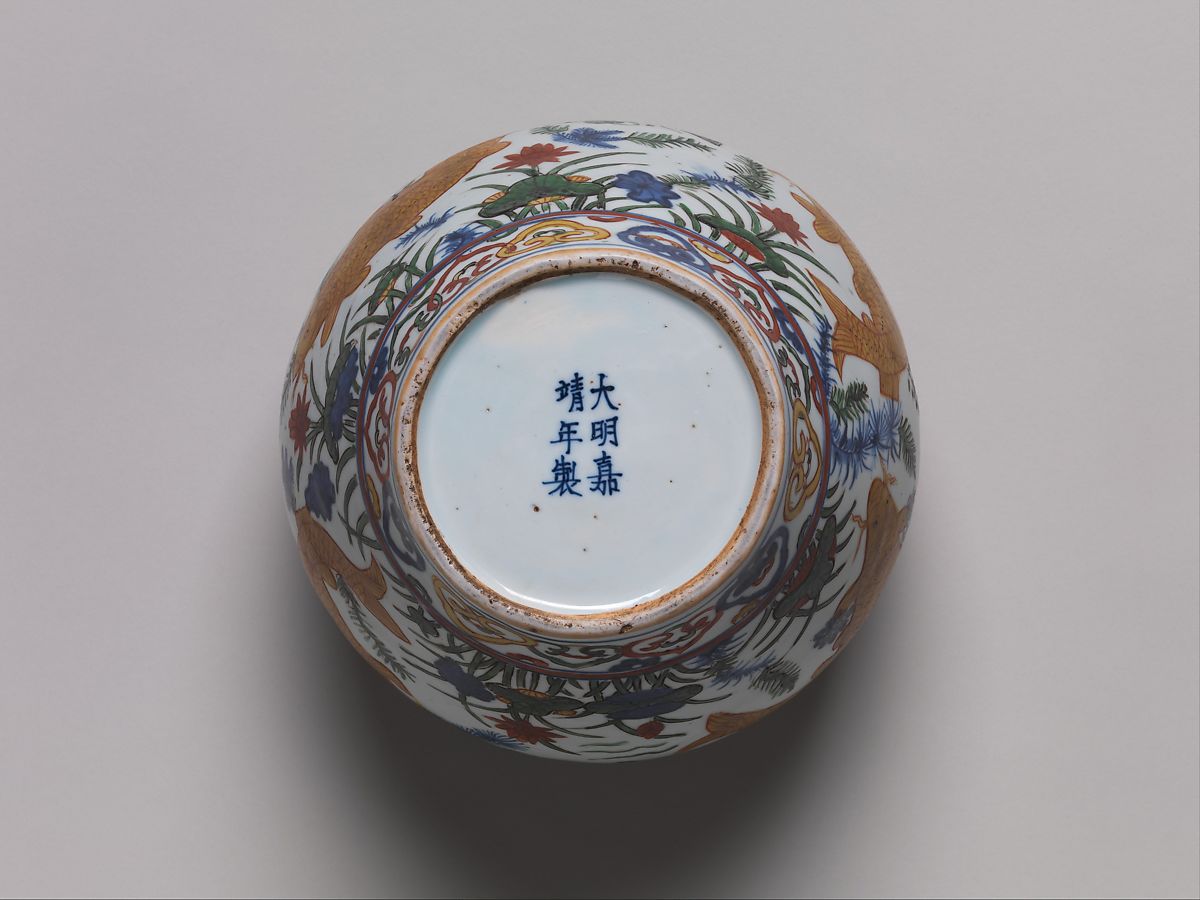
Jar with Carp in Lotus Pond, Porcelain painted with cobalt blue under and colored enamels over transparent glaze (Jingdezhen ware), mid-16th century
On view at The Met Fifth Avenue in Gallery 204
Jar with Carp in Lotus Pond, Porcelain painted with cobalt blue under and colored enamels over transparent glaze (Jingdezhen ware), China
Jar with Carp in Lotus Pond, Porcelain painted with cobalt blue under and colored enamels over transparent glaze (Jingdezhen ware), China
Object Details
Period:Ming dynasty (1368–1644), Jiajing mark and period (1522–66)
Date:mid-16th century
Culture:China
Medium:Porcelain painted with cobalt blue under and colored enamels over transparent glaze (Jingdezhen ware)
Dimensions:H. 9 1/8 in. (23.2 cm)
Classification:Ceramics
Credit Line:Rogers Fund, 1917
Accession Number:17.127.2
Signatures, Inscriptions, and Markings
Marking: Jiajing mark (six letters)
Provenance
[ Yamanaka & Co. , until 1917; sold to MMA]
Timeline of Art History
Essays
Ming Dynasty (1368-1644)
Timelines
Central and North Asia, 1400-1600 A.D.
China, 1400-1600 A.D.
MetPublications
How to Read Chinese Ceramics
A Handbook of Chinese Ceramics
參考:美國纽约大都會博物館 北宋 佛八宝 定窑碗 Bowl, Porcelaneous ware with reddish-brown glaze (“red” [“brown”] Ding ware), China
11th–12th century
China
![美國纽约大都會博物館 北宋定窑碗 Bowl, Porcelaneous ware with reddish-brown glaze ("red" ["brown"] Ding ware), China](http://www.antiquekeeper.ca/wp-content/uploads/2016/05/met-main-image-00103-2-116-1-1024x717.jpg)
![美國纽约大都會博物館 北宋定窑碗 Bowl, Porcelaneous ware with reddish-brown glaze ("red" ["brown"] Ding ware), China](http://www.antiquekeeper.ca/wp-content/uploads/2016/05/met-main-image-00103-2-116-1024x768.jpg)
Period:Northern Song dynasty (960–1127)
Date:11th–12th century
Culture:China
Medium:Porcelaneous ware with reddish-brown glaze (“red” [“brown”] Ding ware)
Dimensions:H. 4 3/4 in. (12.1 cm)
Classification:Ceramics
Credit Line:Rogers Fund, 1917
Accession Number:17.118.16a, b
Provenance
[ Unidentified dealer, Shanghai]
Timeline of Art History
Timelines
Central and North Asia, 1000-1400 A.D.
China, 1000-1400 A.D.
参考:纽约大都会博物馆 明 万历 五彩龙纹盖罐 Bowl with Cover, Porcelain, China
China
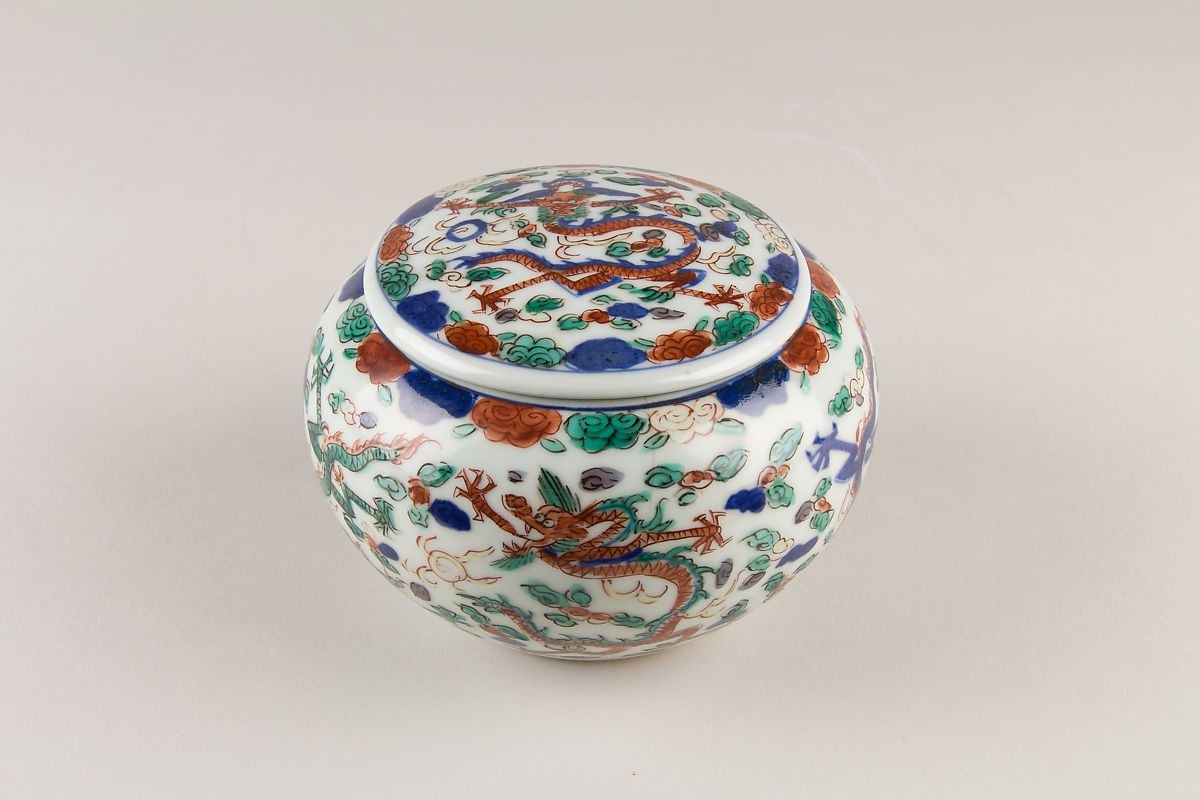
China, Ming dynasty (1368–1644), Wanli period (1573–1620)
Porcelain; H. (with cover) 3 3/4 in. (9.5 cm); Diam. 3 1/2 in. (8.9 cm)
The Metropolitan Museum of Art, New York, 纽约大都会博物馆 明 万历 五彩龙纹盖罐 Bowl with Cover, Porcelain, China
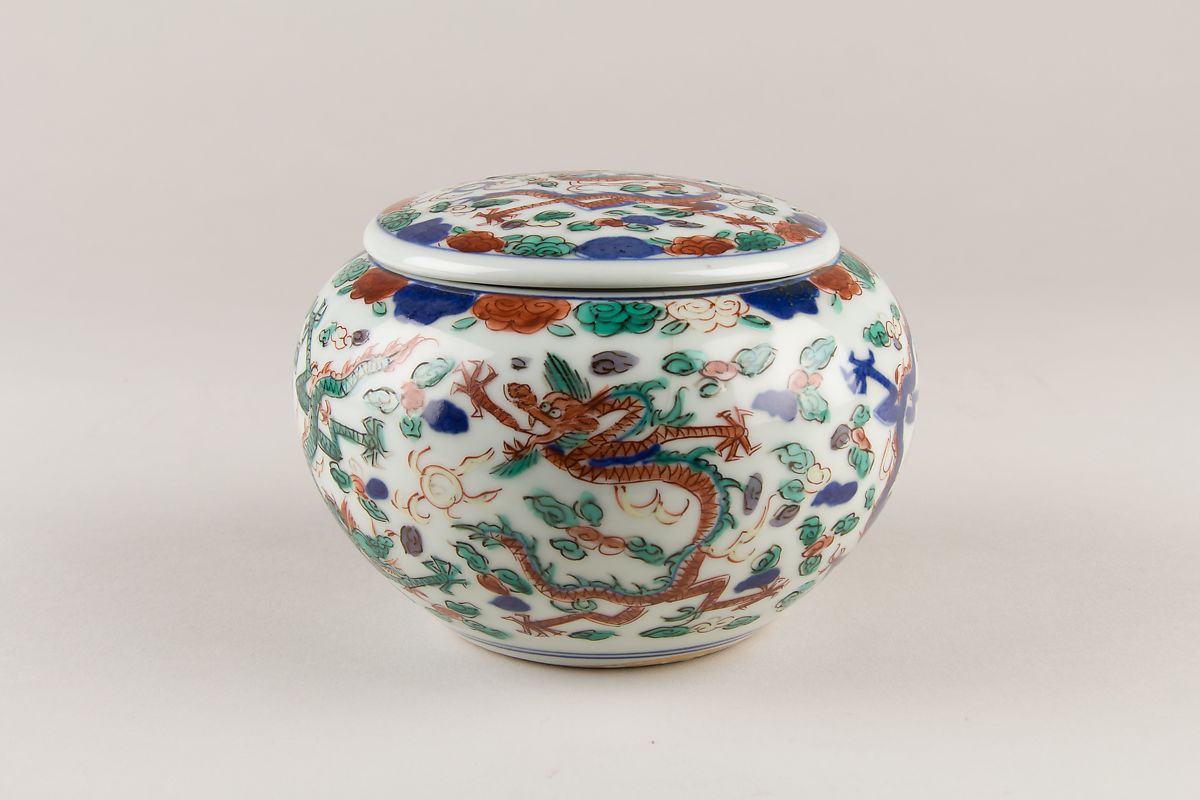
China, Ming dynasty (1368–1644), Wanli period (1573–1620)
Porcelain; H. (with cover) 3 3/4 in. (9.5 cm); Diam. 3 1/2 in. (8.9 cm)
The Metropolitan Museum of Art, New York, 纽约大都会博物馆 明 万历 五彩龙纹盖罐 Bowl with Cover, Porcelain, China
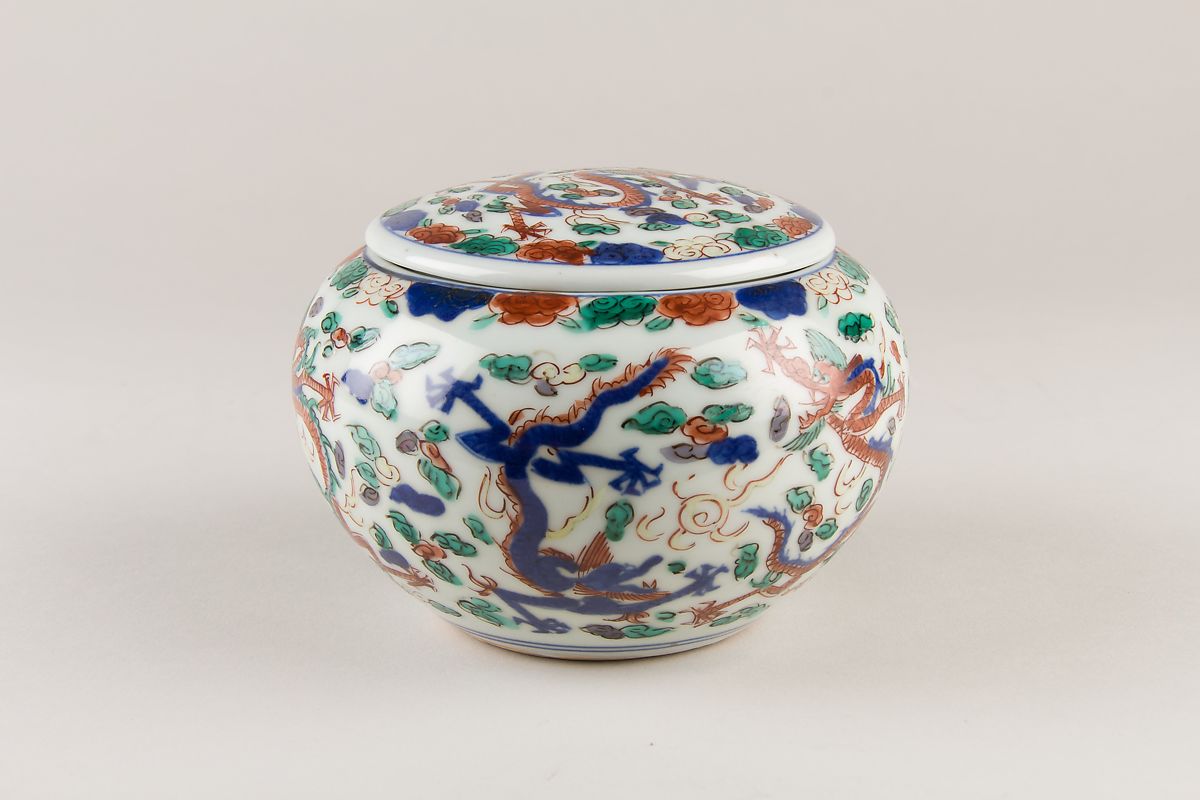
China, Ming dynasty (1368–1644), Wanli period (1573–1620)
Porcelain; H. (with cover) 3 3/4 in. (9.5 cm); Diam. 3 1/2 in. (8.9 cm)
The Metropolitan Museum of Art, New York, 纽约大都会博物馆 明 万历 五彩龙纹盖罐 Bowl with Cover, Porcelain, China
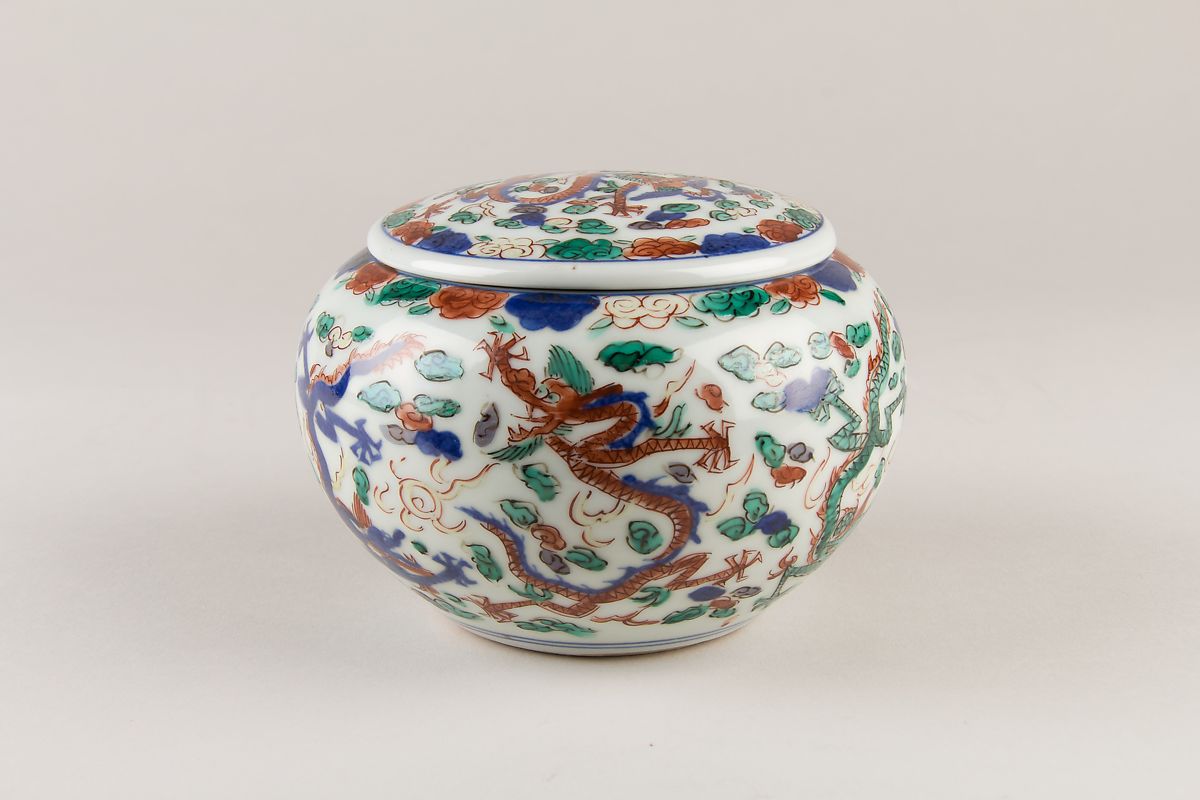
China, Ming dynasty (1368–1644), Wanli period (1573–1620)
Porcelain; H. (with cover) 3 3/4 in. (9.5 cm); Diam. 3 1/2 in. (8.9 cm)
The Metropolitan Museum of Art, New York, 纽约大都会博物馆 明 万历 五彩龙纹盖罐 Bowl with Cover, Porcelain, China
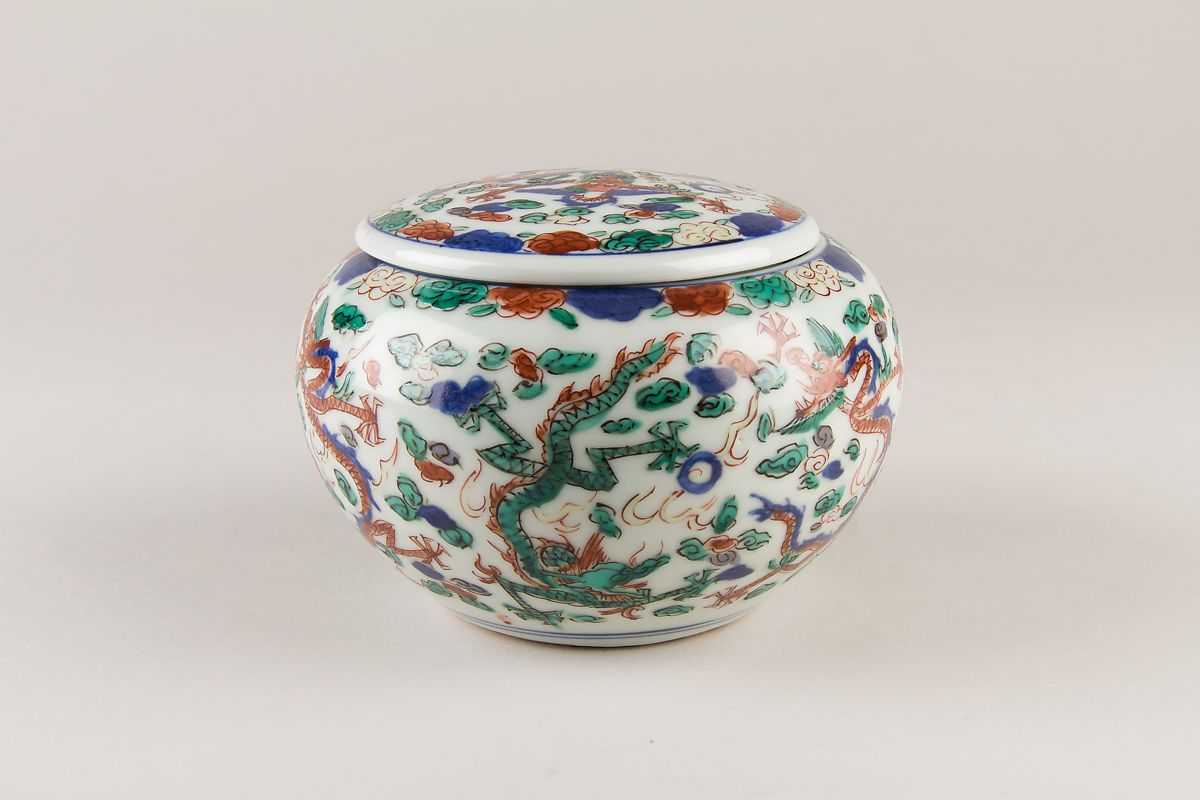
China, Ming dynasty (1368–1644), Wanli period (1573–1620)
Porcelain; H. (with cover) 3 3/4 in. (9.5 cm); Diam. 3 1/2 in. (8.9 cm)
The Metropolitan Museum of Art, New York, Bequest of Robert West, 1950 (50.221.9a, b)
http://www.metmuseum.org/Collections/search-the-collections/46747
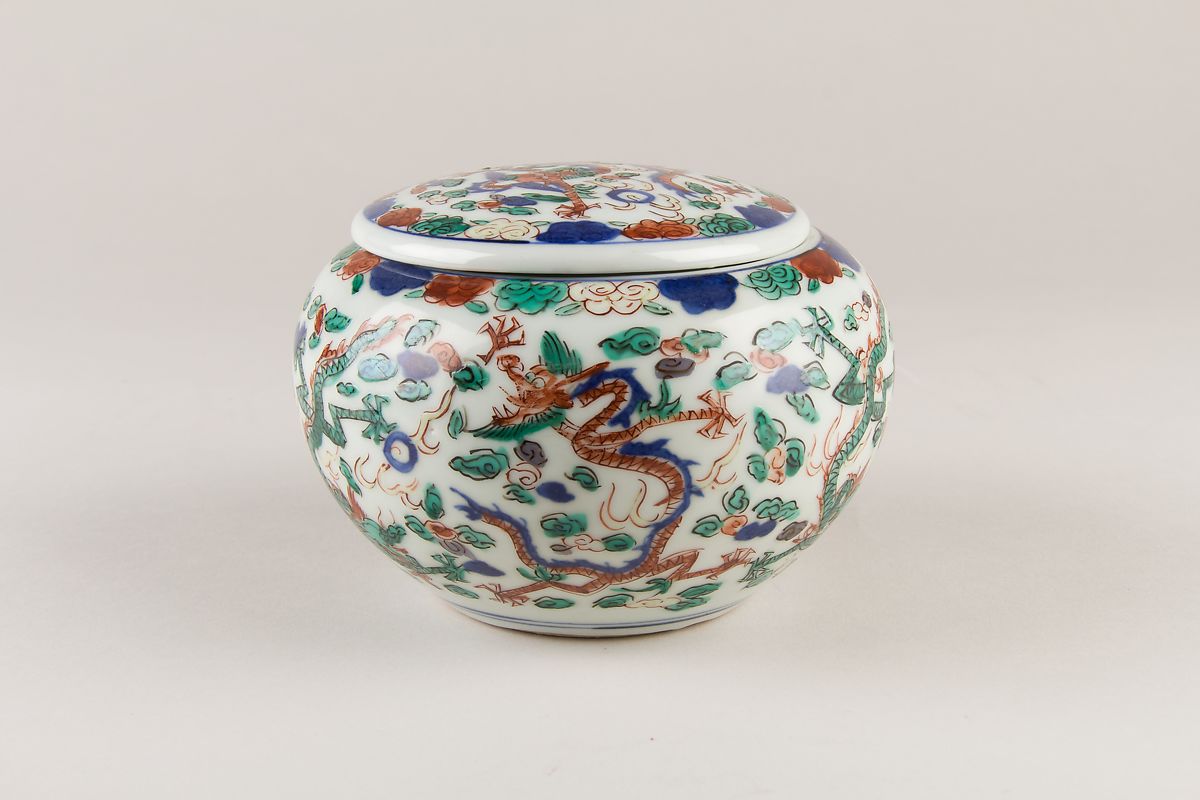
China, Ming dynasty (1368–1644), Wanli period (1573–1620)
Porcelain; H. (with cover) 3 3/4 in. (9.5 cm); Diam. 3 1/2 in. (8.9 cm)
The Metropolitan Museum of Art, New York, 纽约大都会博物馆 明 万历 五彩龙纹盖罐 Bowl with Cover, Porcelain, China
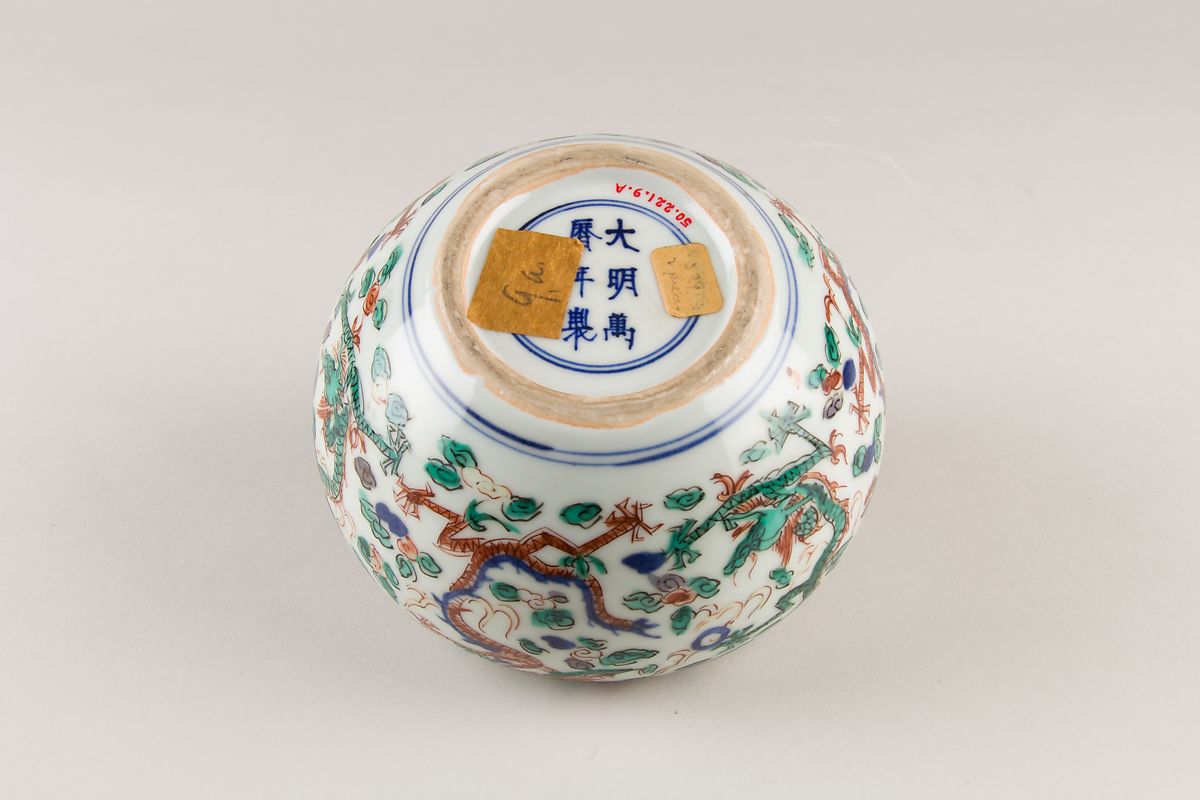
China, Ming dynasty (1368–1644), Wanli period (1573–1620)
Porcelain; H. (with cover) 3 3/4 in. (9.5 cm); Diam. 3 1/2 in. (8.9 cm)
The Metropolitan Museum of Art, New York, 纽约大都会博物馆 明 万历 五彩龙纹盖罐 Bowl with Cover, Porcelain, China
Object Details
Period:Ming dynasty (1368–1644), Wanli period (1573–1620)
Culture:China
Medium:Porcelain
Dimensions:H. (with cover) 3 3/4 in. (9.5 cm); Diam. 3 1/2 in. (8.9 cm)
Classification:Ceramics
Credit Line:Bequest of Robert West, 1950
Accession Number:50.221.9a, b
Signatures, Inscriptions, and Markings
Marking: Wanli mark (on bottom within double blue circle)
Provenance
Robert West , New York (until d. 1950; bequeathed to MMA)
Exhibition History
Durham. Nasher Museum of Art at Duke University. “Chinese, Japanese and Korean Ceramics,” March 15, 1986–May 5, 1986.
Timeline of Art History
Timelines
Central and North Asia, 1400-1600 A.D.
Central and North Asia, 1600-1800 A.D.
China, 1400-1600 A.D.
China, 1600-1800 A.D.
参考:纽约大都会博物馆 明晚 清初 琺瑯彩海馬紋酒壺 Covered ewer, Chinese , Qing Dynasty, later Transitional period, Porcelain painted in enamels on the biscuit., Chinese
ca. 1644–83
Chinese
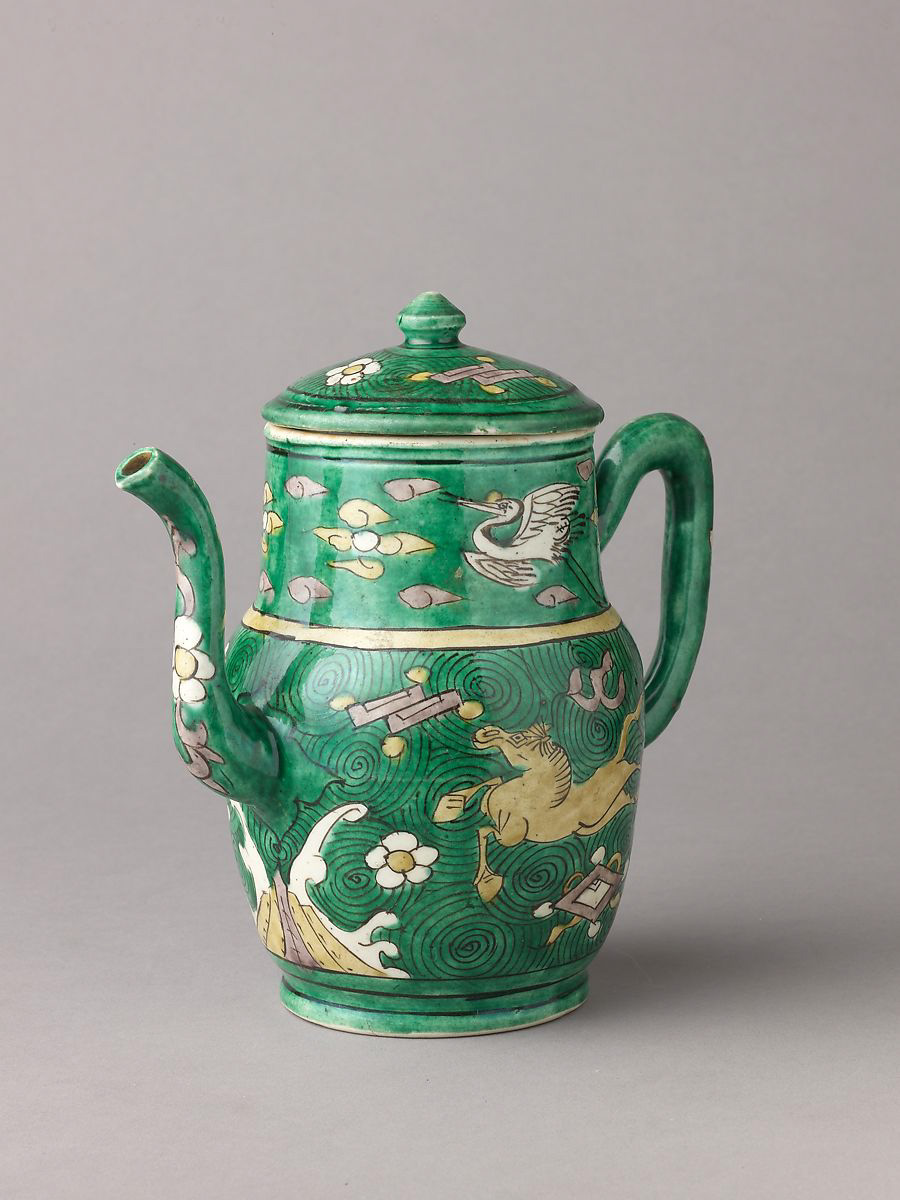
ca. 1644–83
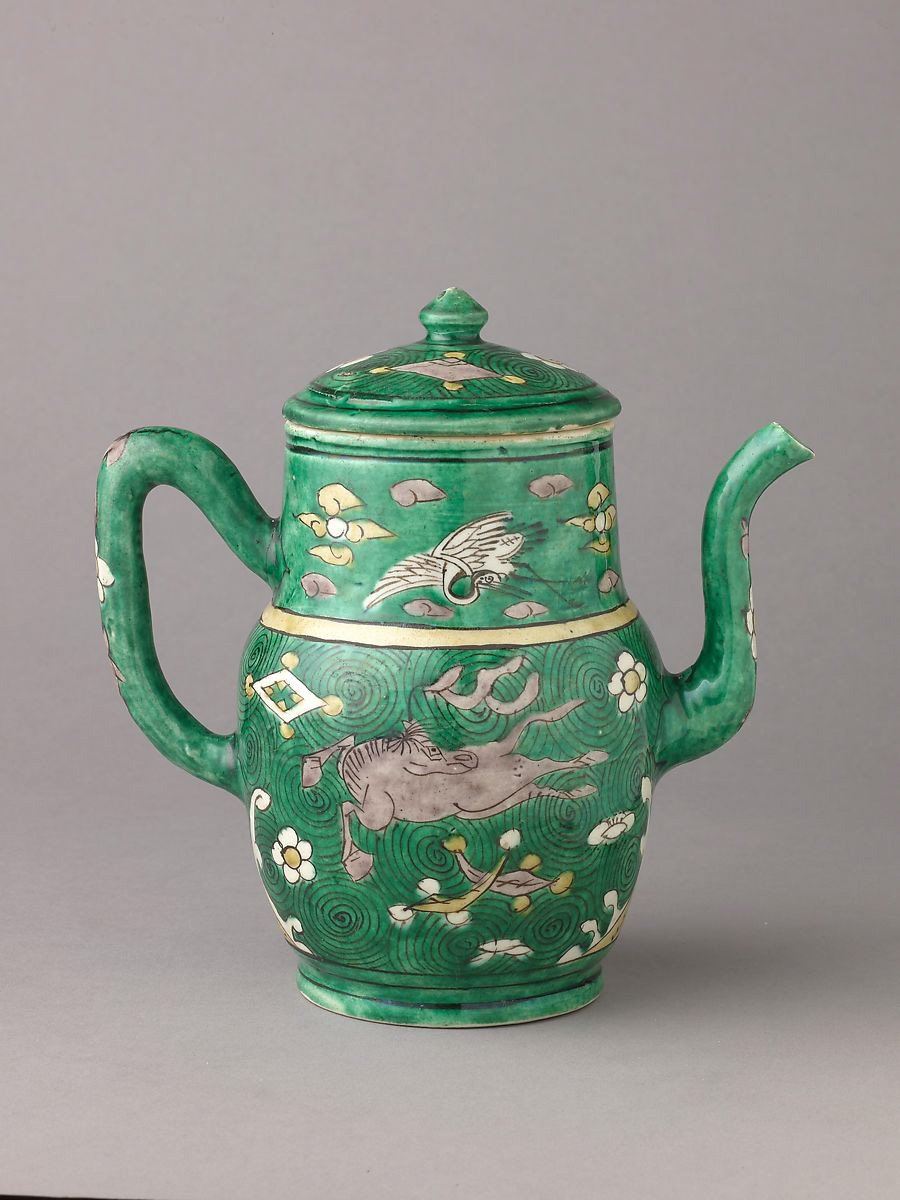
ca. 1644–83
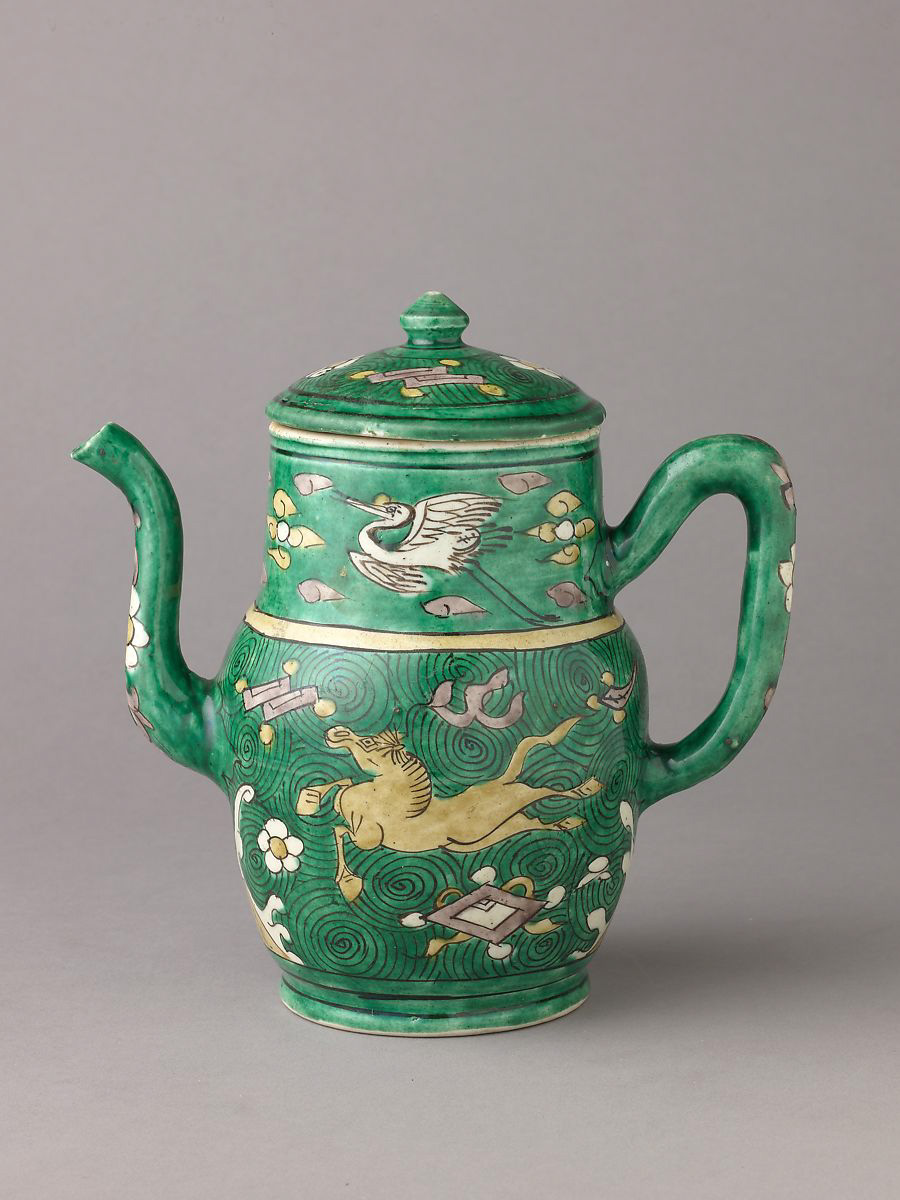
ca. 1644–83
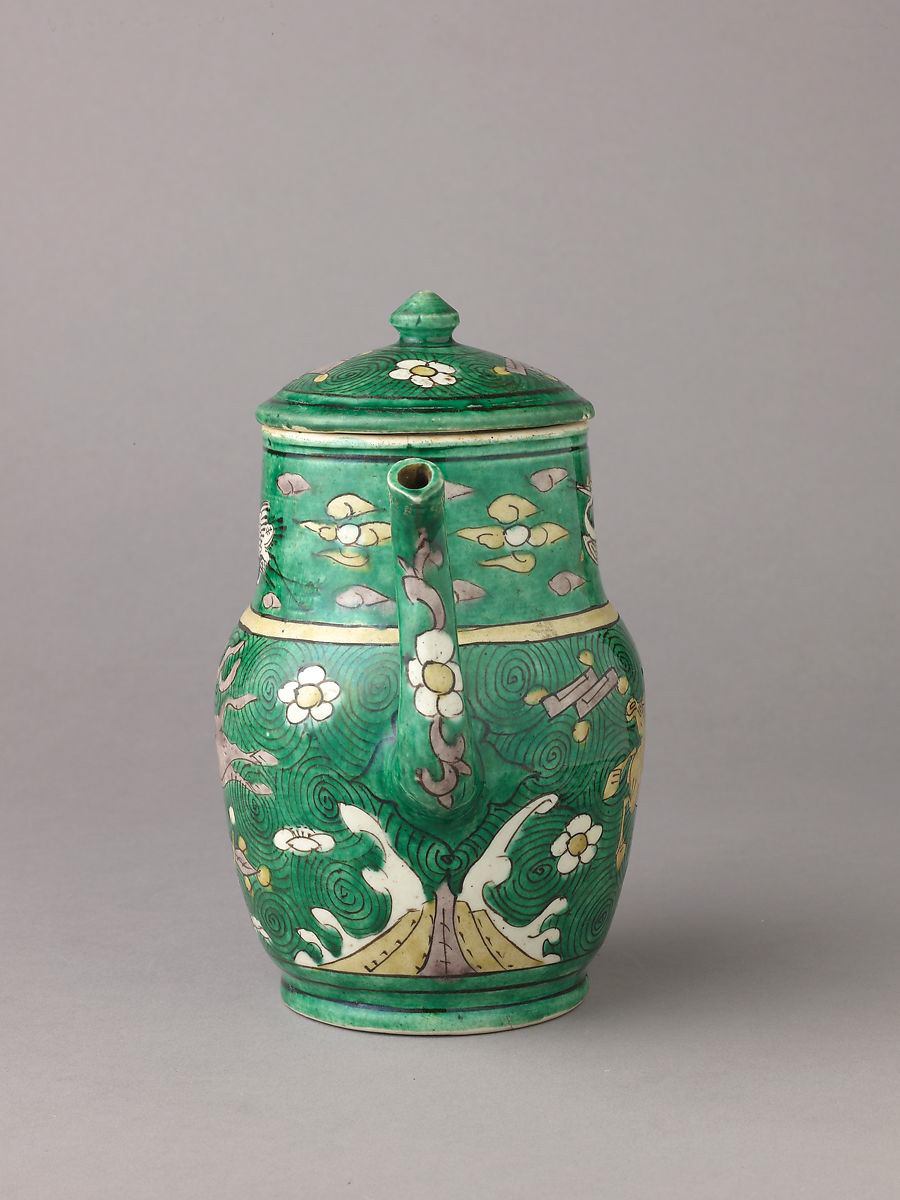
ca. 1644–83

China, Ming dynasty (1368–1644), Wanli period (1573–1620)
Porcelain; H. (with cover) 3 3/4 in. (9.5 cm); Diam. 3 1/2 in. (8.9 cm)
The Metropolitan Museum of Art, New York, 纽约大都会博物馆 明 万历 五彩龙纹盖罐 Bowl with Cover, Porcelain, China
Object Details
Artist:Chinese , Qing Dynasty, later Transitional period
Date:ca. 1644–83
Culture:Chinese
Medium:Porcelain painted in enamels on the biscuit.
Dimensions:Height with lid: 17.1 cm.
Classification:Ceramics
Credit Line:Robert Lehman Collection, 1975
Accession Number:1975.1.1693
Catalogue Entry
This well-made ewer could be used as a wine pot or a teapot. It has a barrel-shaped body; a very high, wide, distinct neck; a curved spout; an eared handle; and a domed lid. It has been decorated on the unglazed body, or biscuit, with bright green, pale aubergine, light mustard-yellow, and clear enamels filling in black-outlined designs. An ascending and descending crane in clouds is on either side of the tall neck. Each side of the body carries a haima (flying horse) soaring above spiral waves that are strewn with prunus flowers and stylized auspicious symbols. The symbols include the solid lozenge, pair of books, swastika lozenge, pair of horns, open lozenge with ribbons, and leaf. The handle and spout each carry a blossom; waves and rocks are painted on the body below them. The lid is decorated with two auspicious symbols and two flowers against waves. The flat base is covered with a thin, rather shiny, translucent glaze that shows a few of the “snail-tracks” seen on some glazes of this period. The foot is deep and slightly spreading; the unglazed foot rim exhibits a fine-textured white body. The vessel is unglazed inside. This ewer is quite unusual. The shape is very similar to that of a pair of covered porcelain pouring vessels at Burghley House, Stamford, England.(1) These pots, decorated in underglaze blue and iron brown on a crackled gray ground, were included in a 1690 inventory, the Devonshire Schedule, where they are described as “A pair of sillabub Potts.” Several blue-and-white porcelain covered wine pots were among the salvaged cargo of the “Hatcher Junk” that sank in the South China Sea, probably between 1643 and 1646. Although their necks are shorter than those on the Lehman and Burghley House works, their shape is akin to the Lehman pot.(2) The decoration on this ewer is easier to localize. The crane can be found in fourteenth-century Chinese blue-and-white porcelains, and it was an especially popular decorative motif during the middle and late sixteenth century. The design on the lower portion of the vessel is relatable to several pieces. Six blue-and-white porcelain dishes with the unusual decoration of a sea serpent reserved in white against a flower-strewn, spiralwave background were in the “Hatcher Junk” mentioned above. These dishes carried the apocryphal reign-mark of the Ming-dynasty Jiajing emperor (1522 – 66).(3) A blue-and-white dish with essentially the same decoration, dated in accordance with 1644 – 45, is in the Percival David Foundation of Chinese Art, London.(4) Six blue-and-white porcelain dishes showing a haima (flying horse) against the same flower-strewn, spiral-wave background were also in the “Hatcher Junk” sale. These pieces carried the apocryphal reign-mark of the Mingdynasty Xuande emperor (1426 – 35).(5) Mid- to late seventeenth-century and eighteenth-century Chinese porcelains decorated with enamels on the biscuit — as in the Lehman ewer — frequently show prunus flowers and auspicious objects against a spiralwave background. Haima, sometimes associated with other fabulous beasts, are often found soaring above the waves as well. Generally this type of decoration is seen on bowls and small serving pieces, some of which carry apocryphal Ming-dynasty reign-marks or correct reignmarks of the Qing-dynasty Kangxi period. However, it is also found on other vessels, such as covered pots with short necks, wide-mouthed jars, high-shouldered covered jars, and tall cylindrical ewers that are based on a Tibetan shape.(6)
Catalogue entry from Suzanne G. Valenstein. The Robert Collection. Decorative Arts, Volume XV. Wolfram Koeppe, et al. The Metropolitan Museum of Art in association with Princeton University Press, 2012, pp. 328-329.
NOTES:
1. The Wrestling Boys: An Exhibition of Chinese and Japanese Ceramics from the Sixteenth to the Eighteenth Century in the Collection at Burghley House. Exhibition, Burghley House, 1983. Catalogue by Gordon Lang. Stamford, Lincolnshire, England, 1983, no. 169.
2. Christie’s, Amsterdam, 14 March 1984, lot 67, pl. p. 9; Sheaf, Colin, and Richard S. Kilburn. The Hatcher Porcelain Cargoes: The Complete Record. Oxford, 1988, pls. 89, 90.
3. Sheaf and Kilburn, p. 27, pl. 95.
4. Ibid., p. 27, pl. 14.
5. Christie’s, Amsterdam, 14 March 1984, lot 342, pl. p. 56; Sheaf and Kilburn, pl. 94.
6. For a work in the Tibetan “monk’s cap – jug shape,” see Metropolitan Museum, 61.200.7.
Provenance
[Ton-Ying & Company]; Ton-Ying sale, American Art Association, Anderson Galleries, New York, 24-25 January 1930, lot 354, ill. Acquired by Robert Lehman from the Ton-Ying sale.
Timeline of Art History
Timelines
Central and North Asia, 1600-1800 A.D.
China, 1600-1800 A.D.
MetPublications
The Robert Lehman Collection, Volume XV: European and Asian Decorative Arts
A Handbook of Chinese Ceramics
参考:纽约大都会博物馆 明 緙絲 天馬神獸圖 Square with Fantastic Animal
China
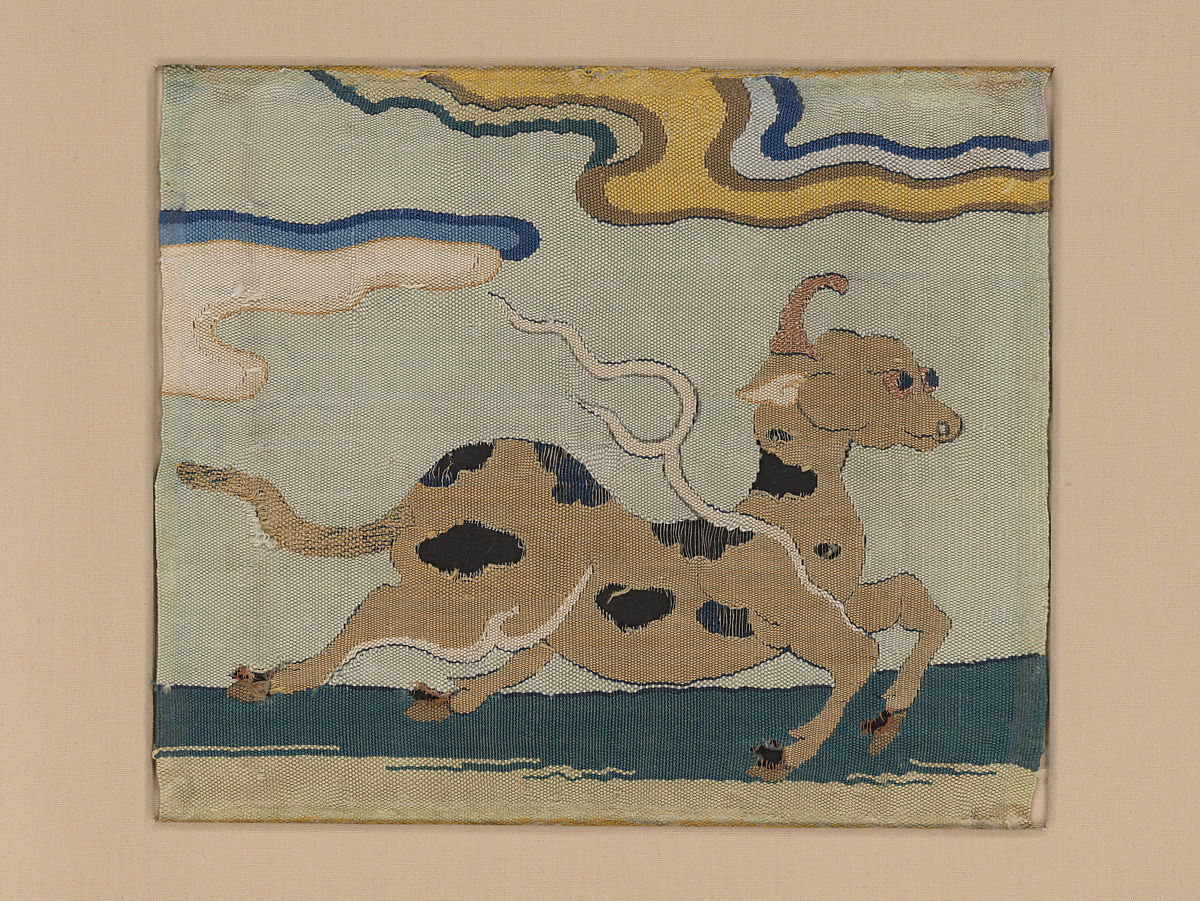
Gold thread accentuates the eyes and single curved horn of this spotted deerlike animal, and the flamelike emanations coming off its body announce its supernatural status. It runs through an abstracted landscape with clouds overhead and a low groundline.
Object Details
Period:Ming dynasty (1368–1644)
Culture:China
Medium:Silk and metallic thread tapestry (kesi)
Dimensions:Overall: 6 x 6 1/2 in. (15.2 x 16.5 cm)
Classification:Textiles-Tapestries
Credit Line:Rogers Fund, 1932
Accession Number:32.111.2
Provenance
[ Roland Koscherak , New York, until 1932; sold to MMA]
Exhibition History
New York. China House Gallery. “Kesi and Silk Tapestry,” March 24, 1971–May 27, 1971.
New York. The Metropolitan Museum of Art. “Chinese Textiles of the Yuan and Ming Dynasties,” April 1, 2005–July 25, 2005.
Timeline of Art History
Timelines
Central and North Asia, 1000-1400 A.D.
Central and North Asia, 1600-1800 A.D.
China, 1000-1400 A.D.
China, 1600-1800 A.D.
参考:纽约大都会博物馆 明 萬曆 五彩 海水江崖雲龍紋 桶罐 Barrel-Shaped Jar
China
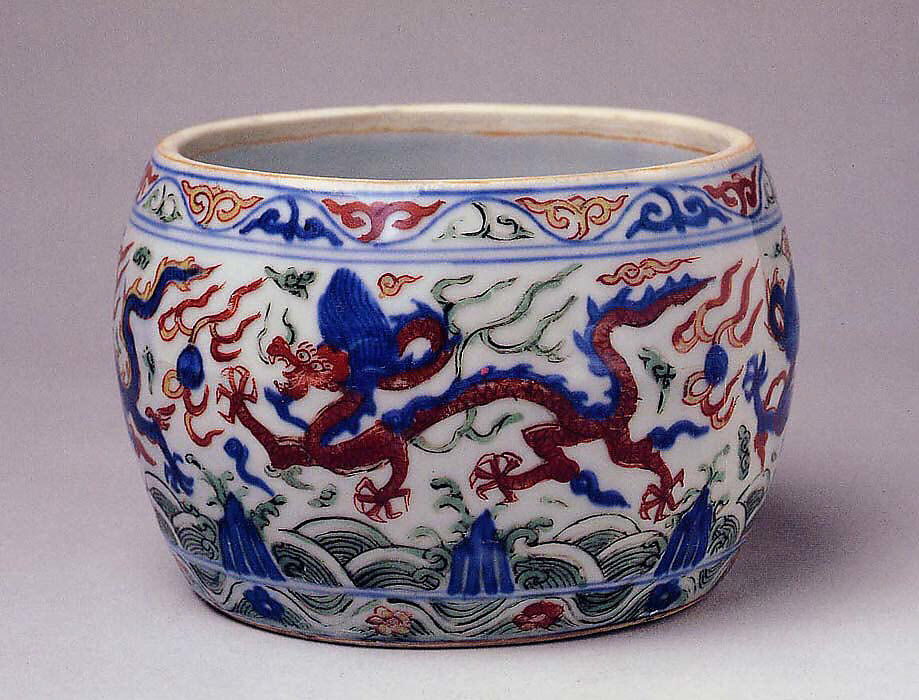
Object Details
Period:Ming dynasty (1368–1644), Wanli mark and period (1573–1620)
Culture:China
Medium:Porcelain painted in underglaze blue and overglaze polychrome enamels
Dimensions:Diam. of rim: 5 3/8 in. (13.7 cm)
Classification:Ceramics
Credit Line:Gift of Stanley Herzman, in memory of Adele Herzman, 1991
Accession Number:1991.253.55
Signatures, Inscriptions, and Markings
Marking: Wanli mark
Provenance
Stanley Herzman , New York (until 1991; donated to MMA)
Exhibition History
New York. The Metropolitan Museum of Art. “A Selection of Chinese Ceramics from the Adele and Stanley Herzman Collection,” June 1, 1990–August 26, 1990.
Timeline of Art History
Timelines
Central and North Asia, 1400-1600 A.D.
Central and North Asia, 1600-1800 A.D.
China, 1400-1600 A.D.
China, 1600-1800 A.D.
参考:纽约大都会博物馆 大明嘉靖年制 釉裡紅天馬罐 Jar Jiajing mark and period (1522–66)
China
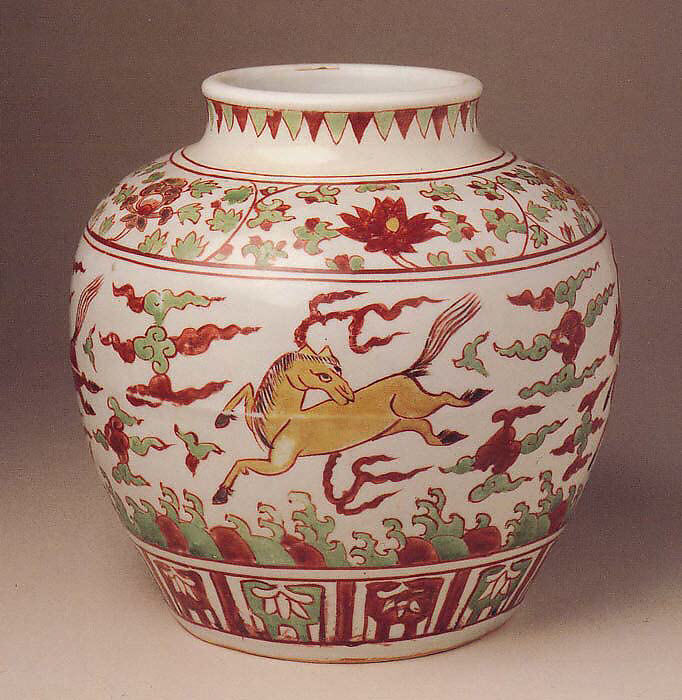
Object Details
Period:Ming dynasty (1368–1644), Jiajing mark and period (1522–66)
Culture:China
Medium:Porcelain painted in overglaze polychrome enamels
Dimensions:H. 7 1/4 in. (18.4 cm)
Classification:Ceramics
Credit Line:Gift of Stanley Herzman, in memory of Adele Herzman, 1991
Accession Number:1991.253.58
Signatures, Inscriptions, and Markings
Marking: Jiajing mark
Provenance
Stanley Herzman , New York (until 1991; donated to MMA)
Exhibition History
New York. The Metropolitan Museum of Art. “A Selection of Chinese Ceramics from the Adele and Stanley Herzman Collection,” June 1, 1990–August 26, 1990.
Timeline of Art History
Timelines
Central and North Asia, 1400-1600 A.D.
China, 1400-1600 A.D.
参考:纽约大都会博物馆 明万历 五彩龙凤纹盘 Dish with Dragon and Phoenix
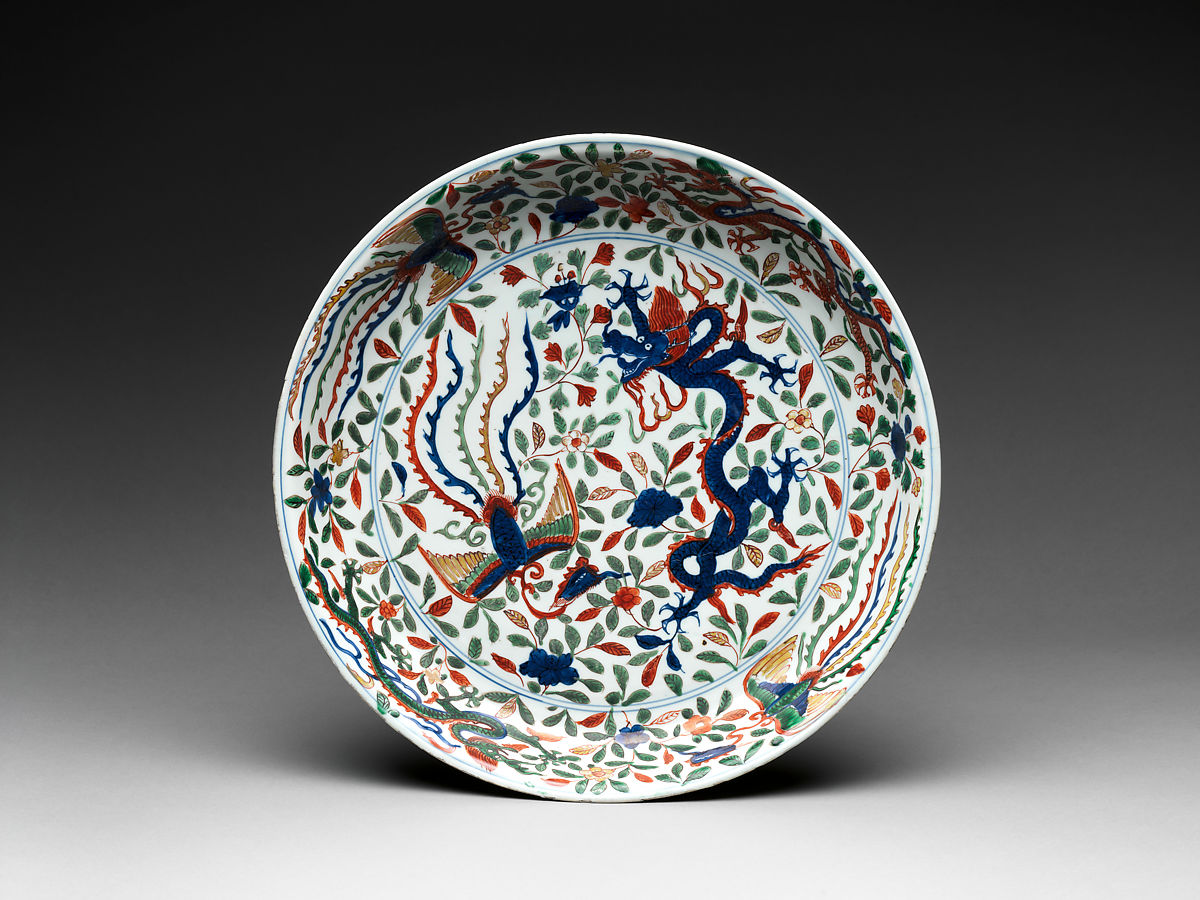
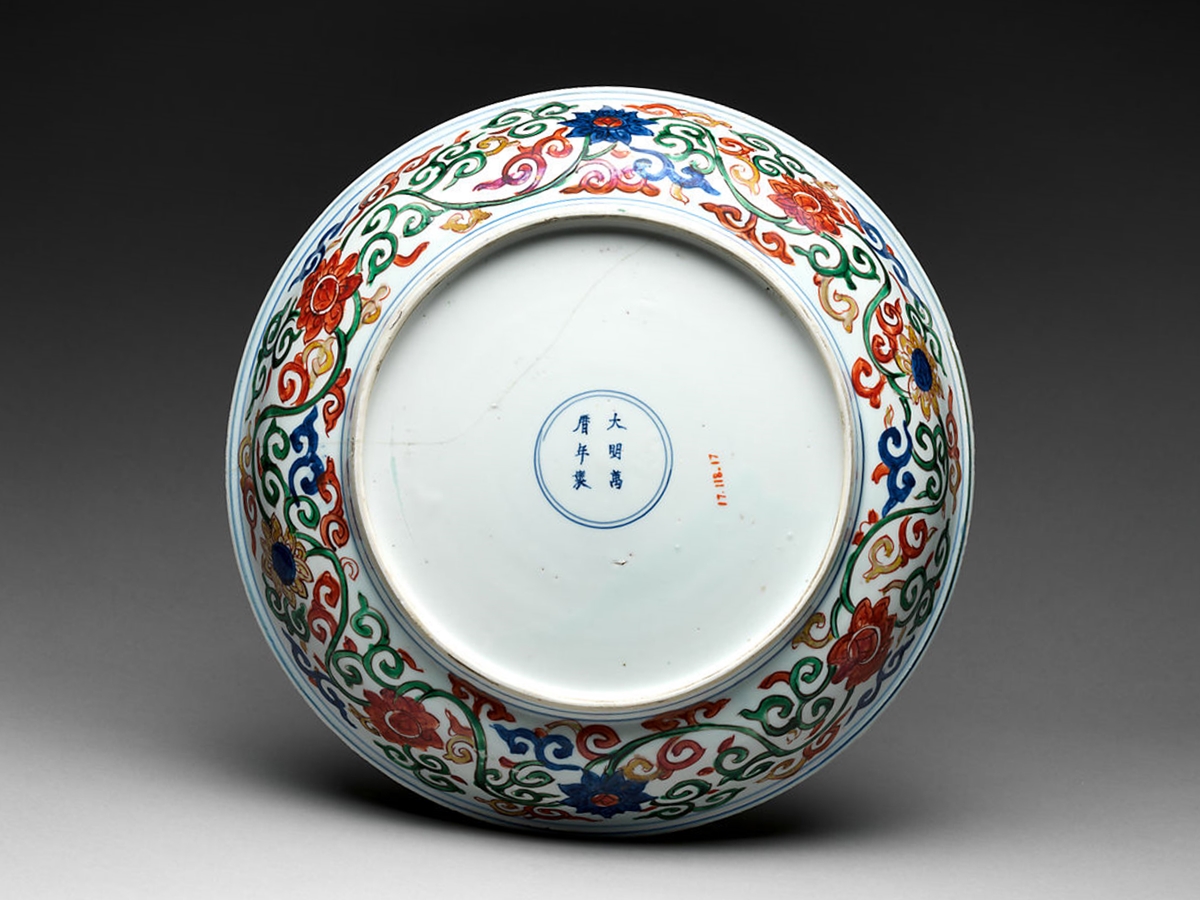
late 16th–early 17th century
China
The five-clawed dragon, a symbol of the emperor, is paired here with the phoenix, often associated with the empress.
On view at The Met Fifth Avenue in Gallery 204
Dish with Dragon and Phoenix, Porcelain painted with cobalt blue under and colored enamels over transparent glaze (Jingdezhen ware), China
Object Details
Period:Ming dynasty (1368–1644), Wanli mark and period (1573–1620)
Date:late 16th–early 17th century
Culture:China
Medium:Porcelain painted with cobalt blue under and colored enamels over transparent glaze (Jingdezhen ware)
Dimensions:H. 2 3/4 in. (7 cm); Diam. 14 3/4 in. (37.5 cm0; Diam. of rim 14 7/8 in. (37.8 cm); Diam. of foot 9 5/8 in. (24.4 cm)
Classification:Ceramics
Credit Line:Rogers Fund, 1917
Accession Number:17.118.17
Signatures, Inscriptions, and Markings
Marking: Wanli mark (six letters)
Provenance
[ Unidentified dealer, Shanghai]
Exhibition History
New York. The Metropolitan Museum of Art. “Arts of the Ming Dynasty: China’s Age of Brilliance,” January 23, 2009–September 13, 2009.
Timeline of Art History
Timelines
Central and North Asia, 1400-1600 A.D.
Central and North Asia, 1600-1800 A.D.
China, 1400-1600 A.D.
China, 1600-1800 A.D.
参考:LOT 8006
A HIGHLY IMPORTANT AND EXTREMELY RARE WUCAI ‘FISH’ JAR AND COVER
JIAJING SIX-CHARACTER MARK IN UNDERGLAZE BLUE AND OF THE PERIOD (1522-1566)
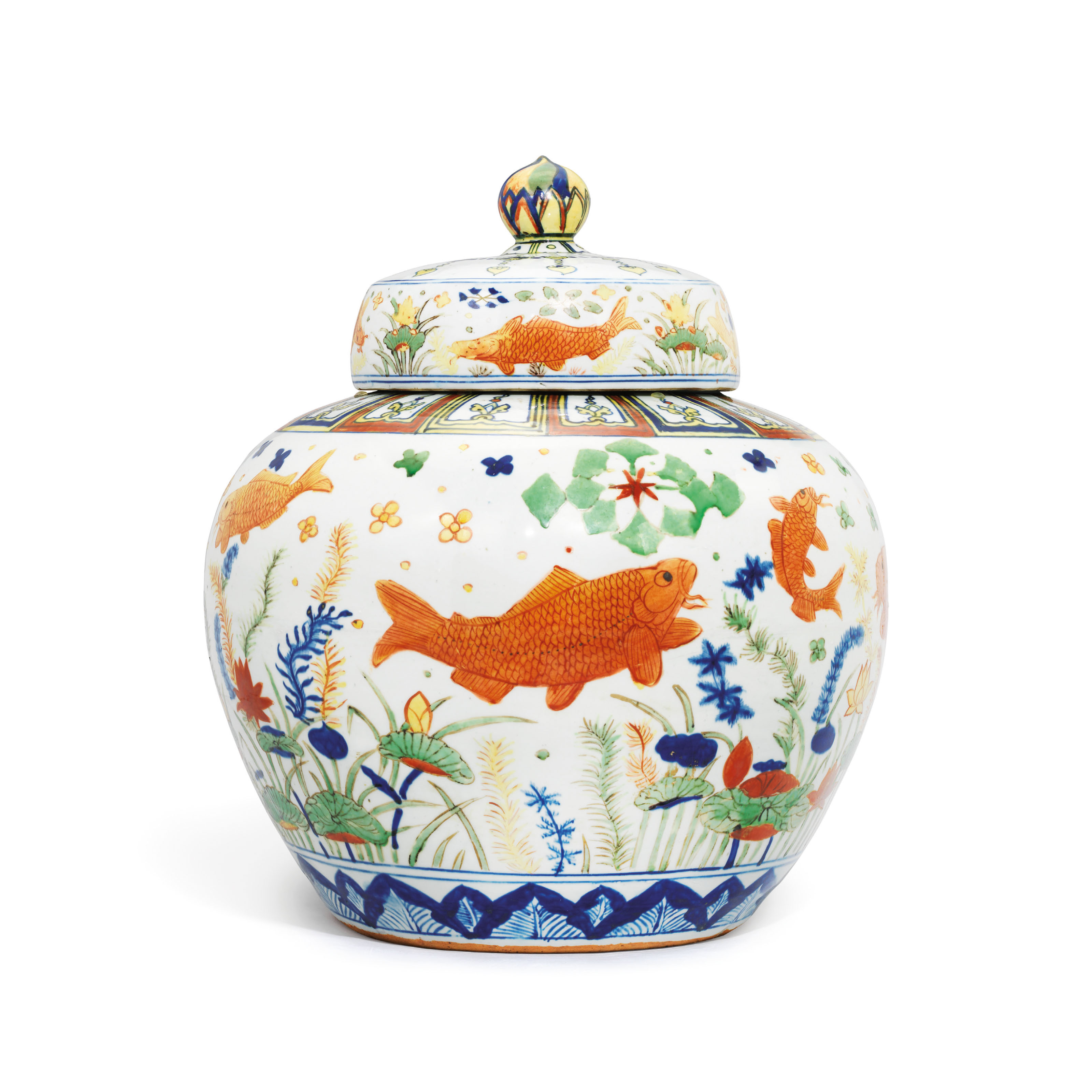
JIAJING SIX-CHARACTER MARK IN UNDERGLAZE BLUE AND OF THE PERIOD (1522-1566)
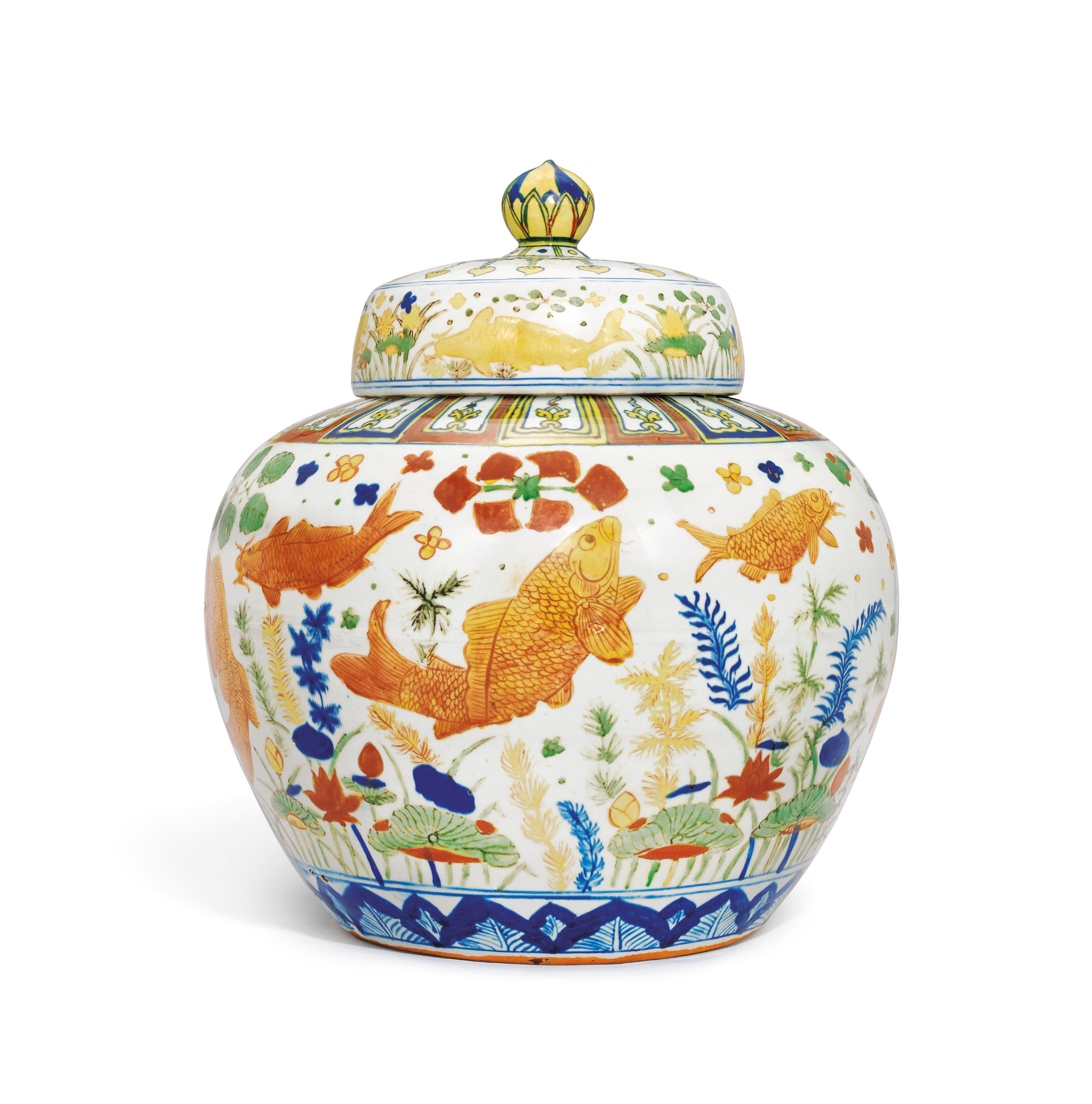
JIAJING SIX-CHARACTER MARK IN UNDERGLAZE BLUE AND OF THE PERIOD (1522-1566)
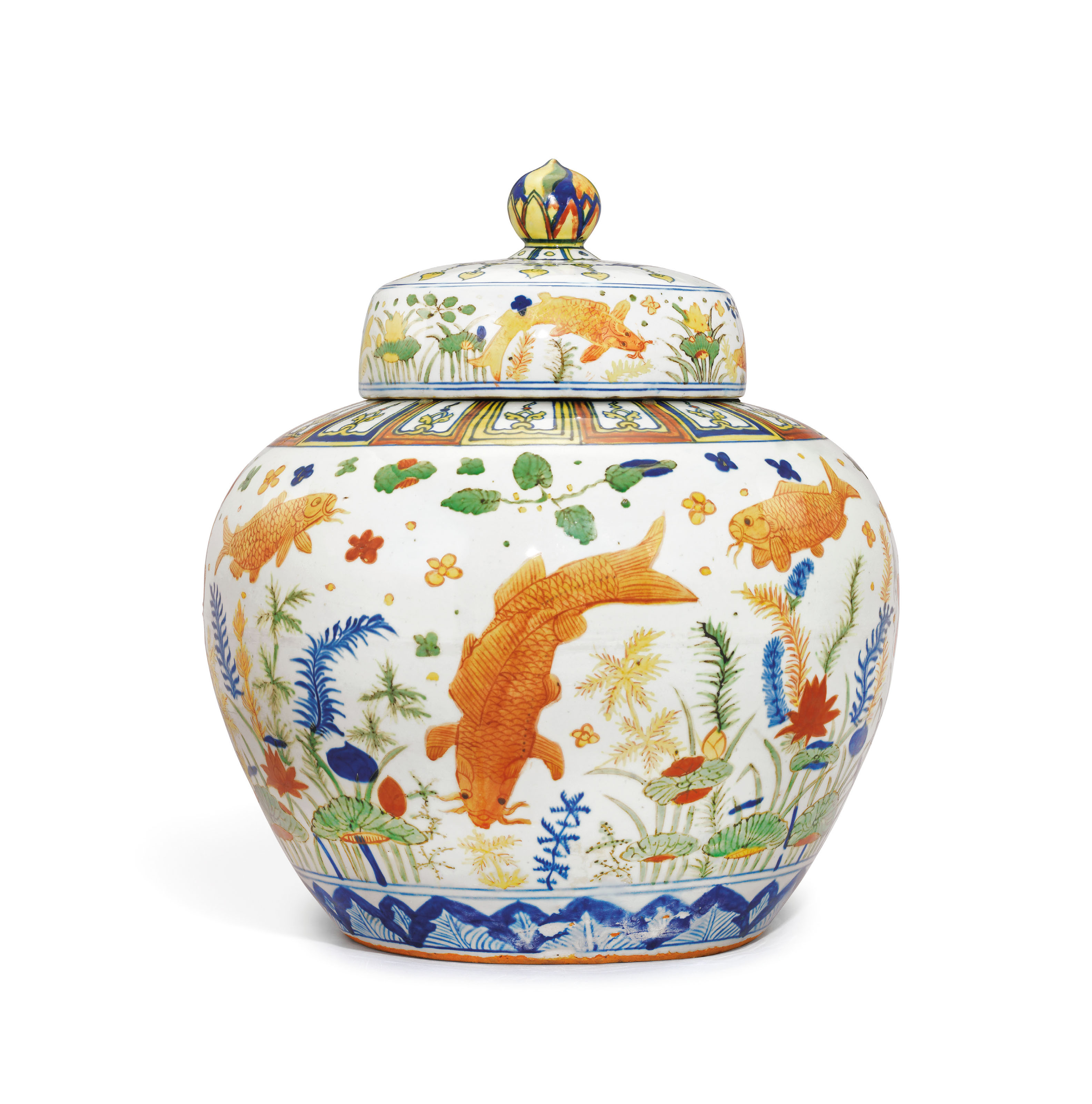
JIAJING SIX-CHARACTER MARK IN UNDERGLAZE BLUE AND OF THE PERIOD (1522-1566)
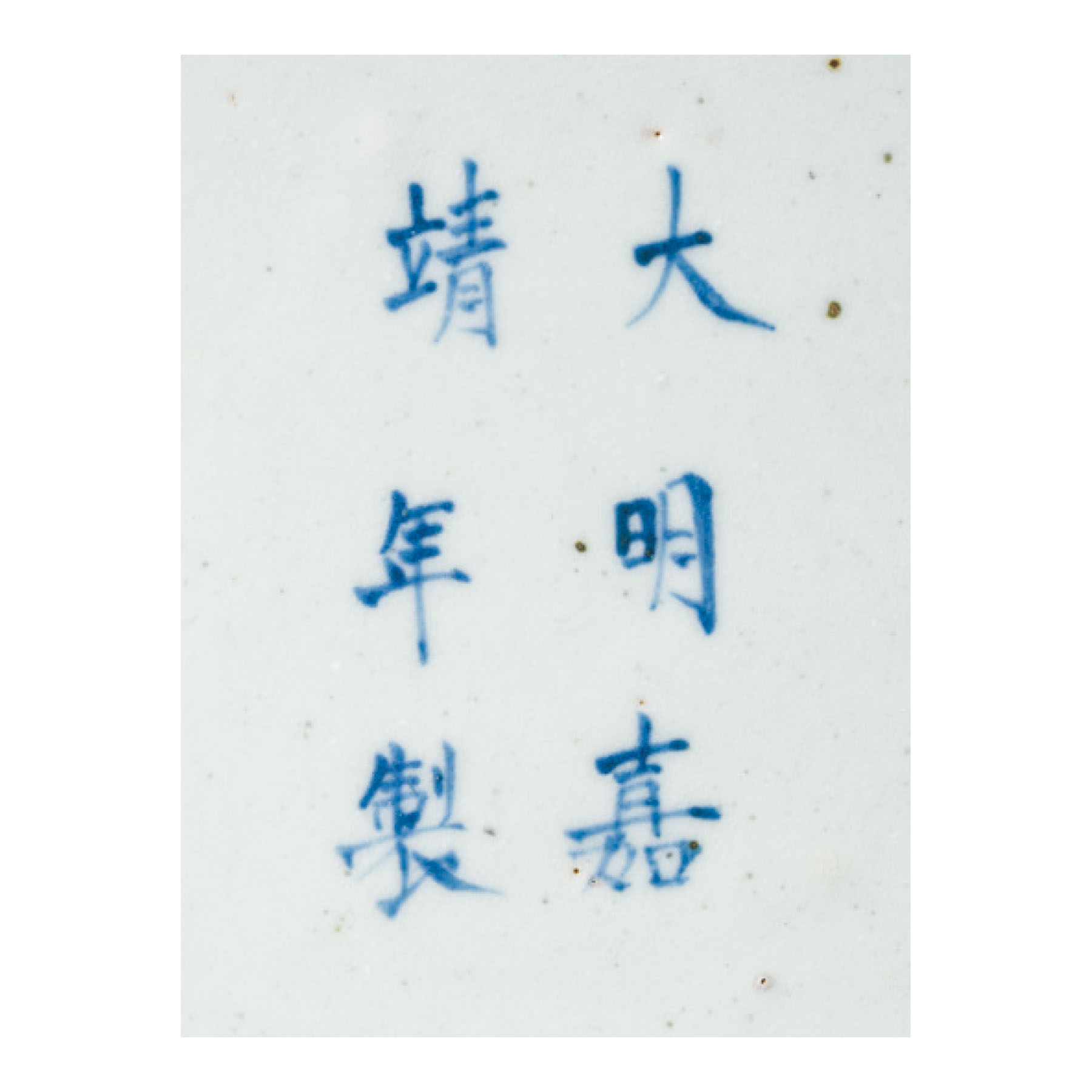
JIAJING SIX-CHARACTER MARK IN UNDERGLAZE BLUE AND OF THE PERIOD (1522-1566)
Price realised
HKD 213,850,000
A HIGHLY IMPORTANT AND EXTREMELY RARE WUCAI ‘FISH’ JAR AND COVER
JIAJING SIX-CHARACTER MARK IN UNDERGLAZE BLUE AND OF THE PERIOD (1522-1566)
The globular jar is robustly potted and exuberantly painted around the sides with a continuous scene of eight golden carp depicted in different positions as they swim amidst floating aquatic plants above a band of lotus plants in shades of green and yellow and further water weeds in underglaze blue. The carp are set between a band of overlapping leaf tips in underglaze blue below and a band of petals lappets in yellow, iron-red and blue with blue outlines at the shoulder. The jar is completed with the original cover finely painted on the sides with lotuses dividing two pairs of golden carp, surmounted by a bud-finial decorated with swirling colours of green, red, yellow and blue, above radiating beaded tassels interlinked with various Daoist emblems.
18 1/8 in. (46 cm.), brocade box
Provenance
J.M. Hu Family Collection
Sold at Sotheby’s New York, 1 December 1992, lot 282 (sold for US$2,860,000)
Sold at Sotheby’s Hong Kong, An Extraordinary Collection of Ming and Qing Imperial Porcelain and Works of Art from a Private Trust, 29 October 2000, lot 18 (sold for HK$44,044,750, then world record price for a Chinese porcelain)
View Special Publication: A dazzling gem of the Eastern Renaissance The Jiajing wucai Fish Jar
Literature
Helen D. Ling and Edward. T. Chow, Collection of Chinese Ceramics from the Pavilion of Ephemeral Attainment, vol. I, 1950, pl. 55
Sotheby’s Thirty Years in Hong Kong, Hong Kong, 2003, p. 178, no. 175
Literature and exhibited
Literature
Helen D. Ling and Edward. T. Chow, Collection of Chinese Ceramics from the Pavilion of Ephemeral Attainment, vol. I, 1950, pl. 55
Sotheby’s Thirty Years in Hong Kong, Hong Kong, 2003, p. 178, no. 175
Lot Essay
Aside from the present piece, only three other Jiajing fish jars complete with a cover appear to have been sold at auction. The first is the companion piece to the current jar, also from the J.M. Hu Collection and sold at Sotheby’s New York, 4 June 1985, lot 12. The other was formerly in the collection of the Walters Art Museum, Baltimore, later sold at Sotheby’s New York, 11 September 2012, lot 262. The third was sold at Sotheby’s London, 24 March 1953, lot 76, and passed through various hands including Rutherford Alcock, Sir Trevor Lawrence, Mrs. Alfred Clark, and later John D. Rockefeller 3rd, now at the Asia Society, New York and illustrated in Denise Patry Leidy, Treasures of Asian Art, New York, 1994, pp. 194-5, col. pl. 193.
At least four examples with covers are preserved in major museum collections in China, including two in the collection of the Palace Museum, one of which is illustrated in Porcelains in Polychrome and Contrasting Colors, The Complete Treasures of the Palace Museum, vol. 38, Hong Kong, 1999, p. 16, no. 15; one excavated in Beijing in 1955 and now in the National Museum of China, illustrated in Zhonggguo wenwu jinghua dacidian, Shanghai, 1996, no. 772; and one in the Tianjin Museum, illustrated in Porcelain from the Tianjin Municipal Museum, Hong Kong, 1993, p. 198, pl. 116.
Other covered jar examples are in major museum collections around the world. One is from the Asian Art Museum of San Francisco, illustrated in Gems of Chinese Art from the Asian Art Museum of San Francisco, Hong Kong Museum of Art, 1983, no. 33. Y. Mino and J. Robinson illustrated another one in Beauty and Tranquillity: The Ely Lilly Collection of Chinese Art, Indianapolis Museum of Art, 1983, pp. 252-3, pl. 100. Another example from the Walters Art Gallery, Baltimore is published in Ming Porcelains, China Institute in America, New York, 1970, no. 42. The example in the Musee Guimet is illustrated by D. Lion-Goldschmidt in Oriental Ceramics, The World’s Great Collections, vol. 7, 1981, pl. 151 and colour pl. 22. One in the S.E. Kennedy Collection is illustrated in R.L. Hobson, Chinese Pottery and Porcelain, London, 1915, vol. II, pl. 69. One is illustrated in Mayuyama Seventy Years, vol. I, Tokyo, 1976, pl. 823.
Other Jiajing jars without a cover include one which was excavated in 1967 in Hepingli, Chaoyangqu, Beijing, published in Wenwu, 1972: 6, p. 64, and inside back cover; one in the collection of the Shanghai Museum, illustrated by Liu Liang-yu in Ming Official Wares, Survey of Chinese Ceramics, Vol. 4, Taipei, 1991, p. 212, lower left image; and one acquired from Mayuyama Ryusendo, Tokyo, exhibited at Tokyo National Museum around 1970 and Museum of Modern Art, Kamakura from around 1970 to 1980, later sold at Christie’s Hong Kong, 30 May 2012, lot 4063.
Pre-Lot Text
Abundant Wealth and Perfect Happiness
A Magnificent Jiajing Wucai Fish Jar
Rosemary Scott, Senior International Academic Consultant Asian Art
The massive wucai jar in the current sale represents one of the pinnacles of Ming imperial porcelain achievement, and one of the treasures consistently sought by connoisseurs and collectors over the centuries. Large, colourful, and auspiciously decorated vessels such as this would have been prominently displayed in imperial halls and thereafter in museums and the residences of major collectors – as can be seen in the photograph of the current jar in the residence of the great Shanghainese connoisseur and collector J. M. Hu (Hu Jenmou also known as Hu Huichun) whose Studio name was Zande Lou (Studio of Temporary Enjoyment). (fig. 1)
The choice of the decorative theme of fish on this jar is one that has proved popular in China since the Neolithic period, and can be seen as early as the 4th millennium BC painted on earthenwares from the Yangshao Neolithic culture at Banpo in Shaanxi province (see Chang, Kwang-chih, The Archaeology of Ancient China, New Haven and London, 1972 ed., pp. 92-3, fig. 27). The design of fish swimming amongst aquatic plants developed on later ceramics, and this theme proved an ideal choice to showcase the decorative technique of wucai, in which discrete areas of jewel-like underglaze blue are juxtaposed with brilliant overglaze enamel painting in iron-red, yellow, green and dark brown/black. The colours of the wucai palette may be seen as significant in terms of the traditional view of colours in Chinese culture, which believed that there was a relationship between colours and the so-called Five Elements, wu xing. While the colours associated with the Five Elements could vary somewhat in accordance with circumstances, they are usually seen as white for metal, red for fire, green for wood, black for water, and yellow for earth. The elements and colours were also linked to the natural movement of heaven and the Dao. In the Yijing (Classic of Changes), the origins of which date back to the Western Zhou (1046-771 BC), black was associated with Heaven, while in Daoism it was also regarded as the colour of the Dao. White – the colour of the undecorated areas of porcelain – represented gold and was seen as a symbol of purity and brightness. Red has long been regarded as symbolizing happiness and good fortune. Blue-green was associated with Spring, and thus vitality and vigorous growth. Yellow has traditionally been the symbol of Earth and was the colour symbolic of the five legendary emperors of ancient China, and in later times was the imperial colour. In Buddhism yellow is also seen as representing freedom from worldly cares. In addition, the ‘Three Jewels’ of Buddhism or ‘Three Treasures’ of Buddhism, which represent the ideals of Buddhism are linked to three colours – the yellow jewel represents the Buddha, the blue jewel represents the Dharma, and the red jewel represents the Sangha or monastic community. These colours are particularly significant in relation to an aspect of the lid of the current jar.
Although the inclusion of fish on Neolithic ceramics was linked, at least in part, to their importance in the diet of the population, the continued popularity of fish as a decorative theme is due to a combination of artistic, philosophical and lexical reasons. Over time fish have come to represent a number of desirable attributes in China. Some of the sources for this can be found in philosophical Daoism, particularly in the Zhuangzi, attributed to Zhuangzi, or ‘Master Zhuang’ (369-298 BC), who, after Laozi, was one of the earliest philosophers of what has become known as Daojia , or the School of the Way.
Among other things, Zhuangzi consistently uses fish to exemplifying creatures who achieve happiness by being in harmony with their environment. As part of a much more complex discussion in chapter 17 (Autumn Floods), Zhuangzi, who is crossing a dam over the Hao river with Huizi, remarks: ‘See how the small fish are darting about [in the water]. That is the happiness of fish.’ Huizi then asked: ‘You are not a fish. How can you know what constitutes happiness for fish?’ Zhuangzi replied: ‘You are not me. How do you know that I do not understand what constitutes happiness for fish?’
There are several paintings dated to the late Song and early Yuan dynasties, which are known by titles such as The Pleasure of Fish (or the Happiness of Fish), which is a direct reference to this quotation. One such hand-scroll, dated to the 12th century and attributed to Lui Cai (active AD 1080- 1120) – discussed below – is in the St. Louis Art Museum (illustrated by Richard Edwards in The World Around the Chinese Artist: Aspects of Realism in Chinese Painting, University of Michigan, Ann Arbour, 1987, p. 18, fig. 1-7). Another dated AD 1291, Pleasures of Fish by Zhou Dongqing (active late 13th century), is in the collection of the Metropolitan Museum of Art, New York (illustrated by Stephen Little in Taoism and the Arts of China, Art Institute of Chicago, 2000, pl. 7) (fig. 2). The inscription on this latter painting has been translated by Wen Fong as reading: ‘Not being fish, how do we know their happiness? We can only take an ideal and make it into a painting. To probe the subtleties of the ordinary, we must describe the indescribable.’ In discussion of the painting Fong also notes that ‘Living under alien rule, Sung loyalists felt like fish out of water.
The pleasures taken by fish in water thus held for them an “indescribable” feeling’ (Wen C. Fong, Beyond Representation: Chinese Painting and Calligraphy 8th-14th Century, New York, 1992, pp.380-1). For the Chinese literati living under Mongol rule, many deprived of the opportunity to serve as officials in the normal way, the image of fish in water was a particularly poignant one.
In chapter six of Zhuangzi (Dazongshi, Great and Most Honoured Master) Zhuangzi recounts Confucius’ comments to illustrate Daoist attitudes. Confucius said: ‘Fish are born in water. Man is born in the Dao. If fish, born in water, seek the deep shadows of the pond or pool then they have everything they need. If man, born in the Dao sinks deep into the shadows of non-action, forgetting aggression and worldly concern, then he has everything he needs and his life is secure. The moral of this is that all fish need is to lose themselves in water, while all man needs is to lose himself in the Dao.’
It is not surprising, therefore, that the depiction of fish in water has come to provide a rebus for yushui hexie ‘may you be as harmonious as fish and water’. Such symbolism with two fish is particularly appropriate in the context of marriage, and decoration including two fish additionally symbolizes both fertility and conjugal happiness in the same context. Much of the popularity of fish as a decorative theme, especially in later dynasties, hinges on the fact that the word for fish (yu) is a homophone for the word for abundance or surplus (yu) – thus two fish represent doubled abundance and a gold fish (jinyu) symbolises an abundance of gold, or the idea of gold and jade, which represents great wealth. All the carp on the current jar are ‘gold’.
Where a large fish is shown with a smaller fish amongst waves, the waves represent the tide, and the word for tide (chao) is pronounced similarly to the word for court (ususally pronounced zhao, but pronounced chao when referring to the court), so the design suggests ‘may you bring your son to court’ (daizi shangchao), indicating a wish that the son will follow in his father’s footsteps and become a high official. Unlike the Yuan dynasty blue and white fish jars, large Jiajing wucai jars, like the current example, include both large and small fish in their decorative scheme. The addition of the smaller fish also allowed the ceramic decorator to include eight carp around the sides of the jar, and eight is, of course, an auspicious number.
The Chinese names for individual fish also provide auspicious rebuses, and it is significant that from the Yuan dynasty onwards a greater variety of fish appear on ceramics, and the characteristics of the particular types are depicted much more clearly. The word for carp, for example, is li which sounds like the word for profit li, and thus two carp would represent doubled profit. The pronunciation of the word for carp li also suggests the Confucian principle li of moral uprightness. The fish on the current jar are all carp.
In addition, the carp has another meaning, for it represents the scholar who strives to be successful in his civil service examinations and become a jinshi, allowing him to gain a good official position. Legend tells of the carp swimming upstream every Spring to the Dragon Gate on the Yellow River. If it succeeds in leaping over the gate, it is transformed into a dragon. Hence a scholar is often depicted standing on the back of a fish, which is in the process of turning into a dragon. Hou-mei Sung of the National Palace Museum, Taiwan, has established through the examination of contemporary paintings and literature that by the 12th century the carp was already the most prominent fish in the Chinese arts, primarily because of its legendary ability to transform into a dragon (Hou-mei Sung, ‘Chinese fish Painting and its Symbolic Meanings: Sung and Yuan Fish Paintings’, National Palace Museum Bulletin, vol. XXX, Nos. 1 and 2, March-April 1995, p. 10).
Prior to the beautifully painted fish on porcelain of the Yuan and Ming dynasties, the most painterly fish to appear on Chinese ceramics were some of those decorating Jin dynasty popular wares from the Cizhou kilns, particularly those with white and black slip and sgraffiato decoration, as seen on the famous bowl from the Linyushanren Collection, formerly in the Ataka Collection, which was sold by Christie’s New York on 15 September 2016, lot 710 (fig. 3), and the pillow with catfish and eel grass in the Yamato Bunkakan Museum, Nara, illustrated by G. Hasebe in Sekai Toji Zenshu – 12 – Song, Tokyo, 1977, p. 242, no. 239. It is interesting to note that while some earlier depictions of fish included lotus, the fish on the Cizhou wares were often accompanied by more sinuous aquatic plants, which greatly enhanced the impression of them swimming in their natural element. This more naturalistic rendering of fish was taken up with great artistic skill by ceramic decorators working in underglaze cobalt blue on porcelain at Jingdezhen in the Yuan dynasty and by decorators employing the wucai palette in the Jiajing reign of the Ming dynasty – as on the current jar. On Yuan porcelain jars, such as the example sold by Christie’s London in July 2006 (fig. 4), the design of four fish swimming amongst aquatic plants is well constructed to achieve a richly-textured composition, full of movement, depicting the fish swimming convincingly through the water. The magnificent Jiajing wucai porcelain jars, like the current vessel, followed this theme, but in more complex form. Both the Yuan dynasty blue and white jars and the Ming dynasty wucai wares include a range of aquatic plants in their decoration. These include hehua lotus (nelumbo nucifera), shui bie water poppy (hydrocharis dubia), qing ping three-petalled duck weed (lemna aequinoctialis), ping or tianzi cao water clover (marsilea minutaa), kucao eel grass (vallisneria), and jin yu zao hornwort (ceratophyllum). On the wucai jars some of these plants are vibrantly painted in overglaze enamel colours, while others, are painted solely in underglaze blue – a device which is particularly effective in the case of the hornwort.
The direct visual inspiration for the naturalistic depiction of fish amongst aquatic plants on porcelain came, almost certainly, from paintings on silk and paper. Zhejiang province, where the Southern Song Hangzhou Academy was located during the 12th and 13th centuries, was one of the areas particularly known for paintings depicting fish amongst aquatic plants. The theme was continued by artists in local schools within this province during the Yuan dynasty, and the fact that Zhejiang province shares a border with Jiangxi province, where the Jingdezhen kilns were located, may be significant in explaining the exceptional painterly skill demonstrated by the ceramic artists who painted the fish and plants on porcelain.
In fact, paintings of fish were esteemed at the Chinese court as early as the Northern Song period. Several members of the Song imperial clan were known to paint fish in their leisure time, and an album leaf entitled Fish at Play by Zhao Kexiong (born c. AD 1080) (fig. 5) is preserved in the Metropolitan Museum of Art. Zhao was a military official and the great grandson of the Emperor Taizong’s younger brother. Among the other Northern Song dynasty artists who painted fish, and whose work was greatly admired at court, was Liu Cai (active c. AD 1080-1120). Indeed some 30 scrolls attributed to Liu Cai are recorded in the Xuanhe huapu (catalogue of paintings in the Imperial collection in the Xuanhe reign), published in AD 1120 and compiled under the personal supervision of the Emperor. Liu was one of the Song artists to introduce new realism in the depiction of the natural world, and his fish paintings, like the famous Fish Swimming amid Falling Flowers in the collection of the St. Louis Art Museum dated c. AD 1075 – mentioned above (illustrated in Three Thousand Years of Chinese Painting, Yang Xin, et al., New Haven and London, 1997, p. 118, pl. 110), depict fish in a way that makes them appear completely at home in their environment, darting about in the water amongst aquatic plants. The liveliness of the fish as well as the choice of aquatic plants in Liu Cai’s painting provided inspiration for later artists working in both two- and three-dimensional media. Even the swimming positions of the individual fish recur either in precisely the same form or in mirror image in later paintings and on porcelain jars. Interestingly, the Xuanhe huapu divides the paintings from the imperial collection into ten subject categories in twenty chapters, listing a total of 6,396 scrolls and giving the names of 231 painters, whose work dates from the 3rd to the early 12th century. According to the xumu or preface to the table of contents, the ten subject categories were placed in order according to the importance attached to each category. While religious subjects, human figures and architectural subjects are placed at the top of the list, it is interesting to note that the category of paintings taking dragons and fish as their themes is ranked ahead of those concerned with landscape, animals, or birds and flowers.
It is noticeable that on a number of surviving Yuan dynasty fish paintings the size of the fish in relation to the overall size of the scroll painting itself is considerably increased compared to that associated with Song dynasty works. Each Yuan fish is shown in great detail, and the fish frequently appear almost to have been given individual personalities. This feature of Yuan fish painting can be seen particularly clearly in the painting Fish among Water Plants attributed to Lai’an (active 14th century) in the Museum of Fine Arts, Boston, and in an anonymous late 13th century painting of Two Carp leaping among Waves, in the same collection. A number of the Yuan dynasty paintings of fish provide good comparisons with the fish shown both on the Yuan blue and white porcelain fish jars, and later on Ming Jiajing wucai jars, such as the current example.
Not only the identical choice of fish but also the arrangement of aquatic plants and lotus on the Yuan jars reappear on imperial Xuande (1424-35) marked blue and white dishes of the type preserved in the Palace Museum, Beijing (see The Complete Collection of Treasures of the Palace Museum – 34 – Blue and White Porcelain with Underglaze Red (1), Hong Kong, 2000, p. 144, no. 136) (fig. 6), and in the National Palace Museum, Taiwan, (see Catalogue of the Special Exhibition of Selected Hsuan-te Imperial Porcelains of the Ming Dynasty, National Palace Museum, Taipei, 1998, pp. 414-5, no. 180). It is also significant that the Xuande Emperor himself painted fish, as evidenced by the hand scroll in ink and colour on paper Fish and Water Weeds by Zhu Zhanji (1399-1435, who reigned as the Xuande Emperor), now in the collection of the Freer Gallery of Art, Washington, D.C.
A similar approach to the depiction of fish and aquatic plants to that on the Yuan dynasty fish jars was not only seen on porcelains of the Xuande reign, but also on porcelains made for the Jiajing Emperor’s court in the following century. It is probably no coincidence that a painter like Liu Jie (active c. AD 1485-1525), who served as a court artist in the early years of the Jiajing reign should have painted fish following the approach of Yuan dynasty artists, as can be seen in his hanging scroll Swimming Carp (yu zao tu), now in the Cleveland Museum of Art (illustrated by Wai-kam Ho, et al., Eight Dynasties of Chinese Painting: the Collection of the Nelson Gallery-Atkins Museum, Kansas City, and the Cleveland Museum of Art, Cleveland, 1980, pp. 150-151, no. 129) (fig. 7).
Records of porcelains to be commissioned from the imperial kilns for the Jiajing emperor note, for example, that, in addition to the fine wucai fish jars made for his court, in the 21st year of his reign (AD 1541) he ordered 200 blue and white jars decorated with qing black carp (mylopharyngodon piceus), bai predatory carp or redfin culter (culter erythrpterus), and gui or jue Chinese perch or mandarin fish (siniperca chuatsi) – the same fish that appear on the Yuan dynasty jars. The fourth fish, in place of the lian, silver carp (hypopthalmichthys molitrix), seen on the Yuan dynasty jars, was, however simply designated li carp. Orders for these blue and white vessels may suggest that Yuan dynasty jars were known at the Jiajing court, and indeed may have been handed down by successive Ming emperors. The golden carp amongst aquatic plants seen on larger wucai jars, like the current example, suggest inspiration from paintings on silk and paper, particularly those of artists such as Liu Jie. The imperial interest in fish themes was, of course, in keeping with the Jiajing emperor’s passionate commitment to Daoism, and could also be said to reflect his reign name Jiajing, which may be translated as ‘Admirable Tranquillity’.
With the enthusiastic adoption of polychrome palettes at Jingdezhen came wonderful opportunities for the ceramic decorators to enhance various elements of their designs, and in the Jiajing reign the most magnificent imperial polychrome porcelains were jars, like the current example, decorated with fish and aquatic plants rendered in the brilliant wucai combination of underglaze cobalt blue and overglaze enamels. One of the particularly significant features of the Jiajing wucai vessels is that the fish on them are all golden fish, which, as explained above, provides a rebus for great wealth. The colour of the fish on the current jar, and others of the group, was given greater brilliance through the device of applying the iron-red enamel over yellow enamel, which resulted in a more vibrant tone. In contrast to the earlier depictions, the fish on these Jiajing jars are of different sizes and are painted with an even greater sense of movement than on previous ceramics. Combined with the variety of aquatic plants and the rich colours this produces a spectacularly dynamic design. Large fish jars of this type are among the most admired of all the imperial porcelain of the Jiajing reign, since the wucai palette is particularly effective for the depiction of this theme and the large scale of the jar provides an excellent ‘canvas’ on which the ceramic decorator could arrange the undulating composition of fish and aquatic plants.
Even the decoration on the lids of these large Jiajing wucai fish jars has symbolic significance. In addition to the fish and aquatic plants around the sides of the lid, there is a pendant jewel band on the upper surface of the lid, surrounding the bud-shaped finial. The jewel band incorporates the Eight Treasures babao. These Eight Treasures are not a fixed group, but are selected from a larger group of a Hundred Treasures, which are all symbols of good fortune and happiness. As on the cover of this jar, the Eight Treasures usually include a wish-granting (flaming) pearl baozhu, lozenge fangsheng, coin qian, coral shanhu, rhinoceros horns xijiao, and ingot ding, while the other elements are more fluid.
The decoration of the bud-shaped finial on top of the lid is of particular interest. While layers of petals were also painted on blue and white finials, the use of colours on this wucai finial recalls the multi-coloured swirling motif seen on the interior of certain doucai dishes from the imperial kilns of the Chenghua reign (see the small dish illustrated in A Legacy of Chenghua, Hong Kong, 1993, p. 320, no. C116) (fig. 8). Indeed, looking at the design on the interior of the Chenghua dish, it almost appears as a flattened version of the bud finial design. These converging beams of light are also seen on other pieces of the period, and an unpublished polychrome porcelain example has been excavated at Jingdezhen. The source of this element is made clear by tiles, such as those in the British Museum, which came from the Great Bao’ensi pagoda at Nanjing, built by the Yongle Emperor (illustrated by J. Harrison-Hall, Ming Ceramics in the British Museum, London, 2001, p. 525, nos. 18:12-14). On these tiles the ‘Three Jewels’ can be seen with the multi-coloured beams radiating from them. The tiles from the Bao’ensi, are in the limited green, amber, cream and brown palette of all the tiles from the pagoda doorways, but the iconographically correct colours would be the yellow, blue and red discussed above in relation to the ‘Three Jewels’. The ‘Three Jewels’ also appear amongst the Eight Treasures which form part of the decoration in the pendant jewelled band on the upper surface of the lid. This confirms that the decoration on this jar combines both Daoist and Buddhist symbolism.
Several large Jiajing wucai jars of this type are to be found in major international collections in Europe, Japan and America, but very few have retained their original covers. Five jars are preserved in China, including one which was excavated in 1967 in Hepingli, Chaoyangqu, Beijing, published in Wenwu, 1972: 6, p. 64, and inside back cover. Two others are preserved in Beijing. One in the collection of the Palace Museum is illustrated in The Complete Treasures of the Palace Museum – 38 – Porcelains in Polychrome and Contrasting Colors, Hong Kong, 1999, p. 16, no. 15 (fig. 9). The other, excavated in Beijing in 1955, and now in the Chinese History Museum, is illustrated in Zhonggguo wenwu jinghua daquan, Taipei, 1993, p. 395, no. 772. Similar jars are also in the collections of the Shanghai Museum, illustrated by Liu Liang-yu in Survey of Chinese Ceramics – 4 – Ming Official Wares, Taipei, 1991, p. 212, lower left image, and the Tianjin Museum, illustrated in Porcelain from the Tianjin Municipal Museum, Hong Kong, 1993, p. 198, pl. 116.
The current jar is a very rare example of these monumental masterpieces of Ming imperial polychrome porcelain, with excellent provenance, preserved in good condition, and complete with its original cover.
参考:
中国嘉德国际拍卖有限公司 清乾隆 矾红青花海水龙纹碗

拍品信息
作者 — 尺寸 直径21.3cm
作品分类 陶瓷>清代其它彩釉瓷器 创作年代 清乾隆
估价 RMB 100,000-120,000
成交价
RMB 149,500 HKD 186,642USD 22,425EUR 16,445
专场 韫古撷珍—瓷玉集萃 拍卖时间 2015-05-16
拍卖公司 中国嘉德国际拍卖有限公司已开通官网 拍卖会 中国嘉德2015春季拍卖会
“大清乾隆年制”六字三行篆书款,乾隆本朝
说明 撇口,深弧腹、圈足。碗内近口沿处绘二道青花弦线,外壁青花矾红彩装饰,并以矾红彩描绘海水,以青花绘九只海兽,绘画工整,矾红彩均匀、发色鲜艳。外底署青花篆体“大清乾隆年制”六字三行款。
矾红地青花创自明初,尤以宣德御窑最富盛名,此式以矾红绘海水,青花绘瑞兽的纹样亦为宣德御窑一大创新,遂成经典纹样,之后历朝均有摹仿。乾隆帝仰慕古风,对宣德青花更是青睐有加,命景德镇御窑烧制此种“宣窑”器皿,故此碗也成为清代官窑定式。“海八怪”亦称“海兽鱼涛”,可见海马、海狮、海象、翼龙,蟹和鱼等各色海兽鱼类奔逐其间。
其矾红色因经过了御窑厂严格提炼而异常红艳,仿品则多发灰发暗。碗底的鸡心状凸起也为鉴定之要点,可能与当时制作工艺特征相关。参考可见2014年6月4号北京保利春季拍卖会6217号拍品,成交125万元.
来源:美国藏家旧藏
参考:IMPORTANT CHINESE ART
698 AN IRON-RED AND UNDERGLAZE-BLUE ‘MYTHICAL BEAST’ BOWL
QIANLONG SEAL MARK AND PERIOD
Estimate 10,000 — 15,000 USD


AN IRON-RED AND UNDERGLAZE-BLUE ‘MYTHICAL BEAST’ BOWL
QIANLONG SEAL MARK AND PERIOD
the deep rounded sides rising from a slightly tapered foot to a flared rim, painted on the exterior with a continuous frieze of mythical beasts including winged horses, dragons and chimeras against cresting waves, the rim encircled by a keyfret band, the foot with a crenellated border, the interior with a central medallion enclosing a winged dragon writhing among waves, the base with a six-character seal mark
Diameter 8 3/8 in., 21.2 cm
CATALOGUE NOTE
Compare a similar bowl included in the exhibition Gems of Chinese Art. Selections of Chinese Ceramics and Bronzes from the Tsui Art Foundation, The Empress Palace Museum, Singapore, 1992, cat. no. 111; and another, from the Donnelly Collection, included in the Oriental Ceramic Society exhibition The Animal in Chinese Art, London, 1968, cat. no. 164.

![[临渊阁]天地一家春](https://www.antiquekeeper.ca/wp-content/uploads/2023/03/cropped-Asian-Art-Wallpaper-Painting3-6-3.jpg)
